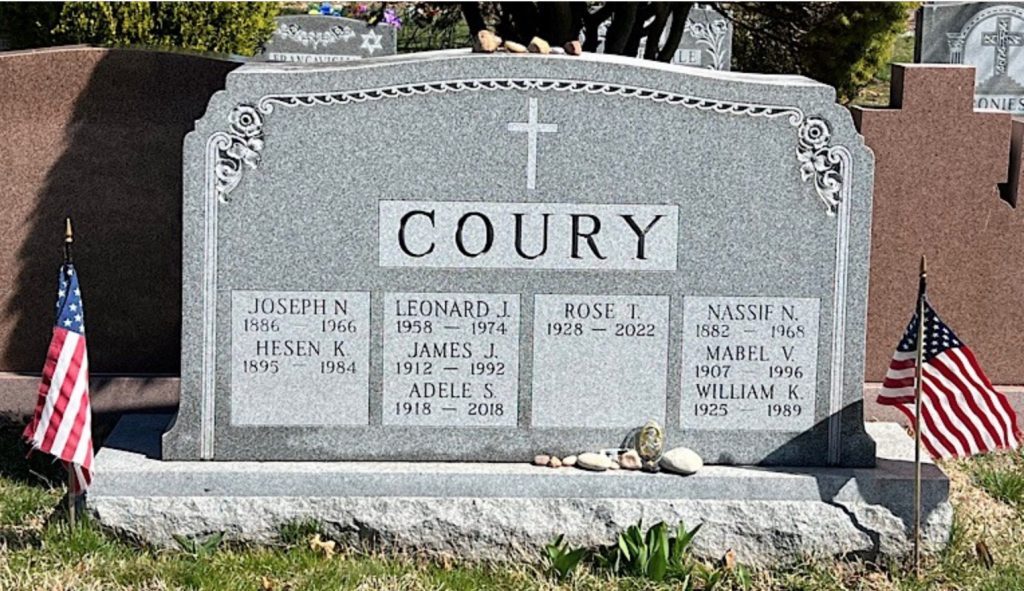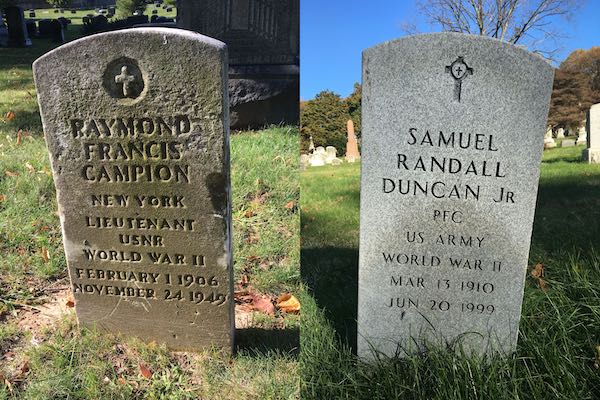
WWII Bio Search
Click for the other World War II biographies: Intro/Part 1 (Aceto-Conti), Part 3 (La Barbera-Phipard), and Part 4 (Pizza-Zeltmann)
Click here to share the story of someone you know who took part in World War II.
COSTA, FRANK T. (1923-2011). Private, 161st Field Artillery Battalion, United States Army. Frank Costa was born in Brooklyn to Eugene and Antoinetta Costa, both of whom had been born in Italy. Frank had four older sisters and an older brother, all born in New York. At the time of the 1930 federal census, Frank’s father was employed as a foreman. By 1940, according to that year’s federal census, 16-year-old Frank was living on East 38th Street with his family, which had grown to include a younger brother and a niece.
According to his daughter, Costa attended Brooklyn Technical High School, and completed two years there. He was living at home on East 38th Street when he registered for the draft in 1942 at age 18. He was described then as standing 5′ 7″ tall, 172 pounds, with brown eyes and hair and a light complexion. According to his obituary, before Frank was inducted into the Army in February, 1943, he joined the Civilian Conservation Corps, where he spent time fighting forest fires in Idaho.
Costa’s military assignment was with Battery B in the 161st Field Artillery Battalion, part of the 35th Infantry Division. He was a cannoneer—part of a gun crew—and in 1944 qualified as a carbine sharpshooter, the middle level of three possible qualifications. The 161st Battalion arrived in France in late May 1944. Costa took part in the Ardennes, Central Europe, Normandy, Northern France, and Rhineland battles and campaigns. He was injured in combat but, according to his daughter, refused the Purple Heart in order to keep his mother from worrying about the extent of his injuries. His other military honors were the American Service Medal, the European-African-Middle Eastern Service Medal, and the Good Conduct Medal.
The Brooklyn Daily Eagle listed Costa’s name as among the local boys of the 161st Battalion arriving back in the United States aboard the Queen Mary on September 10, 1945. There were more than 14,000 American troops on that ship. Eight weeks later, Costa was honorably discharged from the Army at Fort Dix, New Jersey.
After the war, Costa worked in Brooklyn for many decades as a cab driver, according to his obituary. Then he worked another decade in Manhattan as a courier in the financial district. He married Antoinette Filippelli in 1954. Together, they had two daughters, Elizabeth and Maryellen; and a son, Frank Jr., and raised them on Long Island. He settled on Staten Island in 1968. Section 27, lot 40954.
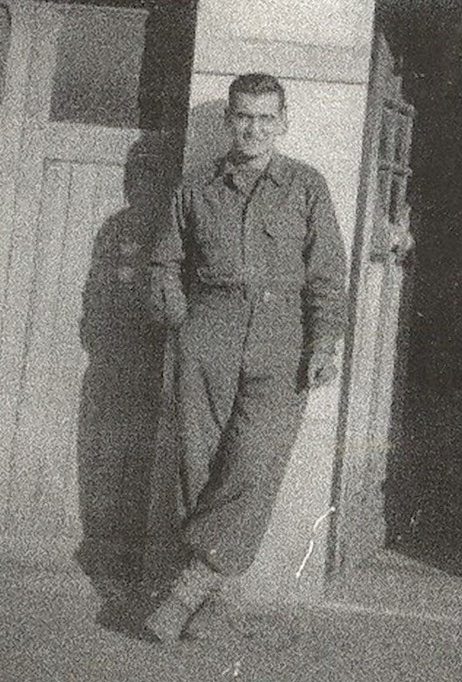
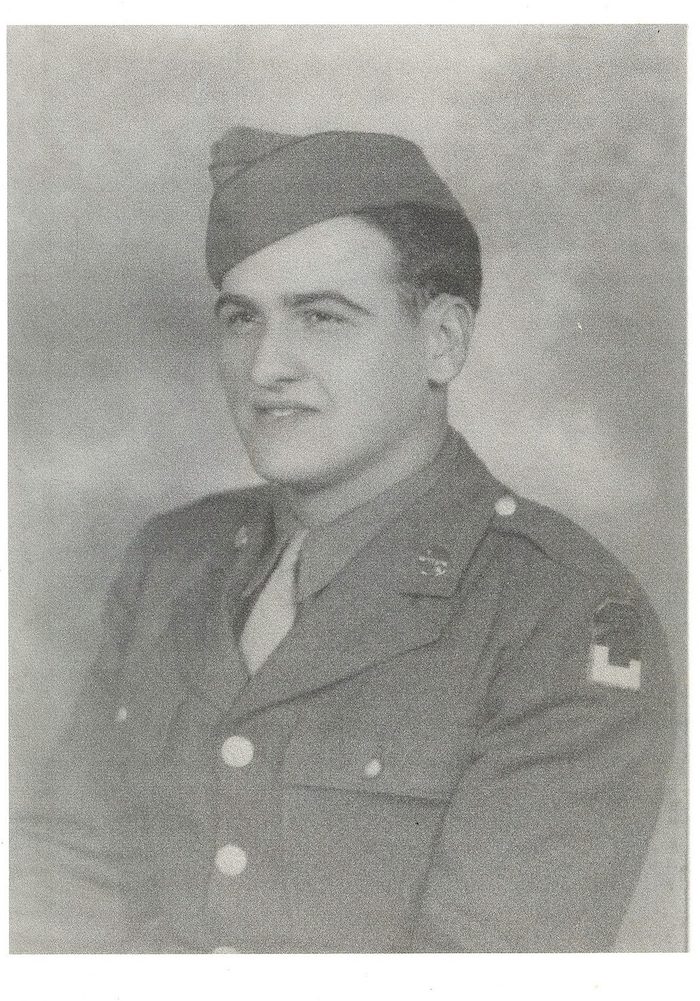
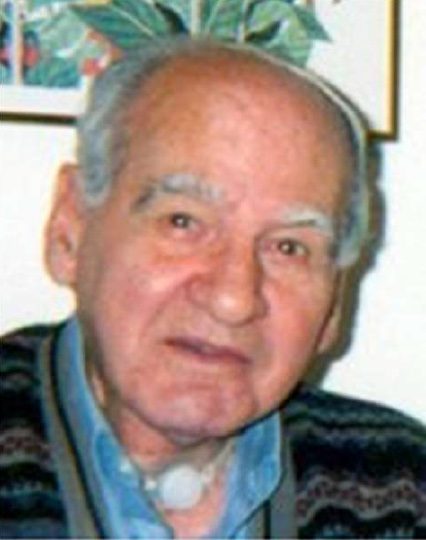
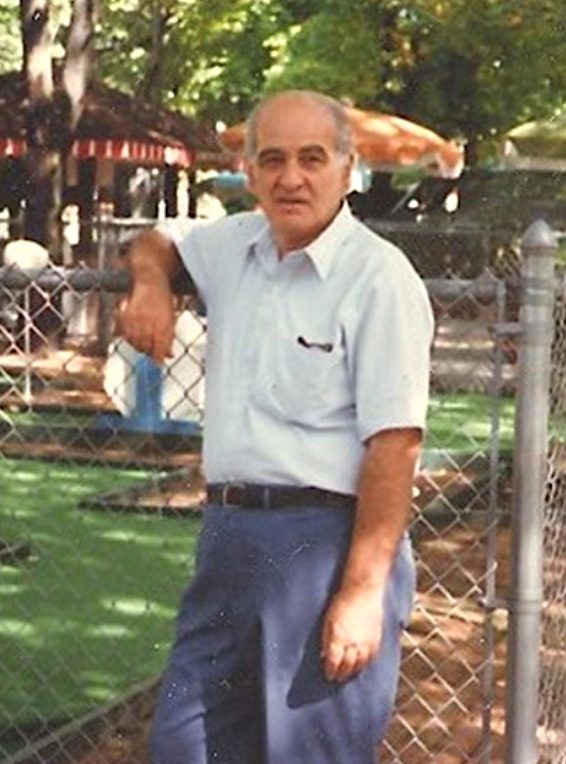
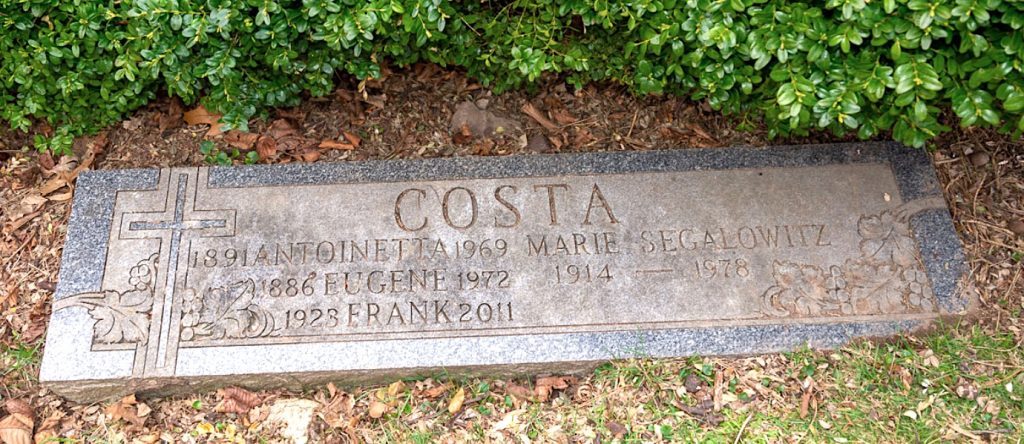
COSTANZA, VINCENT (or VINCENZO) (1921-2010). Private, United States Army. As per the 1925 New York census, Costanza’s mother and father, Angelo and Carmela, were born in Italy. The couple had five sons: Thomas, Dominic, Peter, Vincenzo (Vincent) and Giglio (James). Thomas was born in Italy; the four younger siblings were born in the United States. His father was a shoemaker and the family lived at 1375 65th Street in Brooklyn. The 1930 federal census documents that the family lived on 14th Avenue in Brooklyn. By the time of this census, his parents had a sixth child, a daughter, named Mary. The 1940 federal census records that the family lived on Ovington Avenue in Brooklyn and Vincent’s father worked at a shoe repair shop. Thomas, the oldest son, had married and moved out of the family residence; the other five siblings remained with their parents. Peter and Vincent are listed as “new workers,” with no job specified.
Costanza’s World War II draft registration card documents that he was twenty years old and resided at 1060 68th Street in Brooklyn. His future wife, Melinda Fusco, is designated as next of kin. For employer, Vincent wrote “owner” with his home address as location of employer. The registrar’s report, dated February 15, 1942, describes him as 5′ 8″ and 158 pounds with brown eyes, black hair, and light complexion. Two tattoos on his arms are detailed as additional physical characteristics. According to his World War II enlistment record, Vincent enlisted on October 15, 1942 at the age of twenty-two. His rank was private and the record indicates grammar school for his education. However, his son, Anthony, shares that Vincent attended high school. The enlistment record also details that he was single with no dependents and his civilian occupation was sales clerk.
There is little official documentation regarding Vincent’s service in the United States Army. However, his son reports that Vincent was a “medic in the army, treating the injured before transmitting them to the hospital. He also serviced military vehicles.” His son also shares that Vincent did his tour of duty in Italy, France, Africa, and Germany. Vincent’s World War II hospital admission card states that the twenty-four-year-old Costanza was treated for malaria from May 1945 to October 1945. According to Vincent’s son, Costanza received numerous awards for his service, including the Good Conduct Medal, the European-African-Middle Eastern Campaign Medal with two bronze stars, the World War II Victory Medal, and the Driver and Mechanic Badge.
According to the New York State Marriage License Indexes, Vincent and Melinda Fusco applied for a license on September 14, 1946. As per their son, the couple was married on October 13, 1946. The 1950 federal census records that the twenty-eight-year-old Vincent was married and was a trailer driver for a trucking company. He and his wife lived on 66th Street in Brooklyn and the couple had two children at that time. As per his obituary in the New York Daily News, Costanza was survived by his wife and five children: Vincent, Linda, Frank, Camille, and Anthony. Section 44703, lot 61, grave 194.
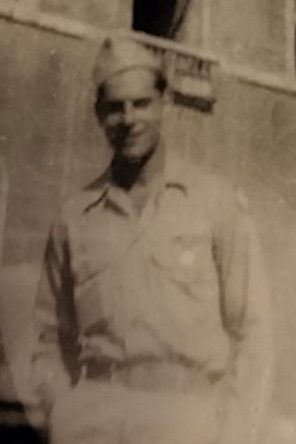
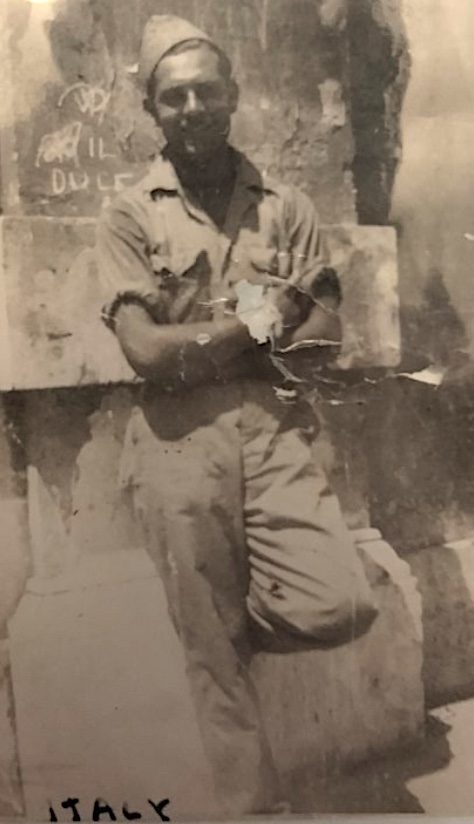
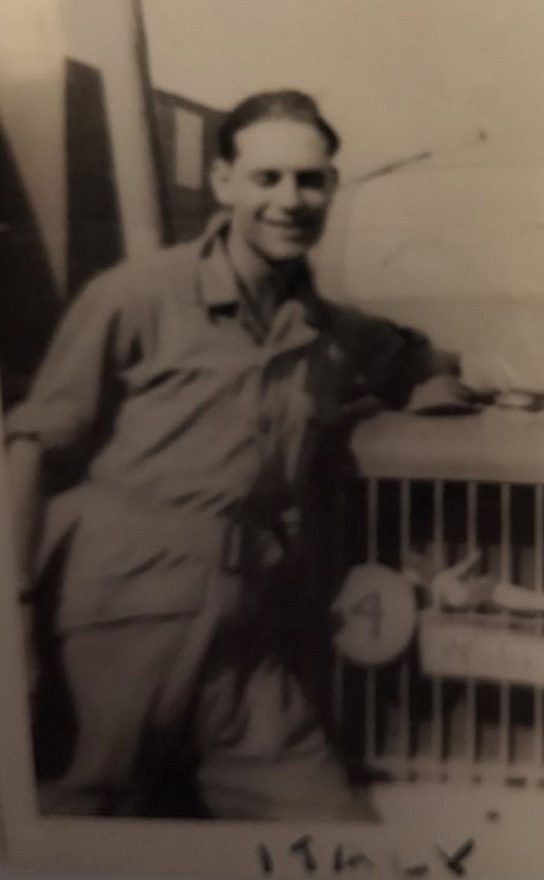
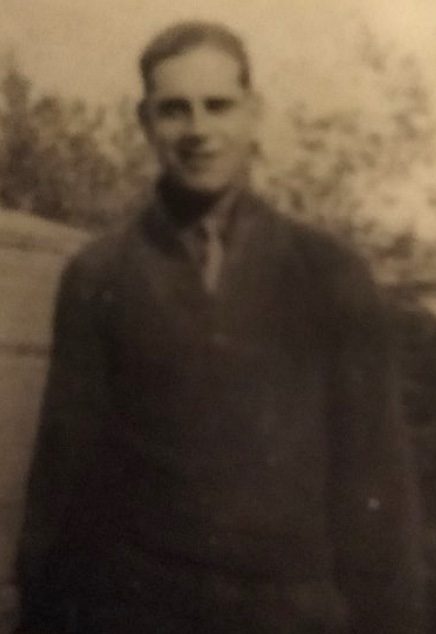
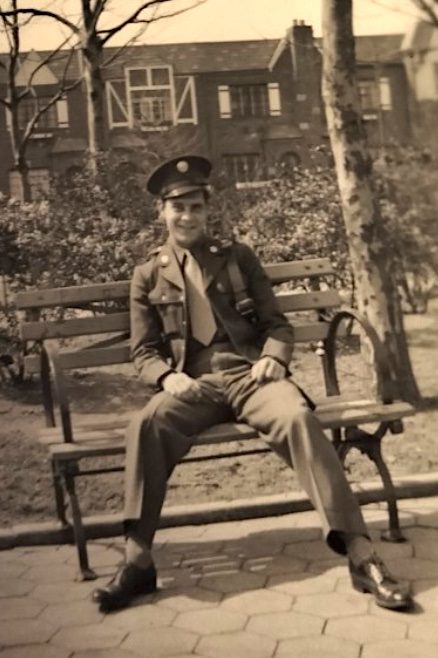
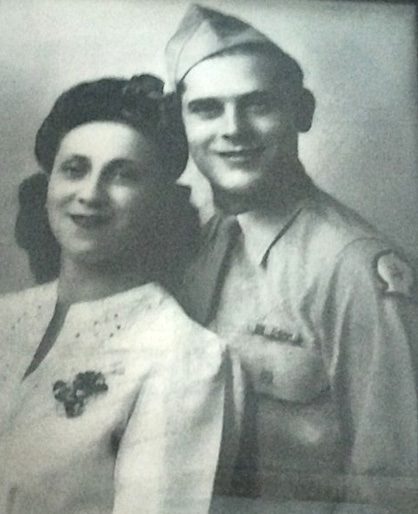
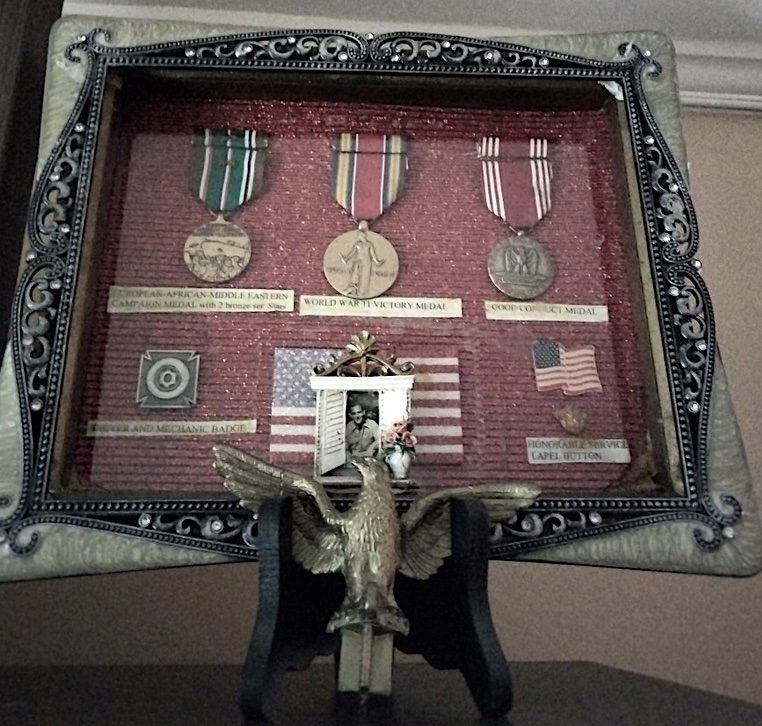
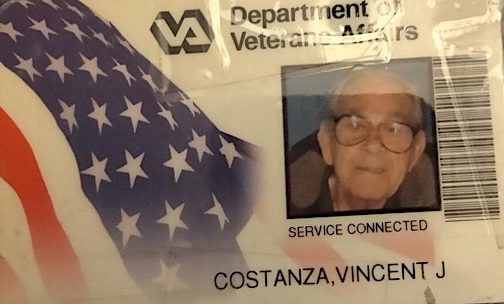
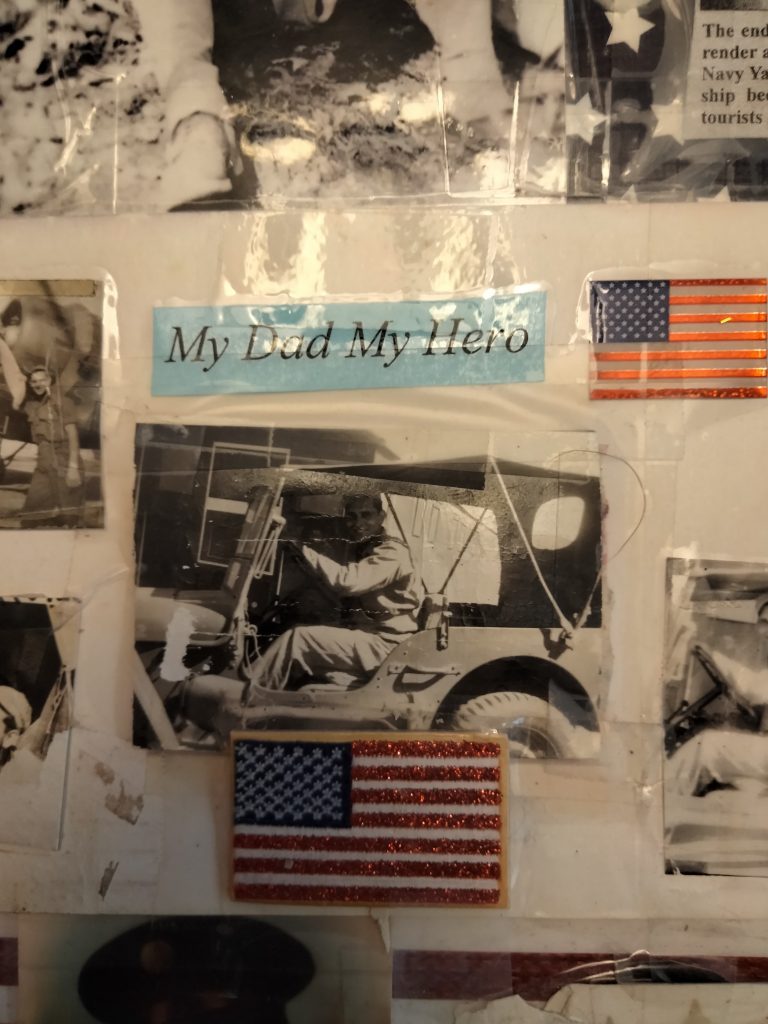
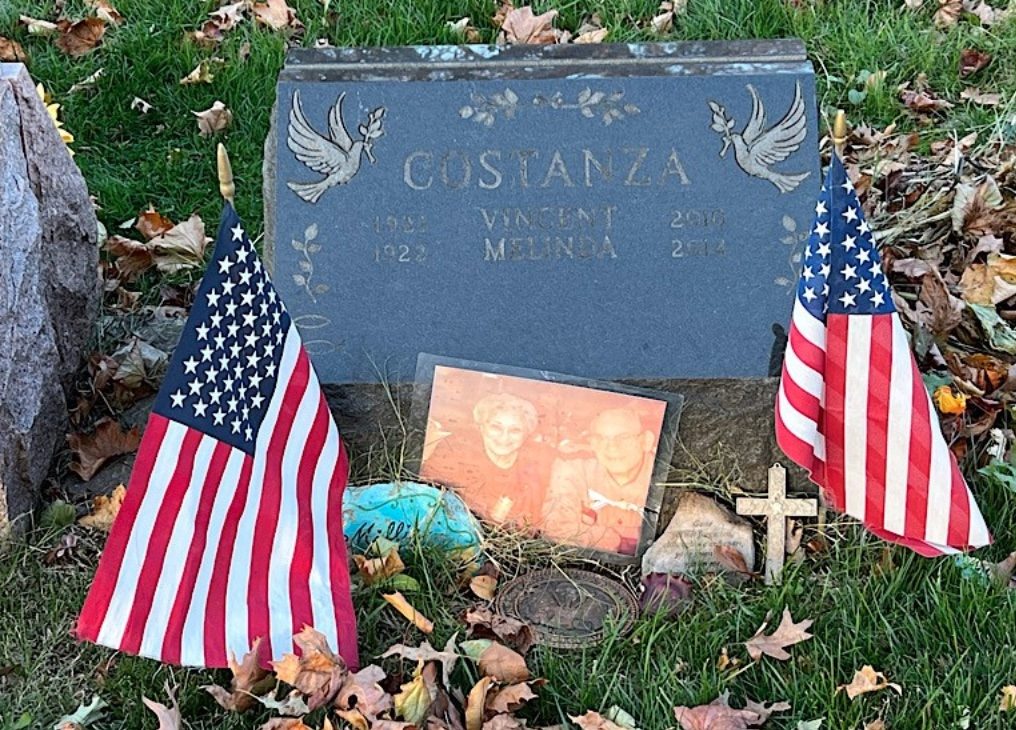
COUGHLIN, JOHN VINCENT (1917-1982). Lieutenant, Engineer Section, Detachment 17th Base Headquarters, United States Army. Born in Brooklyn, John Vincent Coughlin was residing there at 1852 Albany Avenue with his parents, Thomas and Ellen (also known as Nellie), according to the 1920 federal census. Also in the home were his older siblings: Veronica, age 12; Thomas Jr., age 10; Jerome, age 8; and Grace, age 4. John’s father, Thomas, worked as a patrolman for the police department.
The 1925 New York State census shows the family still residing at the Albany Avenue address. There is now a younger brother, Alfred, age 1. By the 1930 federal census, the family had moved to 1844 Albany Avenue. John Coughlin is listed as a student, Veronica was employed by the New York Telephone Company, and Jerome worked on Wall Street. The 1940 federal census shows John Coughlin residing on Albany Avenue with his parents, his sister Grace, his brother Alfred, as well as his sister Veronica and her two children, Dorothy and Ileen. Veronica had married and her married surname was McNamee. John Coughlin and all family members were born in New York. His father was a police sergeant for the City of New York, while sister Grace worked as a stenographer for an importing company. John Coughlin had graduated from high school and was seeking work.
According to information provided by his daughter Maureen Coughlin, John Vincent Coughlin graduated from P.S. 119 in 1931, and from Erasmus Hall High School in 1935. He registered for the draft in Nassau County, New York, on October 16, 1940, at 23 years of age. His draft registration card, dated October 16, 1940, indicates that he was living in the Village of Babylon, Suffolk County, New York, and was employed in the Executive Department of the New York State Police in Albany, New York. Coughlin was 5′ 11″ tall, weighed 170 pounds, with blue eyes, brown hair, and a light complexion. He listed Captain James Flynn of the state police in Babylon, New York, as his contact.
Coughlin’s World War II United States Army enlistment records show that he was single, a United States citizen, with a civilian occupation of retail manager. He enlisted on June 9, 1942, at Fort Jay on Governors Island, in New York Harbor.
According to information provided by his daughter, Coughlin served in the Army Infantry and was stationed at Wheeler Field Air Base in Hawaii. He entered military service with the rank of private and was elevated to the rank of lieutenant. While at Wheeler Field Air Base, serving in the Engineer Section, Detachment 17th Base Headquarters, and Air Base Squadron, he received a commendation, dated June 15, 1943, from the station commander for his courageous actions.
On April 13, 1943, a B-24D airplane carrying demolition and practice bombs crashed and burst into flames while trying to make an emergency landing at Wheeler Field Air Base. Despite the danger from fire and potential explosions of the bombs, Coughlin, who was a member of the Fire Department Crash Crew, rushed to the crash site to assist with firefighting and caring for the soldiers who had been injured in the plane crash. As a result of Coughlin’s heroic actions, his commanding officer issued a commendation which recited the facts and concluded, “This action on your part, while in constant danger due to the possibility of bombs exploding and fires spreading, displayed qualities of courage and consideration for the safety of fellow-officers which are worthy of high commendation.” According to articles from the Hawaii Times dated April 14, 1943 and April 16, 1943, several soldiers and one civilian were killed and seven civilians were injured in the accident. While stationed in Hawaii, Coughlin would have transitioned to a combat role in the Pacific Theater of Operations; however, the war ended before that happened.
Coughlin and Helen M. Gaffney were married on August 24, 1944, in Marshall Township, Calhoun County, Michigan. Helen was also born in Brooklyn and listed Brooklyn as their place of residence. At the time, Coughlin was in the United States Army and Helen was an assistant cashier. The bride’s father was James Gaffney, and her mother was Naomi Bertenich. Coughlin and his wife had five children.
According to BIRLS (Beneficiary Identification and Records Locator Subsystem) records, Coughlin was discharged from the military on December 19, 1952. According to his daughter, Coughlin went on to own Coughlin’s Bar. John Vincent Coughlin died on March 24, 1982, while his wife passed away in 2005. They are interred together at Green-Wood. Section 88, lot 44287.
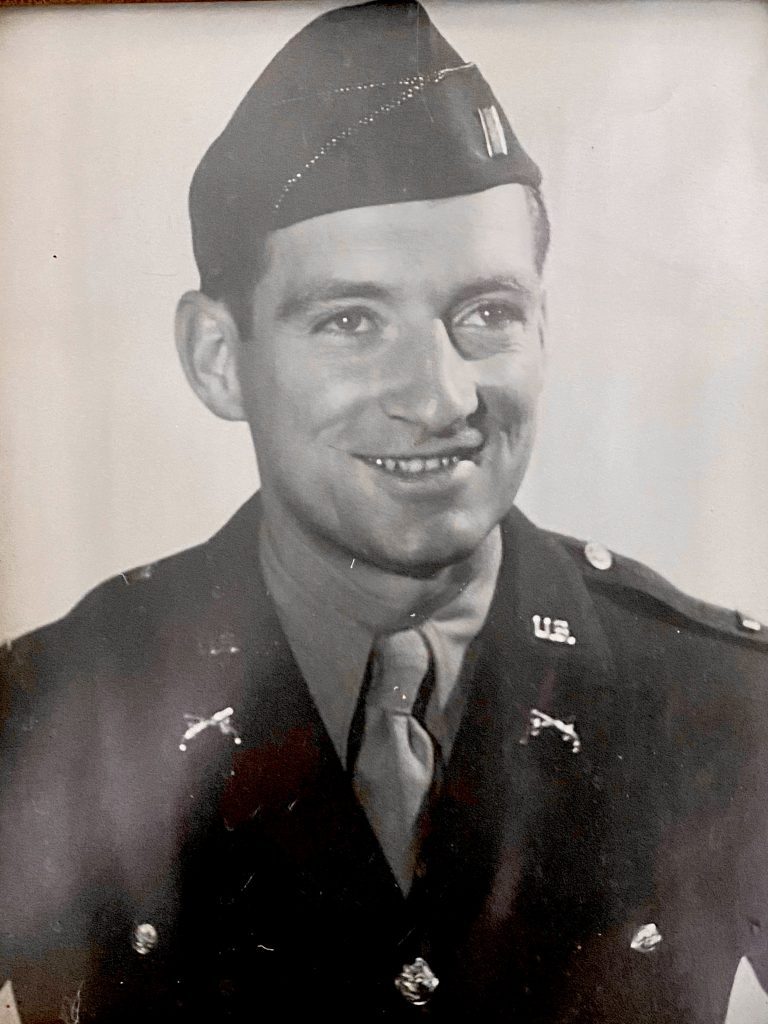
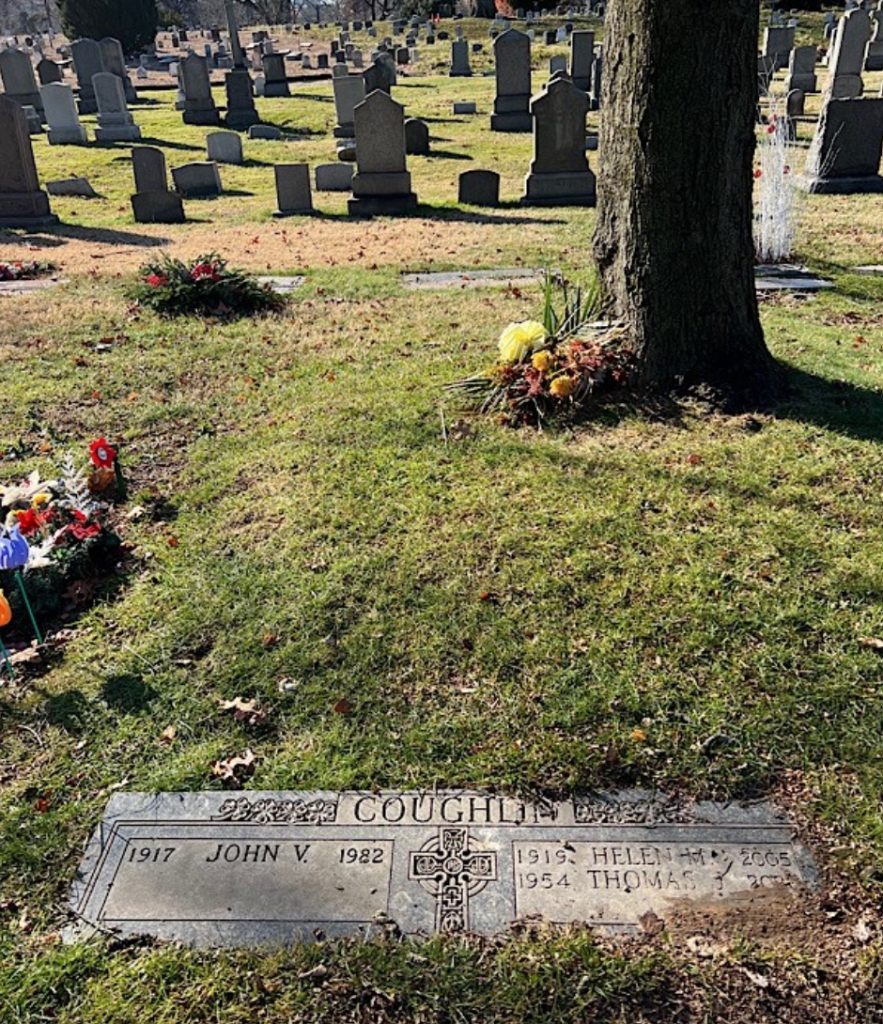
COURY, JAMES J. (1912-1992). Fireman second class, United States Navy. According to his father’s United States Petition for Citizenship, James was born on July 4, 1912 in New York. As per this document, his father, Joseph, was born in Damascus, Turkey on April 10, 1888 (Damascus, Syria was then part of the Ottoman Empire.). He sailed from Syria on the La Touraine and arrived in the United States on April 25, 1901. Coury’s mother, Hesen, was born on March 20, 1895 in Damascus, Syria, and entered the United States on April 15, 1907. Coury’s parents were married on December 22, 1910 in Manhattan. The aforementioned date of their marriage indicates a discrepancy with the date recorded in the Marriage Registry for the town of Natick, Massachusetts. This document states the marriage took place on January 22, 1911.
The 1915 New York State census records that James lived with his parents, Joseph and Hesen, on Second Avenue in Manhattan and his father had a fruit and vegetable stand. The 1920 federal census documents that the family was renting on Second Avenue and his father worked in a butcher grocery shop. In the household were Coury’s younger brother and sister, George and Mary, and his maternal grandmother. According to the 1930 federal census, Coury’s parents were naturalized citizens and, with the birth of Joseph Jr., the couple now had four children. The family resided and owned the house at 180 Prospect Park West and his father owned a butcher shop. James, seventeen years old, attended school. As per his father’s Petition for Citizenship, dated March 24, 1933, his father renounced his allegiance to “the Republic of Turkey and/or the present sovereignty in Syria and Lebanon.” At the time of his father’s petition, the family lived at 180 Prospect Park West in Brooklyn.
As per the New York City Marriage License Registry, James married Adele Saab on September 23, 1939. The 1940 federal census reports that the newly married couple lived with Adele’s parents, Alexander and Edma Saab. James was a manager for his father-in-law’s lingerie business, A & N Saab Company, Inc., located at 45 East 30th Street in Manhattan. Also in the household were Adele’s two younger siblings and her grandmother.
Coury’s World War II draft registration card records he was twenty-eight years old and worked for Mr. A. M. Saab at the address cited above. His home address on Shore Road was crossed out and 219 Clinton Place was his updated address. His mother was designated next of kin. As per his registrar’s report, dated October 16, 1940, he was 5′ 8″ and 175 pounds with blue eyes, brown hair, light complexion and no other distinguishing features.
According to the New York State National Guard Record, James J. Coury, age 22, enlisted on December 14, 1934, and served in the Headquarters Battery, 244th Coast Artillery. According the Department of Veterans Affairs BIRLS (Beneficiary Identification and Records Locator Subsystem) Death File, he enlisted in the Armed Forces on February 17, 1944 and was discharged on May 20, 1946. A 1947 Navy Muster Roll states that a James Joseph Coury served on the USS Kearsarge as a fireman second class and another muster roll for a James J. Courey has him serving on the aircraft carrier USS Midway. Firemen in the Navy performed engineering watches and did maintenance repairs.
After the war and according to the 1950 federal census, James was an executive partner in the Saab family business. He and Adele were living with his in-laws at 219 Clinton Street and had one son, Alexander. Also living in the house were Adele’s sister’s family, two maids, and a hired hand and his wife and son. The house on Clinton Street is known as the DeGraw Mansion and is one of the most impressive houses in Cobble Hill. Mr. Saab had purchased the house in 1924.
The Coury family was active at Saint Mary’s Orthodox Church in Brooklyn. The Caravan, published on May 19, 1955, reported about a Father and Son Dinner at the church. Entertainment was provided by the children, including Coury’s son, Alex, who played the piano. The paper records the Coury’s address as 161 83rd Street. On April 10, 1958, The Caravan reported that Adele was elected vice-president for the Saint Mary’s Orthodox Fellowship.
On July 5, 1974 tragedy struck the Coury family. Two days later, the New York Daily News reported that Leonard, the younger son of James and a high school student, was shot to death in Owls Head Park in Bay Ridge, Brooklyn. He was killed while riding his bike to a friend’s home. The teen was to have started a summer job at the Urban Action Task Force of the Youth Services Agency. James was quoted several times in the article, including, “He had no fear of riding his bike at night, even though we warned him to stay around the house after dark” and “The ones who did it didn’t gain anything-while my son lost a lifetime.” Leonard’s death was featured in the June 8, 1986 article “The Justice Story” in the New York Daily News. The story provides a lengthy description of the murder and states the killer was arrested three days after the incident. He confessed to the crime and was sentenced to a minimum of fifteen years and a maximum of life in prison.
According to the Florida Death Index, James passed away on April 30, 1992. Among those buried in the family lot are Coury’s parents, Joseph and Hesen, his wife, Adele, and their son, Leonard. Section 133, lot 39484.
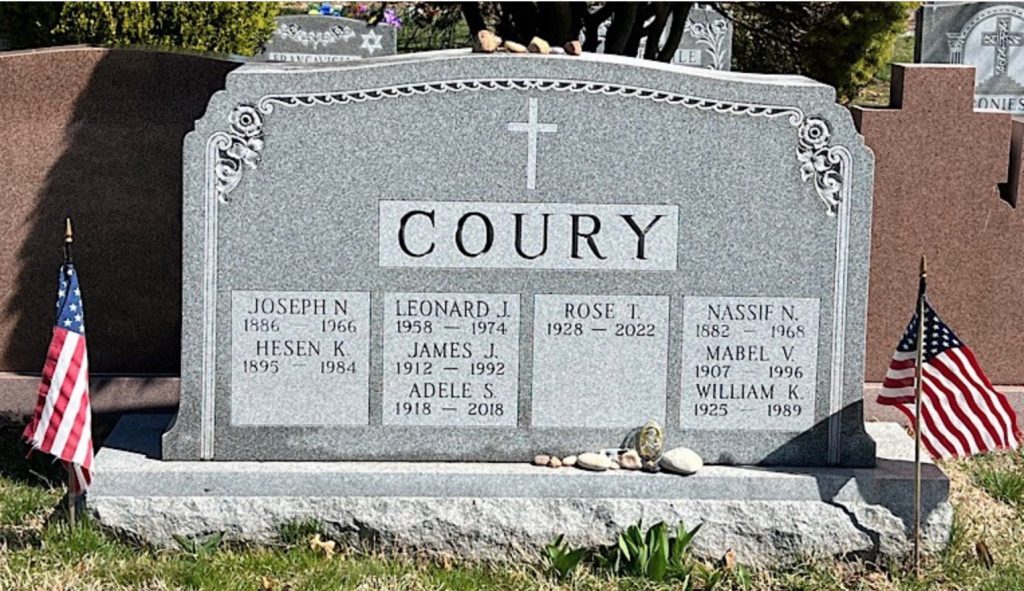
CRAVEN, THOMAS TINGEY (1873-1950). Vice admiral, United States Navy. According to the United States Veterans Administration, Craven was born on July 8, 1873 in Vallejo, California. Thomas is a descendant of three generations of naval officers. His great grandfather and namesake, Rear Admiral Thomas Tingey Craven, rose to prominence in the American Civil War; Commodore Thomas Tingey Craven, his grandfather, served in both the Unites States Continental Navy and the United States Navy; and his father, Henry Smith Craven, was a United States Naval officer and engineer. As per the 1880 federal census, his father was born in New Jersey and his mother, Eugeine, was born in Russia. The couple had four children, Eugeine, Thomas, Alga and Anna. The family resided at 2801 South Broad Street, Philadelphia, Pennsylvania. The Together We Served website lists his first military assignment as attending the United States Naval Academy in Annapolis, Maryland, from 1892 to 1896.
According to the Newspapers Marriage Index, Thomas married Marie Antoinette Merritt on July 25, 1901. He was a lieutenant at this time and served as a staff member to Admiral Francis John Higginson in the United States Navy. The 1910 federal census documents that Thomas was 36 years old, married, and his place of residence was the USS South Carolina. His mother and father are listed in this census with his mother’s birthplace recorded as the United States. His parents, however, were not members of his household. The 1920 federal census records that Thomas, forty-seven years old and head of the household, resided with his wife at 1749 Corcoran Street NW, in Washington, District of Columbia. The census lists their three children: Thomas (see), Anne and Olga. The 1928 Washington, D.C. Directory records his address as 2733 Connecticut Avenue NW.
Craven had a long and illustrious naval career spanning from 1896 to 1946. He served on numerous naval ships, including the USS St. Mary’s, USS Solace, USS Kentucky, and the USS Connecticut. According to the Navy, Together We Served website, he was the Commander of the Naval Forces in France. This assignment most likely was the cause of his Emergency Passport Application, issued on January 24, 1918. He applied to travel from Gibraltar via Spain to France by order of the United States Navy. The passport application required a detailed description of the applicant. The various enumerations are as follows: Age – 44 years; Stature – 5′ 9″; Forehead – high; Eyes – dark; Nose – regular; Mouth – straight; Chin – square; Hair – light brown, partly bald; Complexion – ruddy; and, Face – round. The Navy, Together We Served website also lists his combat and non-combat operations: Spanish-American War (1808-1898); Battle of Manila Bay (1898); Philippine-American War (1899-1902); China Relief Expedition (1900-1902); Cruise of the Great White Fleet (1907-1909); Atlantic Convoy (1917-1918); and World War I (1917-1918).
As per Select Military Registers, Thomas Craven retired on August 1, 1937. However, as stated on the United States Naval Institute website “During World War II, he was recalled to serve as Superintendent of the New York State Maritime Academy.” He served there from 1941 to 1945. The Select Military Registers also documents that he was appointed vice admiral on June 16, 1942.
Craven’s several accomplishments are reported in the following excerpt from a newspaper article entitled, “Vice Admiral Thomas T. Craven Dies at 76”:
…He was retired from the Naval service in 1937, but recalled at the outbreak of the last war to serve as commandant of the Merchant Marine Academy at Fort Schuyler. He was considered a pioneer in naval aviation and was appointed Director of Naval Aviation before the Bureau of Aeronautics was formed. He served as Director of Engineers and Gunnery, later as Directory of Communications and finally, under President Hoover, as Chief Federal Coordinator. During the Boxer Rebellion, Admiral Craven was in command of all American ships of the Yangtze patrol and it was during this war that China’s Empress Tzu-Hsi personally decorated him with the Double Dragon of China. During the first World War, Craven was made an officer of the French Legion of Honor, was decorated by the Italian government, and received the Distinguished Service Cross (DSC) and seven campaign medals.
The New York Death Index records that Thomas passed away on April 5, 1950. He was interred 13 days later. Section 42, lot 41.
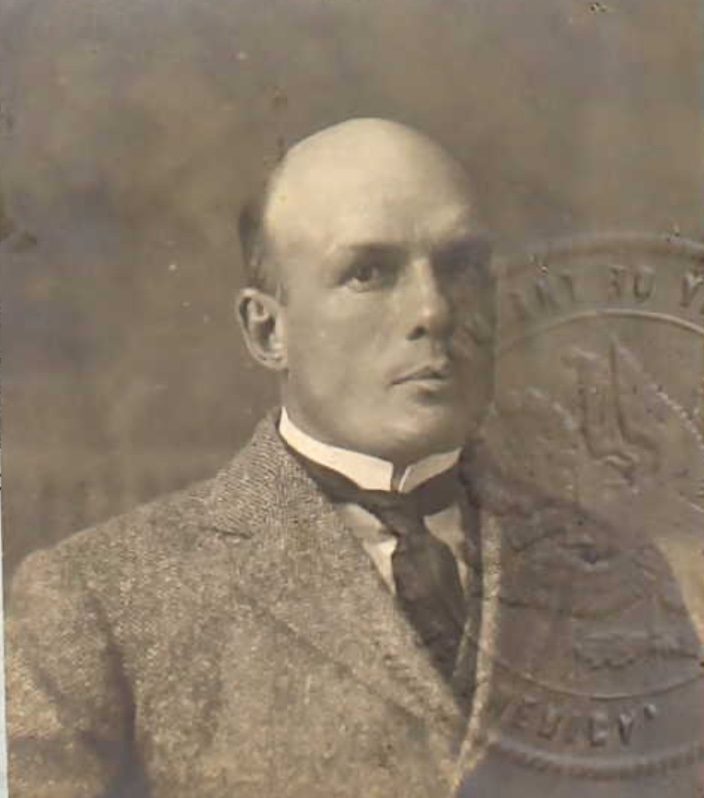
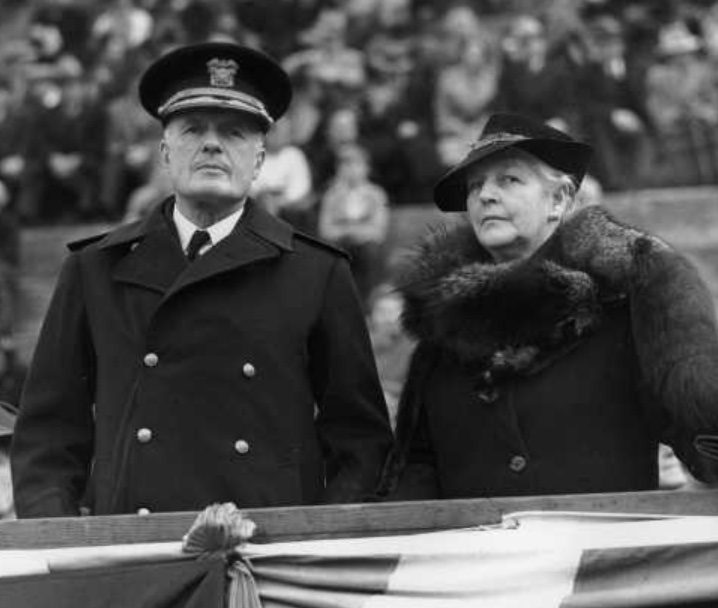
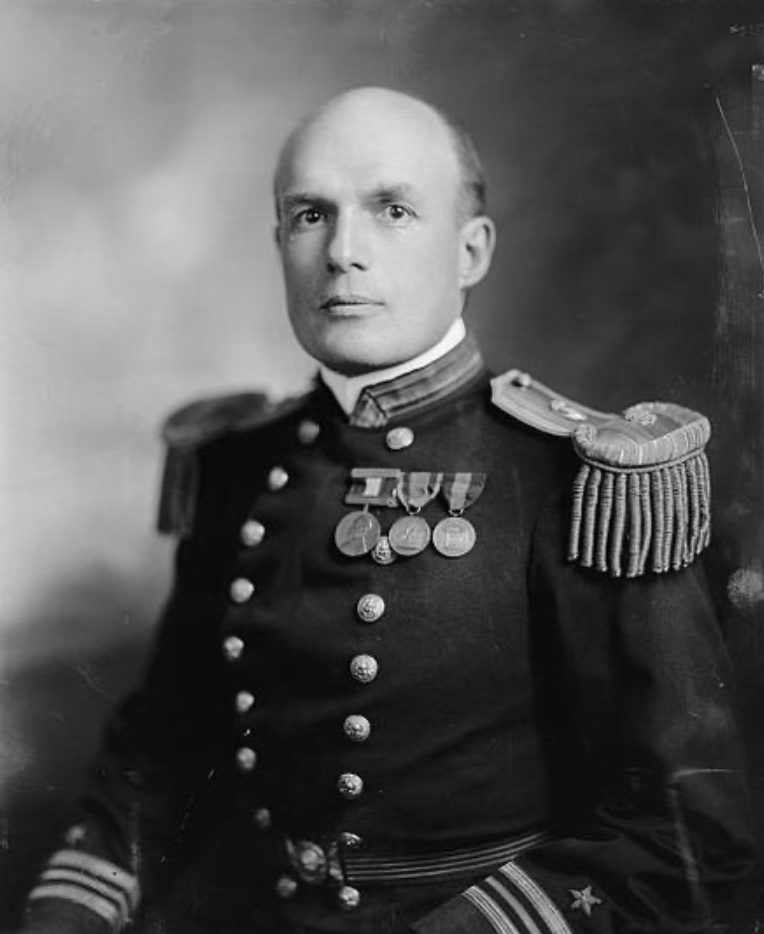
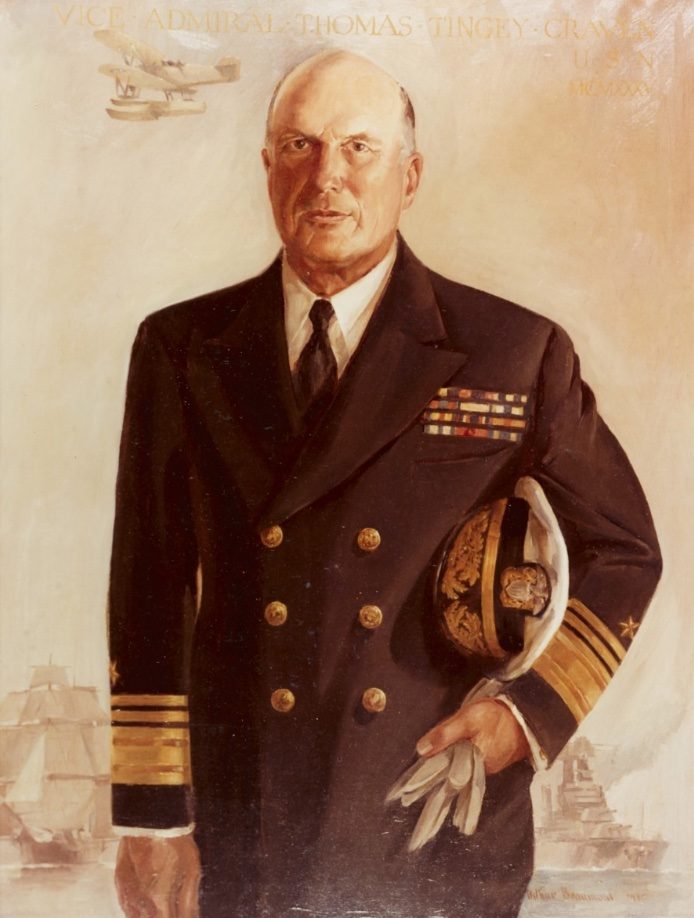
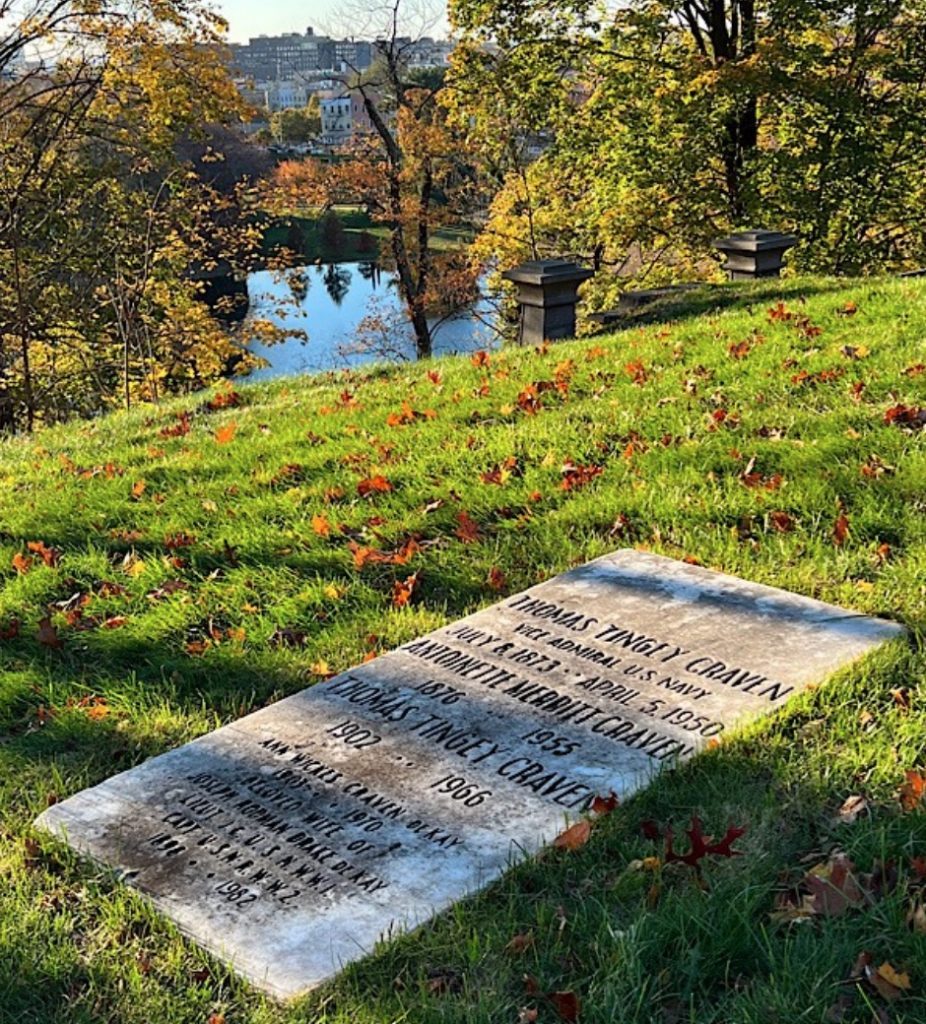
CRAVEN, JR., THOMAS TINGEY (1902-1966). Lieutenant commander, United States Navy. According to Craven’s World War II draft registration card, he was born in Yonkers, New York. As per the 1920 federal census, the seventeen-year-old Craven lived with his parents, Thomas (see) and Antoinette, and two younger sisters, Anne and Olga, on Corcoran Street NW in Washington, District of Columbia. This census documents that Craven was not attending school, nor was he working. Craven’s father was a vice admiral in the United States Navy and the family’s naval history can be traced back to his great, great grandfather.
Craven’s New York National Guard service card records that he enlisted on October 9, 1923, in the Headquarters Detachment of the 51st Machine Gun Squadron and was honorably discharged on September 29, 1925. He re-enlisted on January 20, 1927 and his cause of separation on February 17, 1928 was a “transfer to the National Guard Reserve as a private.” He then served in the Headquarters Detachment of the Second Battalion, 101st Cavalry, until discharged on February 17, 1928.
According to the New York State Marriage Indexes, he and Helen E. Eck were married on March 31, 1931, in Port Washington, New York. The Brooklyn Daily Eagle, issued on the same date, announced the couple’s wedding in St. Stephen’s Church. As per the 1940 federal census, Craven, thirty-seven years old, resided with his wife and their first child, Olga, at 651 Chestnut Hill Avenue in Norfolk, Massachusetts. The census details that he had completed two years of college and was a salesman.
Craven’s World War II draft registration card documents that he was thirty-nine years old and was employed by the Foundry & Pipe Corporation at 75 Federal Street, Boston, Massachusetts. His wife was listed as next of kin. The registrar’s report, dated February 15, 1942, describes him as 6′ tall and 175 pounds with blue eyes, gray hair, and a ruddy complexion. A broken right little finger is detailed as an additional physical characteristic. There is no documentation regarding his service during World War II. However, the United States Select Military Register, published in 1960, lists him as a retired lieutenant commander in the Navy.
According to the 1950 federal census, Craven was forty-seven years old, and a salesman in the cast iron pipe industry. He, his wife, and two daughters, Olga and Caroline, resided at 117 Newton Street, Weston, Middlesex, Massachusetts. He last lived in Boston, Massachusetts. Section 42, lot 41.
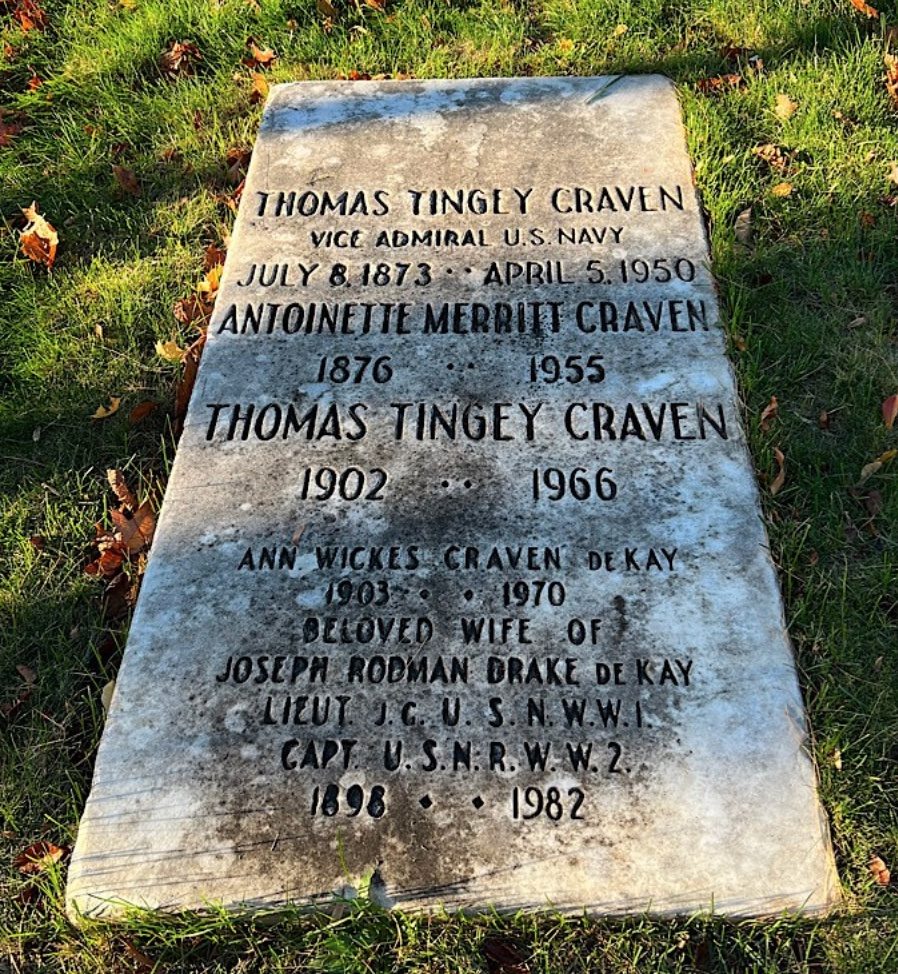
CRISTALLO, JOSEPH PETER (1922-2006). Private first class, unit unknown, United States Army. Joseph was born in the Bronx to father Domenico (Dominick) Cristallo, and mother, Paulina (also spelled Pauline) Cristallo (née Leforge). Both of his parents had been born in Italy. Domenico worked as the owner of an ice and coal business. Joseph had an older sister, Mary, seven years old, according to the 1925 New York State census. Joseph was three years old. The family lived in the Bronx, and by 1930, according to the federal census, had relocated to 4320 Wickham Avenue, in the Wakefield section of the Bronx. The family continued to live at that address for years. Dominick also had a younger sister, Julia, who was four years old.
According to information provided by Joseph’s grandson, Alfonso J. Giordano, Joseph attended the Bronx Vocational High School. He attended for 1 ½ years and left in 1939. Joseph’s family had also had boarders in their home of unknown relation.
On his World War II draft registration card, signed on June 30, 1942, Cristallo was recorded as 19 years old. He was 5′ 8″ tall, 130 pounds, with brown eyes, brown hair, and a light complexion. He stated he had a mole on his back, a burn on his left arm, and a scar on his forehead. “Name And Address Of Person Who Will Always Your Address” was listed as his father, “Dominick Cristallo.” Joseph also listed “Mr. Feather” as his employer at 338 Gerard Avenue, in the South Bronx, 1941-1943, where he cleaned, removed paint, and sanded wooden tiles. That address is now that of the Community School for Social Justice and the Health Opportunities High School.
Cristallo enlisted in the United States Army in January 1943. For his service, he was awarded the American Service Medal, Good Conduct Medal, European-African-Middle Eastern Service Medal, and the World War II Victory Medal. He served as a private first class cannoneer in the European Theatre of Operations in the Ardennes region, Northern France, Central Europe, and in the Rhineland of Western Germany. According to the Enlisted Record and Report of Honorable Separation, Joseph was discharged on December 21, 1945, from Fort Dix, New Jersey.
By 1950, as per the federal census, Cristallo was working as a tile worker for a manufacturing company and was living with his family, back at 4320 Wickham Avenue, as well as with his sister Mary’s brother-in-law and their young son. Joseph married Isabella “Bella” De Phillips in 1952 in Brooklyn. They had two children. Sadly, Bella passed away in 1979. Joseph, who was called “Papa Joe” by his family, was interred with his wife after his death at age 83. Section 6, lot 39340, grave 528.
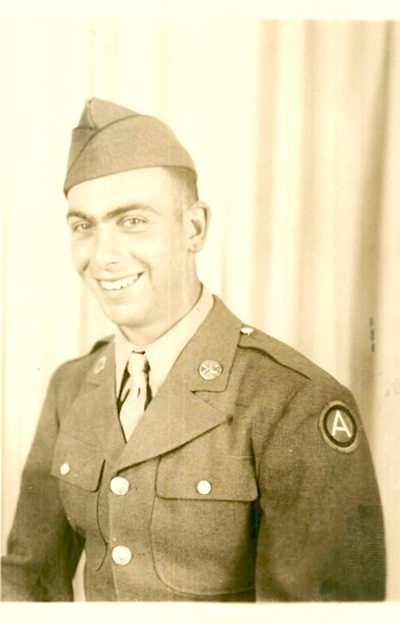
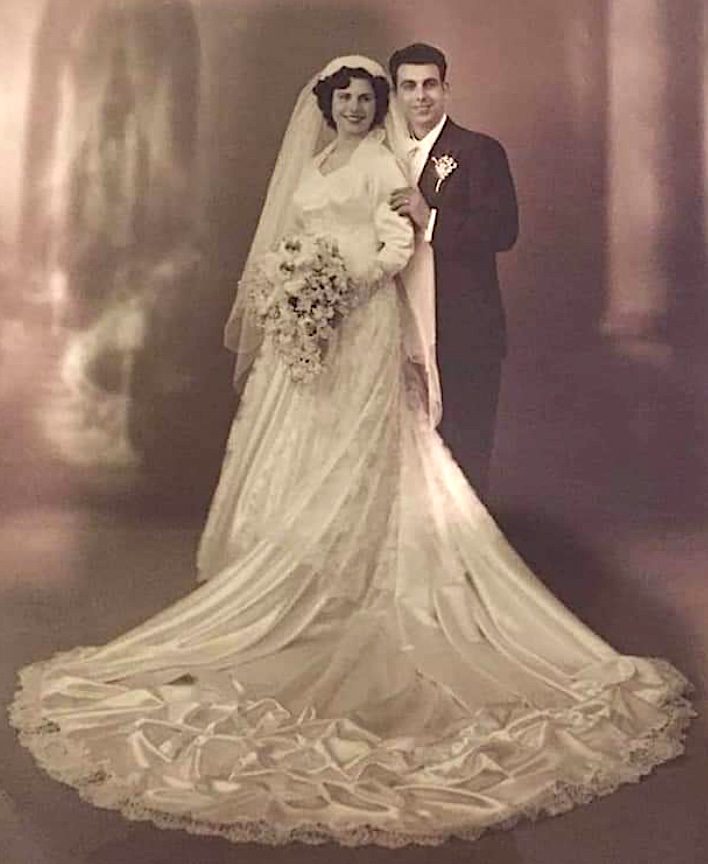
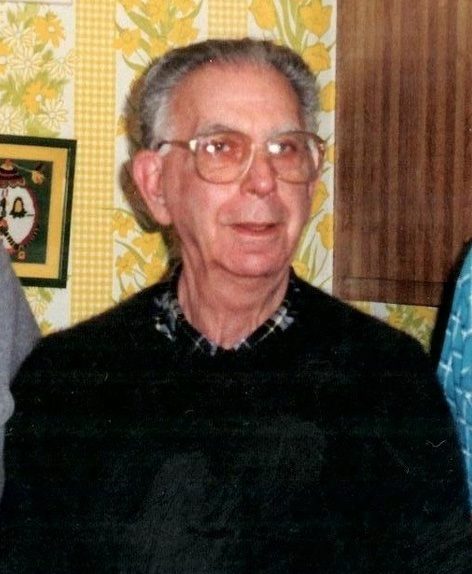
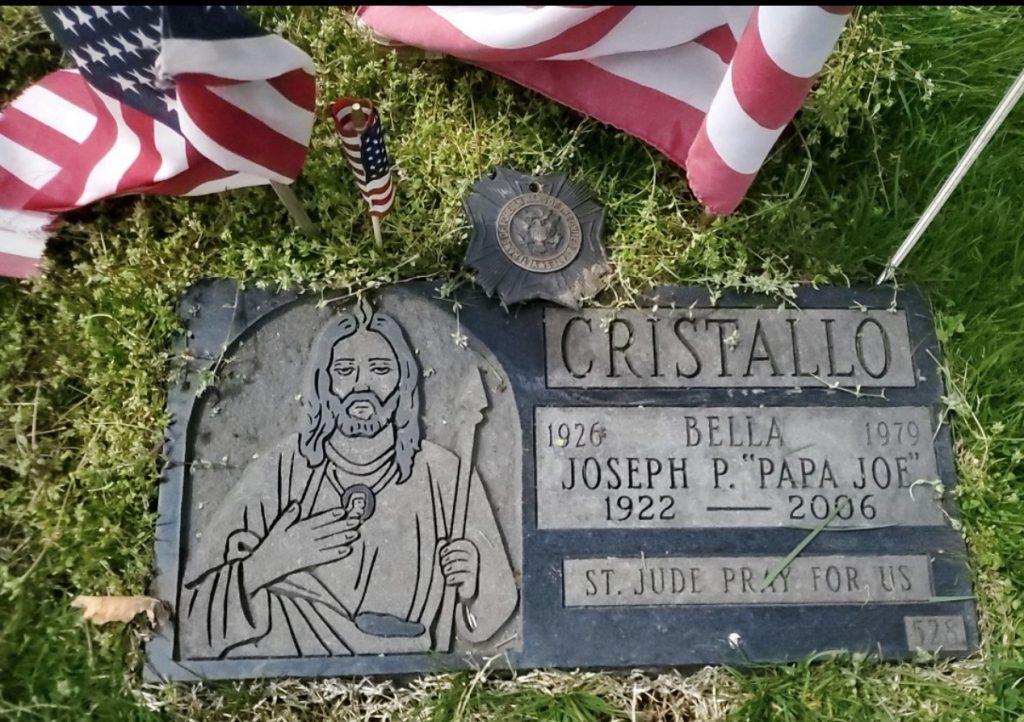
CUCCURULLO, RALPH (1922-1982). Private, 82nd Airborne Division, 325th Glider Regiment, United States Army. Born in Brooklyn, the 1940 census records that he was living with his parents, Alfonse and Mary Cuccurullo, and his five younger siblings at 84 16th Street, Brooklyn. His registrar’s report, dated June 30, 1942, describes him as 5′ 6″ tall, 125 pounds, blue eyes, black hair, and a ruddy complexion. It notes that he had a scar on his right side. His draft registration card chronicles that he was 19 years old, lived on 16th Street in Brooklyn, and worked for Decorative Metal Co., Inc. at 199 Sackett Street, Brooklyn. As per his World War II Army enlistment records, he enlisted on October 13, 1942. He was single, had completed two years of high school, worked in manufacturing, was 5′ 4″, and weighed 128 pounds.
As per his grandson, Cuccurullo was stationed in Salerno, Italy, served as a medic, and also took part in the Normandy D-Day Operation, Operation Market Garden, and the Battle of the Bulge during his service in the 82nd Airborne Division, 325th Glider Regiment. Historical data describe that the 325th Regiment was activated in 1917 and participated in battles during World War I. The regiment was part of the 82nd Division. The 82nd Division, which was nicknamed “The All American Division,” was so-called because it was comprised of soldiers from every state. During World War II, the 325th Glider Infantry Regiment was formed. The soldiers in this regiment arrived at battles by gliders. On June 7, 1944, the Regiment participated in the invasion of Normandy, France. The soldiers in this unit were awarded the red and green braided French Fourragere, a cord of honor for their service, to be worn on their uniforms.
According to his World War II hospital admission card, Cuccurullo was admitted to the hospital in June 1944, but his reason for admission and release date are unknown. As per his grandson, he did take part in Operation Market Garden in September 1944 in Holland. The 325th landed among German positions that had surrounded other elements of the 82nd Airborne Division. The Regiment earned the Distinguished Unit Citation for that attack. On December 16, 1944, the German army launched an attack against the Allies in the Ardennes Forest, Belgium. The fight continued into January 1945 with heavy casualties. This famous attack would be named the Battle of the Bulge. After the war, in May, 1945, the 82nd Airborne Division was assigned to Berlin. The Division earned the nickname “America’s Guard of Honor.” It was deactivated on December 15, 1947. According to the Department of Veterans Affairs BIRLS (Beneficiary Identification and Records Locator Subsystem) Death File, Cuccurullo was released from service on December 22, 1945.
The New York Marriage License Bureau list his marriage license date as June 8, 1946, and his wife as Marie A. Viola. They had two children. The Social Security Applications and Claims Index and his Daily News obituary record that he died in November 1982. Section Rose, lot 43900, grave 614.
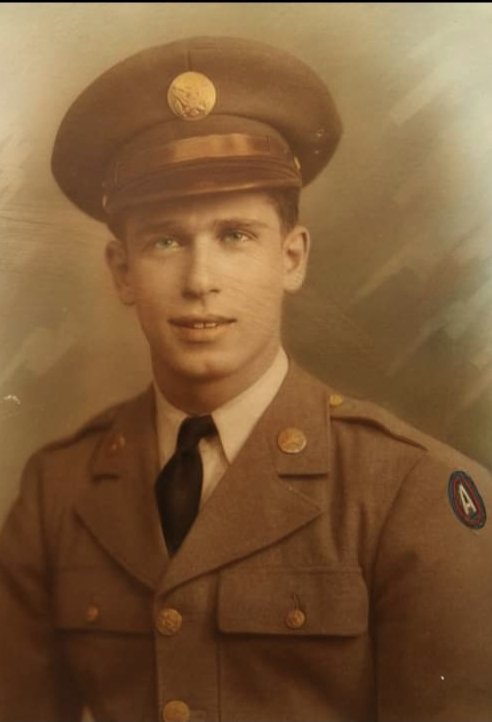
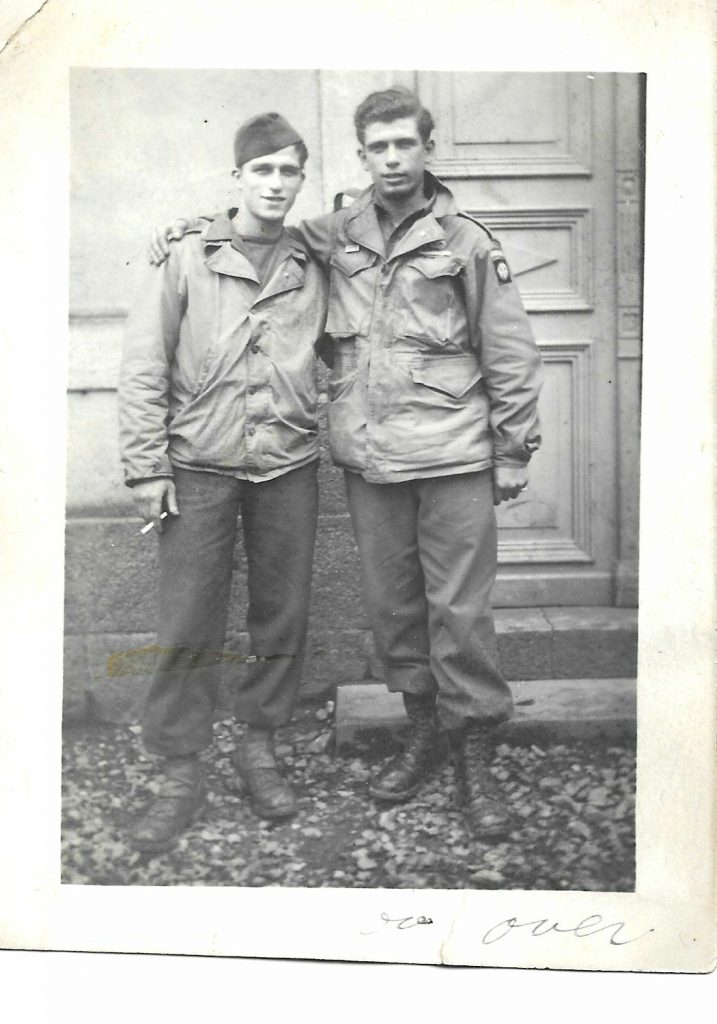
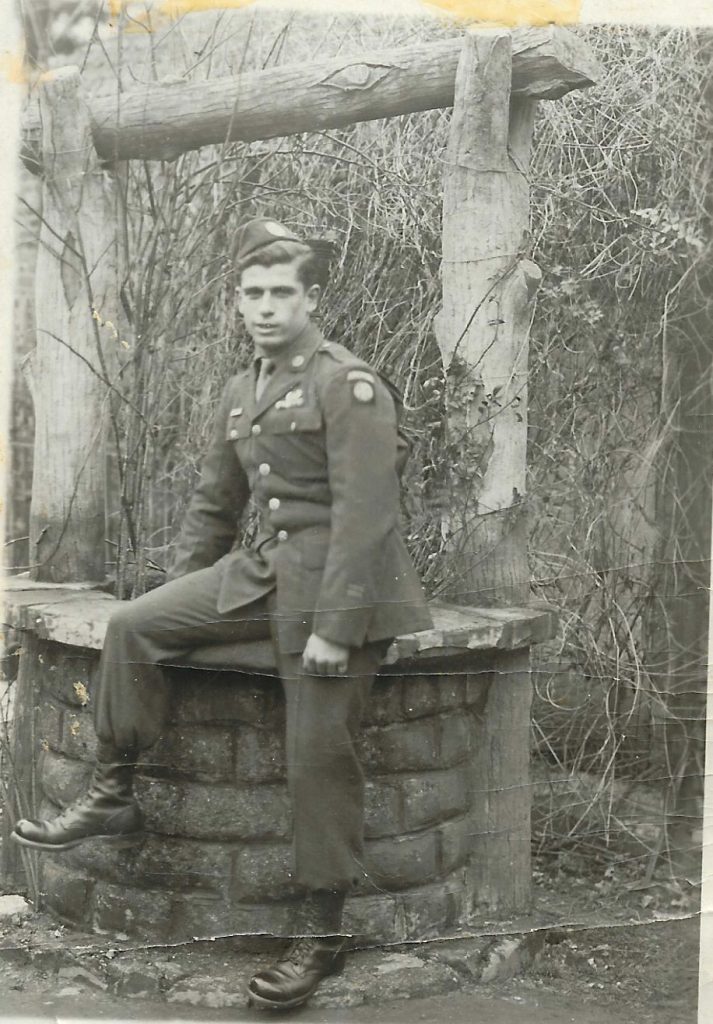
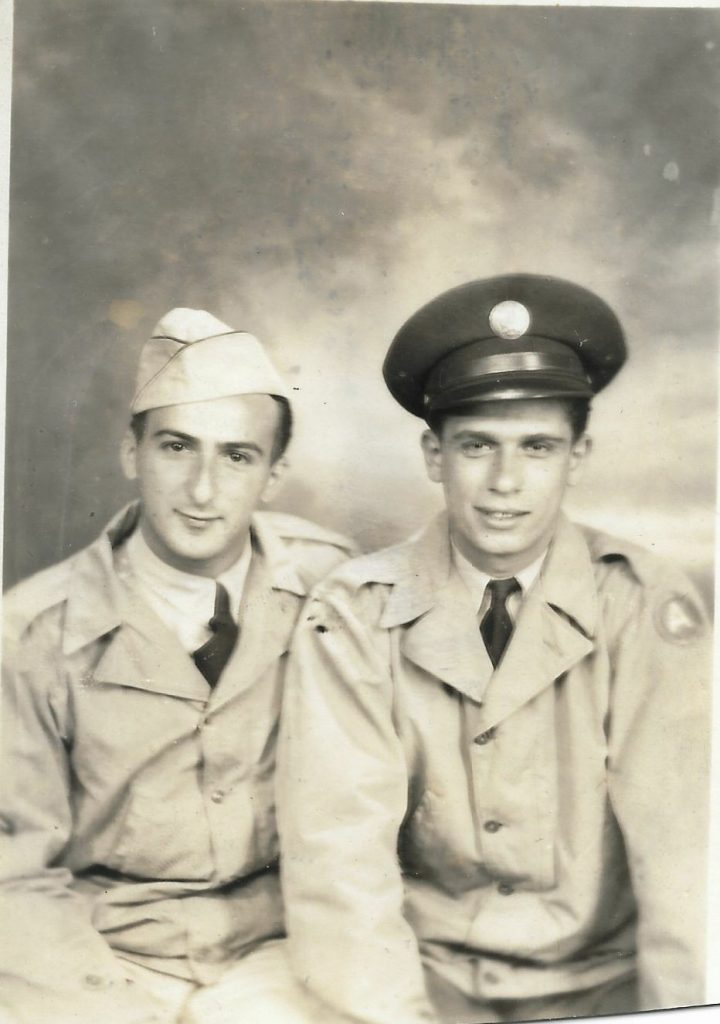
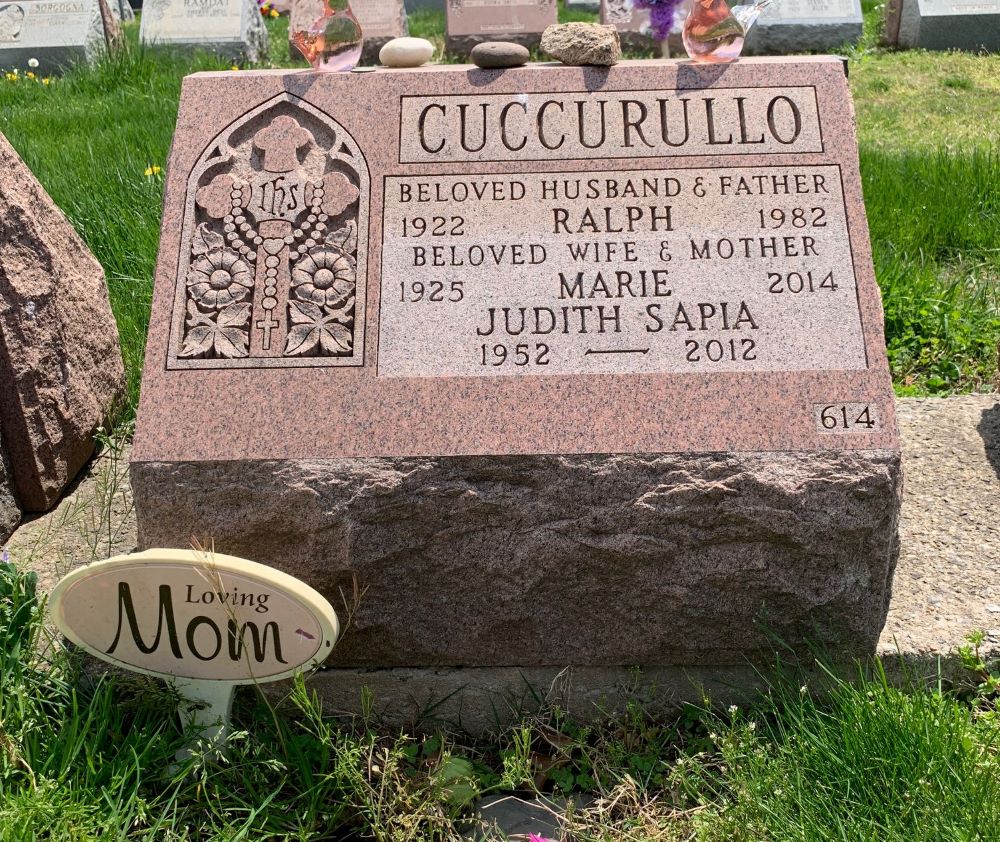
CURIALLE, FRANCESCO (or FRANK) N. (1922- 2009). Staff sergeant, 865th Medical Detachment, United States Army. Born in Brooklyn, Francesco, known familiarly as “Frank,” was the oldest of three siblings. According to the 1930 federal census, his father, Peter, was a painter born in Italy, and his mother, Clara, was born in Poland. That census also shows the Curialles living under one roof with Peter’s parents and his brother’s family, but by the 1940 census, they were living in their own home on 88th Street in Brooklyn. Curialle was a graduate of Lafayette High School. He submitted his draft card in 1942, which described him as white with a light complexion, 5′ 10½” tall, 150 pounds, with hazel eyes and brown hair.
As noted in The Brooklyn Eagle, in 1943, Curialle, on furlough from Camp Barkeley, Texas, married Clara Scarola, also of 88th Street. He served in France as a staff sergeant in the 865th medical detachment of the United States Army. While the infantry regiment that Curialle’s unit was attached to is not known, medical detachments were responsible for first echelon medical service in combat situations, as well as providing basic medical care and maintaining health and hygiene practices among the troops.
Discharged from service, Curialle returned to Brooklyn, where he and his wife had two children. According to his son, Peter, Curialle went on to operate his own business, FNC Excavators, for 25 years. Hillside Mausoleum, Phase III, section 3224C.
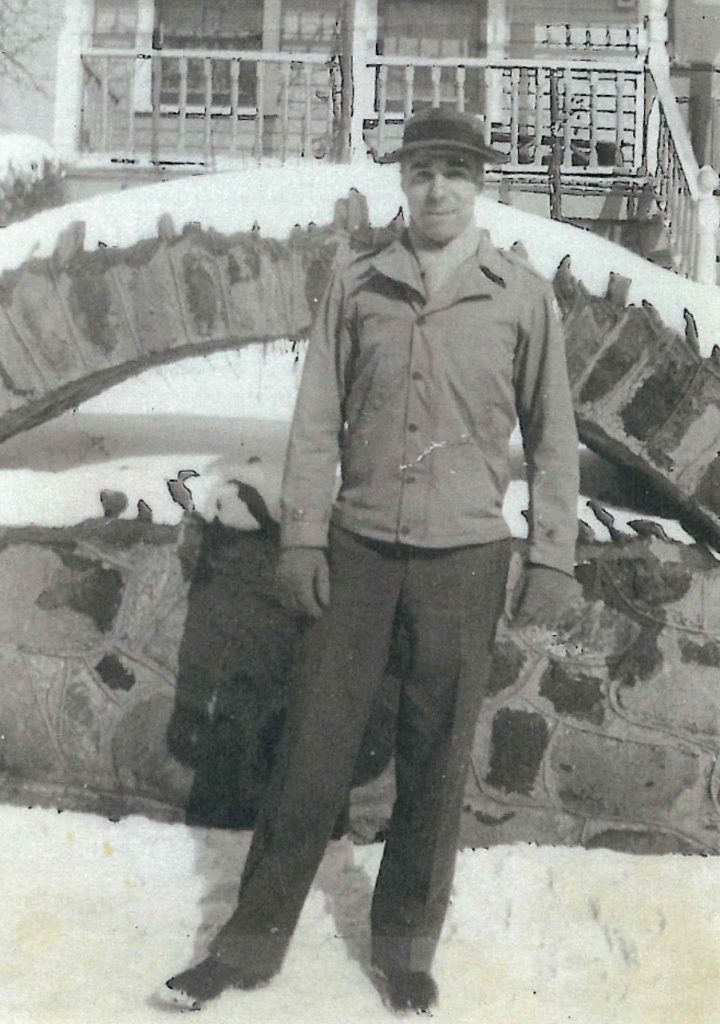
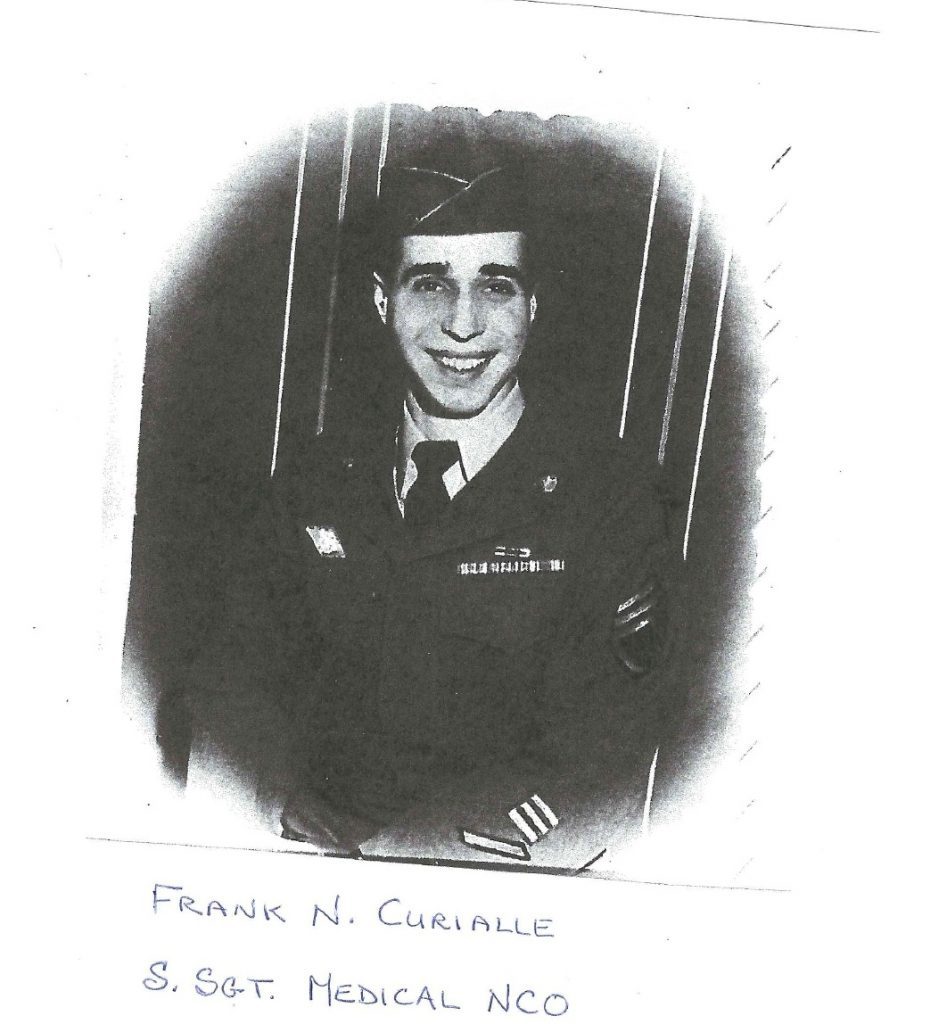
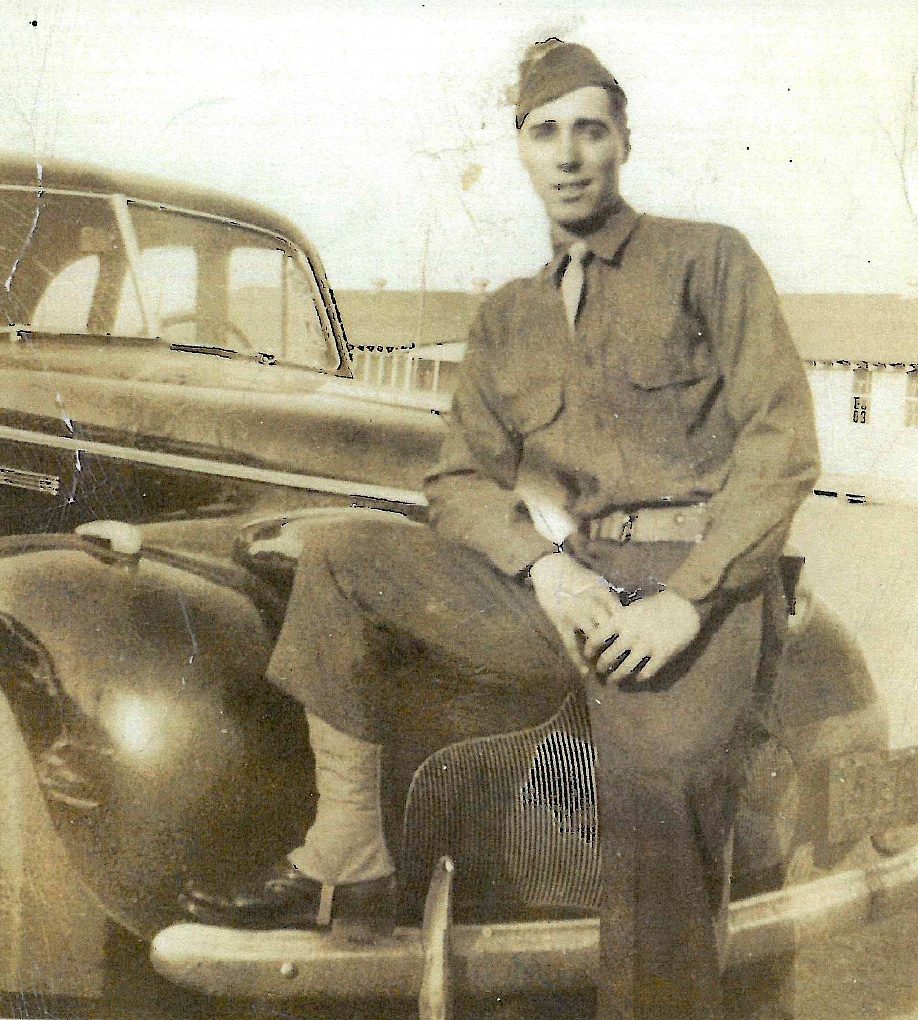
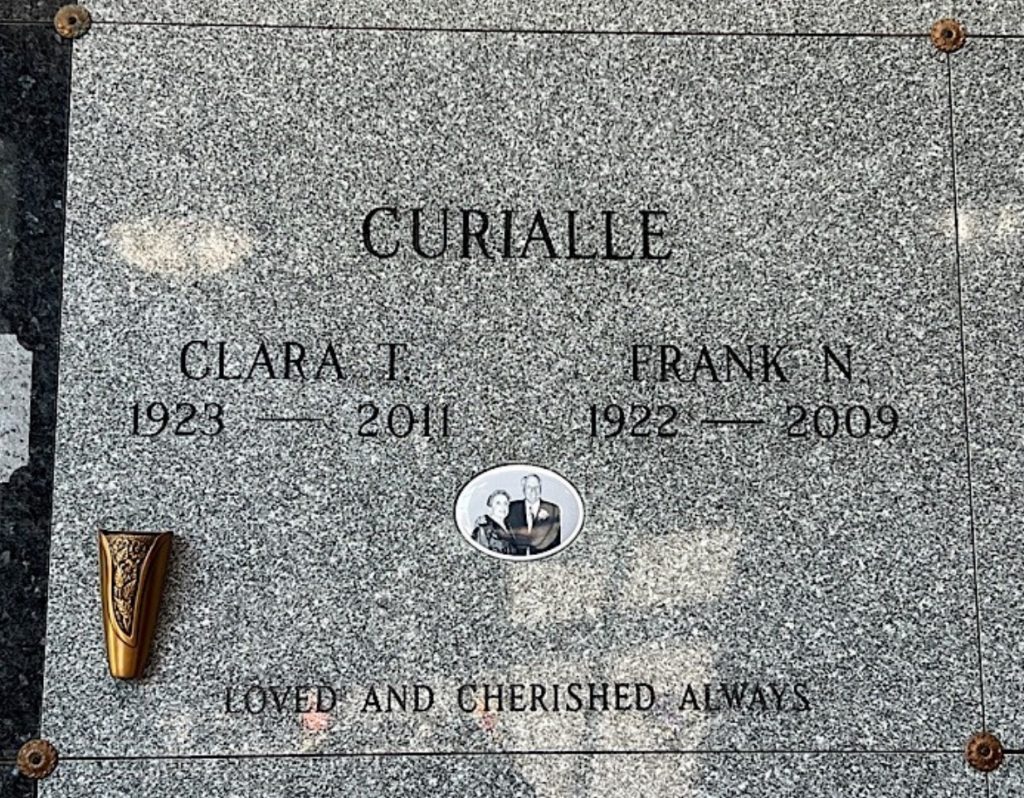
CUSTODIO, JOHN (1921-2017). Coxswain, United States Navy. According to the 1930 census, Custodio’s father, Joseph, immigrated from Portugal to the United States in 1904. His mother, Kunegunda, born in Poland, immigrated to the United States in 1904, and was a speeder tender in a cotton mill. The couple’s four children, Tony, Palmira, John, and Laura were born in Massachusetts. The family’s residence, in 1930, is documented as 605 Pine Street in Providence, Rhode Island. The 1940 census records his mother as head of household. She was residing at 136 Garfield Street, Providence, Rhode Island, with the nineteen-year-old John, and his sister Laura. He had completed four years of high school and was a bobbin boy in a cotton mill. He had worked 26 weeks in 1939, earning $130 in total.
According to his World War II draft card, Custodio registered in Providence, Rhode Island, on February 16, 1942. He was 20 years old, 5′ 10″ tall, 169 pounds, with brown hair, hazel eyes, and a light complexion. His employer was Sayles Finishing Company in Saylesville, Rhode Island. The draft card names his mother as the next of kin.
As per his son, he was a coxswain in the United States Navy. Little is known about his military service. He may be the John Custodio who served on the SS John Jay and the SS John Drake Sloat Liberty Ships (http://armed-guard.com/allnames.html). According to the website, skylighters.org/troopships.liberty ships.html, “Liberty ships formed the backbone of a supply line that enabled the Allies to wage total war against the Axis Powers during World War II… Liberty ships were nicknamed ‘ugly ducklings’ by President Franklin Delano Roosevelt…A Liberty ship could carry an amount of cargo equal to four trains of 75 cars each.” Cargo could include food and war materials, such as tanks, jeeps, and ammunition. As a coxswain, Custodio’s primary responsibility was to steer and operate the ship. His secondary duty was to provide maintenance to the vessel.
According to the New York Marriage License Bureau, Custodio married Frances T. Trost on June 16, 1950, in Brooklyn. During the war, Frances was a “Rosie the Riveter,” having been a shipfitter on the construction of the USS Missouri in the Brooklyn Navy Yard. The 1951 City Directory for Pawtucket, Rhode Island, indicates he was a carpenter. The couple then lived in Brooklyn and had two sons, John J. and Lary M., and lived for most of this time at 5616 Seventh Avenue Custodio set up his own business as a carpenter/contractor and ran this business until his retirement in 1986. He was active in the Navy Armed Guard Veterans Organization for many years. As per his Daily News obituary, dated March 18, 2017, his wife predeceased him. Section Rosewood, lot 43900, grave 531.
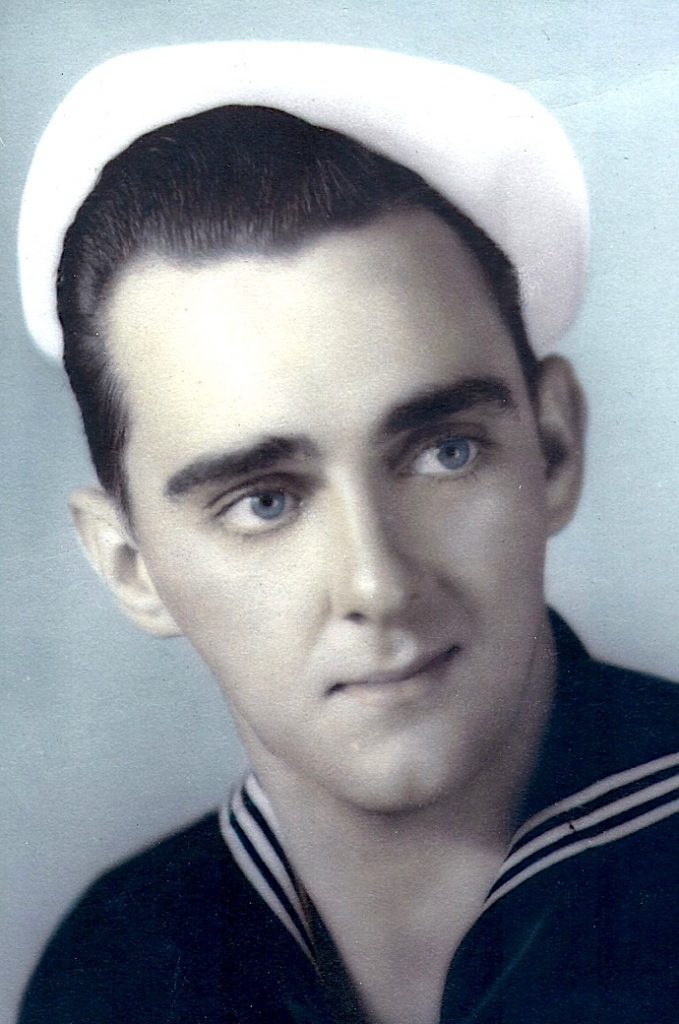
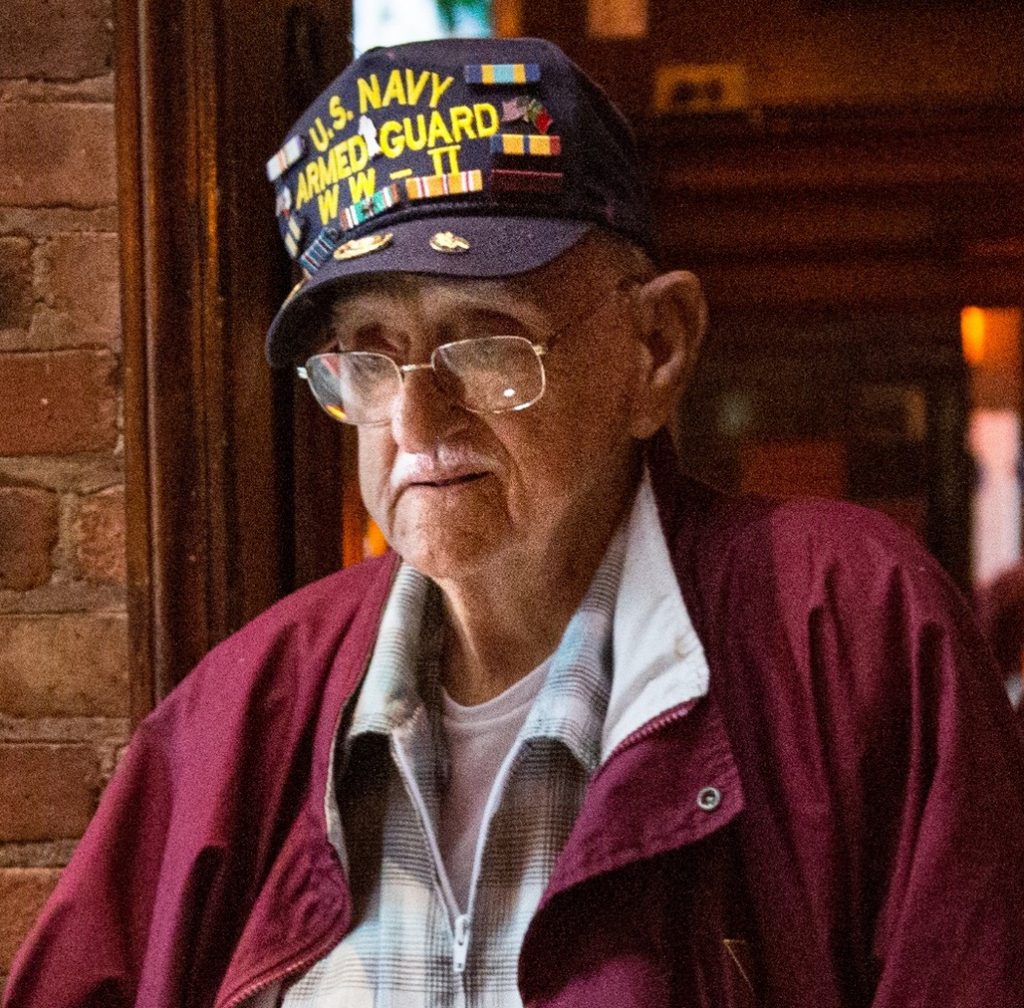
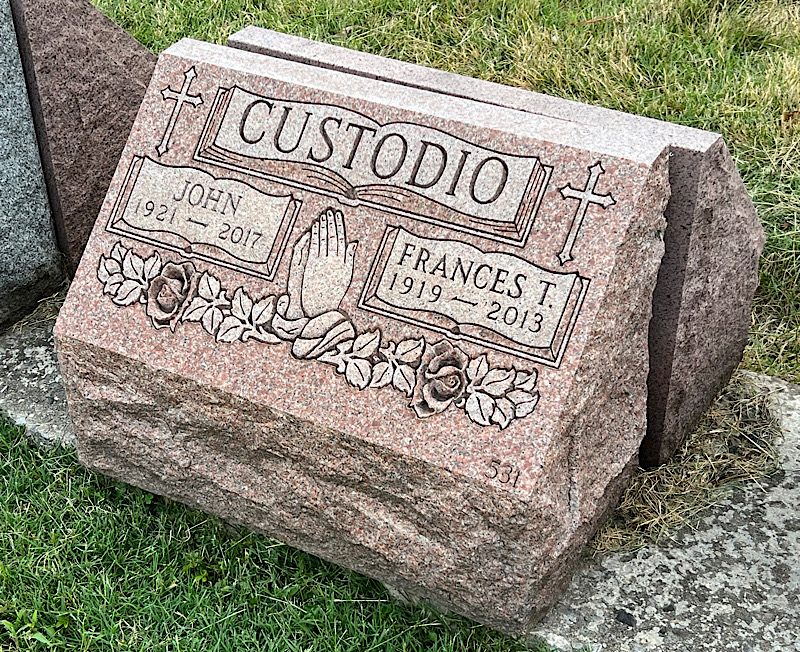
DANITI, ALBERT (1916-1968). Tech 4, 136th Ordnance Maintenance Battalion, 11th Armored Division, United States Army. Born in Lynn, Massachusetts, as a young boy Albert Daniti moved with his father, George, and siblings Peter, Mario, and Fanny to Brooklyn. According to the 1920 census, Albert was the youngest of the four children. His father, George, had immigrated to the United States from Italy in 1909, and was a foreman for a concrete maker in Brooklyn. George’s second wife, Mary, had immigrated from Italy in 1913. Albert’s father died before the New York State census of 1925, leaving Mary to care for his children from the previous marriage, as well as two sons of their own, Henry and Emiliano.
In 1940, when he registered for the draft, Albert Daniti was still living with his family at 964 Fourth Avenue in Brooklyn, and worked at the Emerson radio assembly factory. When he enlisted a year later, on April 16, 1941, he was enrolled as a skilled mechanic with one year of high school education, and trained for the Ordnance Maintenance Division.
The Ordnance Division was recognized as being an important to the war effort, a lesson learned in World War I, and was generously funded by the United States government. According to the division’s official history, it was nicknamed the “Arsenal of Democracy” by President Franklin D. Roosevelt, who oversaw this arm of the military as its enlistments increased from 334 to 24,000 officers and 4,000 to 325,000 enlisted men in its ranks. When the Quartermaster branch shifted maintenance of motor transport to the Ordnance Division in 1942, it became the responsibility of men like Daniti to keep the army on the move. Assigned to the 11th Armored Division, Daniti and his fellow Ordnance Division members would have kept the tanks and other vehicles of the “Lightning Brigade” rolling from the beaches at Normandy in June 1944, through the Battle of the Bulge, and into the heart of Germany during the first few months of 1945. Daniti was discharged on September 30, 1945 after four-and-one-half years of service. He was decorated with the American Defense Service Award for Europe and the Middle East, and commended for good conduct during his years of enlistment.
In February of the following year, he married Stella Marie Vitale at Our Lady of Angels Church, and together they had four children. Section 39, lot 38325, grave 2123.
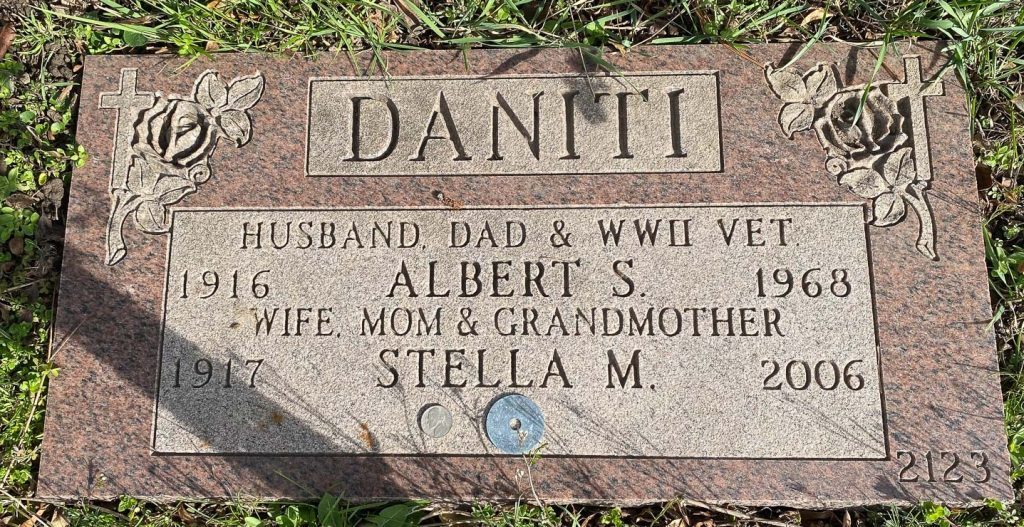
D’AURIA, CARMINE (1925-1991). Private, United States Army. Carmine was born in Brooklyn. The 1930 federal census reports that his parents, Giacomo (Jack) and Florence, were born in Italy, immigrated to the United States in 1921, and his father was a factory laborer. The five-year-old D’Auria lived with his parents and three siblings at 554 49th Street in Brooklyn. The family’s last name is misspelled as Diorio in that record. According to the 1940 federal census, the family had relocated to 3rd Avenue in Brooklyn and his father was an upholsterer for a furniture manufacturing company. Carmine had completed his first year of high school and was one of six children. The transcription erroneously records their last name as Damria.
D’Auria’s World War II draft registration card indicates that he was eighteen years old and resided at 4609 3rd Avenue in Brooklyn. Carmine was employed by Legrand Chemical Company at 103 5th Street in Brooklyn. He designated Daniel Putiguano of 1403 80th Street as next of kin. As per his World War II registrar’s report, dated September 17, 1943, he was 5′ 9½” tall, 145 pounds with brown eyes and hair and a dark complexion. He had two ½” scars over his left eyebrow. According to his World War II enlistment records, Carmine’s enlistment date was November 3, 1943. He had completed three years of high school and entered the United States Army with the rank of private.
Unfortunately, there are no accessible records as to where D’Auria served during the war, what unit he was assigned to, or any promotions or medals he may have received. A World War II hospital admission card documents that he was admitted and discharged to a “general hospital” during January of 1945. His diagnosis was “Wounds, contused (includes bruises); Location: Foot, generally; Causative-Agent: Crushing between objects.” The type of injury is described as: “Battle Injury; Injury Type 2: All battle casualties, and all battle injuries not intentionally inflicted by self or another person.”
After the war, he and Eileen Ann Pringle applied for a marriage license on September 20, 1950 in Brooklyn, according to the New York Marriage License Index. As per Eileen’s obituary, reported in the New York Daily News on October 11, 1985, the couple had five children: Teresa, Laraine, Deborah, Paul and Mark. The Social Security Death Index records that Carmine passed away on October 10, 1991 in Staten Island, six years to the day after his wife’s death. Section 16, lot 14888, grave 41.
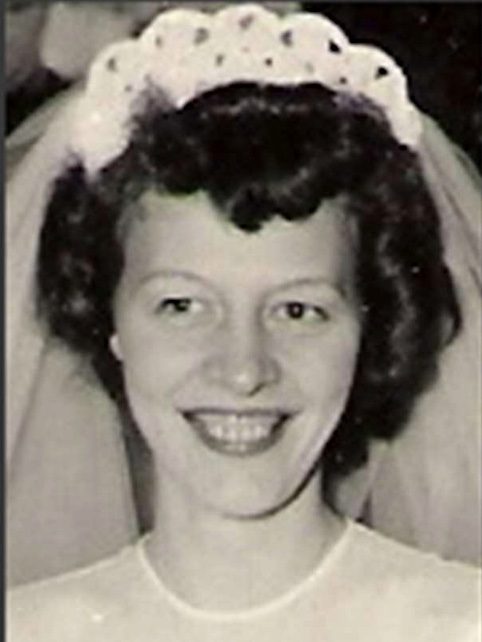
DAVIS, JAMES VANDERVEER (1917-2009). Sergeant, United States Army, 399th Infantry Regiment, 100th Infantry Division. James Vanderveer Davis was born in Brooklyn on December 13, 1917, to James and Viola A. Davis, according to the borough’s record of births. He had five siblings, as noted on the 1930 and 1940 censuses. His family lived at several addresses in south Brooklyn during those years, including Court Street, 3rd Street, Fourth Avenue, and 7th Street. James left school after the eighth grade, possibly in order to work, as it was 1931 and the Great Depression was hitting New York families hard. Indeed, as per the 1940 census, his father was working in Public Emergency Work and his brothers were looking for jobs. By 1940, when he registered for the draft, James recorded his employer as the Aero Spark Plug Company on Greenwich Street in Manhattan. He noted his home address as 303 7th Street in Brooklyn and gave his mother as the person who would always know his whereabouts.
As per his Veterans Affairs records, Davis enlisted in the Army on October 14, 1941, and saw combat in France and Germany. In November 1944, he was wounded in the spine, trunk, and sternum by artillery shrapnel and hospitalized. According to his daughter, Davis said that his life was saved by his military dog tag; that piece of metal worn around his neck intercepted a bullet that otherwise might have killed him. He returned to duty until his release from service on October 6, 1945. Davis was awarded the Bronze Star for meritorious achievement. Per the award citation, he led his squad through fierce fighting in the Vosges Mountains and elsewhere. He also earned the Purple Heart and other medals, according to his daughter, Sharon, and his son-in-law. His service to his country was recognized as recently as the year 2000, when he was awarded the Conspicuous Service Cross by New York Governor George E. Pataki. Section 160, lot 44451, grave 1.
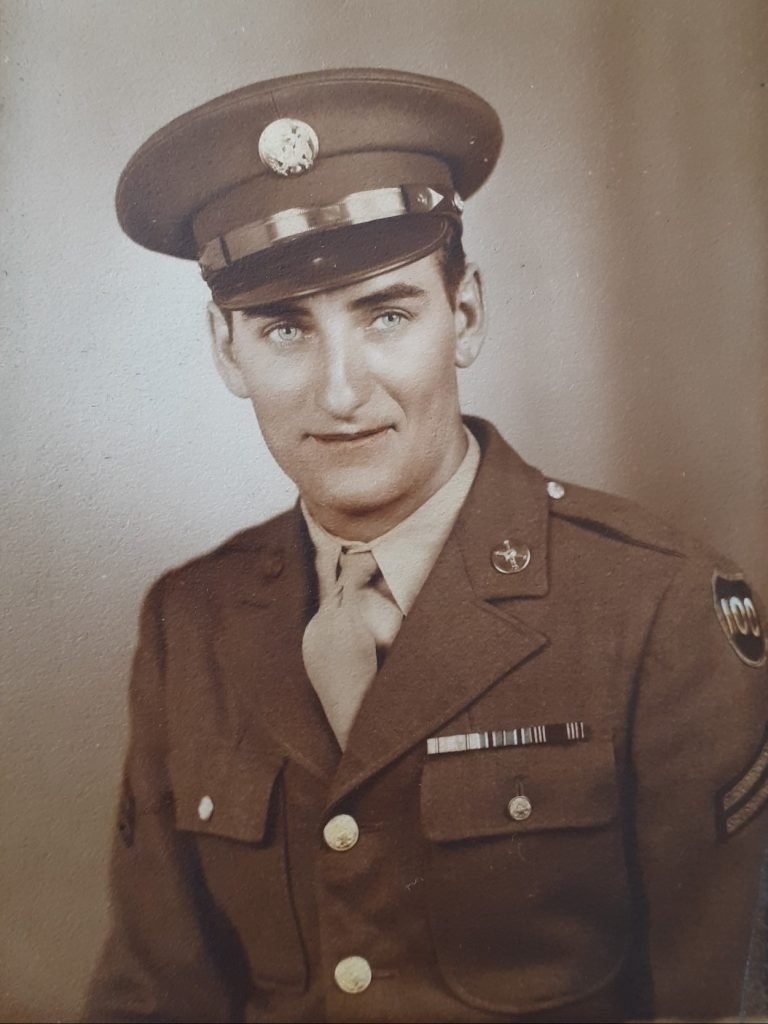
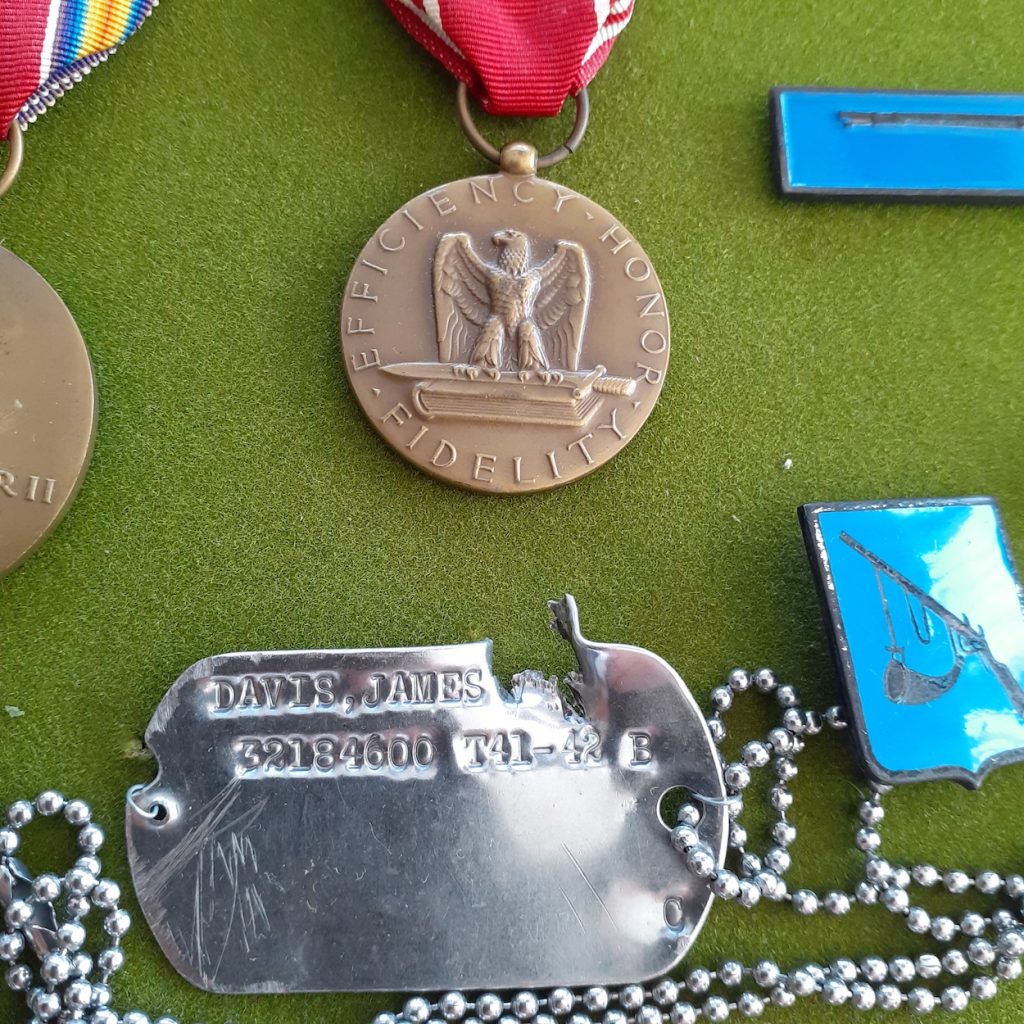
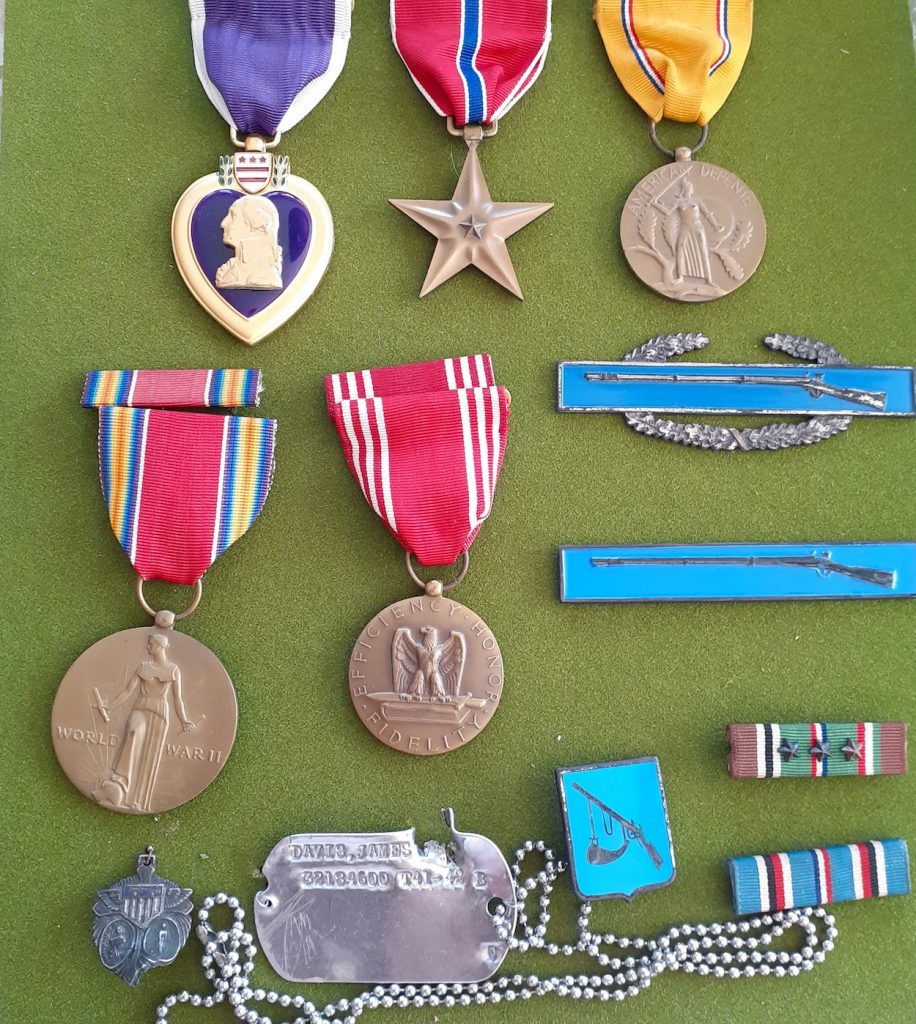
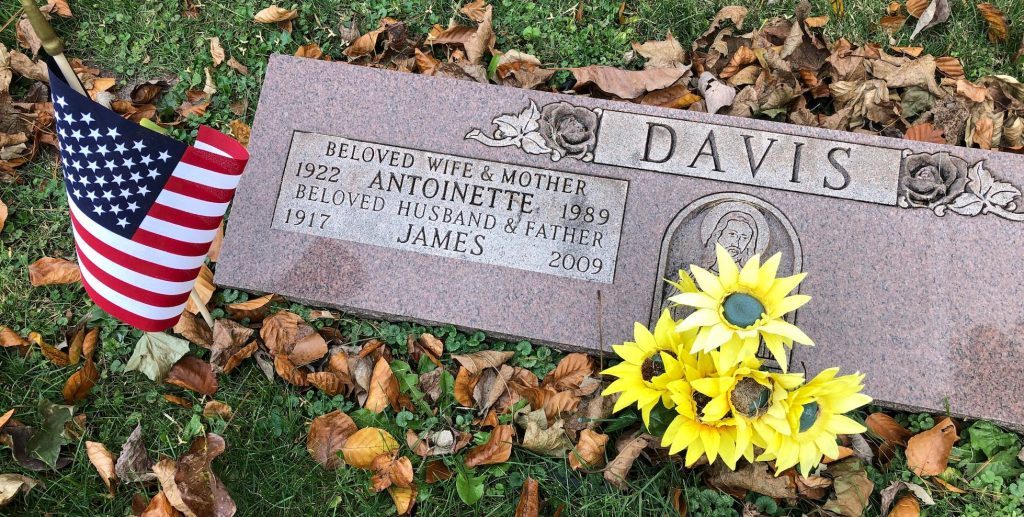
De KAY, JOSEPH RODMAN DRAKE (1898-1982). Captain, United States Navy. Birth records show that DeKay was born at 431 West 23rd Street, Manhattan. On this certificate, as in most of the other official documents, his given name is Rodman Drake. His father, Charles, was born in Washington, D.C., and his mother, Edwalyn, was born in New York City. DeKay was the couple’s sixth child. As per the 1900 federal census, the family resided at 413 West 23rd Street and his father was a journalist. The siblings, ranging in age from two to ten, were: Phyllis, Helena, Catherine, Adrian, Marion and Rodman (Joseph). Also residing with the family was a cook, a nurse, and another servant. The 1910 federal census records that the family still resided at the West 23rd Street address, his father was an “author for a journal,” and the family had grown to eight siblings with the birth of Ormonde and Sylvia. This was the first document that inscribes DeKay’s first name as Joseph. Also living in the household were DeKay’s maternal grandmother, as well as a maid, a cook, and a laundress.
DeKay had the honor of serving in two World Wars. According to the Abstracts of World War I Military Service, his given name was Rodman, he was eighteen years old, and his date of birth was February 2, 1898, a dissimilarity to the February 1 date stated on his birth certificate. He enlisted in the United States Navy on June 10, 1915 as a midshipman, and received the following promotions during his service: ensign on June 7, 1918; lieutenant (temporary) on September 21, 1918; and lieutenant (permanent) on July 1, 1920. He attended the Naval Academy in Annapolis, Maryland, from June 10, 1915 to June 6, 1918. He was assigned to the SS Louisiana from June 20, 1918 to July 13, 1918. His last tour of duty was in Queenstown, Ireland, on the USS Parker, a destroyer, from August 10, 1918 to February 24, 1919. The following excerpt from Wikipedia details the events the USS Parker took part in while DeKay was on board:
The Parker steamed from France to Queenstown, Ireland, joining the U.S. Naval Forces patrolling the Irish Coast. There she escorted convoys safely through the war zone and assisted vessels in distress. From July–November 1918, Parker was attached to the base at Plymouth, England, and operated with U.S. submarine chasers. Parker made contact with German submarines on several occasions during the war.
On February 26, 1918, Parker assisted in rescuing nine survivors of British hospital ship, the Glenart Castle, which had been torpedoed by German submarine UC-56. The men of Parker were commended by the British Parliament, the Admiralty, and the U.S. naval authorities. On November 1, Parker sailed from Plymouth for Gibraltar but returned to Plymouth at the end of the war.
After returning to Plymouth after the Armistice was signed, Parker carried mail and passengers between Plymouth and Brest. She made a cruise to German ports in early 1919 to implement the terms of the armistice, before steaming to the Baltic Sea to assist members and vessels of the American Relief Administration.
A brief article in the Washington Times, dated January 18, 1922, announced the forthcoming marriage of Lieutenant Rodman Drake DeKay and Ann Wickes Craven (daughter of Thomas Tingey Craven (see)). They married during June of 1922 in Jamestown, Rhode Island. As per the 1925 New York State census, DeKay lived with his wife on West 10th Street in Manhattan. He was an electrical engineer and the couple had a son, Rodman Jr. The 1930 federal census details that the family lived in North Hempstead, Long Island. DeKay was still an electrical engineer and he and Ann had a second child, Ann. The 1940 federal census documents that the family still resided in North Hempstead and DeKay worked for Bell Laboratory as an electrical engineer.
Little is known of DeKay’s military service during World War II. As per his Department of Veterans Affairs BIRLS (Beneficiary Identification and Records Locator Subsystem) Death File, he enlisted in the service on November 19, 1942 and was discharged on February 22, 1946. According to the Select Military Registers, published in 1943, DeKay is registered as a lieutenant commander with the classification of DEVG, signifying a “commissioned deck and engineer officer qualified for general detail afloat or ashore.” He is again listed in the July 1944 Register as a commander with a “66” code, designating that he “attended subchaser training.” A documentation in the 1951 Military Register reports that he was a captain and also documents DeKay’s son as an ensign.
The 1950 federal census details that the DeKay family lived in North Hempstead and that DeKay was still employed by Bell Labs. His daughter still resided with her parents and she was a machine engineer on special devices. The DeKays enjoyed traveling. The passenger list for the SS Queen of Bermuda shows that DeKay, his wife, and their daughter were on board the ship, travelling from New York to Hamilton, Bermuda, in April of 1950. The passenger list for the SS Liberte indicates that the couple lived in Port Washington, New York. They sailed from LeHavre, France on May 27, 1953 and arrived in New York on June 2, 1953. In 1960, DeKay and his wife sailed from New York to Plymouth, England, on the SS Liberte. The couple arrived in England on September 30, 1960. Section 42, lot 41.
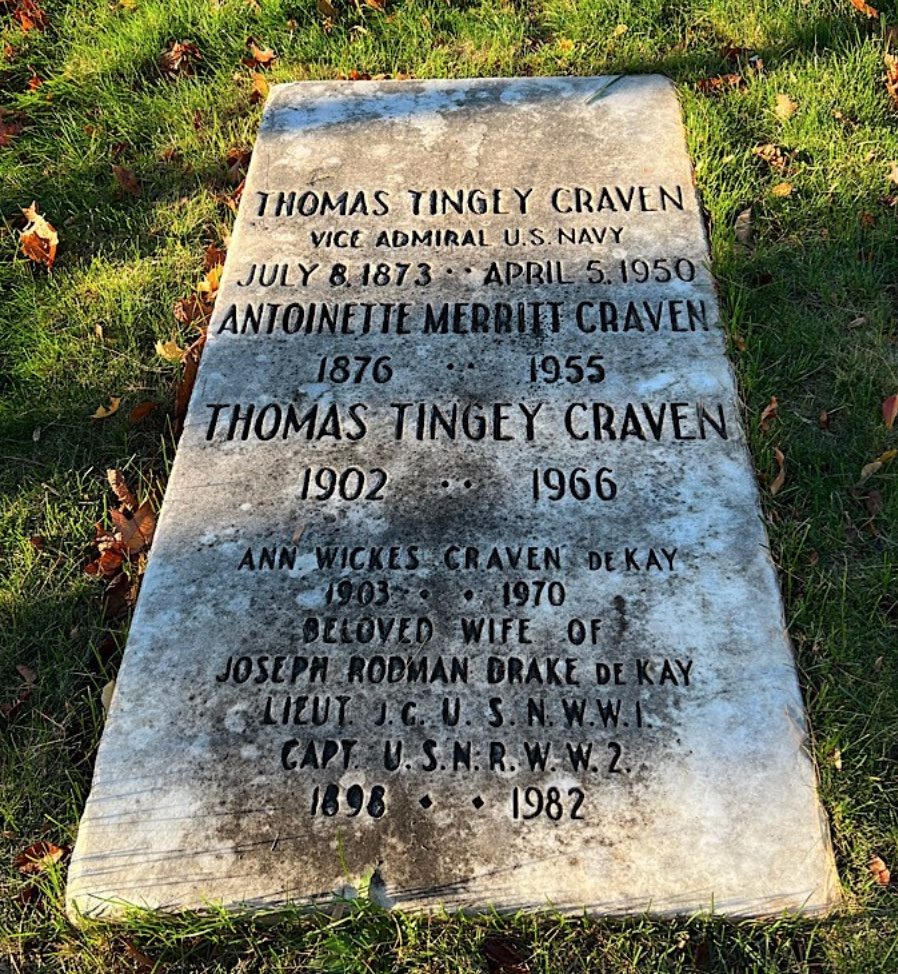
De LORENZO, DOMINIC (1925–1993). Corporal, Marine Aircraft Group 11, United States Marine Corps. A Brooklyn native, Dominic was the son of two Italian immigrants, father Anthony, who was employed in factory work, and mother Acquilla (alternately Aguila, Aquila, and even Nicoletta, according to various censuses), whom he listed on his enrollment papers as his next of kin. Married before they arrived in the United States, Dominic’s parents brought their son Emilio with them as they made the long journey, and added six more children after settling in Brooklyn, of which Dominic was the youngest. In 1933, when Dominic was eight years old, his father died, and by the census of 1940, when Dominic was fifteen, five of the seven children still resided with their mother. He graduated from New Utrecht High School in 1942. His classmates added, or had added for them, lines or poems to describe them in their yearbook, and his read “Perhaps no service for our school, Yet still in all, he’s nobody’s fool.”
He may not have been a service to his school, but he was to his country. He was working at the Manson Hat Company in Manhattan in 1943, according to his draft registration card, but by October, 1944, he was in the South Pacific, and fought in the Battle of Peleliu, according to his son. This battle saw the Marines suffer 6,526 casualties. Beyond this battle, and that his mailing address during the war was Marine Aircraft Group 11, not much is known of his service. According to the Marine Aircraft Group 11’s online history, they were based in the New Hebrides Islands, and took the offense against enemy ships, aircraft, and strongholds.
Returning to Brooklyn after the war, Dominic married Brooklyn native Eleanor Pisacani on October 21, 1950. During his 28 years of service in the New York City Police Department, he rose to the rank of lieutenant and raised three children with his wife. Section 149, lot 44608, grave 2.
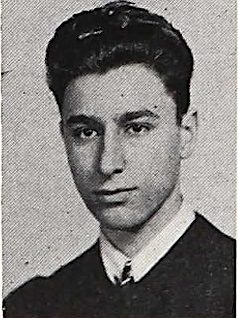
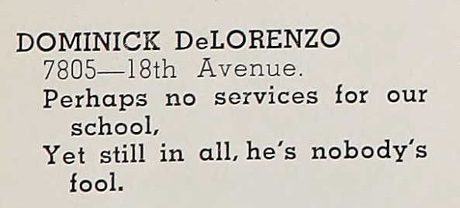
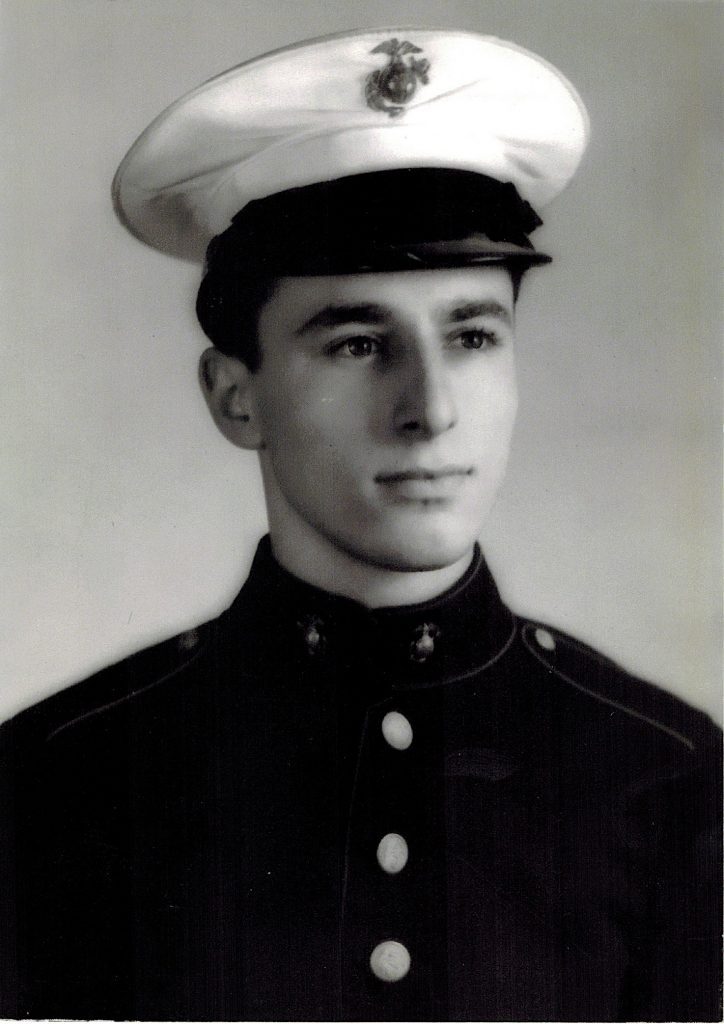
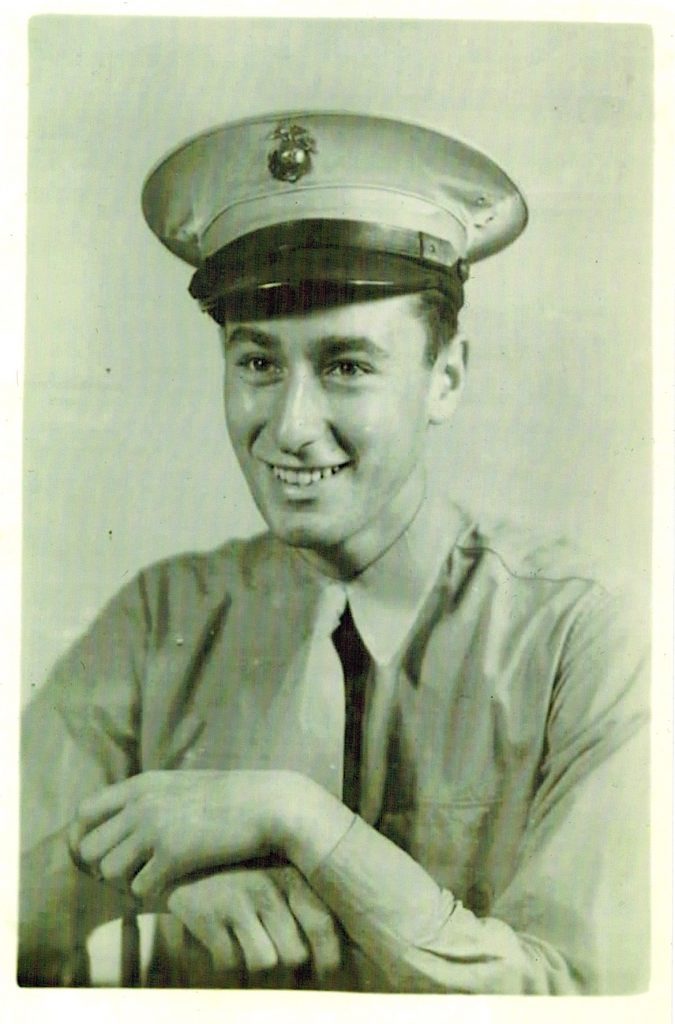
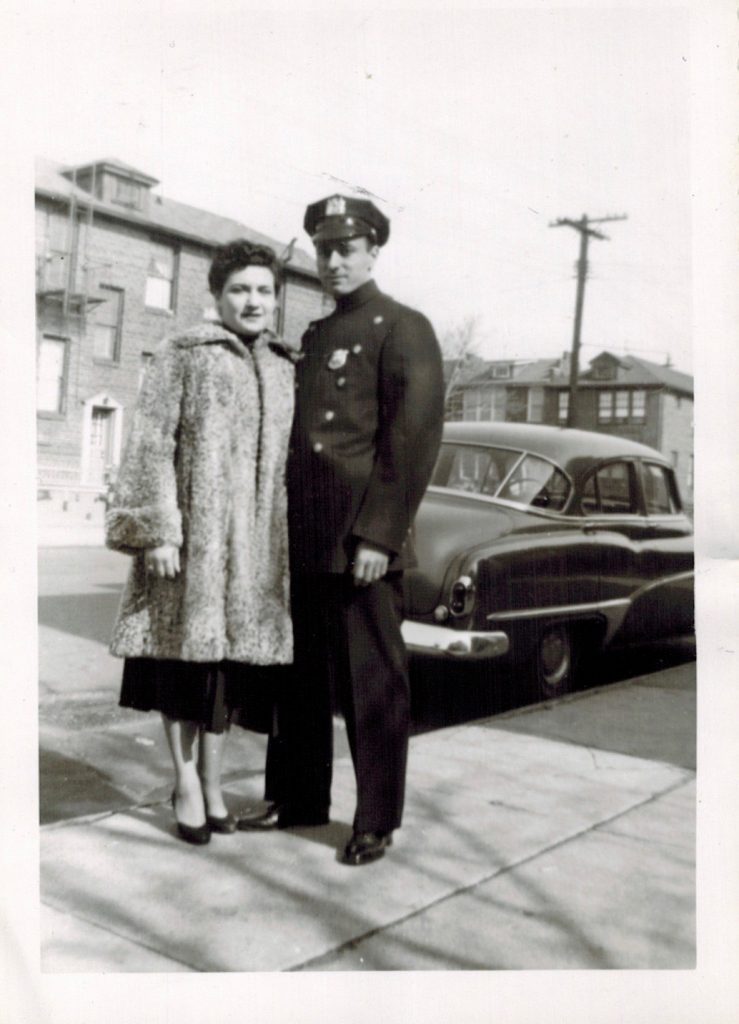
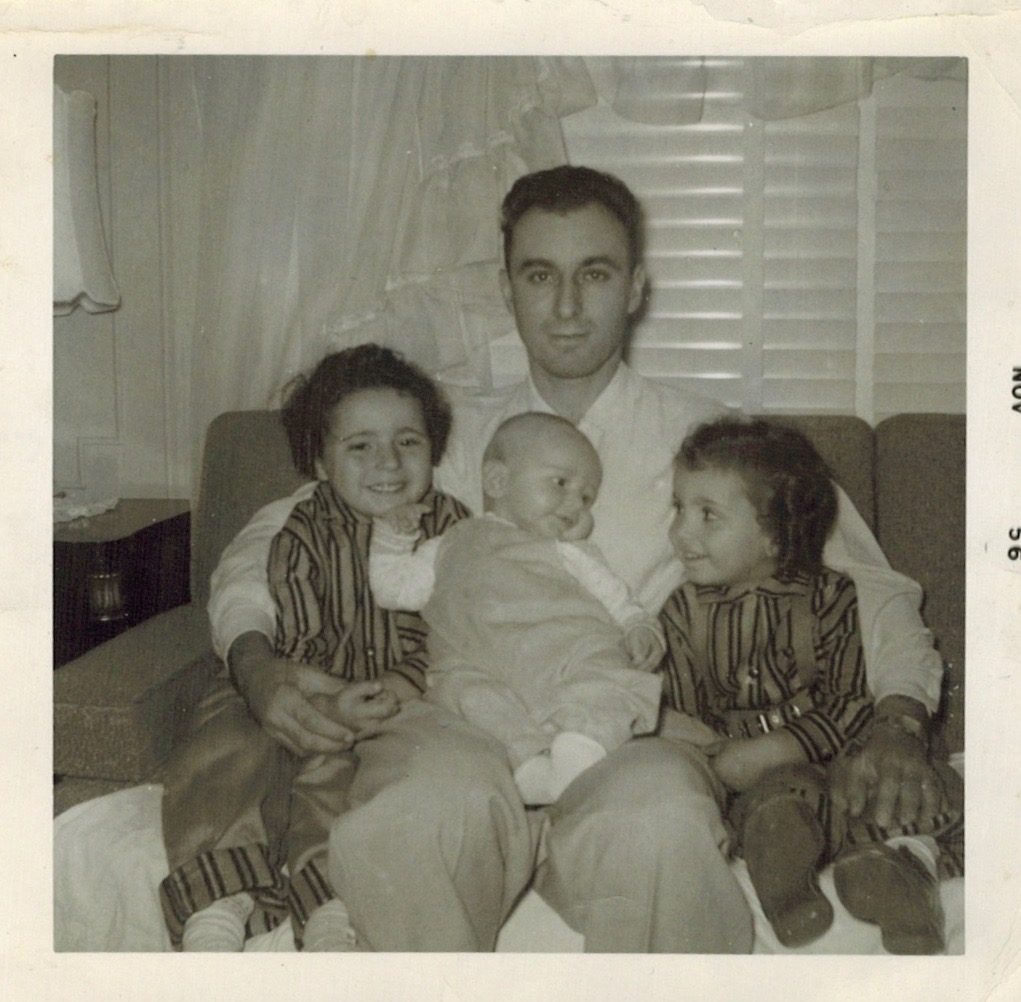
DEL PRETE, CARL (or CARLO) FRANK (1927-2017). Seaman, United States Navy. The youngest of seven children, Carl (also known as Carlo in some documents) Frank Del Prete was born in Brooklyn to Louis (Luigi) Angelo Michele Del Prete, age 40, and Antoinetta Casaregola Del Prete, age 34, on September 8, 1927. Both parents were born in Italy. His siblings, from oldest to youngest, were Angelina, Christina, Freddy, Ida, Richard, and Louis, and they were all born in New York.
The 1930 federal census indicates that the family owned their home at 672 4th Avenue in Brooklyn, and that the home had a value then of $20,000. Louis Del Prete is identified as a “proprietor” in the candy and ice-cream industry.
By the 1940 federal census, the family home had lost value, being assessed at $10,000. Louis Del Prete was a proprietor of a retail pastry shop and his wife and three children – Fred, Ida, and Richard – all worked in the shop. As per the Find A Grave entry for Louis Del Prete (listed there as Luigi Del Prete, “he came to the United States through Boston where he met and married Antonetta Casregola. Together they founded and ran Caserta Pastry Shop in Brooklyn, New York. They raised seven children, three of whom continued the family business by opening pastry shops in Connecticut and Long Island.” Regarding Carl Del Prete’s siblings, Louis became a professional entertainer and trumpet player; Christine (Agoglia) and Fred both stayed in the bakery business, Christine first in New York and later in Norwalk, Connecticut, while Fred opened two bakeries in Bridgeport, Connecticut; records indicate that Richard died in Leicestershire, England in 1991.
Ancestry.com lists the following life dates for Carl Del Prete’s siblings: Angelina Ann Del Prete D’Amico, 1913-2007; Christina Del Prete Agoglia, 1915-2009; Ferdinando Neal “Fred” Del Prete, 1916-1987; Aida Del Prete DiBiagio, 1918-2010; and Riccardo “Richard” Edward Del Prete, 1921-1991.
Carl Del Prete registered for the draft on September 18, 1945, when he was 18 years of age. According to his draft registration card, he was 5′ 8″ tall and weighed 150 pounds. He had a dark complexion, with brown hair and brown eyes. He listed his mother as his contact, with both living at 672 4th Avenue, Brooklyn. Del Prete was employed by Sullivan Dry Dock in Brooklyn.
According to Del Prete’s daughter, Carle T. Del Prete Falk, he was “drafted after VJ Day (Victory Over Japan Day) to decommission aircraft carriers from the Pacific. He helped decommission The Intrepid with considerable damage. His sea time was one day when the ship came into San Francisco Bay to be turned around and painted.” This is the same USS Intrepid aircraft carrier that was launched in 1943 and saw action in the Pacific arena, surviving five kamikaze attacks and one torpedo strike. It is now the centerpiece of the Intrepid Sea, Air & Space Museum, located along the Hudson River in New York City. Del Prete’s muster rolls from 1946 show him as a member of that ship’s crew.
According to his obituary, after he left the Navy, Del Prete attended Michigan State University, graduating in 1951. He completed his JD at Brooklyn Law School in 1956. He practiced law in the New York area, including Manhattan, Brooklyn, and Katonah.
On October 13, 1962, in Putney, Vermont, he married Anne Lucille Bernache, a dental assistant, of Northampton, Massachusetts, and they had two children, Carle Del Prete Falk and Crawford Del Prete, raising them in the Katonah-Lewisboro area of northern Westchester County, New York, and four grandchildren: Gabrielle, Griffin, Harrison, and Conner.
On October 26, 1962, Del Prete’s father died in Brooklyn, and, on December 1, 1967, his mother passed away. Anne Del Prete, Carl’s wife, died in May 1985 in New York, at age 57. They had been married 22 years. After her death, Del Prete began a long-term relationship with Jane Penny of Brooklyn, who died in 2016.
Del Prete died on December 24, 2017, in Colchester, Vermont. He and Anne are interred together in Green-Wood. Lot 45000, grave 212.
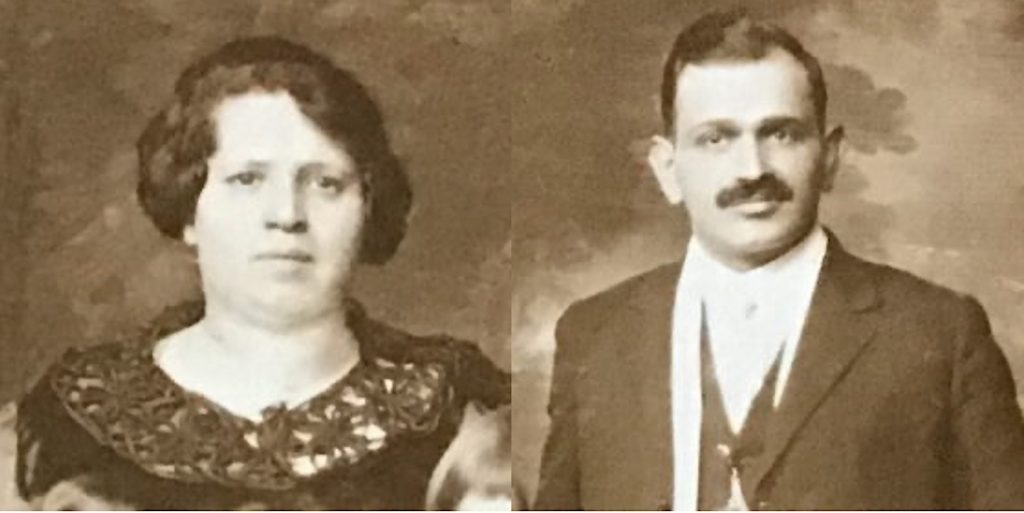
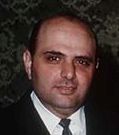
DeMAIO, ALFRED JOHN (1927-2016). Private, United States Army Air Corps, 1377th Army Air Force Base Unit. Born in Brooklyn, the 1940 census lists him as living at 225 21st Street in Brooklyn with his parents, two brothers and a sister; his father, Lorenzo, was a laborer (listed as a shoemaker in the 1930 census), and his mother, Assunta, was an operator in a dress factory. Per family notes in a Brooklyn Public Library collection, he attended Manual Training (now John Jay Educational Campus) High School in Brooklyn for four years. At the time of his enlistment, October 16, 1945, he lived at the same address, according to his draft registration card, and was working at California Packing Company, at 49th Street and First Avenue in Brooklyn
He entered the service at Fort Hancock in New Jersey, attended Airplane and Engine Mechanic School, and served as an airplane engine mechanic, per his honorable discharge report, dated December 16, 1946. The report also notes that he received a World War II Victory Medal. His separation report, from Westover Field, Massachusetts, states that he was 5′ 5″ tall, weighed 155 pounds and had green eyes and brown hair.
After his military service, he married Grace Castrogiovanni in Brooklyn in 1960; they had three children, Suzanne, Joseph and Janet. His primary employer was the Nu Life Dental Lab, where he worked for many years. He was an usher at St. Agatha’s Roman Catholic Church for 40 years. His brother, Vincent (see), who died in 2012, also served in World War II. He died in New Jersey and was survived by five grandchildren. A mass was held at St. John the Evangelist in Brooklyn, according to his obituary on the Hegarty Scalia Funeral Home website. Section 149, lot 44608.
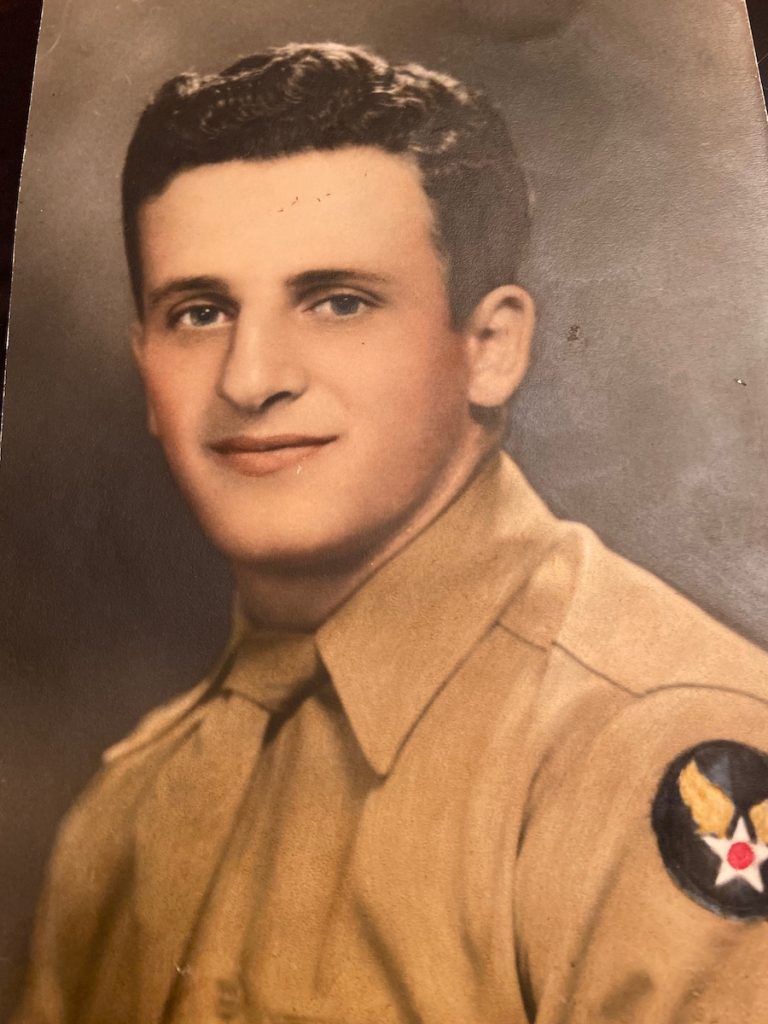
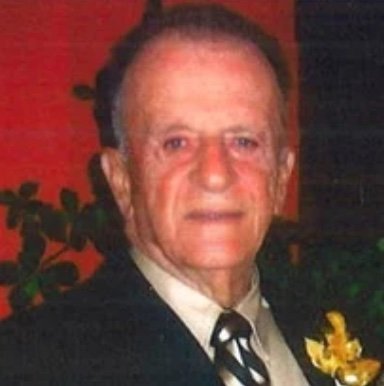
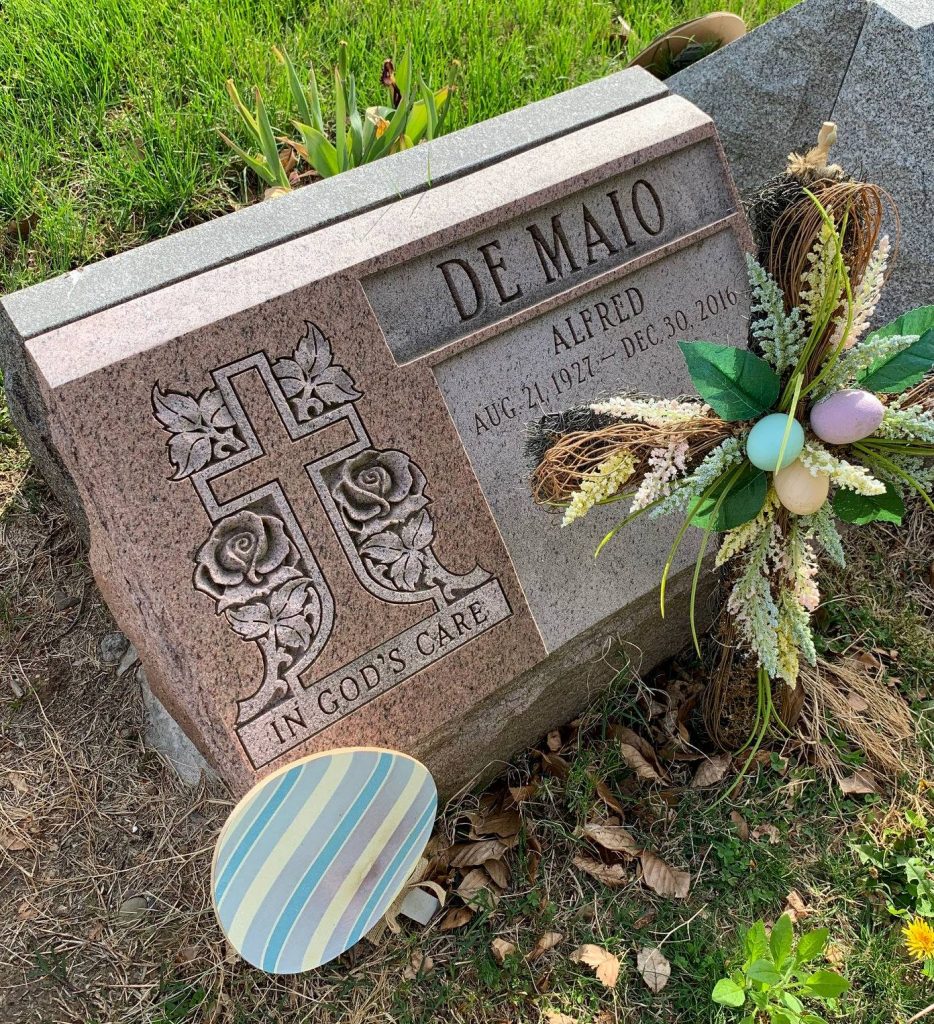
DE MAIO, VINCENT (or VINCENZO) J. (1925-2012). Corporal, 468th Signal Heavy Construction Company (Aviation), United States Army. Born Vincenzo De Maio (also spelled Demaio) in Brooklyn, De Maio was living there at the time of the 1930 census. His father, Lorenzo, was a laborer (listed as a shoemaker on that census) and his mother, Assunta, was an operator in a dress factory. He had two brothers, Alfred (see), also called Fred, and Albert (Al) and a sister Saveria (Sadie). He graduated from Manual Training High School (now John Jay Educational Campus) in 1943.
De Maio’s 1943 draft registration card, signed on January 11, 1943, when he was 18 years of age, indicates that he lived at 225 21st Street in Brooklyn. He listed his aunt, Mrs. Antonietta De Maio, living at 216 21st Street, Brooklyn, as his contact. At the time he was a student and unemployed, 5′ 5″ in height and weighed 152 pounds. He had blond hair, blue eyes, and a light complexion. As per his daughter Susan, he had red hair and was known by many by his nickname “Red.”
His World War II enlistment record shows that he was inducted into the Army on April 10, 1943, with his occupation at that time listed as a general industry clerk. De Maio attended Signal Corps school, training to be a radio mechanic, and served in the South Pacific during World War II, seeing action in New Guinea and the southern Philippines. He was awarded the Asiatic Pacific Service Medal, Philippines Liberation Ribbon, World War II Victory Medal, and a Good Conduct Medal. He was discharged as a corporal on January 11, 1946, with 1 year, 9 months of foreign service. De Maio was one of three brothers who served in World War II and were honorably discharged. Fortunately, all survived.
Vincent De Maio and Alba P. Rosiello applied for a marriage license in Brooklyn, married on January 8, 1950, and had three children, Susan, Vincent, and Laura, and two grandchildren, Lorenzo and Matteo. As per their daughter, the couple lived in Bay Ridge for most of their married life. In 1991 he was living at 549 739th Street in Brooklyn, per the United States Public Records Index. His primary employer was the United States Treasury Department, where he worked as an import specialist, Grade 13, for the United States Customs Service for 38 years. Section 109, lot 42149, grave 1.
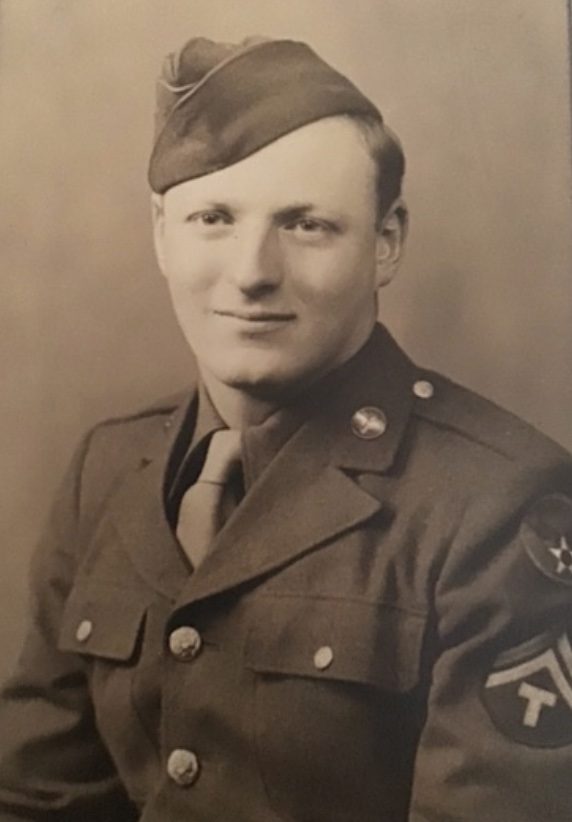
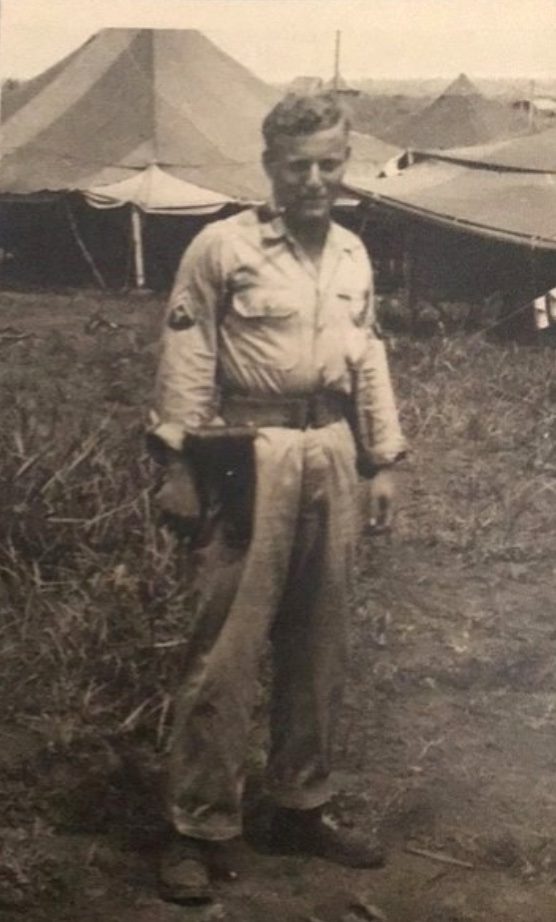
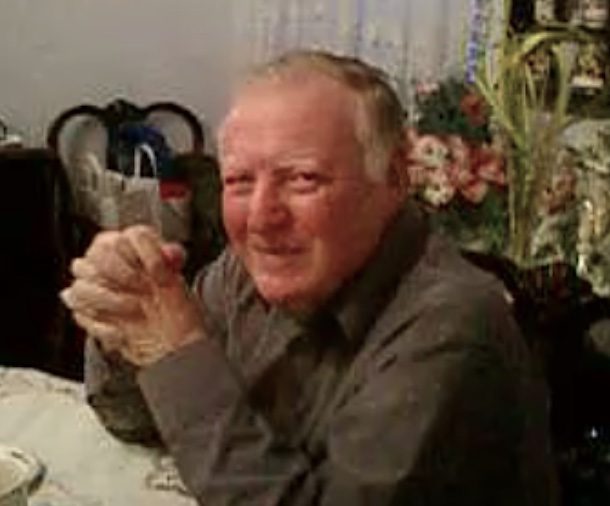
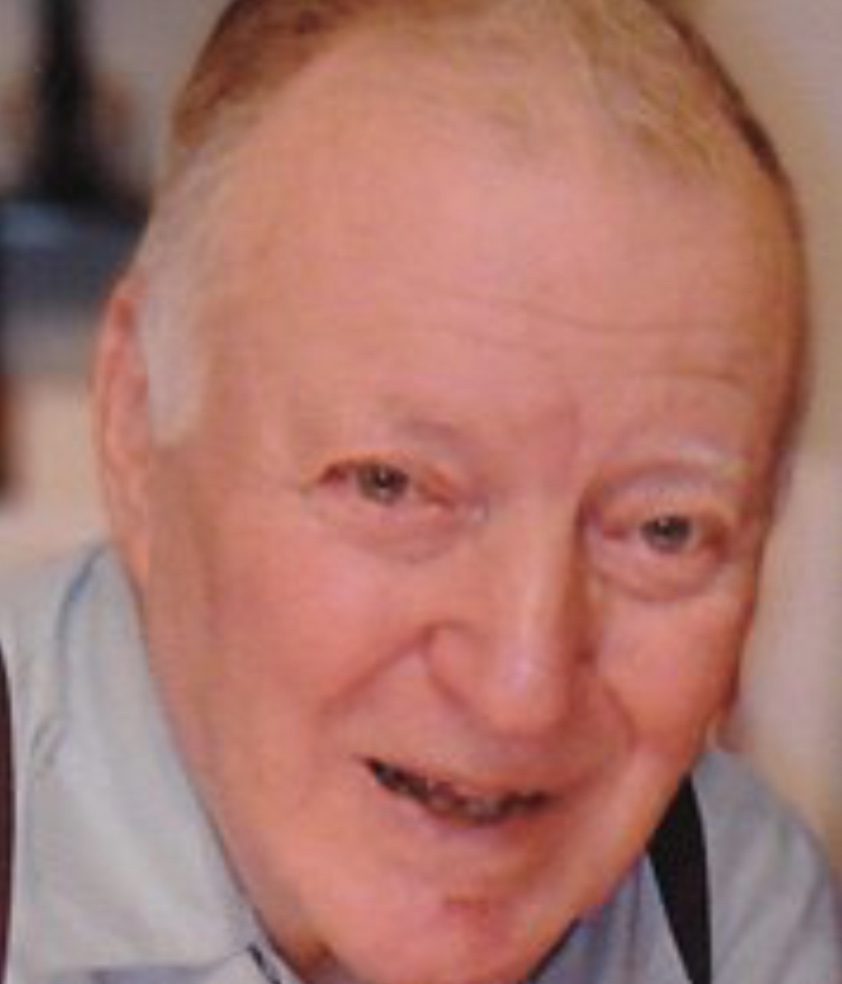
DEMARINIS, DOMINICK (or DOMENICO) (1919-1985). Private, United States Army. DeMarinis was born in Brooklyn. His first name is documented there as Domenico. According to the 1920 federal census, his parents, Frank and Carrie, were born in Italy and his father was a coal peddler. Dominick, the youngest of five siblings, was less than a year old at the time of the census. The DeMarinis family resided on 7th Avenue in Brooklyn. As per the 1930 federal census, Dominick’s father was a naturalized citizen and worked in a warehouse. The family had grown to seven children, ranging in ages from six to twenty-one. They still lived on 7th Avenue and the eleven-year-old Dominick attended school. The 1940 federal census records that the family resided on Windsor Place in Brooklyn and his father was a cook at a retail grocery. This census documents that Dominick was a high school graduate.
Dominick’s World War II draft registration card notes that he was twenty-one years old and resided at 439 15th Street in Brooklyn. His employer was A. T. Minassian and Sons, located at 541 West 22nd Street in Manhattan. His mother was named next of kin. The registrar’s report, dated October 16, 1940, describes him as 5′ 6″ tall and 135 pounds with blue eyes, brown hair, and a light complexion.
There is little information about Demarinis’s service to his country during World War II. His World War II enlistment record documents that his date of enlistment was May 12, 1942. He entered the service as a private and his civil occupation is recorded as “semi-skilled occupation in trades and services.” As per the Department of Veterans Affairs BIRLS (Beneficiary Identification and Records Locator Subsystem) Death File, Dominick’s enlistment branch was the United States Army and his discharge date was January 18, 1946.
According to the New York Marriage License Indexes, Dominick and Ursula M. Dusey applied for a marriage license on January 22, 1949 in Brooklyn. A birth announcement of their son appears in the November 10, 1949 issue of the Brooklyn Eagle. As per the 1950 federal census, Demarinis and his family resided on Prospect Park Southwest in Brooklyn. Dominick was an order clerk at a wholesale metal parts company.
His obituary in the New York Daily News reports that he and Ursula had three children: Frank, Isabel Punch and Catherine. Section K, lot 46000, grave 58.
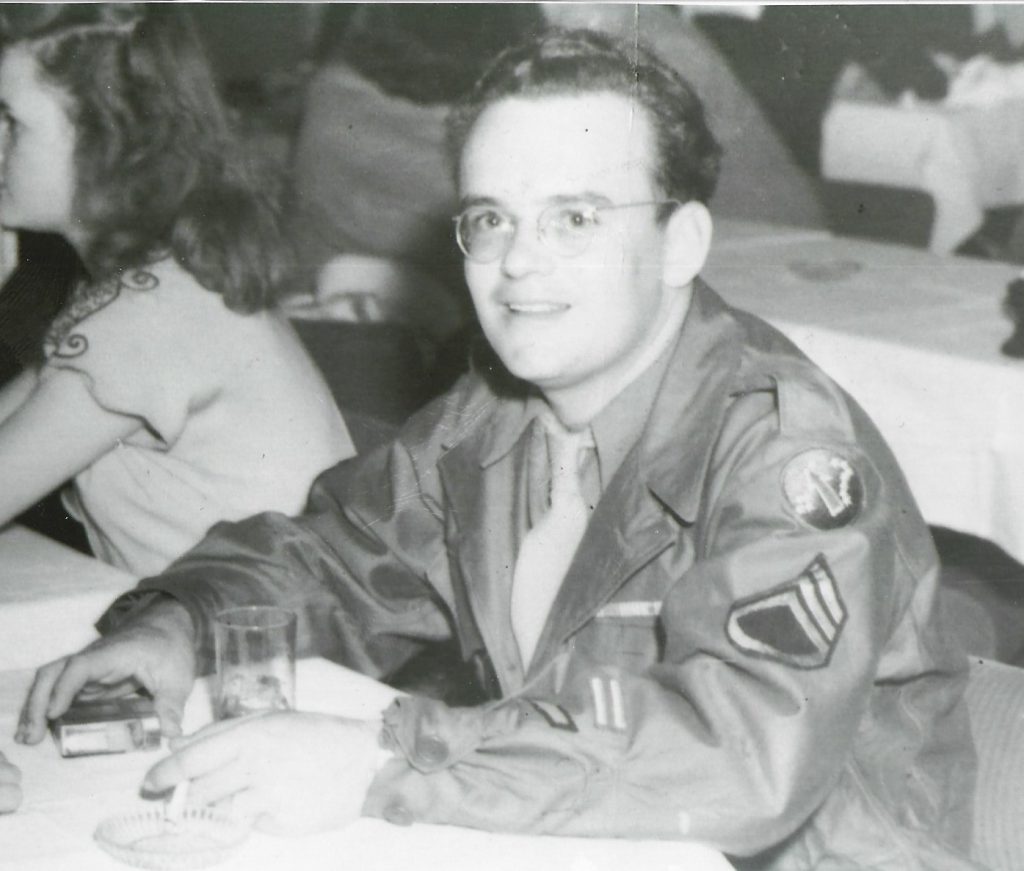
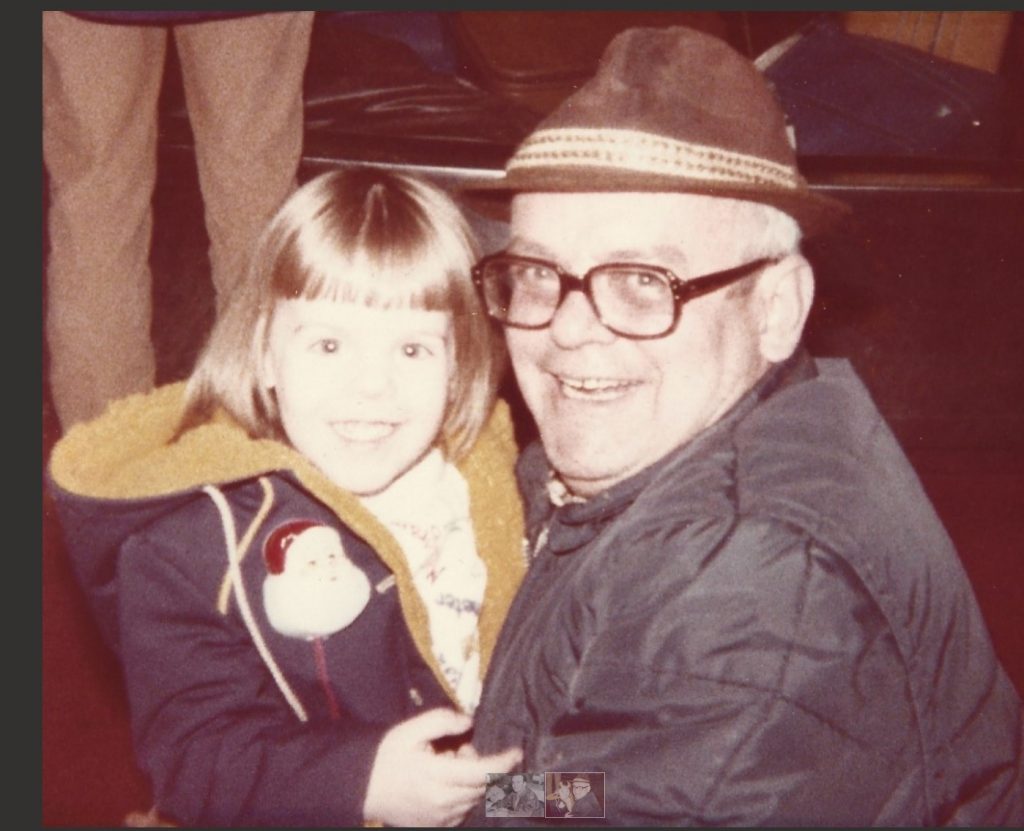
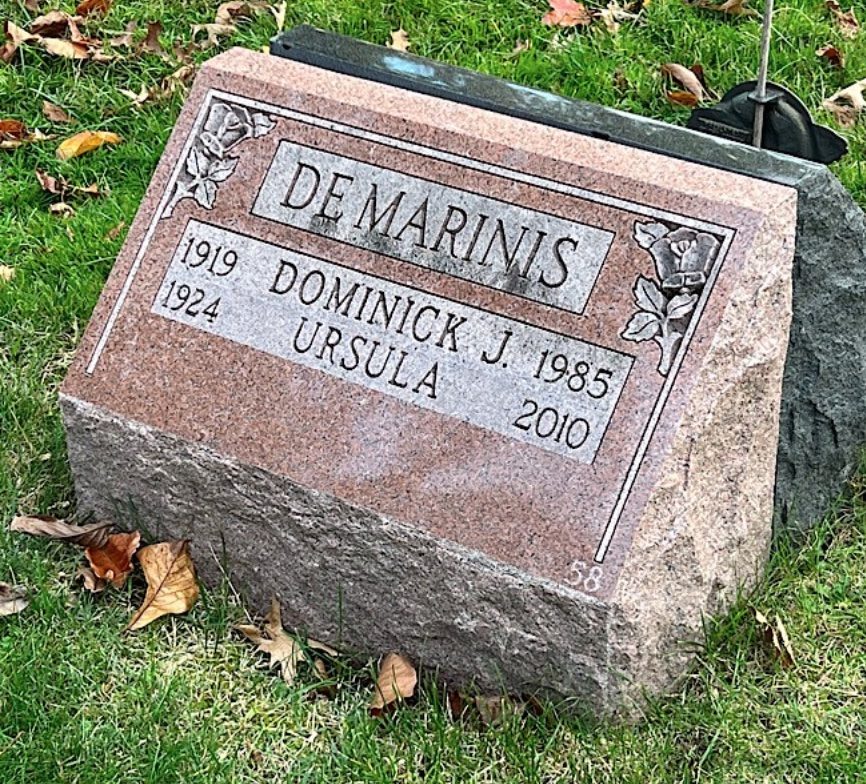
DEMAS, TERRY (1912-2002). Private, United States Army. Terry Demas was born Asterios Dimitrakoulakos in Oitylo, a village on the Peloponnese Peninsula of Greece. He was the second surviving son born to Charles and Pota Dimitrakoulakos. Terry, his parents, and his older brother Michael were all born in Oitylo. Charles and Pota apparently had four other children who died in Greece before the family came to the United States.
Terry’s father, born in 1875, immigrated to the United States in 1914, settling in Lowell, Massachusetts, with his brother, Elias, and started his own grocery business. In 1921, Pota, Michael, and nine-year-old Terry immigrated from Greece and joined Charles in Lowell. Terry’s younger siblings, Peter and Helen, were both born in Massachusetts. By 1935, according to that year’s New York State census, the family had moved to Brooklyn and changed their surname to Demas.
Demas registered for the draft on October 16, 1940, when he was 28 years old. His draft registration card describes him as having a dark complexion, brown hair, and brown eyes. At the time, he was employed by Continental Quilting Company on 39th Street in Brooklyn.
Terry enlisted as a private in the United States Army on April 17, 1942, at Fort Jay, Governors Island in New York Harbor. By then he had become a United States citizen. His enlistment record states that he had three years of high school and that he was a cook. In January 1944, while he was in the army, Terry was hospitalized for poisoning or intestinal infection due to salmonella. Demas was discharged from the Army on October 9, 1945.
According to his son, Terry served with the Army’s 4th Infantry Division. During the period of his enlistment, the 4th Infantry was active in the United States, England, and western Europe. After the war, Terry worked primarily as a waiter, according to his son.
Terry and Stella (Manos) obtained a marriage license on July 3, 1947, and, according to their son, were married on July 20, 1947. They went on to raise four children in Brooklyn. Terry died at the age of 89. He is buried in Green-Wood, as are his wife and parents. Section 61, lot 44703, grave 130.
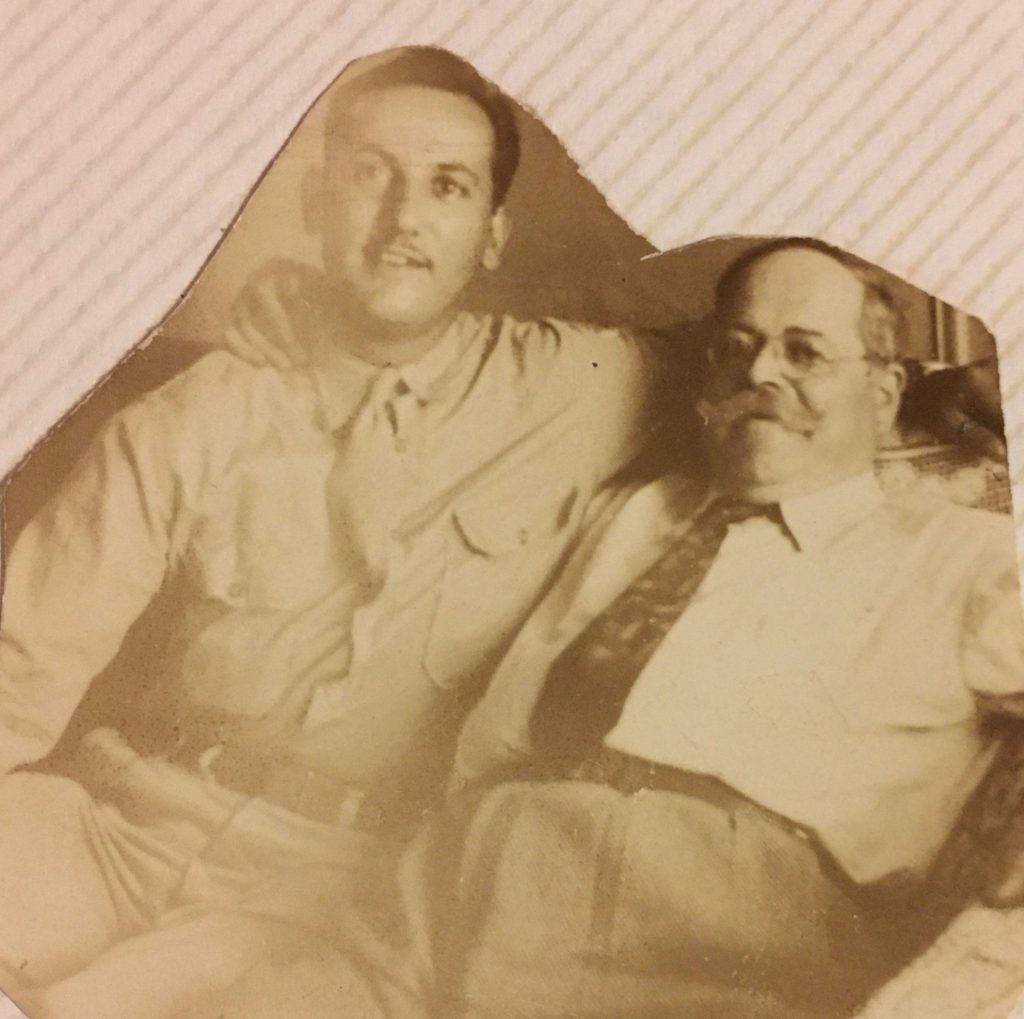
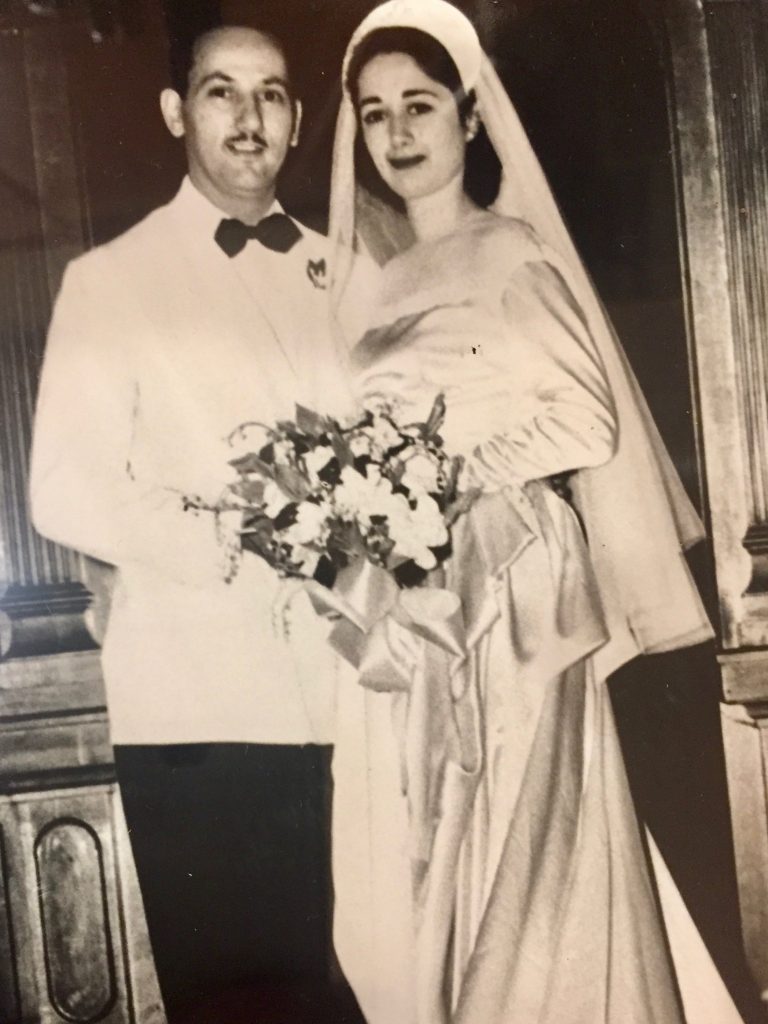
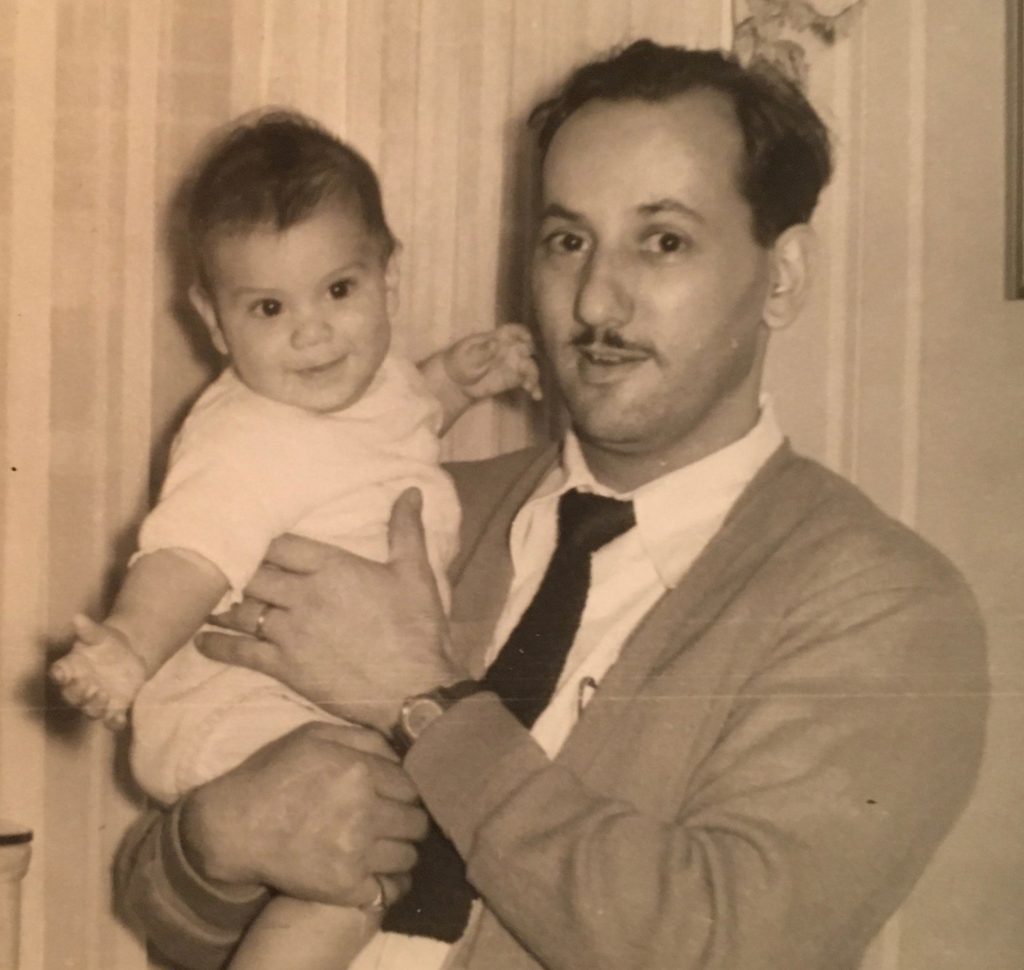
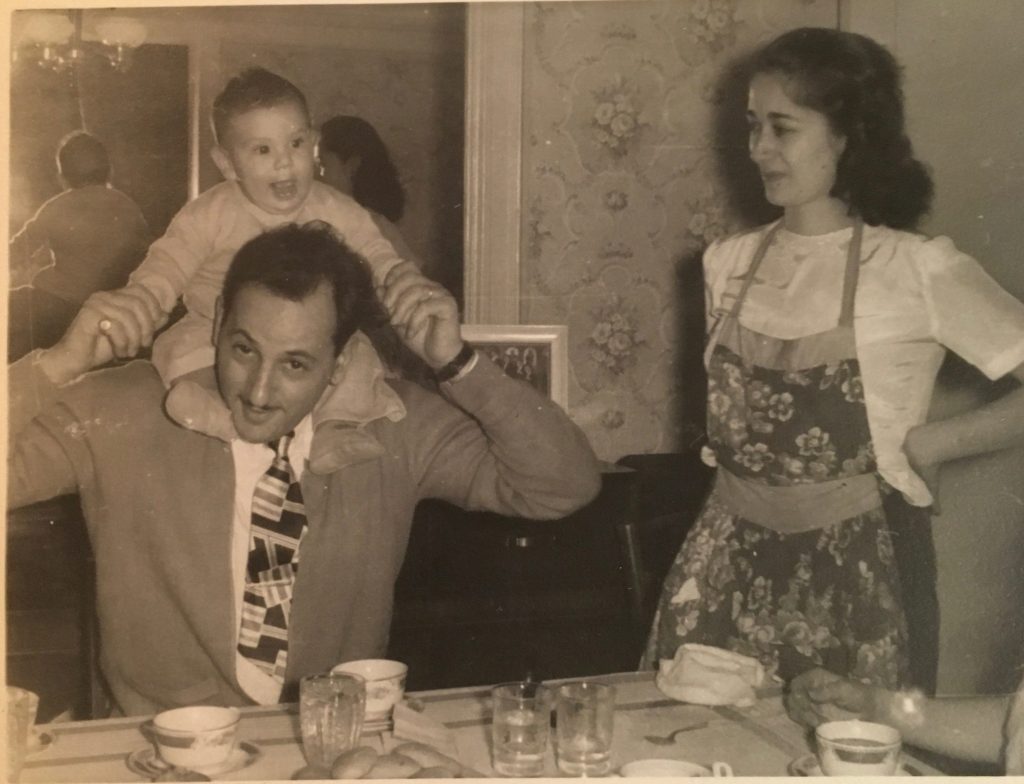
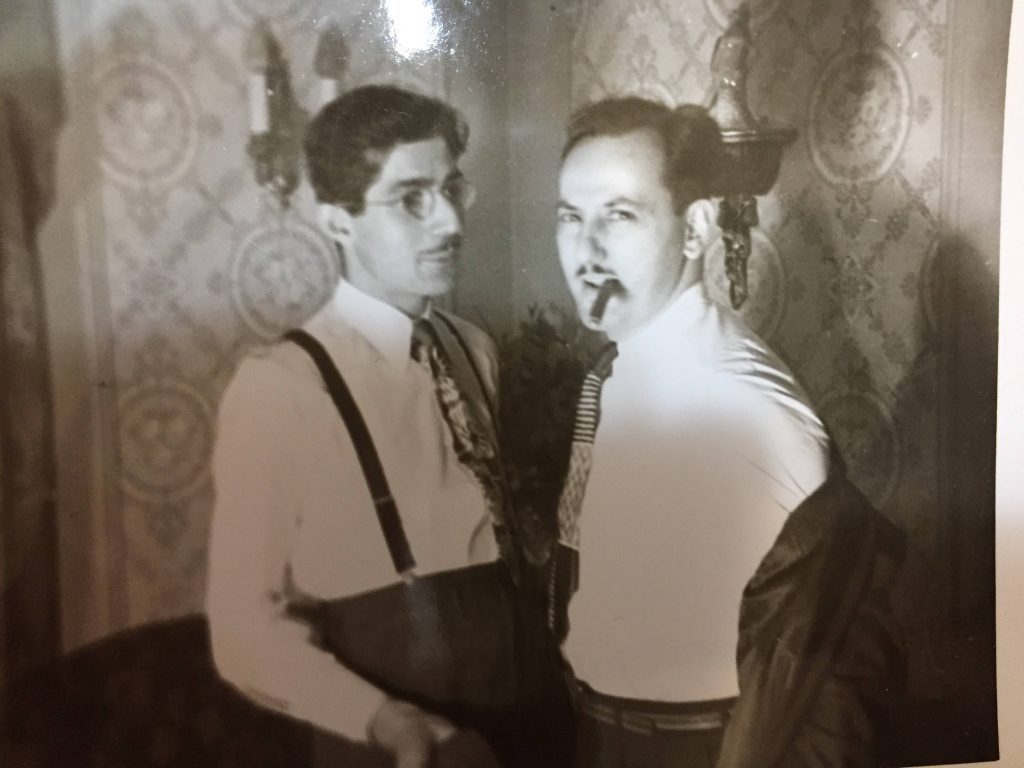
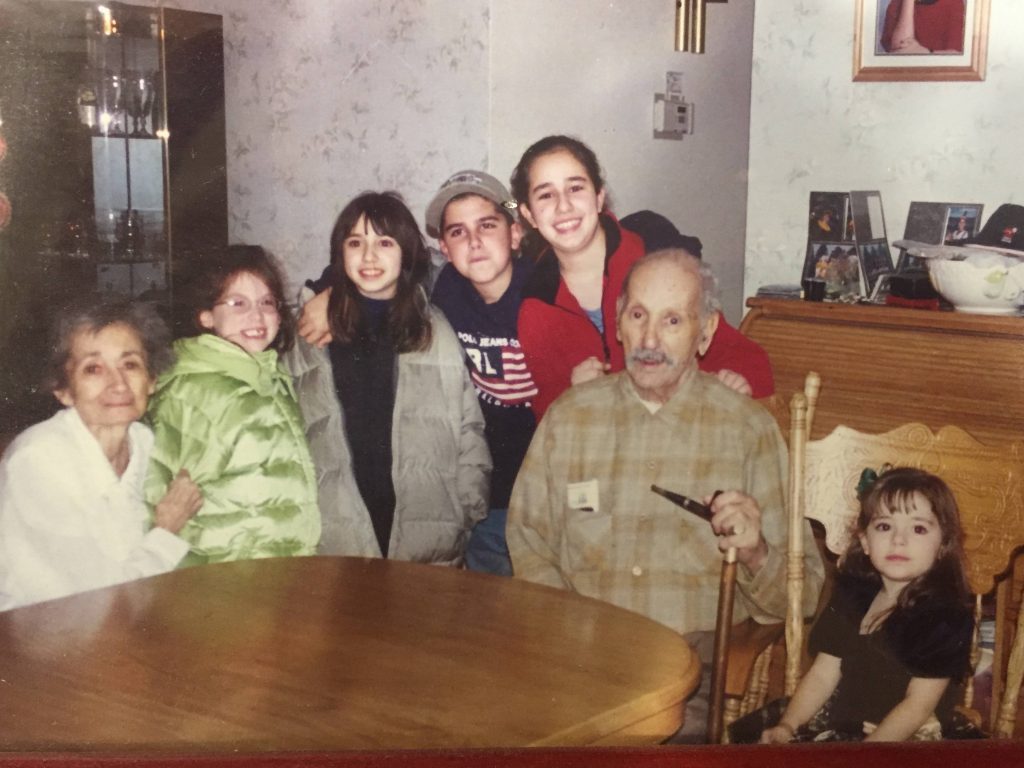
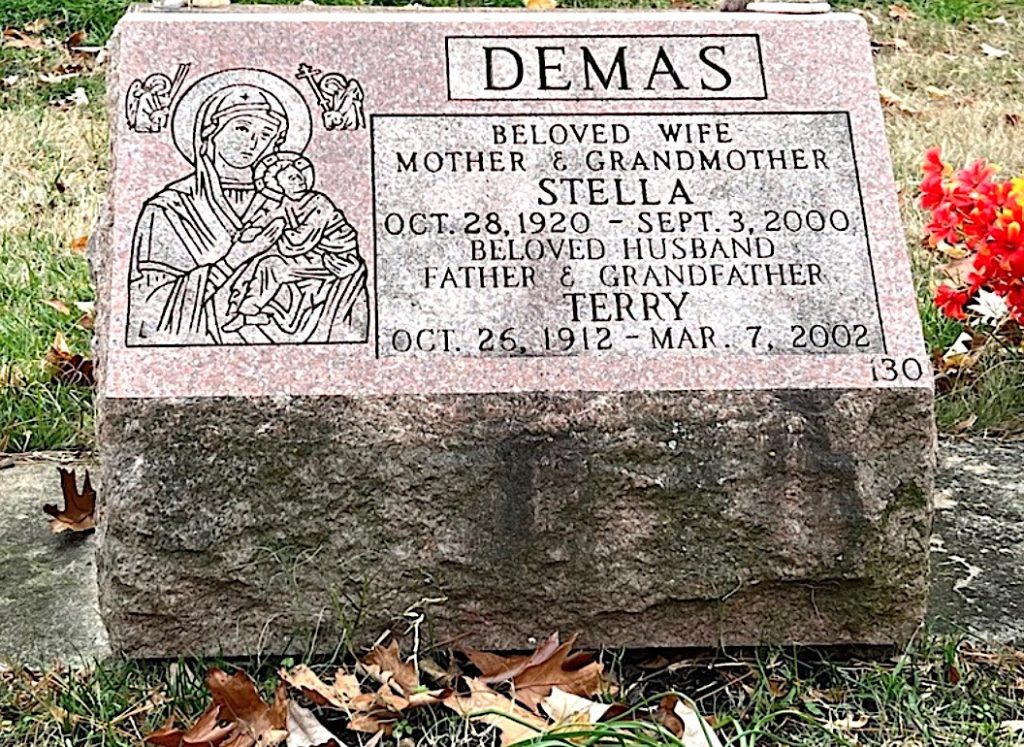
D’EMIC (or De’EMICO, DEMIC), JR., JOHN JOSEPH (1921-1974). Private, United States Army Air Corps. D’Emic was born in Brooklyn to Irene née Chadwick and John Joseph. His father’s birth surname was D’Amico, and it is unclear when the family name was changed to D’Emic. His birth record bears the name De’Emico. As per the 1925 New York State census, the family name was D’Emic and his father was a plumber; the family lived on 18th Street in Brooklyn and John had an older sister, Irene. According to the 1930 census, the family lived at 387 18th Street in Brooklyn.
At the time D’Emic registered for the draft on February 17, 1942, he was living at home at 387 18th Street, had a home phone and was attending St. John’s University; his mother was listed as his contact person. He enlisted in the New York State National Guard, 14th Regiment, on July 1, 1942, and then enlisted as a private in the Army Air Corps on September 26 of that year. His New York State National Guard service card indicates that he had a scar on his left leg from a car accident.
As per his enlistment record, which records his name as Demic, he was single without dependents, a citizen, was semi-skilled in the manufacture of automobiles, and had served in the National Guard. That document indicates that he was 5′ 8″ tall and weighed 147 pounds. As per his honorable discharge papers, he had completed two years of college. He was inducted into the United States Armed Forces on November 12. As per his honorable discharge paperwork, he received training at the TWA Engine and Mechanics School in Kansas City. His son, William, reports that from September 18, 1943 to October 16, 1945, he was stationed at Chabua Field, India as part of the Air Transport Command. The mission was to fly supplies from India over the Himalayan Mountains to China; this was commonly known as “Flying the Hump.” The India-China Division, Air Transport Command, was the first non-combat organization to be awarded The Presidential Unit Citation. John D’Emic was hospitalized in November 1944 with a non-battle injury, lymphangitis (inflammation of lymph channels usually caused by bacterial infection); he returned to duty that same month. His hospital admission card states that he was an enlisted man who had served in the pilot/air transport command for the past two years and four months.
He was honorably discharged from service on November 10, 1945, at Fort Dix, New Jersey. At that time, he gave his mailing address as 387 18th Street, Brooklyn, and his occupation as salesman. He was listed as an airplane crew chief. According to that document, he served in the Central Pacific, Burma, and India. For his service, he was awarded an Air Medal, a Bronze Star, an Asiatic Pacific Service Medal, a Distinguished Flying Cross, and a Good Conduct Medal.
On July 17, 1947, D’Emic married Margaret Therese Hannan; the couple had ten children. He worked in his father’s car dealership. In 1972, upon his father’s death, he inherited the used car business. Sadly, he died two years later. As per an article in the Daily News on June 7, 1984, his widow then went to college and earned a bachelor’s degree, cum laude, from Brooklyn College after nine years of study. Section 130, lot 39262.
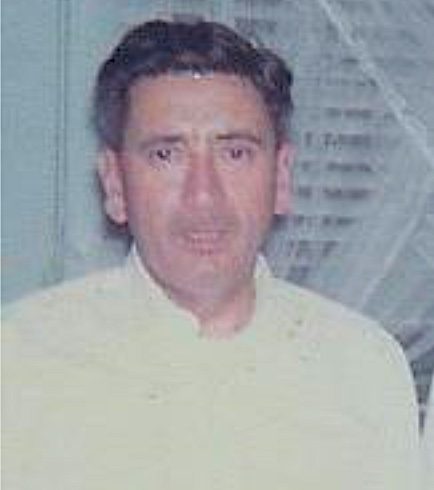

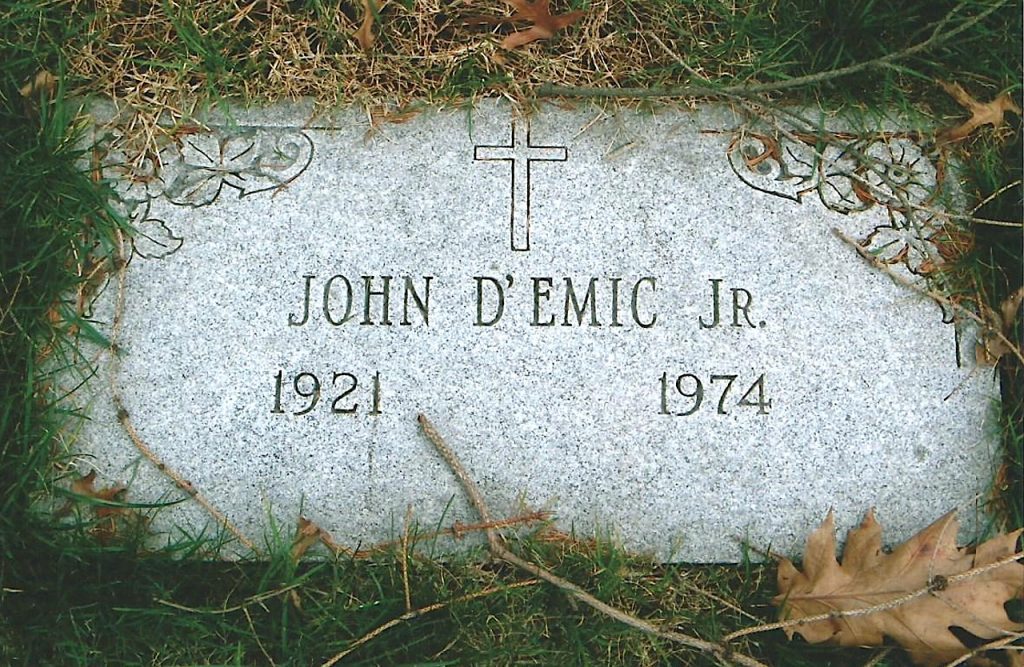
D’EMIC (or DEMIC), THOMAS EDWARD (1925-1984). Private first class, 109th Regiment, Company F, 28th Division, United States Army. D’Emic was born in Brooklyn to Irene née Chadwick and John Joseph; his father’s birth surname was D’Amico, and it is unclear when the name was changed. Thomas’s name does not appear on the 1925 New York State census; at the time of that census, his parents, now recorded by the surname of D’Emic and older siblings, Irene and John (see), were living on 18th Street in Brooklyn where his father was a plumber. The 1930 census, which records Demic as the surname, notes that Thomas was four years old, did not attend school and was living with his parents, older siblings and younger sister, Edna, at 387 18th Street in Brooklyn. By 1937, his father had established a used car dealership. As per the 1940 census, the family now included a fifth child, a daughter, and Thomas had completed eighth grade. He was a graduate of Holy Name Grammar School and Manual Training (now John Jay Educational Campus) High School. He was employed as an auto mechanic.
As per his draft registration card, filed on August 9, 1943, D’Emic was living at the same address on 18th Street, sold cars at his father’s business at 867 Fourth Avenue, had a home telephone and listed his father as his contact person. The accompanying registrar’s report describes D’Emic as 5′ 4″ tall with hazel eyes, black hair and a light complexion. He identified two burn scars, one on his left arm and another on his left thigh.
At age 18, on November 6, 1943, D’Emic enlisted in the United States Army. He was a private first class in the 109th Regiment, Company F in the 28th Division. The 28th Division, also called the “Keystone,” was established in 1879 but traces its roots to Benjamin Franklin’s battalion. Re-designated as the 28th in 1917, it is the oldest division-sized unit in the armed forces and is a part of the Army National Guard; it continues in service today as part of the Pennsylvania, Maryland, Ohio and New Jersey Army National Guards. During World War II, the Germans nicknamed the 28th as the “Bloody Bucket” because of the shape and color of the keystone insignia on its uniforms.
As per his descendant, D’Emic fought in France, Belgium, Luxembourg and Germany at Hürtgen Forest (a series of fierce battles fought from September 19 through December 16, 1944, that ended in a German defensive victory and dismal failure for the Allies), the Battle of the Bulge (December 16, 1944 through January 25, 1945, the last German offensive and costliest in terms of American casualties that ultimately led to the Allies victory) and Colmar Pocket (December 15, 1944 through February 19 1945), an area of German resistance in Alsace that General Dwight David Eisenhower called a “sore” on the front. As per the history of the 28th Division, the unit was involved in these campaigns: Normandy, Northern France, Rhineland, Ardennes-Alsace and Central Europe over 196 days. The 28th marched down the Champs-Elysée on August 29, 1944, when Paris was liberated. D’Emic was awarded the Bronze Star (awarded for heroic or meritorious service or achievement in a battle zone), American Campaign Medal, European-African-Middle Eastern Medal, Victory Medal, and World War II Medal for Meritorious Service. The aforementioned medals were honors given to those who served in the American Theater of Operations, the European Theater, including North Africa, and to those who participated in the military during World War II. He was discharged from service on January 11, 1946.
D’Emic married Alice Grove in Brooklyn on July 22, 1948; as per online ancestry records which differ, the couple had either four or five children. He worked as an auto mechanic. His obituary appeared in the New York Daily News. Section 130, lot 39262.
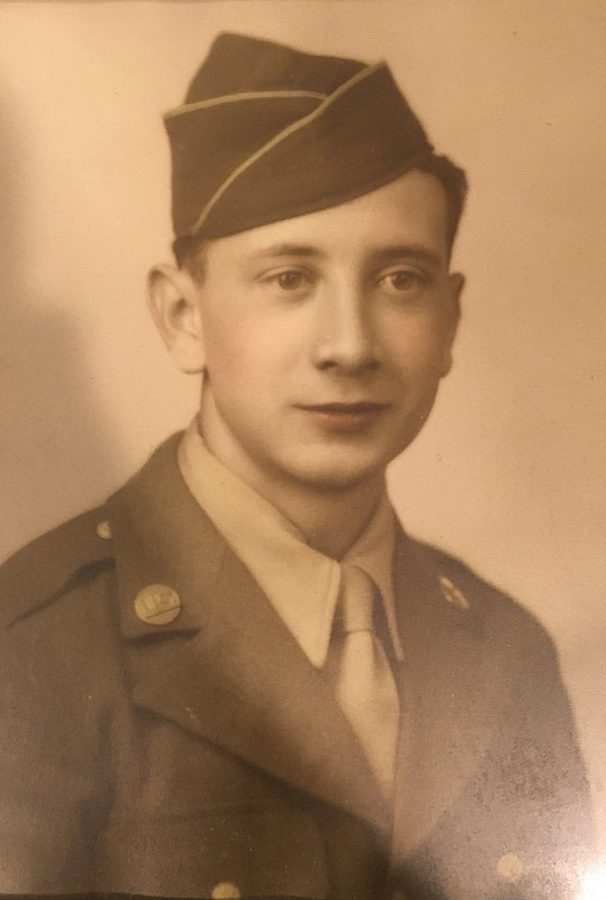
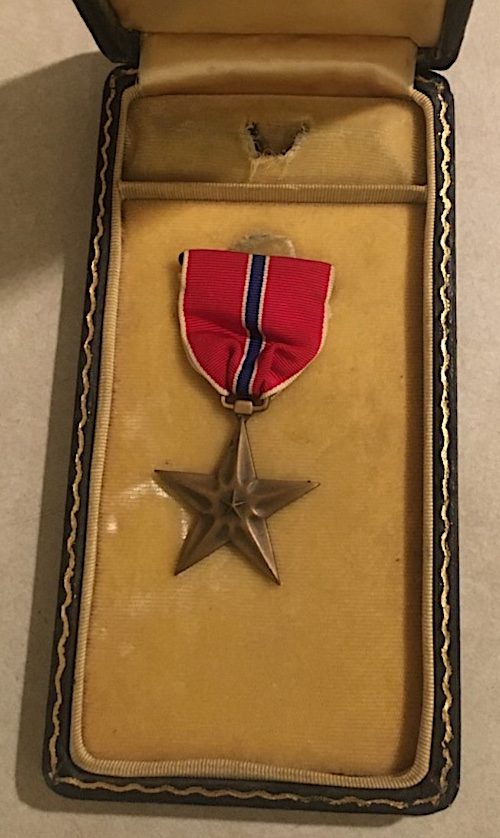
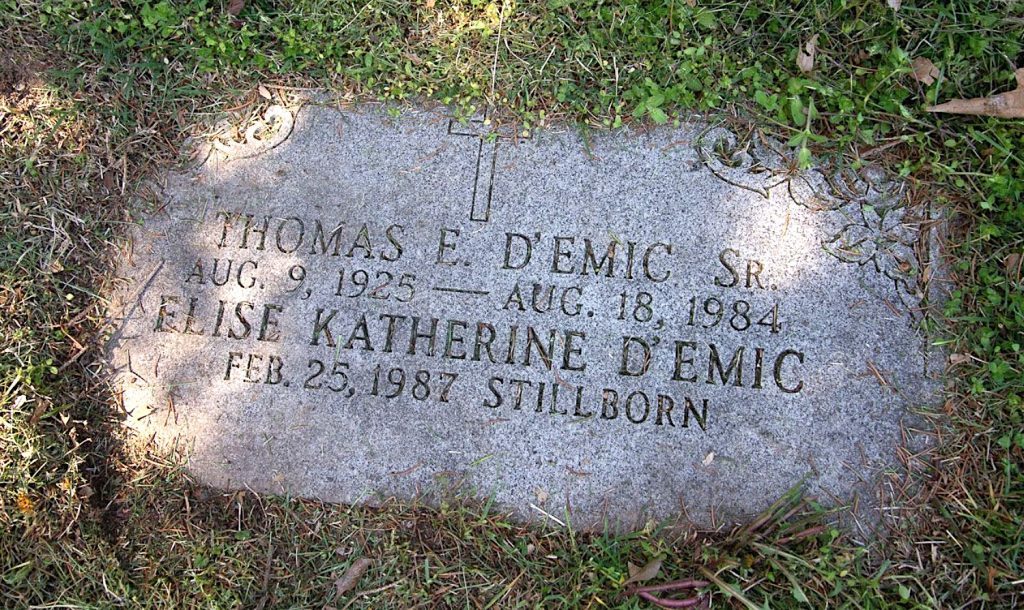
DeSANTIS, AGOSTINO (or AUGUSTINE) (1920-2008). Private, United States Army. Agostino was born in a coal mining camp in Tabasco, Colorado, according to his Army registration card. The 1940 federal census recorded 20-year-old Agostino living with Rocco DeSantis in Gamerco, New Mexico, a company town owned by Gallup American Coal Company, and working as a coal miner. His education level was listed as “elementary school-8th grade.” Rocco was listed as head of household, and Agostino as his son. According to his daughter, Gina DeSantis Piccolo, Agostino lived in New Mexico with his aunt and uncle.
In February, 1942, 21-year-old Agostino registered for the draft, and in September he was inducted into the Army in Santa Fe, New Mexico. His registration card describes him as 6′ tall, weighing 176 pounds, with brown eyes, black hair, dark skin, and a 1″ scar on the back of his head. The signature on his card reads: “Augustine de Santis.”
According to an August 25, 1942, article in the Gallup (New Mexico) Independent, DeSantis was one of five Army enlistees who were accepted by the Naval recruiting office and sent to Santa Fe for “final examinations.” Nonetheless, Agostino ended up in the Army. He served in the Reserve Corps, according to his daughter Gina. His registration card noted that he was discharged at the end of January, 1943, at Fort Bliss, Texas.
In October, 1947, Agostino married Italian-born Adelia D’Orazio. In 1950, the federal census recorded 30-year-old Agostino’s residence on the Navajo Indian Reservation in McKinley, New Mexico, with Rocco as head of household, and now, Rocco’s 28-year-old son Ereole (perhaps Ercole) and 22-year-old daughter Maria. According to the report, both younger children were born in Italy. Agostino’s occupation is listed as a railroad worker.
Agostino and Adelia settled in Brooklyn and raised three daughters, according to daughter Gina. He worked at Bush Terminal as a dock worker and maintenance worker. Adelia died in 1992, at the age of 70. Agostino lived to see six grandchildren and nine great-grandchildren. He died on October 12, 2008, just before his 88th birthday. He is interred next to Adelia. Garden Mausoleum, Crypt 118E.
DESIDERIO, ANTHONY (or ANTONIO) JOSEPH (1918-1979). Private, United States Army. Anthony Joseph Desiderio was born in Brooklyn, although his birth record lists his name as Anthony B. Desiderio and his given name is listed as Antonio on some documents. The 1920 federal census lists “Tony” Desiderio, age 1, living with his parents, Giovanni and Carolina, at 296 3rd Avenue in Brooklyn. Both parents were Italian immigrants and, by 1920, they both could speak English, but only Carolina can read and write. They owned their own home and were registered aliens. Giovanni (Joseph) was a baker with his own bakery, while Carolina tended to home duties and cared for their two children. Their eldest son, Joseph Anthony, was born in 1915.
Giovanni (John) Desederio was born on October 10, 1889, in Angri, Italy and immigrated from Angri on July 5, 1909. Carolina Pepe (also listed in some records as Caroline or Lily) was also born in Angri and immigrated in 1900 from Angri. They were married on April 23, 1910, in Brooklyn, according to their marriage certificate.
Carolina and her son Antonio are listed as passengers on the SS Ferdinando Palasciano, which arrived in New York on August 28, 1920, from Naples, Italy. Anthony Desiderio, age 3, had brown hair and eyes, with a “natural” complexion. It appears that they had been in Italy to visit Anthony’s grandfather, while his father remained at home in Brooklyn.
There is a record of the second marriage of Anthony’s father, Giovanni, taking place in 1924. No record of first wife Carolina’s death or divorce was located. Giovanni and Lucia were married either on October 24 or 25, 1924, in Brooklyn. The 1925 New York State census shows John Desiderio, 32, living with his new wife, Lucy (Lucia), 20, (who was born in Angri, Italy), at 500 President Street in Brooklyn. He was employed as a baker and was naturalized in 1923. His two sons are not listed with the couple.
Teresa Desiderio, the couple’s daughter and half sibling to Joseph and Anthony, was born in 1925 to Giovanni and Lucia in Brooklyn. Sadly, she died at 8 months of age on March 7, 1926, per the New York State Death Index.
The 1930 federal census lists Joseph and Anthony, now 14 and 11 years old, residing with their father, Giovanni, and stepmother, Lucia, at 296 3rd Avenue, Brooklyn. The family owns their own home, valued at $5,000. Giovanni has a bakery, and the boys attend school. Anthony is listed as a passenger with his father, Giovanni, as well as Lucia, on the SS Conte Di Savoia, sailing from Naples, Italy to New York, arriving on June 7, 1937.
A marriage license was issued to Anthony Desiderio and Filomena Lucchesi on December 16, 1939, in Brooklyn. Filomena was born on July 7, 1916, in Brooklyn. However, the 1940 federal census shows the Desiderio family in a new home at 833 3rd Avenue in Brooklyn, valued at $8,000, with no mention of a wife for Anthony. Both sons have completed school and have recently begun to work. They learned the trade of bread-making from Giovanni, their father, and their grandfather Giuseppe. Giovanni is listed as being employed as a waiter in a bakery, while Lucia is a housewife.
Anthony’s World War II draft card describes him as 5′ 7″ tall, weighing 190 pounds, with a dark complexion and brown hair and black eyes. He was employed by his father, John Desiderio, baker, at 860 4th Avenue, Brooklyn. John Desiderio, at the same address, is also listed as his contact, although the name Mrs. Fannie Desiderio was first inserted as contact, but later crossed out. Fannie may be Filomena’s name in English.
Before Anthony enlisted in the United States Army, two children were born in Brooklyn: John Anthony Desiderio on November 1, 1941, and Caroline Lucy on December 7, 1943. Anthony’s World War II Army enlistment records show that he enlisted on April 4, 1945, as a private. He was listed as married, had completed two years of high school, and worked as a baker. He was discharged on February 18, 1946.
A second daughter, Theresa, was born on November 12, 1947, in Brooklyn. The 1950 federal census shows Anthony and Filomena married and living at 214 32nd Street in Brooklyn, with three children: John, Caroline, and Theresa. Anthony was employed as a baker with his baking company, working 40 hours per week, with an annual salary of $2,340. He reported that he was a World War II veteran.
Anthony Joseph Desiderio died on November 4, 1979, at age 61, according to a New York Daily News obituary. He was the husband of Filomena and father of John, Carol Wilmot, and Theresa Bacchieri. He was also survived by five grandchildren. Lucia, listed as his mother, also survived him. Anthony’s brother, Joseph Desiderio, died in 2004 in Lakewood, New Jersey and the Ocean Star newspaper published an obituary that described the family’s bakery business: “He (Joseph Desiderio) made and delivered Italian, brick-oven baked bread with his father, Giovanni, and his late brother, Tony, in Desiderio’s Bakery, South Brooklyn, which had been open since 1910.”
Many of the Desiderio family members are interred at Green-Wood, including Anthony’s father Giovanni, who died in 1978, and his stepmother Lucia Mazzotti Desiderio, who died in 1981. Anthony Joseph Desiderio is interred with his wife Filomena, who passed away in Brooklyn in May 1982. Section 134, lot 39100.
DeVITO, FRANK (1919-1987). Corporal, United States Marine Corps. Frank DeVito was just one year old when the 1920 census was taken, and was the youngest of four children born to Salvatore and Concetta, who had immigrated from Italy to the United States. They brought with them Frank’s eldest brother, Carmine, and added to the family his two older sisters, Gertrude and Rose, after moving to New York. Ten years later, during the 1930 census, Carmine was no longer living with his family in Brooklyn, but his place at the table had been filled by Frank’s younger brother Lorenzo. With the passage of another decade, the 21-year-old Frank had finished four years of high school and was working as a pressman at a canning company, living at home with his mother and siblings. His father had passed away two years before. During the year of that census, 1940, DeVito registered for the draft, listing his mother as his next of kin. He described himself as 5′ 5″ tall and 153 pounds, with brown eyes and hair and a dark complexion. He reported that he was working for Frank Gausi at 129 26th Street in Brooklyn.
On April 13, 1943, DeVito enlisted in the United States Marines. After training in North Carolina, and a stay in San Francisco, California, waiting for his overseas assignment as a member of a replacement brigade, he was sent to the Pacific Theater. Before leaving the States, Frank married Marie Filomena Citarella on June 2, 1943. According to his daughter, during his service he was a heavy anti-aircraft crewman, rising from a private to corporal, and notably seeing action on Guam. A photo of him in 1944 shows him home on leave, smiling and pushing a baby carriage. He was discharged from service on December 28, 1945.
For his service he was awarded the Satisfactory Service Certificate and the Good Conduct Medal. After his return home, he and his wife Marie raised two daughters, and he worked at Skillman Truck Repair. Section 72, lot 44692, grave 92.
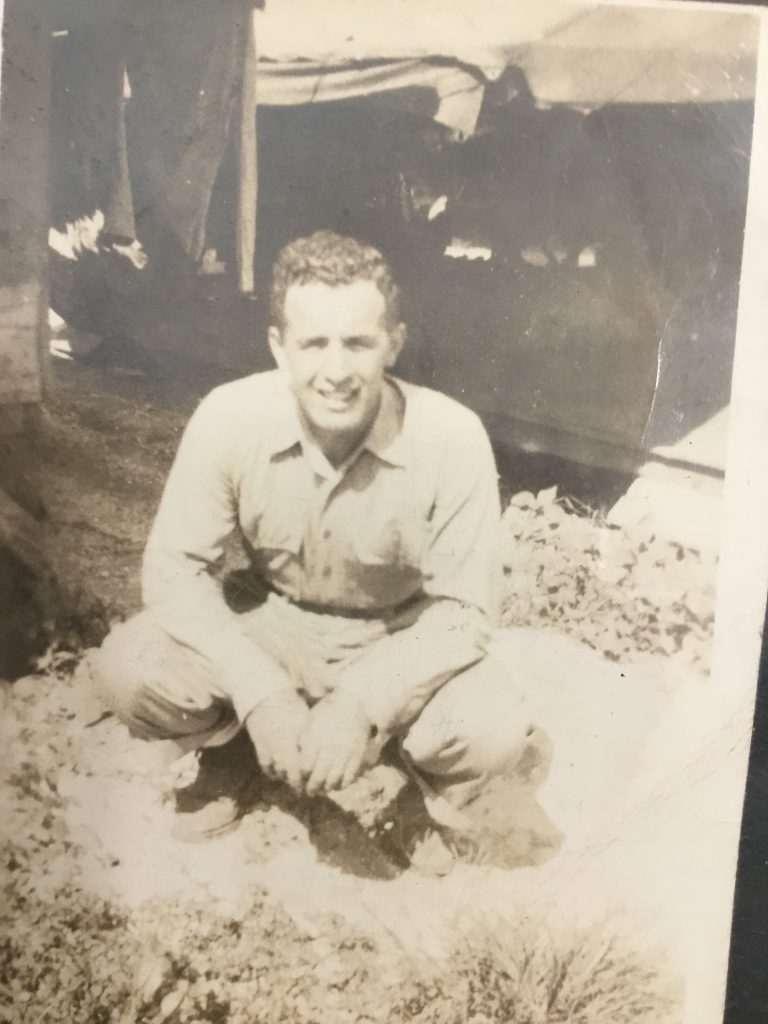
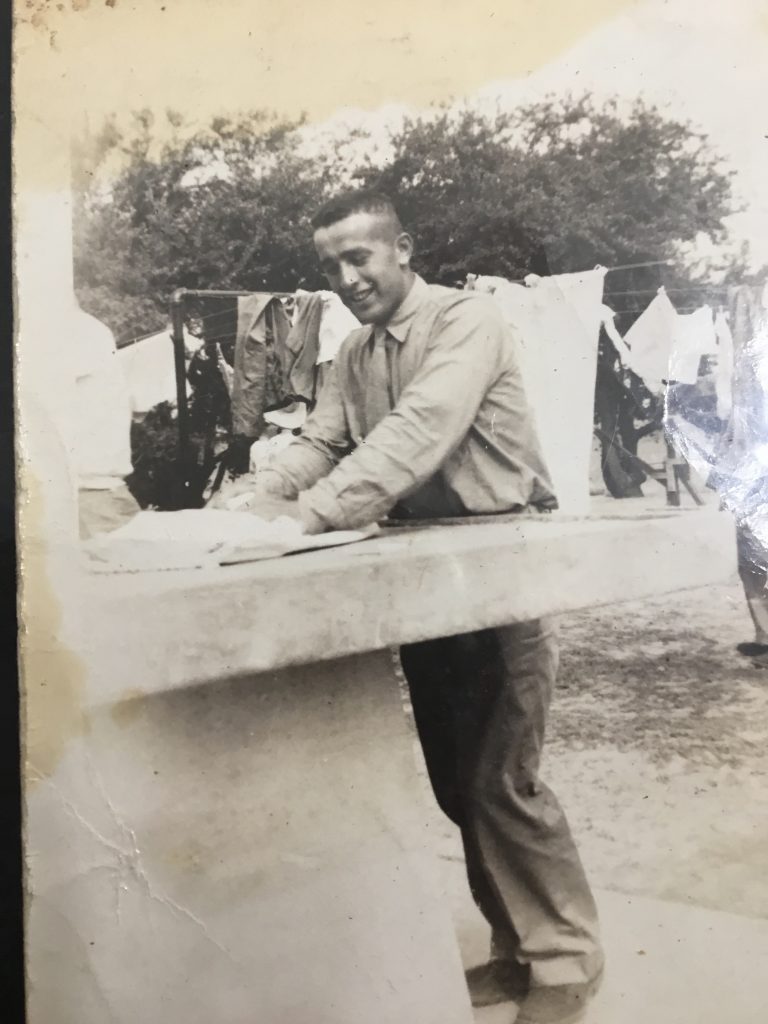
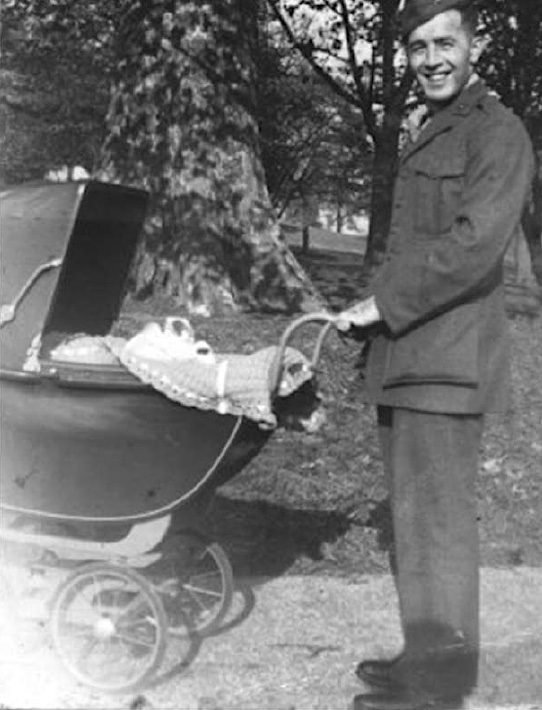
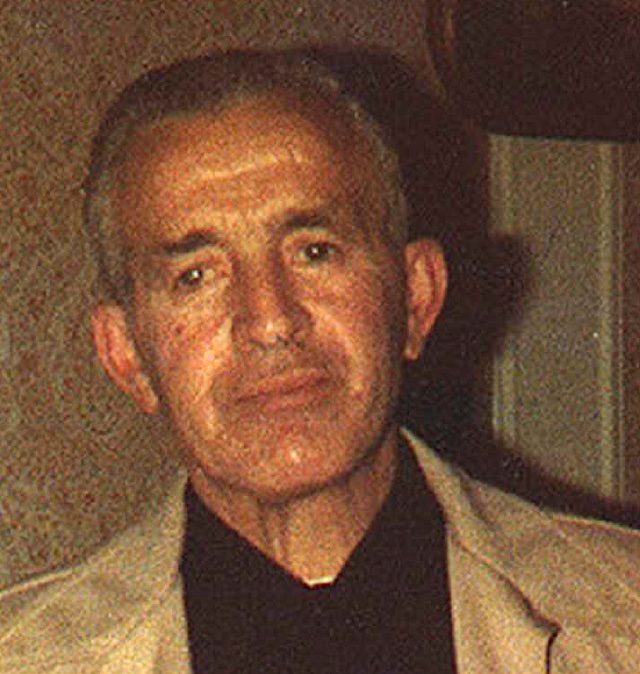
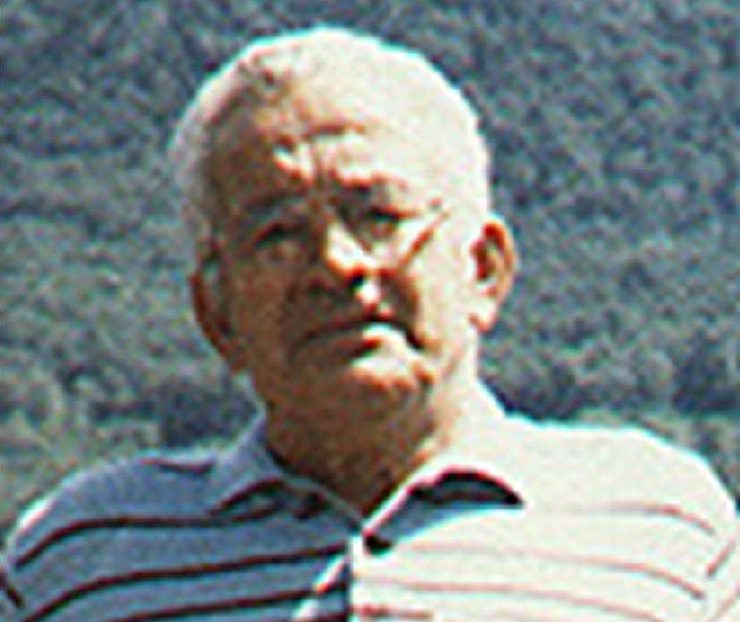
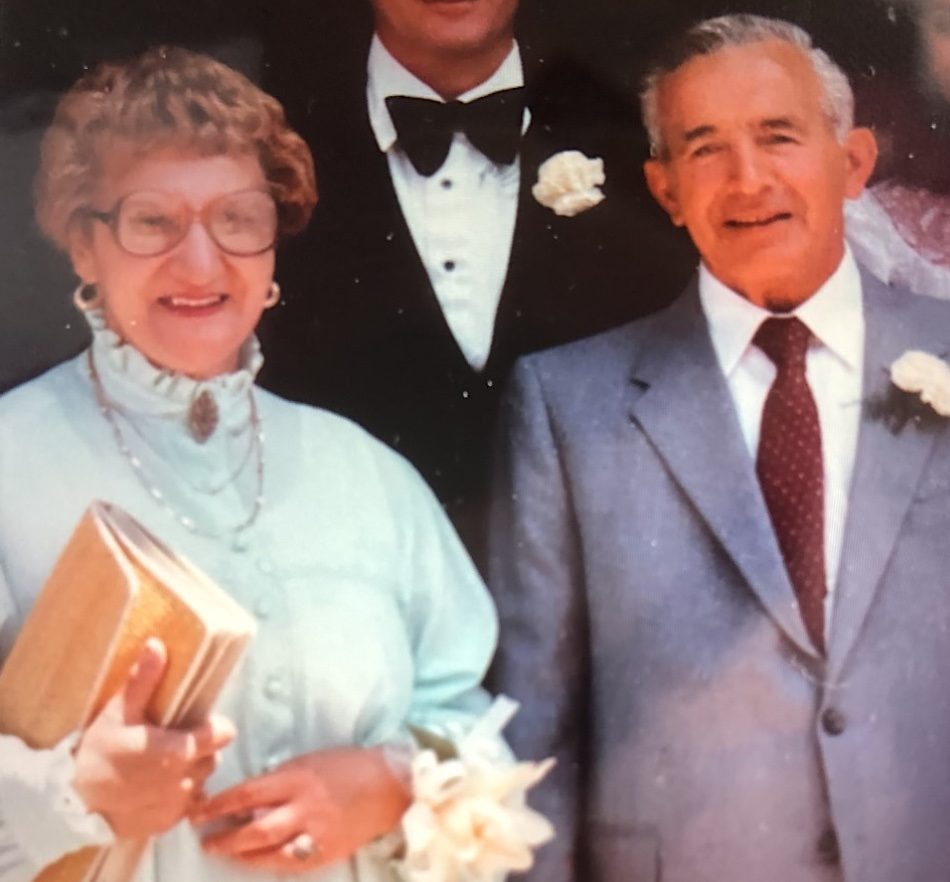
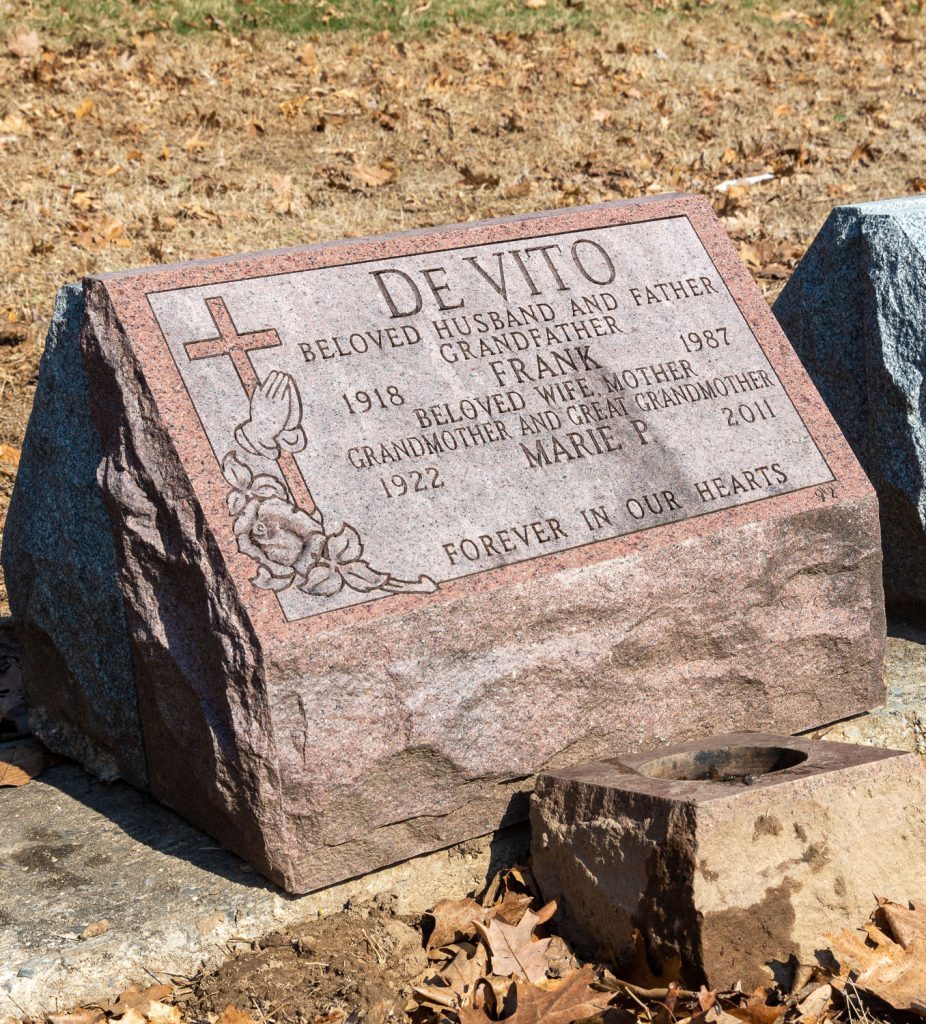
DeVITO, JAMES ANTHONY (1925-2006). Private, United States Army. A Brooklyn native, Jimmy, as he was listed in the 1930 census, lived at 6915 13th Avenue with his parents, Mario and Rose; an older sister, Frances; an older brother, Paul; a younger brother, Joseph; and a cousin, Mary DeVito, who was 19 years old. His father, who was born in Italy about 1887, was a building plasterer who had immigrated in 1920, as had his mother, who was born around 1896. His father was listed as a naturalized citizen in that census. By the 1940 census the family is recorded as living at 1261 Bay Ridge Avenue, by which time his father was unemployed but looking for work. His mother is listed as the wife of a veteran who had served in the regular forces during peacetime, but the branch of service is not specified. By this census there were three named DeVito daughters.
DeVito’s World War II draft registration card, dated March 11, 1943, his 18th birthday, lists him as living at 1322 70th Street in Brooklyn. The accompanying registrar’s report on that day states that he was white, 5′ 8″ tall, weighed 135 pounds, had gray eyes and brown hair, and had a dark complexion.
His World War II Army enlistment record notes that he enlisted as a private on August 13, 1943, was single, and had completed four years of high school. He received no branch assignment at that time, but according to his family, he fought in the Battle of the Bulge, a major German offensive launched in Belgium during December 1944. It involved 610,000 U.S. soldiers, per the United States Army Center of Military History website, and resulted in 75,000 Americans killed, wounded or missing. However, the Nazi offensive, which was their last major one of the war, was repulsed by early January 1945, and the Germans lost about 80,000 killed, wounded or missing, according to Gerhard L. Weinberg’s “A World at Arms,” and used up their last reserves in the battle.
After DeVito’s World War II service he returned home, and in 1954 he married Phyllis Lucenti, according to the marriage license issued in Brooklyn. His last residence was in Brooklyn, according to a document on familysearch.org. The indexed notes for the same document indicates that at some point he lived in Africa. His wife survived him; she died in 2010. The notes say that because of damage from Hurricane Sandy in 2012 and the cleanup of an enormous tree toppled by the storm, there is no stone for James and Phyllis DeVito, and their temporary markers have vanished. The graves are located across the pathway from the signpost for the Holly Path. Section 93, lot 44608, grave 32.
DiCOSTANZO, ALBERT (or ALFONSO) A. (1919-1997). Tech sergeant, Unit 3438, Ordnance Maintenance Division, United States Army. Born and raised in Brooklyn, Albert DiCostanzo was the second eldest of four children, Nicholas, Alfonso (Albert), Alfred, and Concetta. His parents had both immigrated to the United States from Italy, his father James in 1909, and his mother Antoinetta in 1912. According to the 1920 census, James supported his family as a stevedore longshoreman.
On October 16, 1940, the 21-year-old DiCostanzo enlisted in the Army as a private. By that date, he had completed three years of high school and was a semiskilled inspector. A little more than a year later, the attack at Pearl Harbor brought the United States into the war, and DiCostanzo would spend his years in the Asia/ Pacific theater, serving in China, India, and Burma. Wearing his “sweetheart pin” in the United States was his wife, Christine M. Fasulo, whom he married on November 10, 1942.
Some of his father’s experience with ships as a longshoreman must have rubbed off on his son, and DiCostanzo received his first wartime commendation from the Office of Provost Marshal Captain James T. Pronger of the transport ship that took the men from the United States to Hobart, Tasmania, for performing the duties of sergeant of the guard. The Ordnance Department, in which he served, returned the damaged materials that the troops required to operational status. From base shop work to organizational maintenance near the front lines, this work was accomplished as quickly as possible in order to keep the Army supplied and moving ahead in the field. Beyond the aforementioned commendation, DiCostanzo’s achievements during the war were recognized with the American Defense Service Medal, the Meritorious Unit Emblem, the American Campaign, Bronze Asiatic-Pacific, and World War II Victory Medals, as well a commendation for Good Conduct.
These medals would have adorned his uniform when he returned to Brooklyn after the war, and during dress occasions as post commander of the Fighting 14th Infantry Post of the Veterans of Foreign Wars. In addition to those duties, DiCostanzo worked for the Metropolitan Transportation Authority (MTA) for thirty years and, together with his wife Christine, raised three children, Mary, Susan and Vincent. Section 132, lot 39976, grave 2.
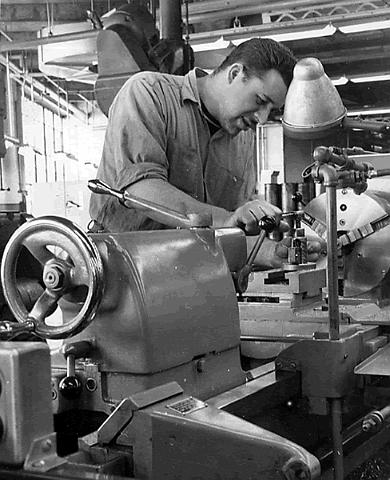
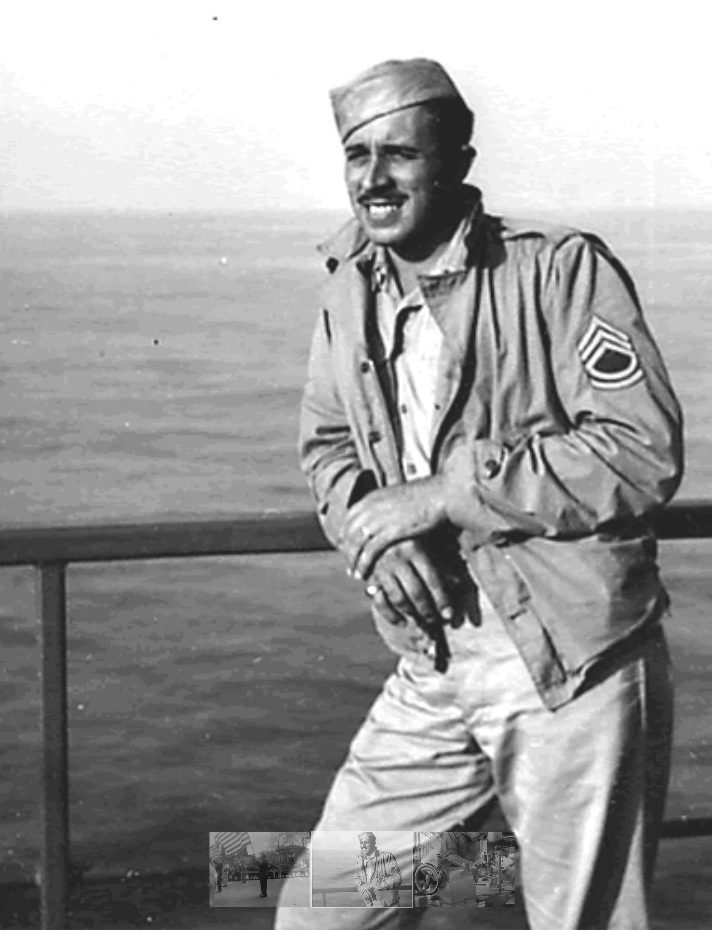
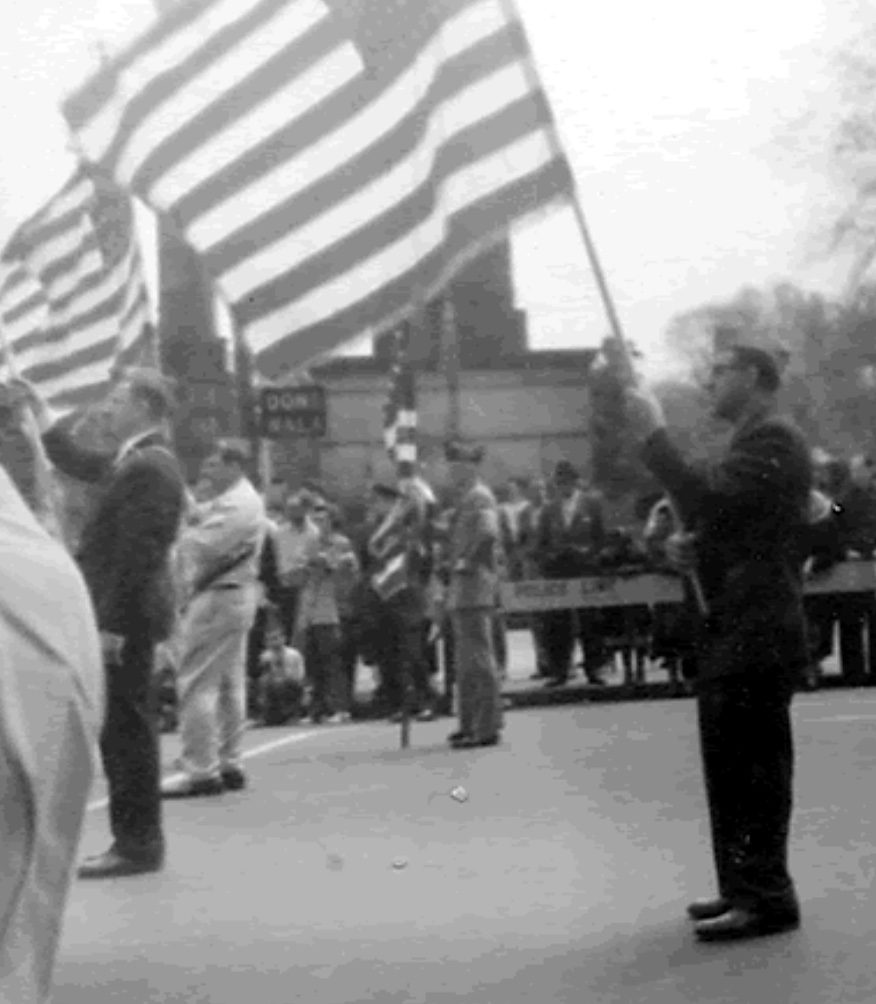
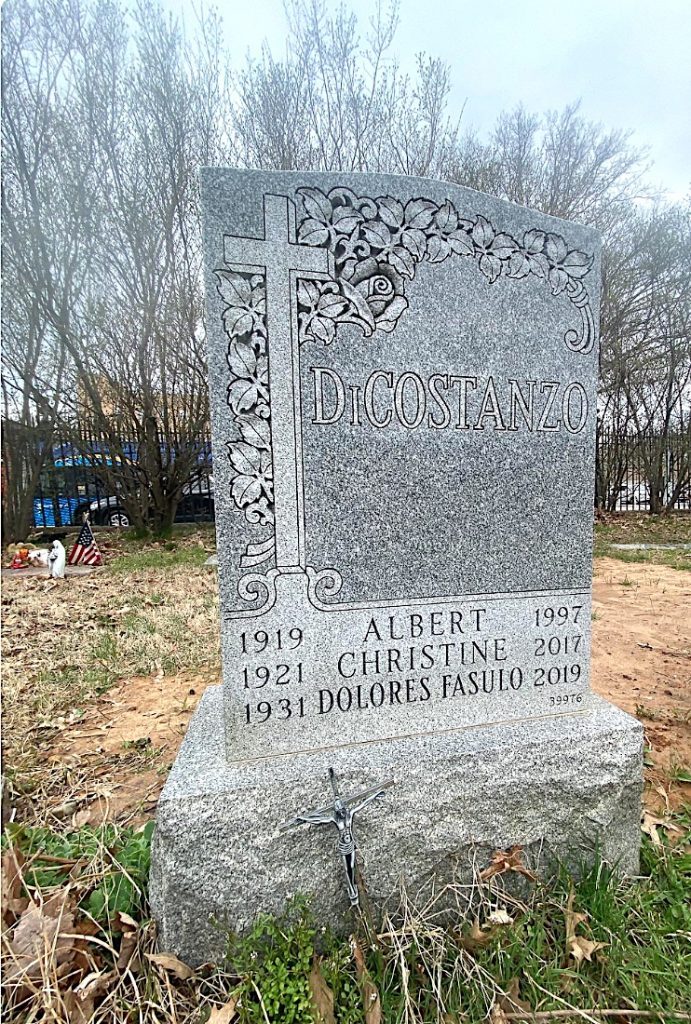
Di ORIO, ANDREW A. (1924-2009). Private first class, 3rd Division, United States Army. Andrew A. Di Orio was born in the Sunset Park neighborhood of Brooklyn. Born into an Italian-American family, he was one of fourteen children. As a child and through his teenage years, Di Orio was an active parishioner of St. Rocco’s Church (located in Sunset Park). As a teen, he was a drum major of the St. Rocco’s Cadet Corps.
Di Orio enlisted in the United States Army on March 16, 1943. As a private first-class infantry radio and communications operator, he and the 3rd Infantry Division of the United States Army served in all ten campaigns of World War II. Di Orio and the 3rd Division fought in North Africa, working their way through Sicily, ending the Sicilian Campaign. They broke to Rome, continued to the south of France, and, eventually, fought in Austria towards the end of the war. The 3rd Division was credited with 531 combat days, which was the most combat days of any unit in the European Theater. Di Orio was wounded in Anzio, Italy. He received a Purple Heart and Bronze Star for his contributions and efforts. Di Orio was discharged from the United States Army on October 25, 1945, returning home to Sunset Park, Brooklyn.
On June 9, 1945, Di Orio married Lena Masucci. They started a family, having four children, Andrew Jr., Kathryn Nagy, Richard, and Robert, with Richard and Robert sadly passing away in early adulthood. Di Orio was a grandfather to four grandchildren, Andrew III, Tracy, Michael and Rebecca, and great-grandfather to three great-grandchildren, Isabella, Dominique and Andrew IV.
After his return from the war, Di Orio worked as the lead foreman in charge of the Brooklyn Army Terminal and three other ports. In 1956, he left this position to manage the newly constructed St. Rocco’s Youth Center at St. Rocco’s Church, his lifelong parish. For the next 25 years, Di Orio nurtured members of the youth group. He was a great influence and support system for the youth in the community, providing opportunities in recreation and education. He supervised the roller-skating rink, taught offset printing, and coordinated the basketball team. In addition, he brought back the Cadet Corps and proceeded to transform it into St. Rocco’s Drum & Bugle Corps, a full-fledged competitive marching and maneuvering corps. Although proud of the success in competition of the Drum & Bugle Corps, Di Orio was most proud of the inclusivity of members during a time when activities often were racially divided. Di Orio welcomed all members, regardless of race. In response to DiOrio’s impact on establishing the Drum & Bugle Corps, a former member of the youth center said, “If it were not for his efforts in building the Youth Center, I fear many of us would have been lost to the street.” (Obituary of Andrew “Andy” Di Orio, Legacy.com).
In the 1980s, while remaining a very active member of St. Rocco’s Parish, Di Orio left his position as general manager of the Youth Center. He embarked on a new career with the Kings County Court, where he was appointed as the principal administrative associate for the public administrator of Kings County. He also held the position of court analyst for the Surrogate Court of Brooklyn. He then served as deputy public administrator of Kings County until he retired.
Di Orio was very active in his community. He was a member of Sunset Park Redevelopment Committee, the Knights of Columbus Christopher Council, Disabled American Veterans, American Legion, Sons of Italy, South Brooklyn Lions, and was on the board of directors of the Marien-Heim Towers of Sunset Park. He served 17 years as chairman of Community Board 7. He was instrumental in getting Sunset Park designated as a Neighborhood Strategy Area, receiving 10 million dollars for improvements to the area, including a new sanitation garage, construction of a new school-P.S.314, and upgrades to parks, sewers, and street lighting throughout the area.
His efforts and dedication did not go unnoticed. He received numerous awards and recognitions, such as Man of the Year from the Yankee Circuit and YMCA, Bishop Mugavero Award, Leif Erikson League Board of Directors Award, Panza-Sterrazza Memorial Service Award, and the 72nd Precinct Community Award. Upon his retirement, Di Orio was acknowledged by the Brooklyn Borough President Howard Golden and New York City Mayor Edward Koch for his seventeen years of service to Brooklyn and Community Board 7.
He remained a resident of Sunset Park until his death. To recognize his hard work, influence, and dedication to the community, the street in front of the St. Rocco’s Youth Center, at 27th Street and 4th Avenue, has been named Andrew Di Orio Boulevard. Section 39, lot 38325, grave 2607.
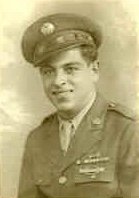
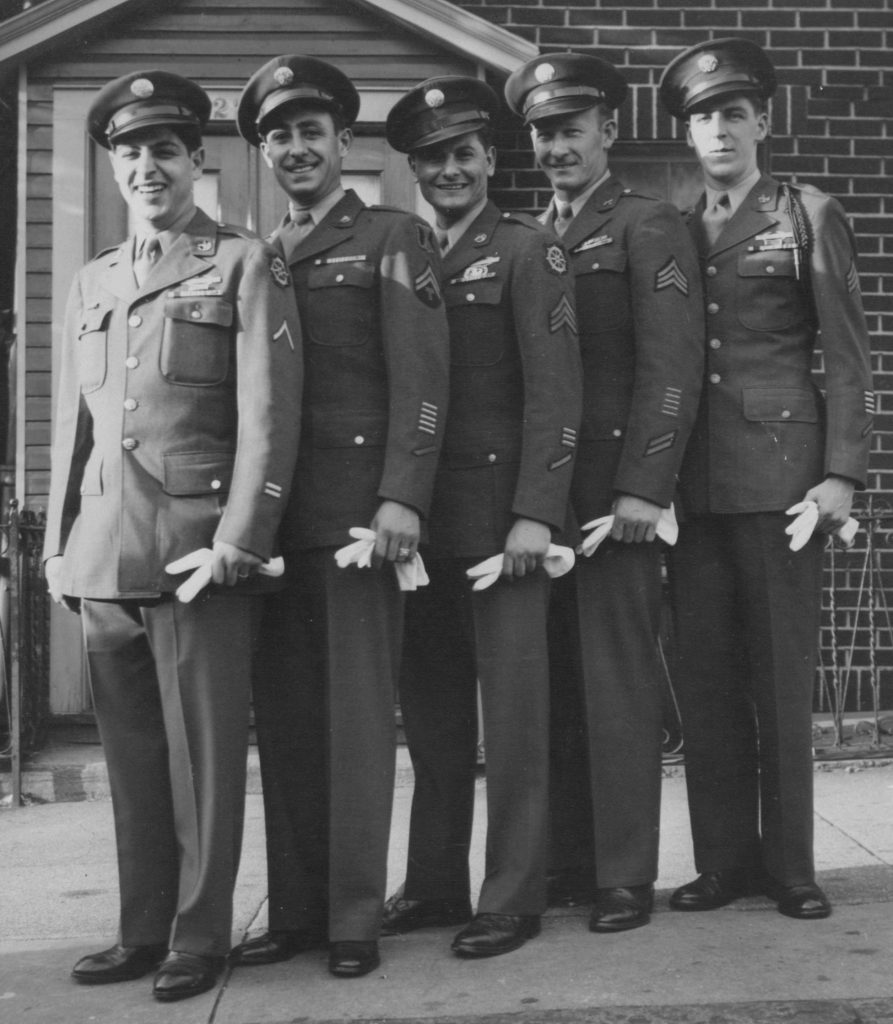
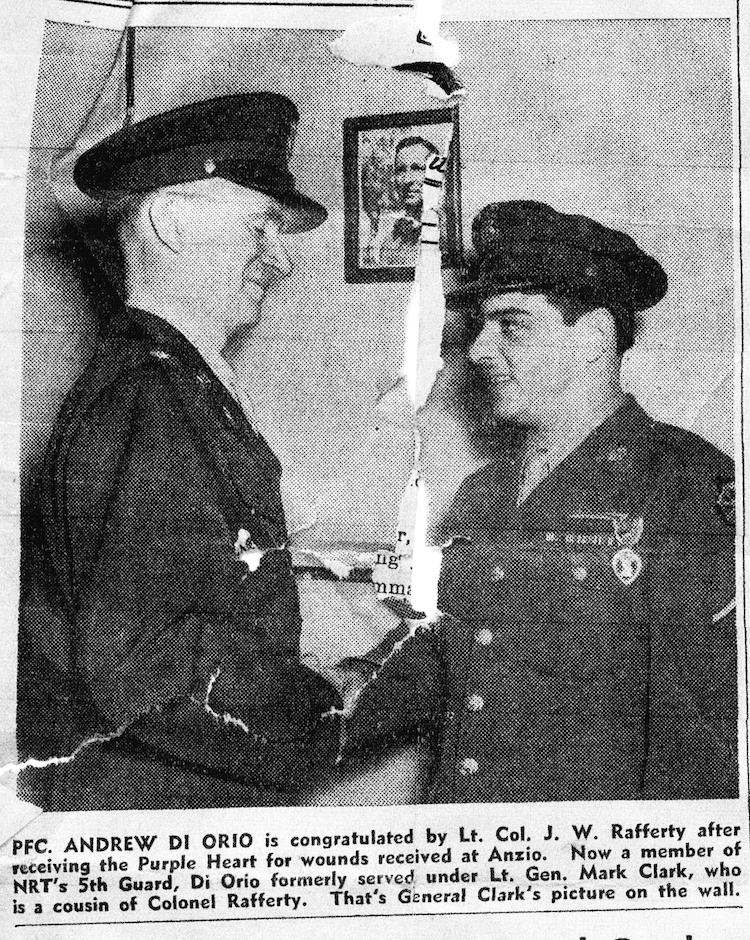
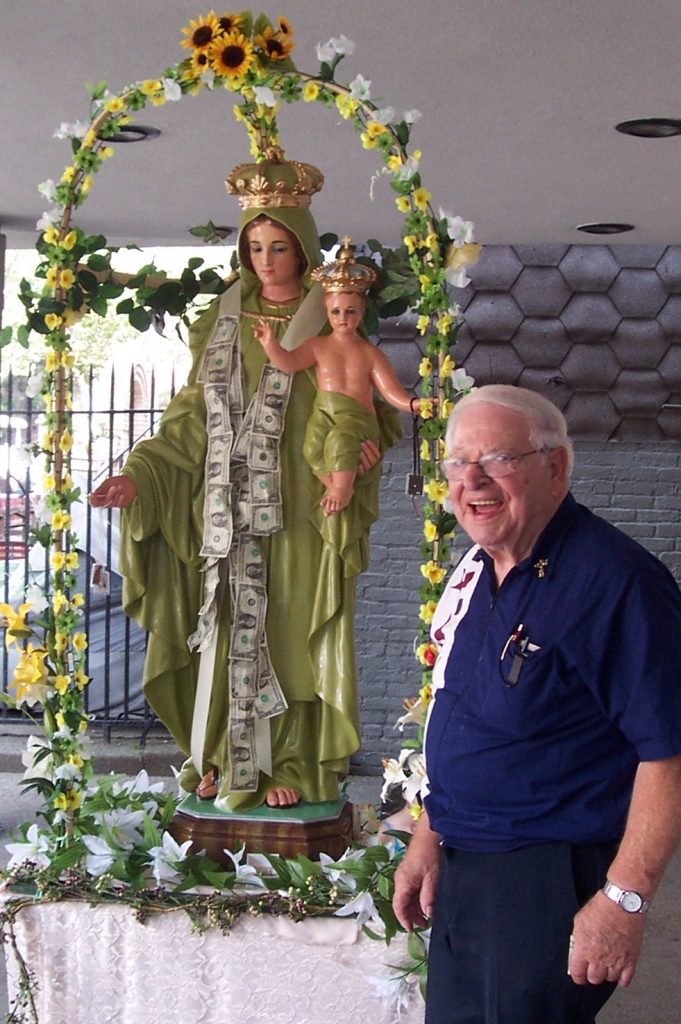
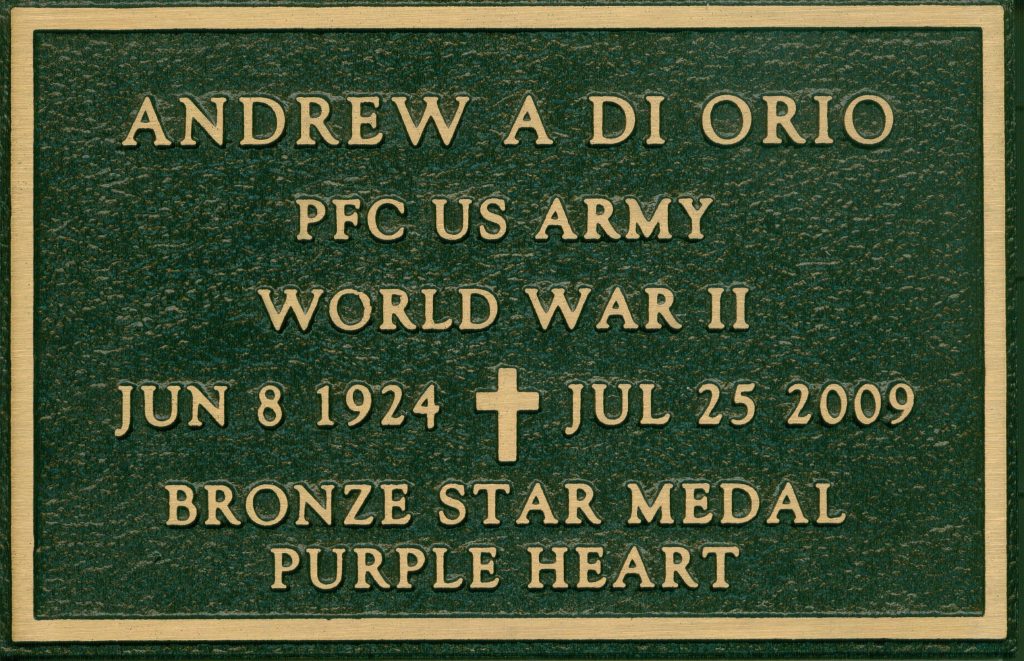
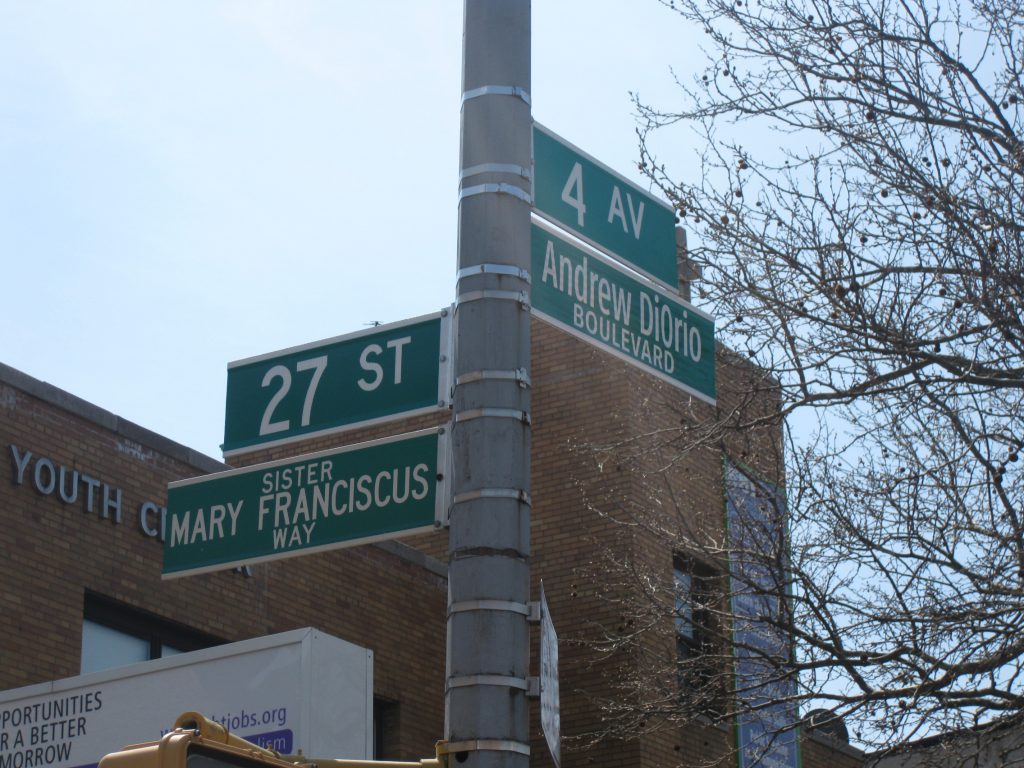
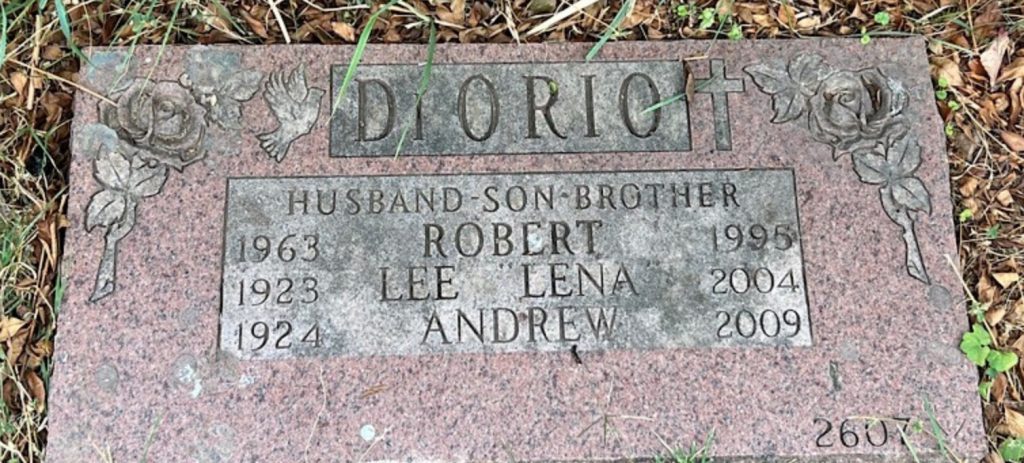
DiSPIRITO, CONSTANTINO (1922-1994). Sergeant, Combat Engineers, United States Army. Constantino DiSpirito was born to Rafael and Anna DiSpirito, both Italian immigrants. According to the federal census, they lived on 67th Street in Brooklyn, and Constantino was the fourth of seven children. He attended P.S. 176. DiSpirito was 19 years old when he signed his draft registration card in 1942. He was described as white with a ruddy complexion, 5′ 6″ tall, 145 pounds, with hazel eyes and brown hair. His employer was listed as E.W. Bliss and Company, a Brooklyn machine tool manufacturer.
Shortly thereafter, DiSpirito and Rose Casale applied for a marriage license, and they would go on to have three children. However, their happy family life was interrupted by DiSpirito’s deployment. He served in the Philippines as an Army combat engineer. The combat engineers were at the forefront of fighting theaters in World War II, enabling mobility operations for the troops, enacting counter-mobility operations against Axis powers, and serving as infantrymen when necessary. They constructed roads, bridges, and fortifications while also laying mines and destroying enemy infrastructure, using a wide variety of tools to accomplish this, from hand axes to dynamite to bulldozers. In the Pacific Theater, the U.S. Army 42nd Combat Engineers took part in the hard-fought high casualty Battle of Attu and the Battle of Manila, earning two Battle Stars. While we do not know the unit that DiSpirito was attached to, we do know he ranked as a sergeant by the end of his service, and according to his family, he served for four years.
After his service, DiSpirito went on to work for Wackenhut Security. He last lived in Brooklyn. Section 28, lot 40963.
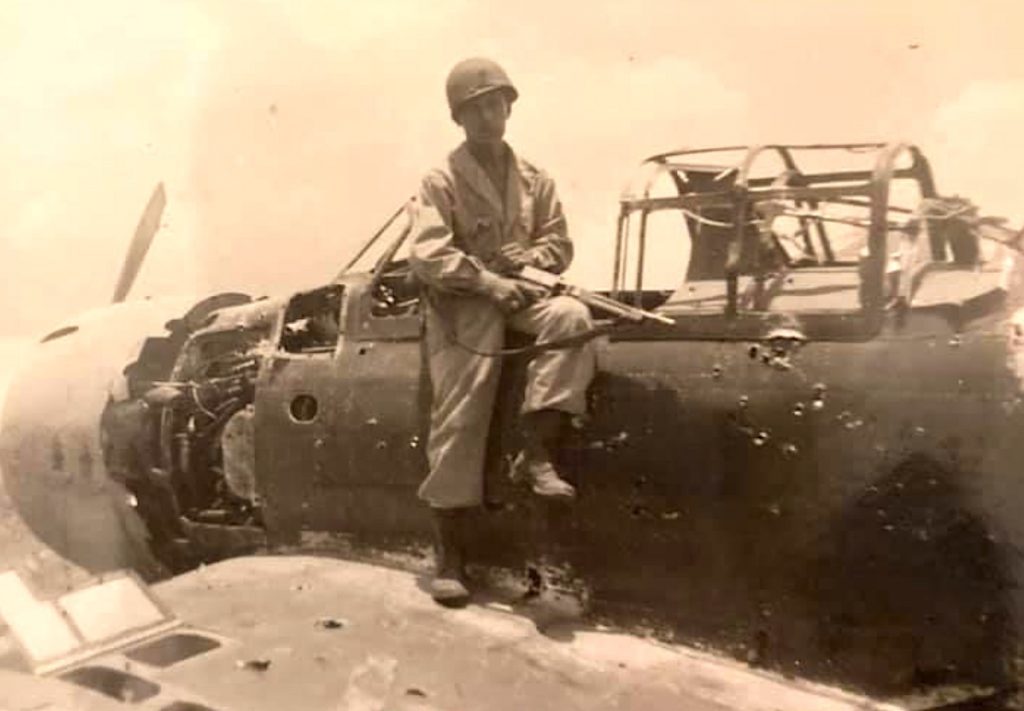
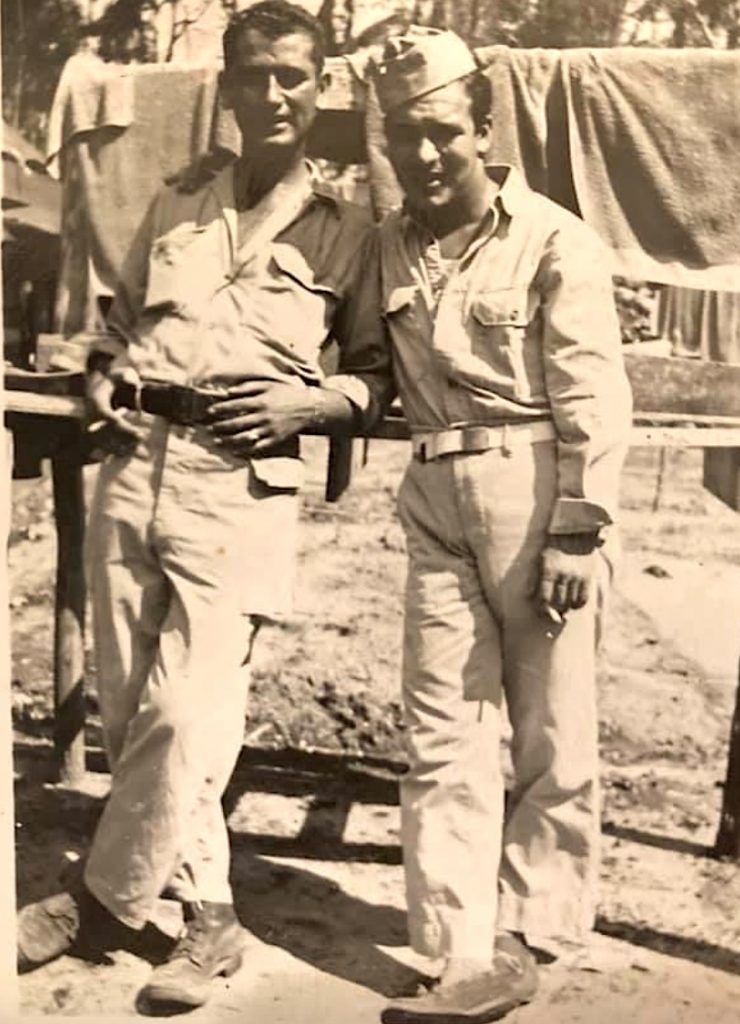
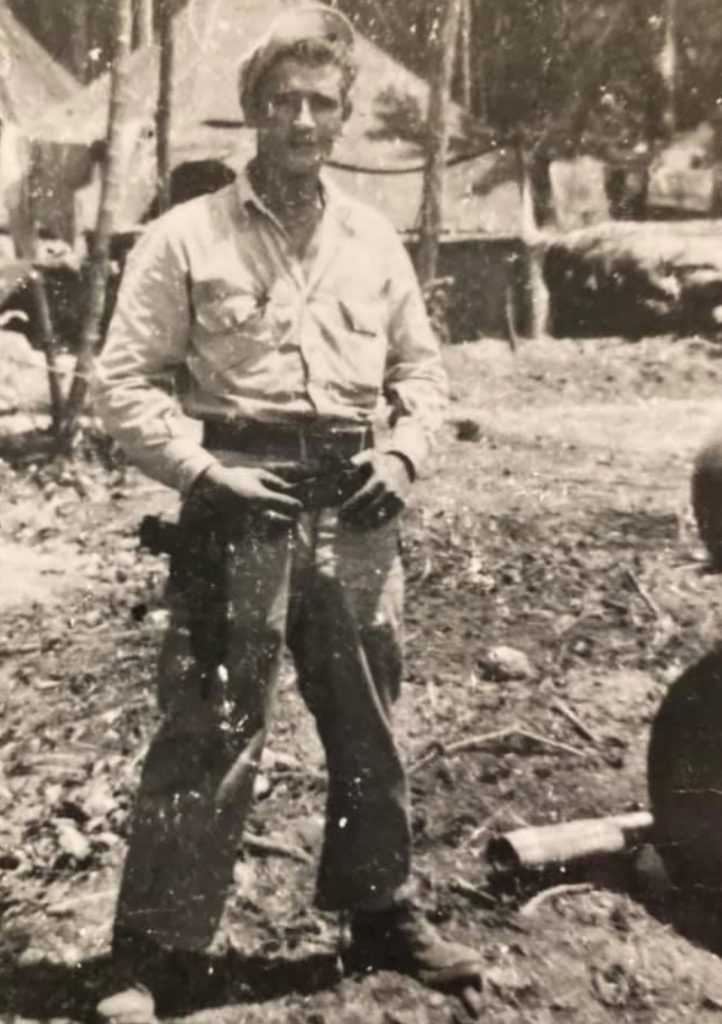
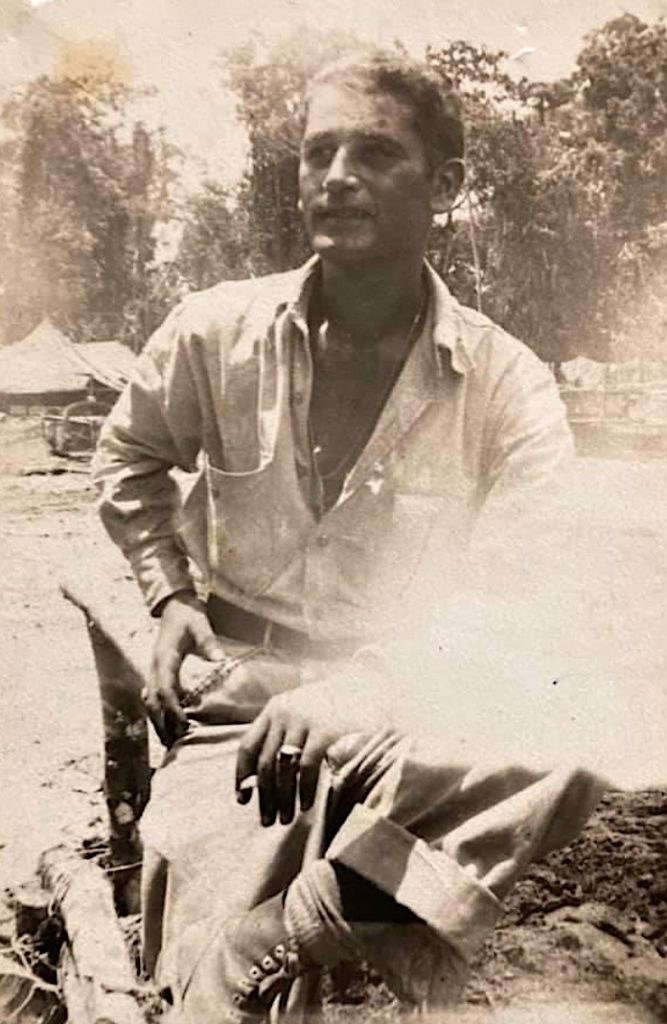

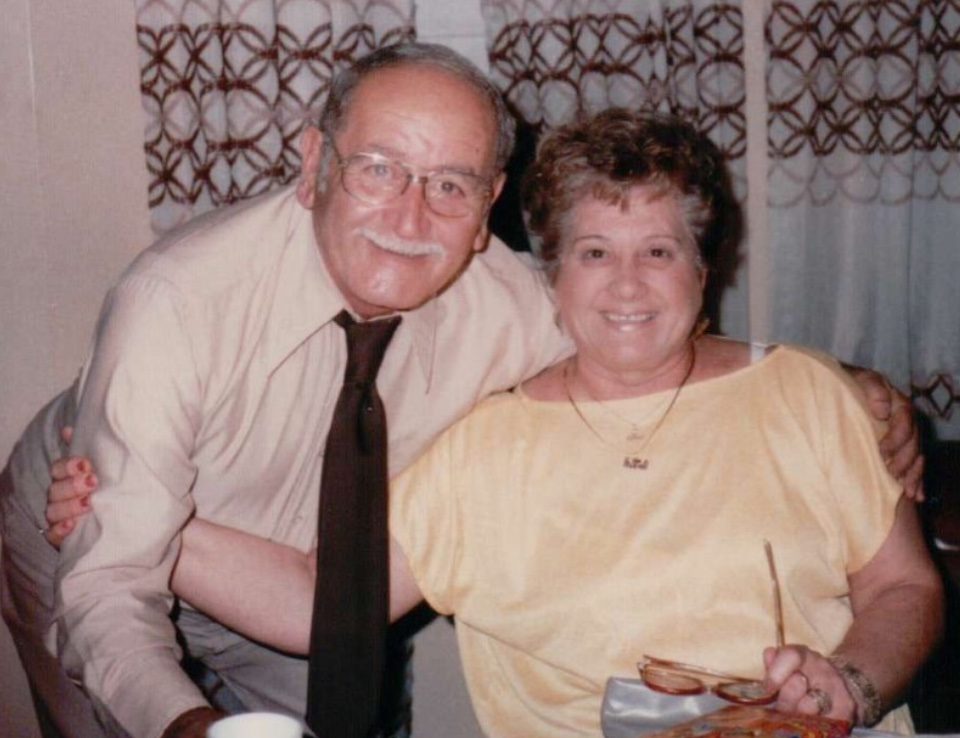
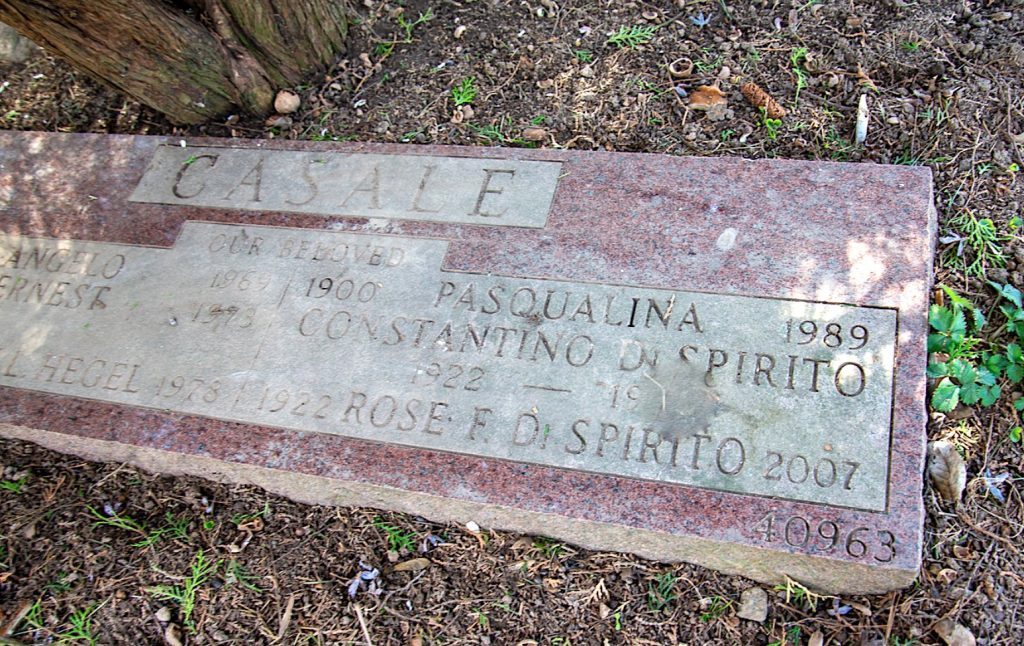
DONNELLY, JOSEPH R. (1919-1975). Sergeant, Press, United States Army. Joseph Donnelly was born in Queens, New York. The 1920 federal census shows the Donnelly family living on Grand Street in Queens. John E. Donnelly, age 42 and born in New York, was head of the household and treasurer of the Printers Union. His wife, Mary, age 37, was also born in New York. Joseph Donnelly was less than a year old. His older siblings were John Jr., age 19; Marie, age 8; Margaret, age 7; Frances, age 5; and Edward, age 2. Also living in the household were Mary Donnelly’s sisters: Irene Duran, age 26, and Frances Duran, age 24, as well as their brother Edward Duran, age 21. All were born in New York. Irene and Frances worked as operators for the telephone company, while Edward worked as a printer.
By the 1930 federal census, the family had moved to 220th Place in Springfield Gardens, Queens. Joseph Donnelly was then 11 years old and attending school. His father worked as a printing pressman at a commercial printing establishment. His siblings were all still living with the family and the three eldest were working: John Jr. worked as a collections clerk for an electric company, Marie was a stenographer for a brokerage company, and Margaret was a telephone operator.
According to information provided by his eldest son, Joseph Jr., Donnelly attended Chaminade High School, a private, Roman Catholic high school for boys in Mineola, Long Island, New York.
Per his New York Times obituary, Donnelly joined the New York Daily News as a copy boy in 1937. The 1940 federal census records that John E. Donnelly had passed away and his brother-in-law, Edward Duran, was now head of the household and working as a printing pressman for a daily newspaper. Also living in the household were Joseph R. Donnelly’s mother and his aunt, Irene Duran, who was working as an office clerk. His brother Edward, now 22 years of age, worked as an office clerk at an electric company, and Joseph Donnelly, at 21 years of age, was a copy boy at a daily newspaper.
Joseph Donnelly’s draft registration card, signed on October 16, 1940, when he was 21 years old, lists 136-14 220th Place in Springfield Gardens, Queens, as his address and his mother, Mary Regina Donnelly, as his contact, with his place of birth as Jamaica, Queens. A later address added to the card shows 42-22 Ketcham Street, in Elmhurst, Queens. Donnelly’s employer was the News Syndicate Company, Inc., publishers of the New York Daily News newspaper and located in a now historic art-deco building at 220 East 42nd Street in Manhattan. Donnelly was 6′ tall and weighed 165 pounds, with hazel eyes, black hair, and a light complexion.
Donnelly enlisted in the United States Army on October 14, 1941. His enlistment record shows that he had four years of high school. According to his obituary, he was a sergeant in the United States Army, serving in public relations during World War II in the Pacific. According to his son Joseph, he served in the Philippines, as well as Panama.
By 1950, as shown in the federal census of that year, Donnelly was 31 years of age and living in Queens with his wife, Margaret T. Donnelly, 29 years old. She was born on May 1, 1920, and the couple was married on October 8, 1944. Joseph Jr., their 2-year-old son, also lived with them. Donnelly was then working as a newspaper reporter. Later, there was another son, John.
At the time of his death, Donnelly lived on Long Island, at 22 Mariner Circle, West Islip, New York, and was the assistant night city editor of the New York Daily News, having been appointed to that position in 1970. He died on December 24, 1975, at his home, apparently of a heart attack in his sleep, as stated by one of the many newspaper obituaries printed after his death. In addition to his wife and two sons, he left his siblings Edward Donnelly, Margaret Reilly, Marie Lutzel, and Frances Howard. He was interred in Green-Wood three days after his death. Section 187, lot 20079, grave 3.
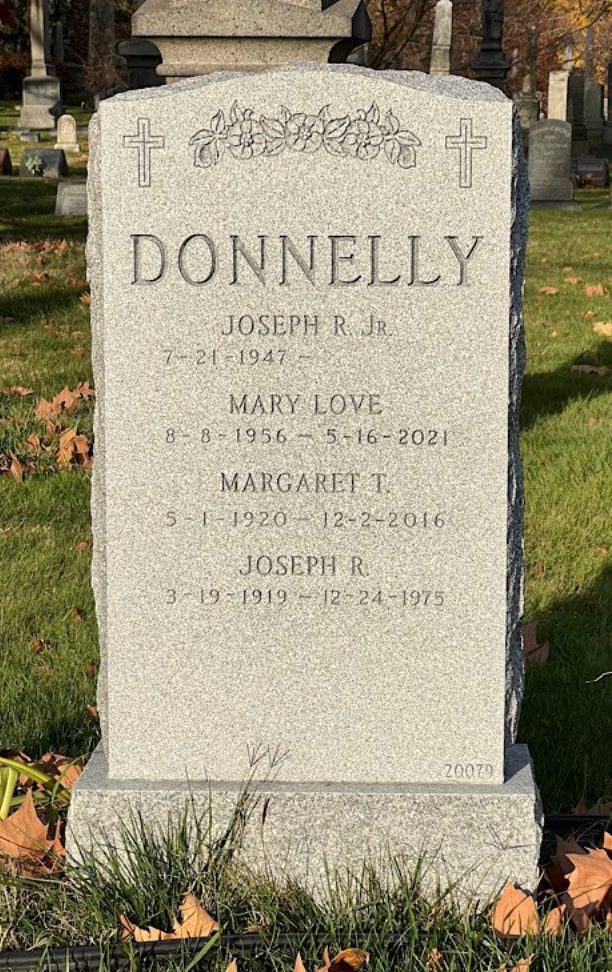
DORDONI, CONSTANTINE (1916-2005). Private, United States Army Air Force. Dordoni was born in Newark, New Jersey. The 1920 federal census documents that Constantine’s parents, Constantine and Matilda, were born in Italy and owned their home on Merchant Street in Newark. His father was a plasterer in a foundry and Constantine was the youngest of seven siblings. As per the 1925 New York State census, the family relocated to 23rd Street in Brooklyn. Constantine’s father worked in an iron plant and, with the birth of two daughters, the family had grown to nine children. In order of birth, his brothers and sisters are: Edward (born in Italy), Anna, Mistical, Joseph, Placido, Teresa (all born in New Jersey), Margaret, and Erma (both born in New York). The 1940 federal census records that the family lived on 22nd Street in Brooklyn and Constantine’s father was a gardener. Constantine, twenty-three at the time, was an upholsterer at a bed manufacturing plant. Living in the household were Constantine, his parents, and two sisters, Margaret and Irma.
In 1940, Constantine registered for the draft. As per his registrar’s report, he was 6′ tall and 202 pounds with hazel eyes, black hair and light complexion. Dordoni was twenty-four years old and worked for Harry Levy at 1628 Lincoln Place in Brooklyn. Three home addresses in Brooklyn were written on the card: 238 22nd Street, 436 13th Street, and 259 23rd Street. His mother was designated next of kin. On November 10, 1941, in Brooklyn, he and Julia Thir applied for a marriage license, according to the New York Marriage License Index.
There is little documentation regarding Dordoni’s military history. According to his World War II enlistment records, he was married and enlisted as a private in the United States Army. His enlistment occurred on April 28, 1942 at Fort Jay, Governors Island, New York Harbor. He reported at that time that he was an upholsterer who had completed one year of high school. Constantine was admitted into the hospital during his service. According to his World War II hospital admission card, he was treated for malaria in November 1944 and released the same month. This record documents his military branch as Air Force. In May 1945, he was readmitted to a Station Hospital for observation, but no disease was detected. He was discharged later that month. As per the Department of Veterans Affairs BIRLS (Beneficiary Identification and Records Locator Subsystem) Death File and a notation on Constantine’s draft registration card, he was discharged from the Army on November 25, 1945.
After the war and according to the 1950 federal census, Constantine and Julie lived on 23rd Street in Brooklyn with their two children, Ronald and Catherine. Constantine worked for the Department of Sanitation and Julia was an operator at a blouse factory. A great granddaughter, Stacy Locke, shares that Constantine was also called “Frank.” Section O, lot 41911.
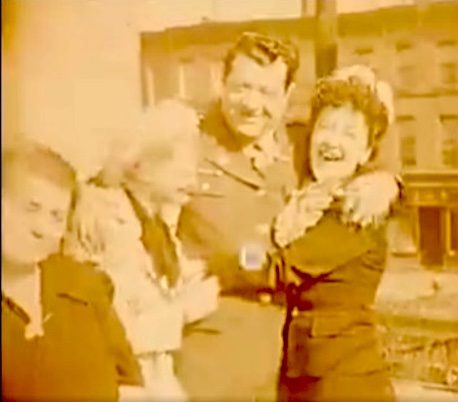
DUKAS, GEORGE HENRY (1914-1990). Sergeant, 27th Infantry Division/245th Coast Artillery, Battery M, United States Army. According to the 1920 federal census, George H. Dukas was born in New York and was five years old at that time. He was the only child of Harry and Mary Kondos Dukas at the time of the census, and they lived on Pacific Street in Brooklyn. Both parents were born in Greece, with Harry immigrating in 1900, and working then as a proprietor of a fruit store. Mary had immigrated in 1910. Harry was 38 years of age in 1920, while his wife was 18.
By the 1930 federal census, there were six children in the family, and they were living on Flatbush Avenue, Brooklyn. Harry was still a grocery proprietor. In 1940, the family lived on St. Marks Avenue, also in Brooklyn, but Harry then worked as a florist. George was now 25 and worked 48 hours per week as a counterman at a restaurant. All six children – George, William, Letty, Pauline, Helen, and Christopher – lived with their parents.
Dukas’s World War II enlistment card shows that he enlisted on May 3, 1939, after being in the National Guard since 1936. According to what is written on the card, George also lived at other Brooklyn addresses: 691 Vanderbilt Avenue and 267 Park Place. George went onto active duty on September 16, 1940. He is listed on the New York State Military Museum and Veterans Research Center website as a veteran of the 27th Infantry Division/245th Coast Artillery. This division was federalized for service on October 15, 1940, and its soldiers saw action in the Pacific, including Saipan and Okinawa.
George’s World War II draft registration card, signed in November 1945, lists his family home on Park Place in Brooklyn as his address, with his father as his contact. He had been honorably discharged from service on November 10, 1945 as a sergeant and was unemployed at that time. He was 5′ 6″ tall and weighed 155 pounds, of the white race with a dark complexion, and with brown hair and eyes.
Dukas passed away at the age of 75 on January 25, 1990. His wife, Helen, who died on November 11, 2013, is buried with him. Section 58, lot 44604, grave 29.
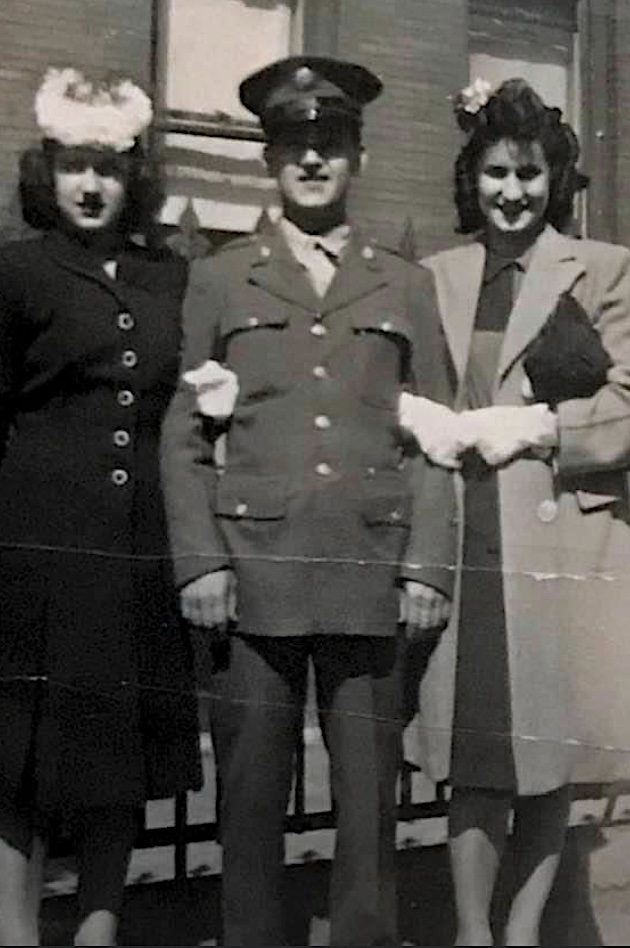
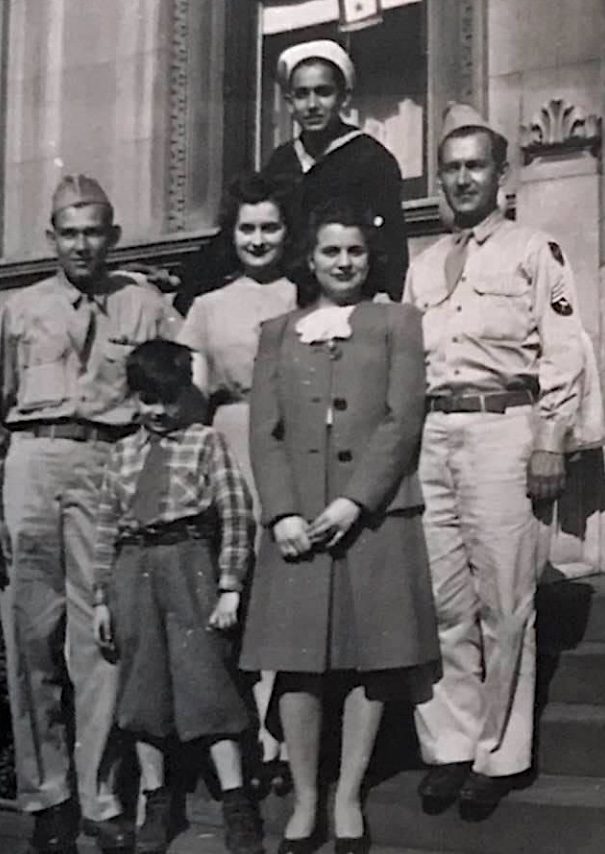
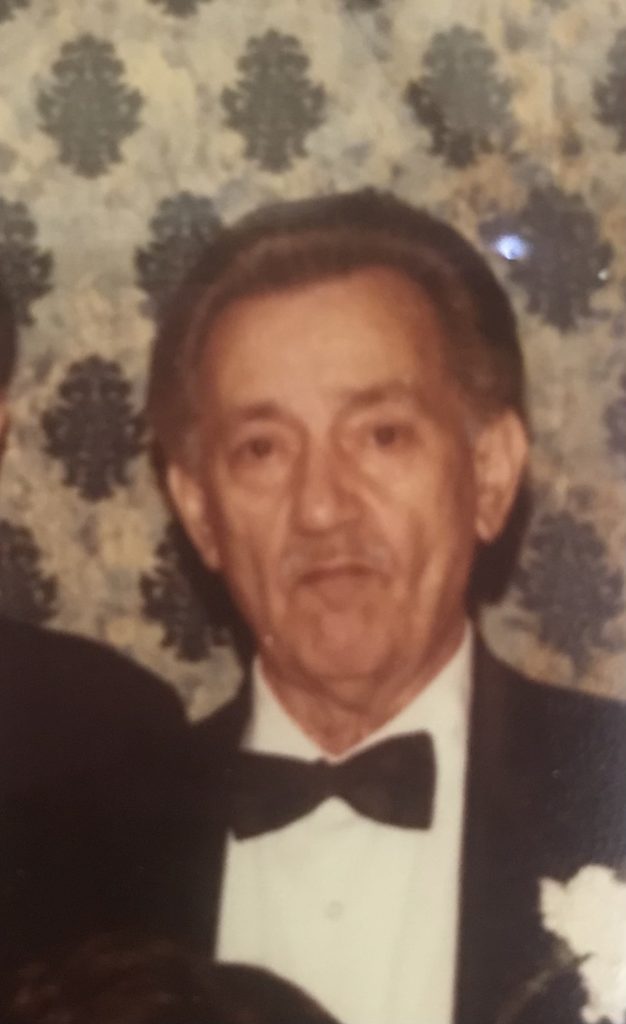
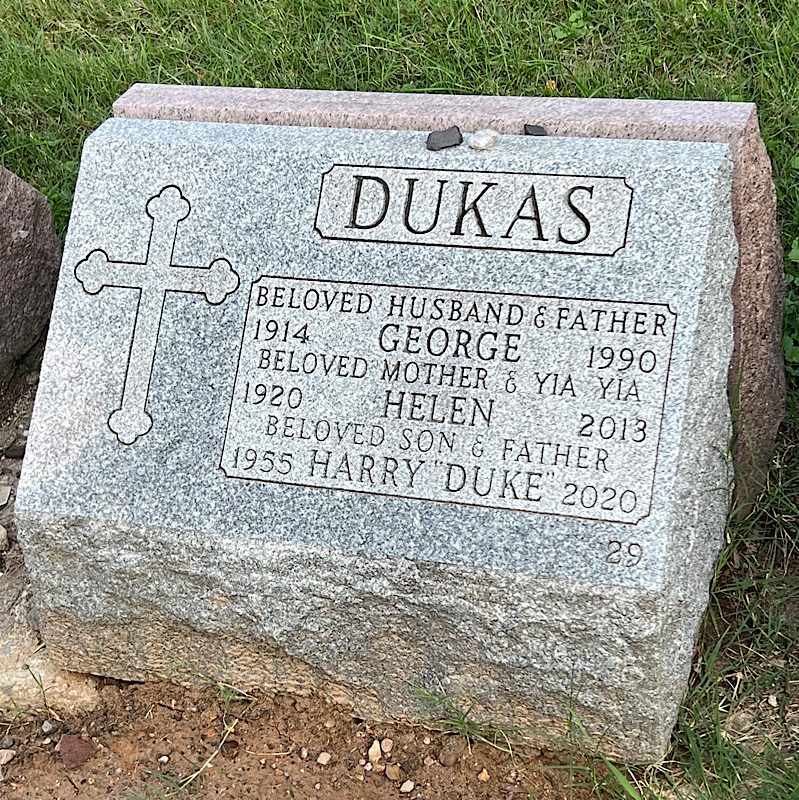
DUNCAN, JR., SAMUEL RANDALL (1910-1999). Private first class, United States Army. Samuel Randall Duncan Jr. was born to New York natives Samuel and Jessie Duncan. At the time of the 1910 census, the Duncan family was living on 2nd Street in Brooklyn. Samuel Jr. had two older sisters, Edna and Helen, and two older brothers, Alfred and Edwin. Their father worked as a real estate broker. According to the 1920 census, the Duncans, who by then also included a younger sister named Ethel, lived inBay Ridge. Samuel Sr. was employed as a hardware buyer. By 1930, Samuel Jr.’s family lived in a house they owned on East 26th Street in Brooklyn. Samuel Jr. and three of his siblings still lived at home and Samuel Jr. was working at a hotel as an oiler. His father, Samuel Sr., was employed as an engineering inspector working for New York City.
In August of 1935, Samuel married Margaret “Margie” Mary Sara. Their marriage license was listed in the Brooklyn Times Union newspaper. At the time of the 1940 census, Samuel Jr., who may have gone by Randall, lived with Margie at 388 East Third Street in the Kensington section of Brooklyn.
In October 1940, at the age of 30, Duncan registered for the draft. His draft registration card records that he was working at the Plaza Hotel at 59th Street and Fifth Avenue in Manhattan. His World War II Army enlistment records note that he had a grammar school education and a semi-skilled occupation in the production of paint and varnish. It seems that his employment at the Plaza included painting and other interior design work. His wife, Margaret Mary Duncan, is listed as the person who will always know his address. The physical description section of his draft registration card describes Samuel as 5′ 8″ tall, 147 pounds, and white with a light complexion, blue eyes, and brown hair.
A few years later, in 1943, Duncan enlisted in the United States Army in New York. While there are no existing records of the details of his service, according to his Beneficiary Identification Records Locator Subsystem (BIRLS) file, he served until his discharge on October 23, 1945, having achieved the rank of private first class. Following his discharge, Samuel Jr. and Margie continued to live at their East Third Street address, according to the 1950 census. Margie was employed as a clerk in an insurance office and Samuel Jr. as an electrician for a hotel. It appears that they had no children.
In 1999, Duncan was living in Cocoa Beach in Melbourne, Florida, when he passed away. The Florida Today newspaper noted in his obituary that he was a retired interior decorator for the Plaza Hotel in New York City. Section 66, lot 23765, grave 1.


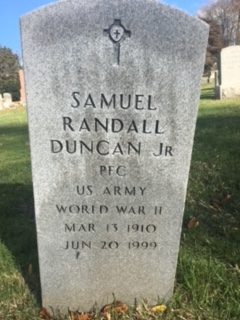
EDSON, JARVIS BONESTEEL (1910-1958). Technician fifth grade, 764th Amphibian Tractor Battalion, Company B, United States Army. Jarvis Bonesteel Edson was born to Marmont Edson and Margaret Russell Elkin of New York City. By the 1920 federal census, Edson’s parents had separated, and he was living with his grandmother on West 74th Street in Manhattan, along with his father and brother, also named Marmont. The family appears to have been relatively wealthy, as they had a servant, launderer, and governess in residence. In 1925, Edson and his brother were both students lodging with a family on Shelter Island. Edson returned to his father’s home in the city, and was working as a bond clerk in 1930, according to the federal census.
Edson’s draft registration card, filled out in 1940, indicates that he was living with an aunt on East 51st Street and working at the James Fallon Restaurant on Third Avenue. He was described as 5′ 8″ tall and weighing 150 pounds, with a ruddy complexion, blond hair and gray eyes.
In 1942, Edson enlisted in the United States Army and reported to Fort Dix, New Jersey. At the time he enlisted, he had completed four years of high school and was working as a bartender. Jarvis served as a technician fifth grade in Company B of the 764th Amphibian Tractor Battalion, transporting supplies, equipment and personnel from ships to land. According to one source, the 764th Amphibian Tractor Battalion didn’t see combat during World War II but was ready for an invasion of the Japanese mainland if that were to occur. The application for a veteran’s headstone indicates that Edson was awarded a Good Conduct Medal for his military service, and was honorably discharged in 1945.
Edson married Laura Jeanné Tourjée in Louisville, Kentucky, in 1944. According to a family history, they had a daughter named Janet in 1947, while living in Binghamton, New York. At the time of his death in 1958, Edson was living in Dering Harbor, New York. Edson was laid to rest in the Edson family plot at Green-Wood Cemetery. Section 22, lot 3488.
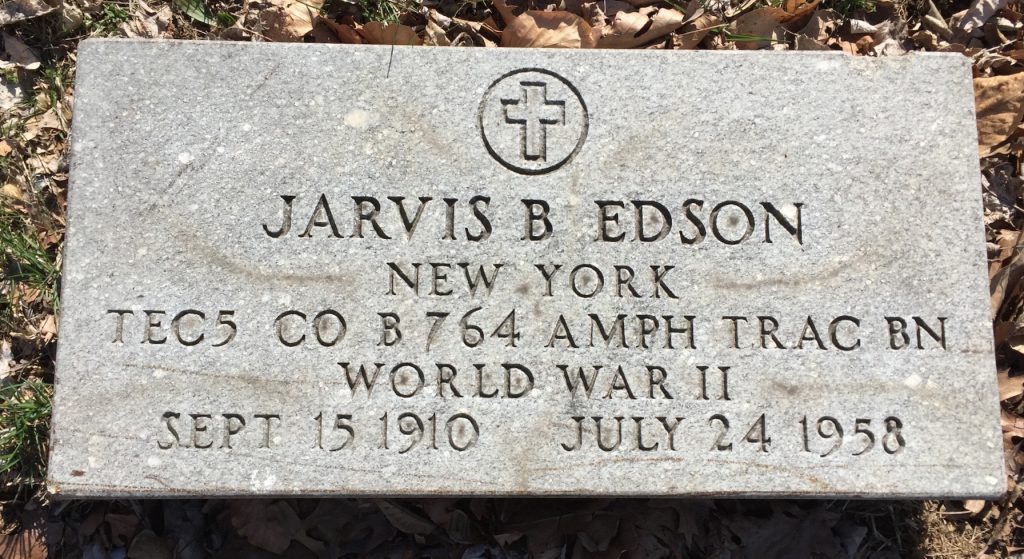
EIDINGER, ANNA OLISHEWSKY (or OLESHEWSKI), (1923-2006). A “Rosie the Riveter,” female factory worker in support of the World War II stateside effort. Anna Olishewsky was born in Brooklyn; her birth record spells her surname as “Oleshewski.” After graduating from Eastern District High School in 1939, she first worked as a milling machine operator at Clarisat on Sands Street in Brooklyn.
During World War II, she worked at Sperry Gyroscope Company, also on Sands Street. Her daughter, Barbara Eidinger, reports that she wired electrical panels for battleships. In the words of Barbara, “I’m glad I was able to find a picture of Mom rocking the Katharine Hepburn look as a real life ‘Rosie the Riveter.’ Shame you can’t see her saddle shoes. She worked in a factory in a man’s job in men’s clothes downtown in the Sands Street area of Brooklyn, but after work, she went home and dressed like the lady she was.” Barbara also reported: “A cute story about Mom and her war work comes to mind. She used to have to bake parts of the battleship panels she wired in an oven. Well, at holiday time they all had to work so they used to smuggle in rationed meat and cook it in the ovens to enjoy together. To go along with the meal, she used to smuggle hip flasks of booze into the factory on the inside of her Wellington boots. She didn’t drink, but her audacity helped her coworkers make merry as they did their part to win the war.”
Olishewsky met her husband when he returned to Sperry in Brooklyn after his military service. Barbara Eidinger recalls that her dad, having grown taller while in the service, returned to work in civilian trousers that were too short. Her mom offered to turn the cuffs down, and in Barbara’s words, “The rest is history.” On October 14, 1947, Olishewsky married Frederick Eidinger (see) in Manhattan; the couple had one daughter. In 1993, the Eidingers lived at 269 17th Street in Brooklyn. Section 133, lot 39603, grave 2.
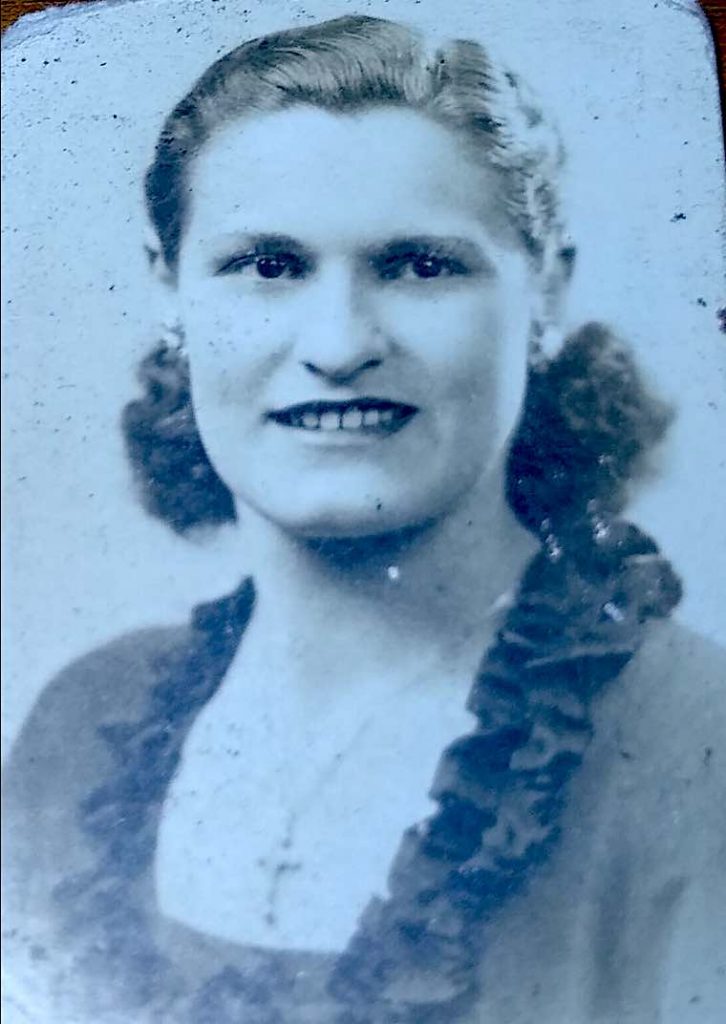
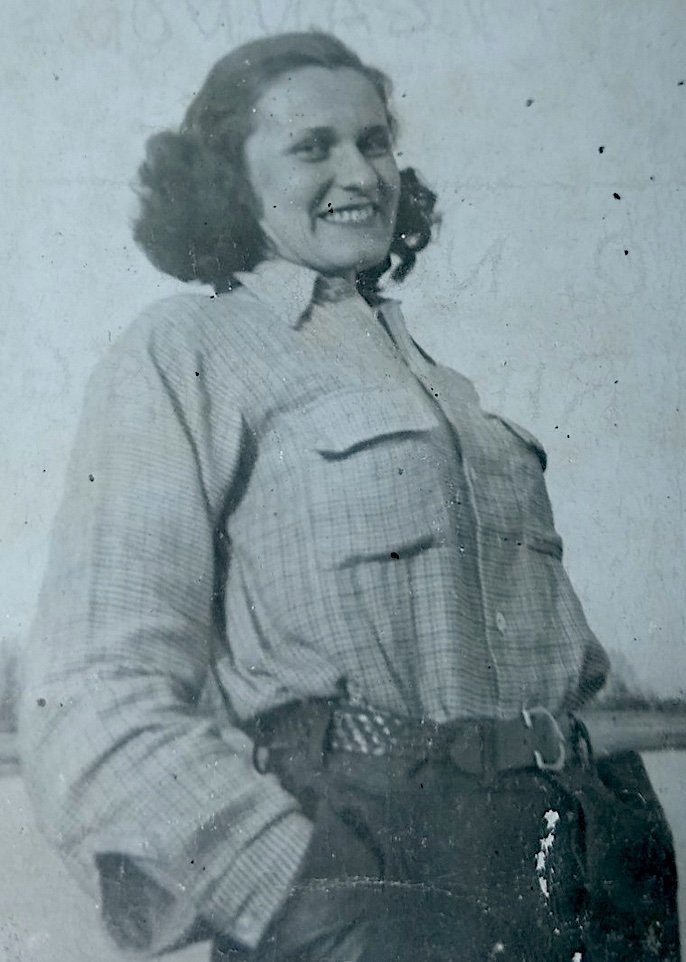
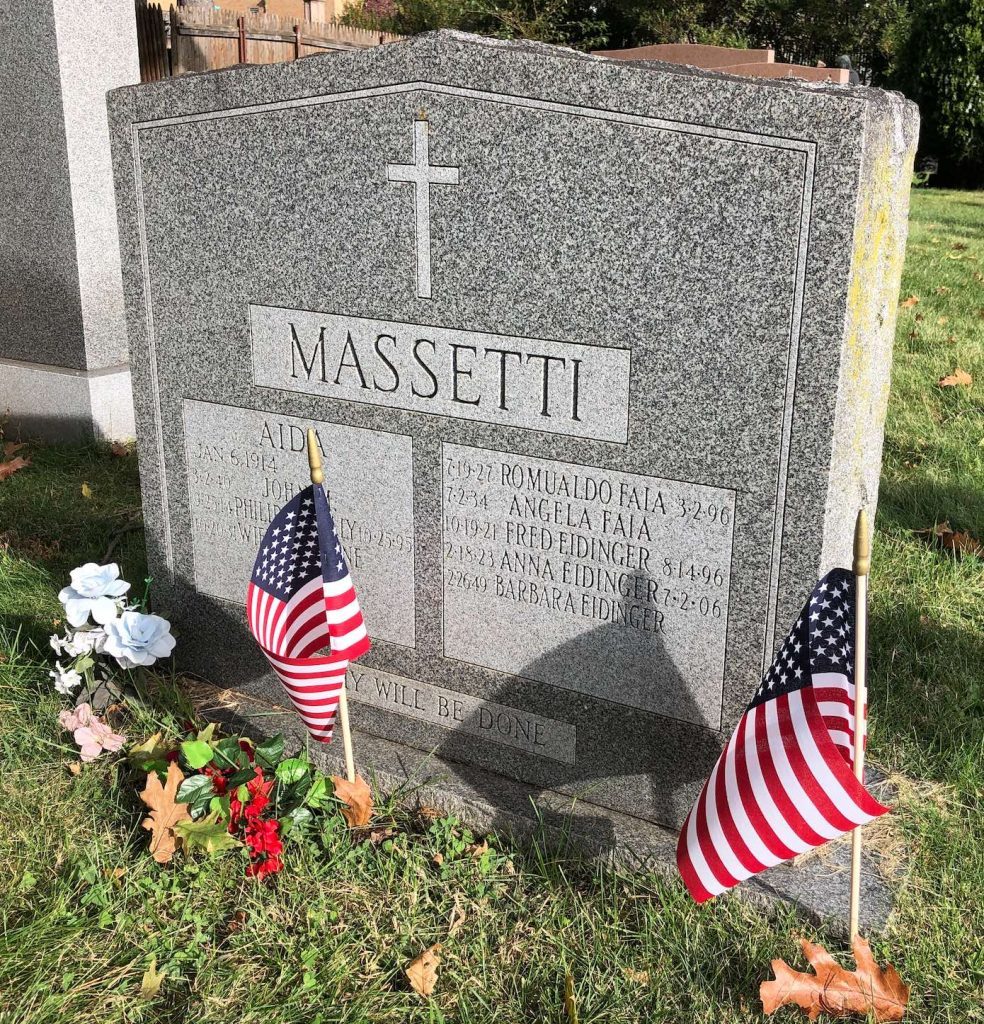
EIDINGER, JR., FREDERICK (or FREDRIC) HENRY (1921-1996). Corporal, 3705th Army Air Force, United States Army. Born in Hamburg, Germany, the 1940 census reports that the eighteen-year-old Eidinger lived with his parents, Fritz and Agnes, at 1449 First Avenue, New York City. His citizenship is listed there as “alien” and he was in his third year of high school. As per his daughter, Barbara Eidinger, he graduated from Brooklyn Technical High School in 1941. He registered for the armed forces on February 15, 1942, at the age of 20. His draft registration card lists him as 175 pounds, 6′ 2″, brown eyes, blond hair with a light complexion. His place of business was Sperry Gyroscope Company (founded by Elmer Sperry, inventor of the gyroscope, iron mike, and many of breakthroughs for the armed forces, who is also interred at Green-Wood Cemetery), located at 36-40 Flatbush Extension in Brooklyn. He originally recorded his address as 281 20th Street, Brooklyn, but changed it to 159 18th Street. William Pitsing, relationship unknown, was listed as his emergency contact.
His army enlistment data from March 13, 1944, at Camp Upton in Yaphank, New York, states that he was single, a citizen and had completed four years of high school. His civilian occupation is listed as a semi-skilled worker in building aircraft. His rank at enlistment was private. According to records, he was treated for an inguinal hernia, an injury he sustained in the line of duty, from November 1944 to December 1944. His places of service included Texas, Lowry Field in Denver, Colorado, and Valdosta, Georgia. According to his daughter “he excelled at the then new technology of radio/television electronics at both Brooklyn Tech High School and at Sperry Gyroscope Inc. He was therefore assigned to several stateside Army Air Force support facilities as a remote control turret repairman and computer specialist from May 1944 to April 1946.”
Upon completion of service, he returned to work at Sperry Gyroscope. According to its Division Records website, Sperry Gyroscope was incorporated in 1910. From 1915 to 1925, the company worked with the United States Navy to develop stabilizers, the aerial torpedo and anti-aircraft devices, among other inventions. In the 1940s, the Sperry Corporation worked with Stanford and MIT, developing microwave technology. During World War II, it produced computer-controlled and stabilized bomb sights, automatic pilots, airborne radar equipment, and other systems for the government. Eidinger’s daughter relates, “Going through my Dad’s photos from his life’s work at Sperry, I discovered why he had to have security clearance and not speak of work at home. He and his shop were the recipients of many awards from both the Navy, for work on the Polaris missile system, and later from NASA, for work on Apollo XI and XIII.”
He married Anna Olishewsky (see) on October 14, 1947. Anna had a factory job during World War II at Sperry Gyroscope Company, where they met after he returned from his military service. In 1993, he was living at 269 17th Street in Brooklyn. According to the Veterans Affair records, Eidinger passed away in 1996 of natural causes. He was survived by his wife and daughter. Section 133, lot 39603, grave 2.
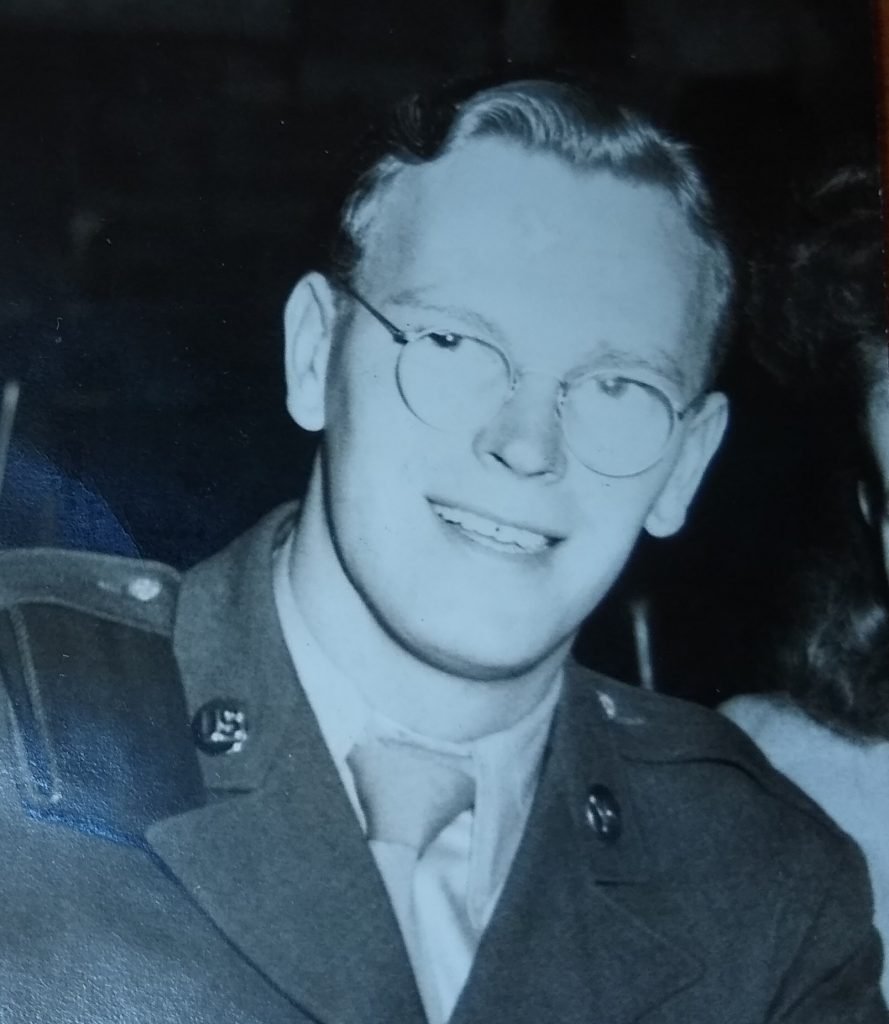
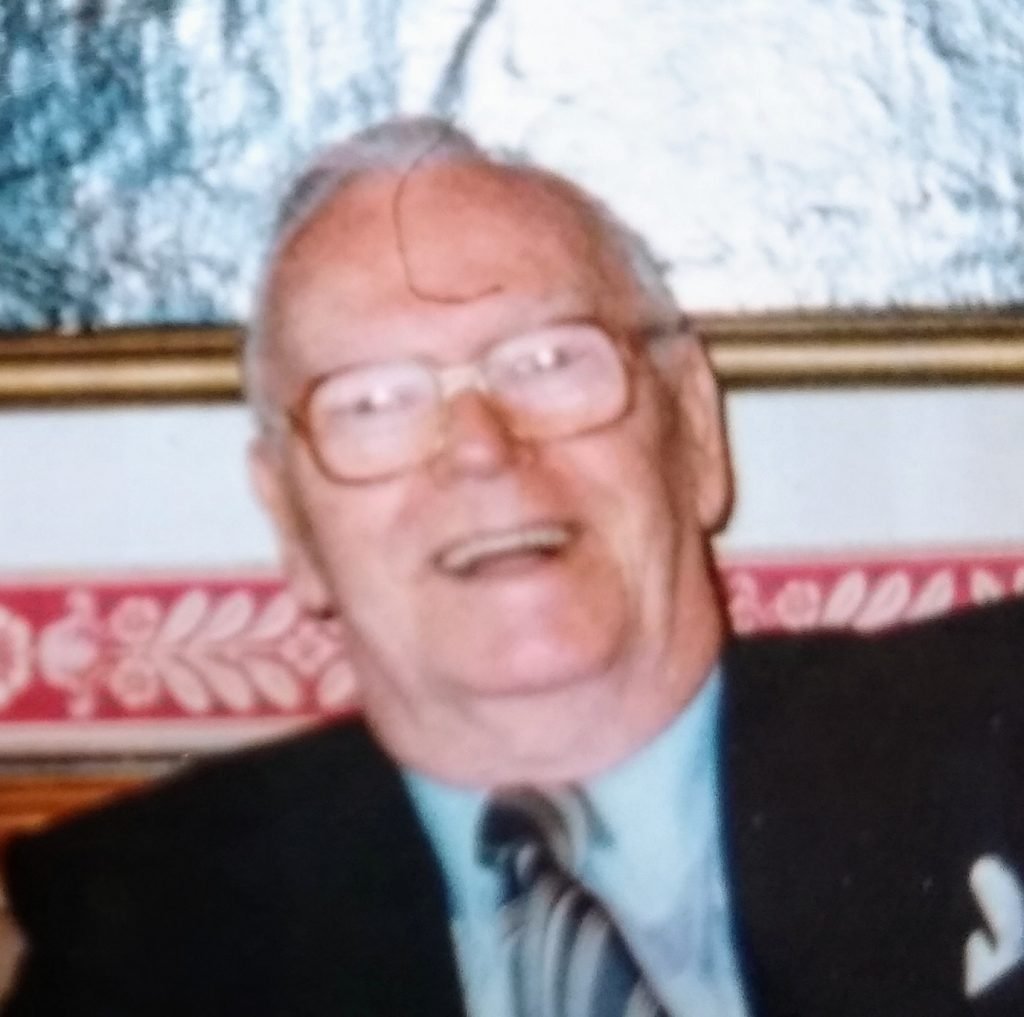
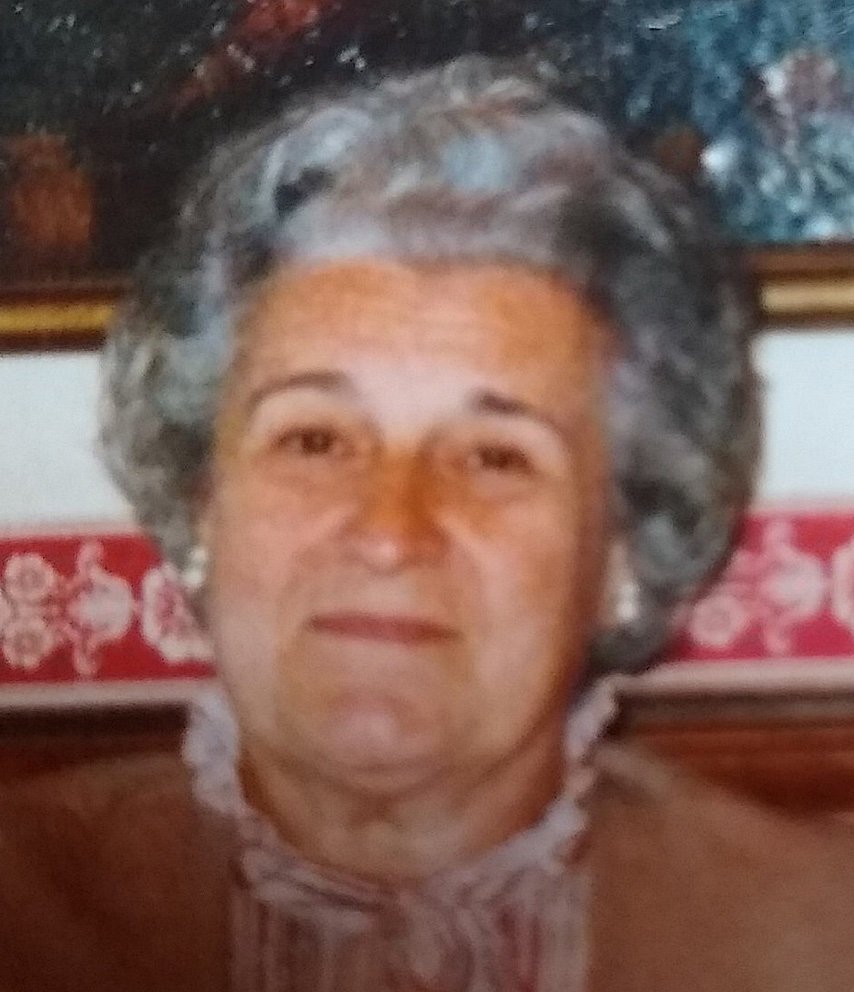
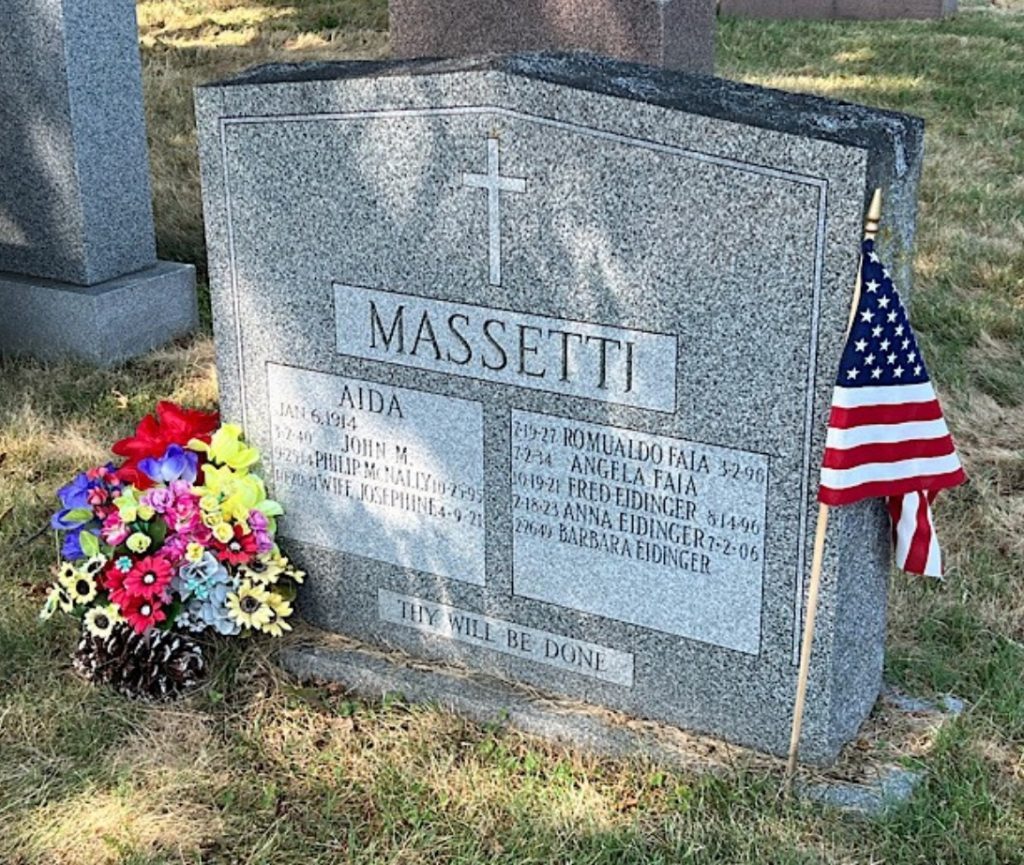
ENES, INGVALD OLVIND (1915-2009). Private, United States Army. Ingvald Enes was born in Tysnes, Norway, the youngest of six children, to Johannes Bertelsen and Ales Knutsdatter, according to information on Ancestry.com. In 1936, the ship Kaupanger, arriving at Sayresville, New Jersey from the port of Raakefjord, Norway, in June 1936, lists 21-year-old Ingvald Enes as a deck boy, with two years at sea. (His brother, 33-year-old Berner, is also on the list, with a sailor’s rating and 14 years at sea).
In March, 1941, the ship Varanger arrived in New York from Glasgow with Ingvald, now 26 and assistant boatswain, listed on the crew manifest. This time Ingvald, along with 22 other crewmen, did not return to Europe; the 1940 Nazi occupation of Norway may have been the reason.
In February, 1942, Enes registered for the draft at his local draft board in Bay Ridge, Brooklyn. He was living nearby, and working in a boatyard in the Gravesend area of the borough. His draft registration card describes him as 5′ 8″ tall, 150 pounds, with brown hair, blue eyes, and a ruddy complexion. The Second War Powers Act of 1942 removed some naturalization requirements for non-citizen service members. Military wartime service was often a fast track to citizenship.
In August, 1942, the 99th Infantry Battalion was activated at Camp Ripley, Minnesota, as the first of four foreign “ethnic” battalions for Europe. The 99th was filled with Norwegian citizens living in the United States and American citizens of Norwegian ancestry. Many Norwegian merchant sailors who’d been stranded in the United States as a result of the German occupation joined up. Dubbed the “Viking Battalion,” the 99th never saw action in Norway, instead fighting in France, Holland, Belgium, and Germany from June 1944 to the war’s end. Not until May 29, 1945, did the Viking Battalion make it to Oslo to assist in Norway’s transition from German occupation.
In October, 1946, the ship Stavangerfjord, out of Bergen, Norway, docked in New York City. Among the passengers was United States citizen Ingvald Enes. With him was his wife, Olava Ellingsen Enes, of Norway.
Ingvald and Olava (Olivia) Enes continued to live in Brooklyn for many years. The couple had a son, Ivan, and a daughter. Enes died at the age of 94 and is buried with his wife, who preceded him in death in 2003, at Green-Wood. Section 58, lot 44604, grave 341.
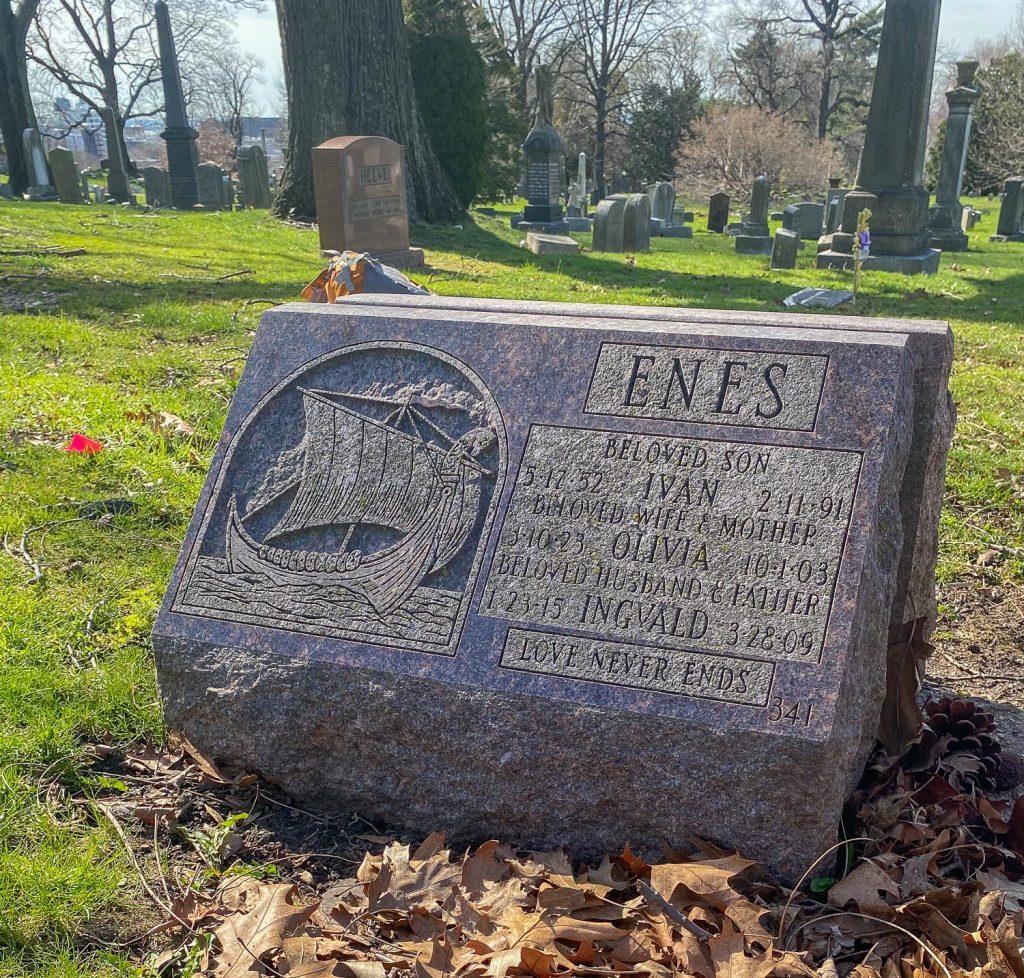
ERRICO, DOMINICK (or DOMENICO) WILLIAM (1918-1987). Unknown rank, 649th Engineer Topographic Battalion, United States Army. Errico was a native New Yorker, born in Manhattan to parents who had declared their intention to become citizens of the United States in 1924. This document and its statement that required his father Pasquale and mother Carmilla to renounce forever all allegiance and fidelity to a foreign sovereign, is stamped with the name Victor Emmanuel III, King of Italy. It was submitted fifteen years after their arrival in the United States. At that time, Dominick was the eldest of five children, followed by Vincent, William and Joseph, all born in Manhattan. The family moved to Brooklyn before the birth of the youngest child, his sister Chiara. This move, documented in Pasquale Errico’s petition for naturalization, was one of several throughout the borough, beginning on Clarendon Road, then to Rogers Avenue by the 1940 census. Dominick was working as an errand boy at the time of that official counting, and the family had grown with the addition of two more younger siblings – Murray and Frank.
Vincent Errico, who seems to have also been known as James, was already in the Army by the time his older brother Dominick registered for the draft. Enlisting on October 24, 1941, Dominick Errico served almost five years in the Army. The road was his home, and maintaining the trucks that his division used to map Algeria, France, and Germany, was his job. The United States Army had just three topographic divisions, and Dominick’s was the only one in Europe, making and updating the maps that were distributed through these theaters of war, and geodetic surveys for weapon system and airport construction, according to the Division website. An army may march on its stomach, as the old trope goes, but it mapped the terrain for its battles with the trucks that Errico maintained. He is pictured with other members of his crew, recognized for their “untiring efforts” to keep the division on the move. Two years after he was discharged from the service, he married Francis Frisone on September 13, 1947, with whom he raised a daughter, Patricia. Section 72, lot 44602, grave 280.
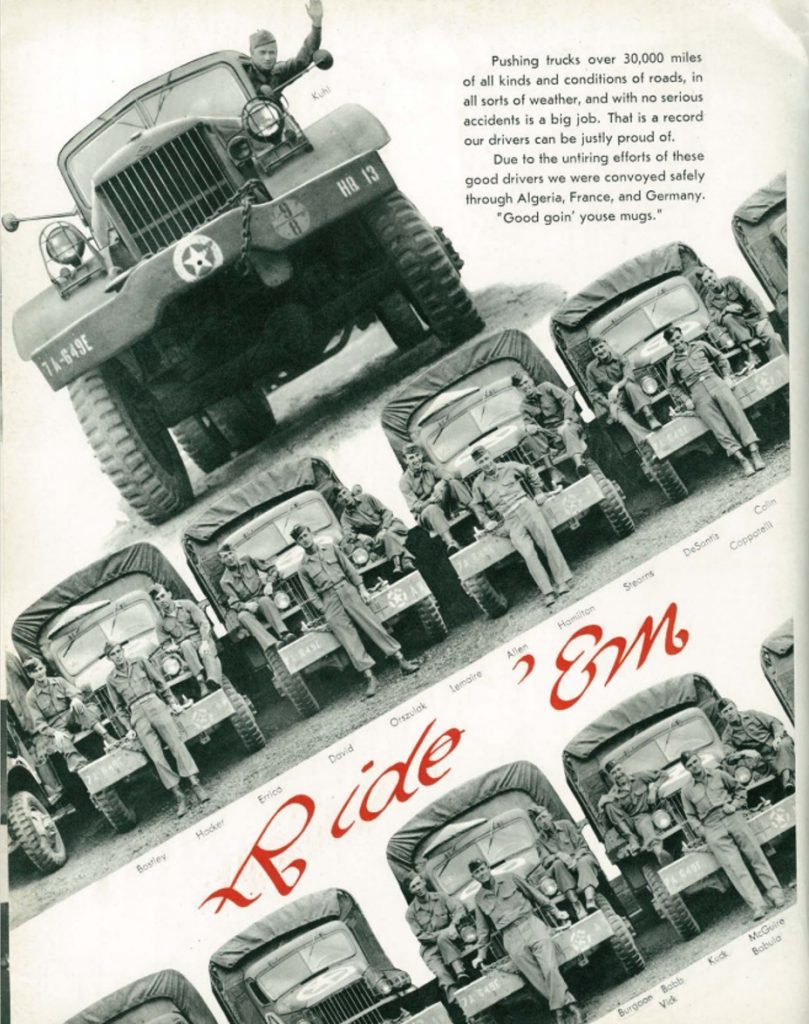
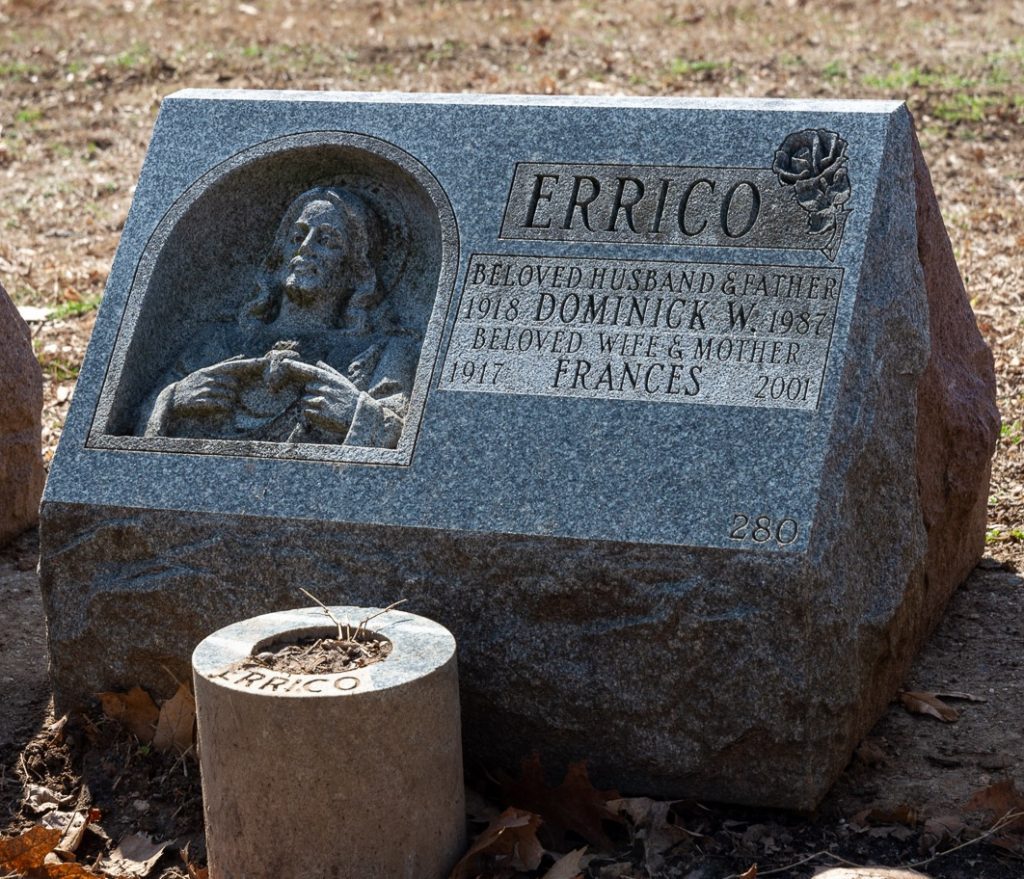
FASULO, EDMUND G. (1925-2017) Radio man third class, United States Naval Reserves. Edmund Fasulo was born in Brooklyn. According to the 1930 federal census, his father, Joseph, was a barber who had been born in Italy, while his mother, Carmela, was born to Italian parents in Brazil. In 1930, the family was living on 12th Street in Brooklyn; by 1940, as per the census of that year, they had moved to 14th Street. Carmela’s father, Alfonse Autorino, was now living with them. Also there were Edmund, now 14, brother Joseph, 17, and older sister Christina, 18, who was working in an office.
Edmund was the youngest of four children. He attended Brooklyn’s Manual Training High School (now John Jay Educational Campus), and his 1943 yearbook mentions that he held a certificate in music and was a member of the Junior Arista Band. His daughter, Donna, notes that he was a trumpet player.
However, Fasulo would soon be setting aside his musical pursuits for military service. He filled out his draft registration card on his eighteenth birthday. It describes him as having a light complexion, brown eyes and black hair, measuring 5′ 8″ tall, and weighing 142 pounds. He listed his mother as the person who would always know his whereabouts.
United States Navy muster rolls indicate that Fasulo enlisted in 1943, and in 1944, as of September 6, he was serving as a radio man aboard the destroyer minesweeper USS Fitch. He was transferred to another destroyer minesweeper, USS Forrest, in 1945, which conducted minesweeping operations and performed escort missions in the waters around Okinawa. After downing two kamikaze aircraft, the ship was struck by one of the falling enemy planes, which killed five men and wounded 13. USS Forrest was repaired and returned to port in Boston, where the ship was then decommissioned. As per his daughter, Fasulo served on three ships that were sunk by enemy forces; two by torpedo, one by kamakaze plane. In 1946, Fasulo served aboard the destroyer USS Edwards at Long Island, New York, where he was discharged from service. According to his daughter, Donna, he was awarded three Battle Stars and an American Campaign Medal.
According to his daughter, Fasulo went on to study at The Juilliard School. He returned to Brooklyn, where he met Dolores Cassano and filed for a marriage license in 1957. They had three children together, and Fasulo went on to work for Merrill Lynch. In the 1990s, he lived at various addresses in Brooklyn, including on 56th and 90th Streets. His wife, Dolores, died in 2019 and is interred with him. Section 132, lot 39976.
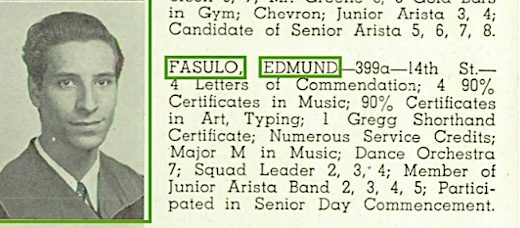

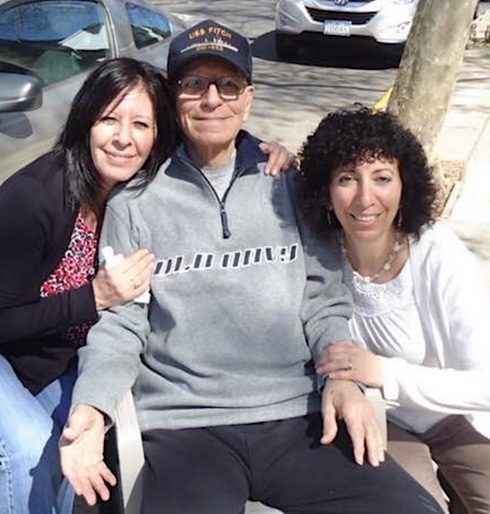
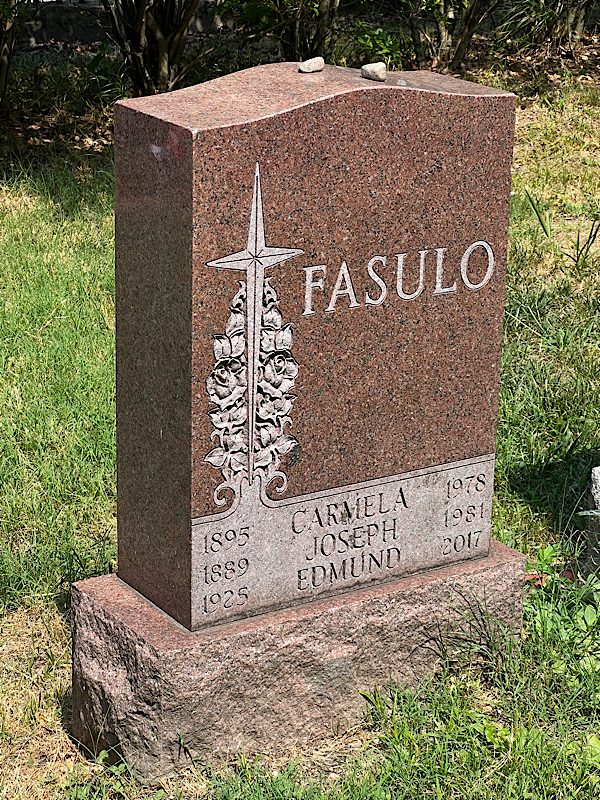
FAZIO, LEONARD (or LEONARDO) ROBERT (1922-2018). United States Navy. Leonardo, as was his name at birth, was born and bred in Brooklyn, to Italian immigrant parents Francesco Fazio and Donata née Chico. Francesco Fazio was from Bitetto, and Donata Chico was from Toritto, in the region of Apulia, southern Italy.
In 1925, according to the New York State census, the Fazio family lived at 111 Adams Street. Leonard’s father was then thirty-eight and listed as Frank Fazio, his mother thirty-six and listed as Dora Fazio. Both parents had been in the country for twenty years by this time. They had six children: two daughters, Mamie and Josephine who were sixteen and thirteen, respectively, a son Michael, eleven, daughter Bessie, eight, a son Gabriel, six and Leo, as he was listed here, was the youngest at age three. Except for Josephine, who was born in Italy, Leonard and the rest of his siblings were born in the United States. His father worked in ice and coal, his mother’s occupation was listed as housewife, and Mamie, the oldest sister, was a factory worker.
That same year, in the summer, Leonard went on a trip to Italy with his family. The manifest records for the ship Duilio show they sailed back from Naples on July 15 and arrived in New York on July 25. Francesco Fazio’s age here is listed as forty, his occupation as laborer, and he arrived with $100. He was travelling back with his wife Donata and their two sons Gabriel and Leonardo. Their last permanent address was in Brooklyn and Francesco’s father Michele in Bitetto, Italy, was listed as his nearest relative. These records list Francesco’s son, Giacomino, as their closest relative in the United States.. Leonardo is described here as having brown eyes and brown hair. It is also indicated that all four family members were unable to read or write.
In 1930, the federal census records show that the family had moved to 5 Middagh Street. Frank was now forty-three and Dora was forty years old. Their son Michael was listed as the eldest child and Leonard, now eight, had two younger brothers, Bennett who was four and Joseph who was two years old. Leonard was described here as white, having attended school, and being able to read and write.
The 1940 federal census shows the family continuing to live at the same address and owning their home. Frank Fazio was now fifty-six and worked as a distributor for coal, as did his son Michael. Their second child, previously listed in the records as Bessie, goes by the name Elizabeth here. Leonard himself was now eighteen years old, had completed the fourth year of high school and was working as a machinist helper at a hardware company.
In June of 1942, at twenty years of age, Leonard R. Fazio enlisted for service. His World War II draft registration card describes him as 6′ 1″ tall, 185 pounds, with a light complexion, blond hair and hazel eyes. His father, Frank Fazio, is listed as his next of kin. The document also shows that Leonard was self-employed at the time, working in ice and coal. Details of his service in the Navy are unknown.
As reported by his daughter, Fazio married Gloria Tarshis on May 6, 1946. They had two children: a son named Glen Leonard (1947-2017) and their daughter, Dale Francene (born in 1950). At the time of his death, Fazio lived at 61 Pierrepont Street in Brooklyn. He is survived by his wife, who continues to live there, and his daughter Dale, who lives in Brooklyn Heights. Urn Garden, section 3063B.
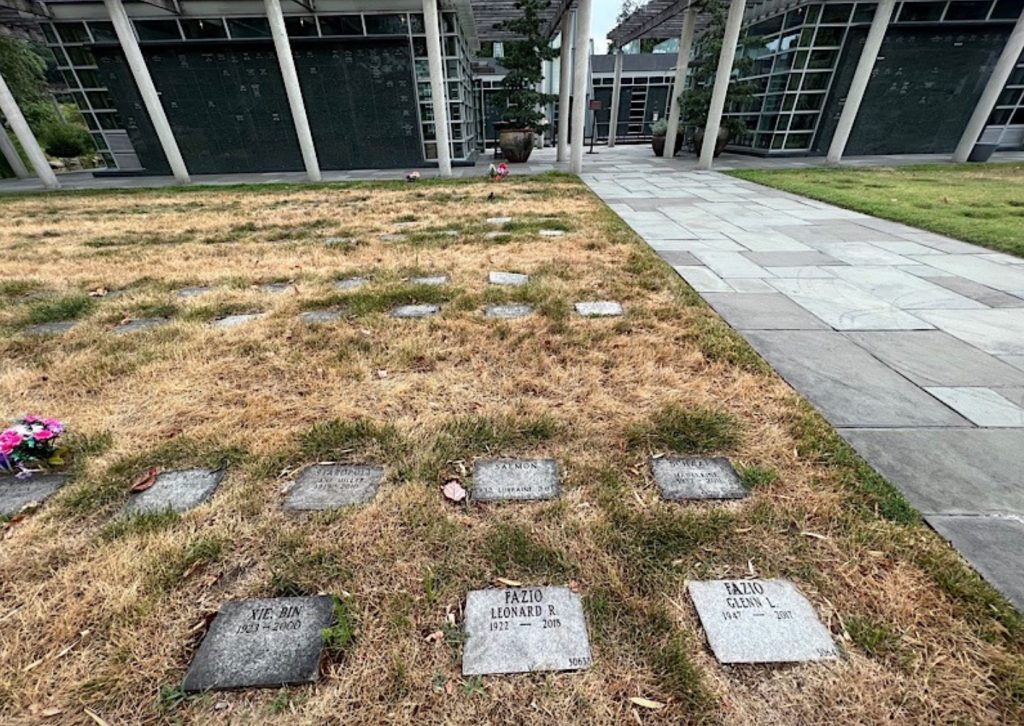
FELDHUSEN, ELIZABETH A. (1918-2014). Nurse, 131st Evacuation Hospital, United States Army. Elizabeth was born in Brooklyn to Anna and Fred Feldhusen. On July 14, 1995, when she was living in West Park, New York, she was interviewed by Neenah Ellis for an oral history that is part of the collection, including those of other nurses in her unit, archived by the United States Holocaust Memorial Museum. Much of the information about her wartime experiences and some of the questions and her answers from that interview are included in this biography.
At age 12, Elizabeth was a Girl Scout and loved the training she received by the Red Cross in home nursing and taking care of the sick. The 1930 census reports that she was an only child living with her parents at 325 McDonough Street in Brooklyn. In June 1936, she graduated from Girls High School and needed a job during the Depression. Her mother was opposed to her becoming a nurse so Elizabeth took a job in a hair net factory but quit after a week; her mother picked up her $7 earnings. Shortly after that, her father, a piano tuner who worked at Brooklyn State Hospital, spoke to the superintendent there, who encouraged him to tell his daughter to enter nurses training school there. After Elizabeth applied and was accepted, she entered a three-year program at Kings County Hospital. She then applied for a position at the Brooklyn Nurse Association and attended New York University at night to fulfill its requirements. Although initially interested in public health, the United States was at war and her sickest patients said to her, “What are you taking care of me for? You should be taking care of the boys.”
On July 1, 1943, Feldhusen and a close friend went by train to Wilmington, Delaware, where their Army service began. After getting some help, the two women found the bus that took them to the post hospital at Fort DuPont, a small facility with seven nurses and four doctors. After a year and a half of stateside duty that included caring for German prisoners of war, she was assigned to the 131st Evacuation Hospital at Fort Jackson, South Carolina. That unit, which was first activated in March 1944, was tasked to prepare for treatment of troops near the battlefield. After traveling by train to Jersey City, they sailed aboard the RMS Queen Elizabeth, a cruise ship outfitted for transporting troops, and landed in Greenock, Scotland, on December 23, 1944. The vessel transported forty nurses and about 10,000 troops. When asked about the crossing, Feldhusen said:
…There were 40 of us and half were in one stateroom and half in another stateroom. And we had bunks up to the ceiling. And I had a bottom bunk and I really had to lie on the floor in order to get into that bunk. And then all night long, the ship would go this way and that way, so you’re either on your feet or on your head. But the reason was—I don’t know if the other girls told you, but that we turned every seven minutes in order to avoid the submarines, because we did not have any escort across the ocean….
Feldhusen described being sent to Wales, serving in an American-run hospital where nurses lived in Neesan huts:
When you wanted to take a bath, you had to run out and well, quite a distance to go to the bathroom or to take your bath. And–so you didn’t take a bath too often, but I know the nights when I got off duty, I had everything all ready and I just grabbed everything and then ran up to that place, because if you didn’t get there first, somebody else did and you didn’t get any more hot water. So I mean, even if you took a bath twice a week…
The group of nurses, now 39 (one was pregnant and sent home) crossed the English Channel and went to LeHavre, France, in the middle of the night. Depth charges, explosives used to attack submerged submarines, made loud booms because of the enemy submarines that were in the harbor. Because she was not allowed to keep a diary, Feldhusen believed they arrived on the continent in March 1945.
The history of the 131st reports that after arriving in France, the unit drove in a motor convoy through Luxembourg and Belgium before arriving near Kaiserslautern, Germany, in April 1945 just before the death of President Franklin Delano Roosevelt, and setting up operations there. By April 30, the hospital had taken down its tents and soon began its move to Sandersdorf, about 241 miles north of Munich. In her oral history, Feldhusen spoke about her time in the evacuation hospital in Germany when fighting was still occurring in April 1945:
Oh yes, April—I mean when we were in Germany, when the war was over—no, before that, we were going to be overrun by the Germans. We all got a Battle Star for that and we were given instructions. That I remember vividly and the—we were told, “Just continue working as if nothing was happening. Do—take care of your patients, do the same thing. And you may be questioned, but just answer the questions, but don’t let it bother you,” and of course we weren’t. But we were very close and you could hear these great, big tanks coming. In fact, one day in my ward, one tank was so close and you could hear it coming, that even the bed patients got out of bed to see it. You know, you could hear this noise coming and I guess they were alarmed, because you didn’t know who it was, but they were Americans. And–so we were very close, just at that one period. And that was someplace in Germany. And I couldn’t tell you where.
After Germany surrendered on V-E Day, May 8, 1945, the decision was made to move the 131st to Linz, Austria. Its main purpose now was to tend to the medical needs of those sick and weakened mostly Polish and Russian prisoners liberated from the concentration camps.
As per her oral history, Feldhusen had not known about the concentration camps or the conditions that she and others from the 131st would encounter there; their work there lasted through June 15, 1945. The nurses followed the soldiers at Mauthasen and Gusen, where they treated survivors who were transferred from the camps to the newly established hospital. But first, they had to clean up the horrific conditions that they saw.
In her oral history, Feldhusen talks about the first time she heard about Gusen. Initially, she said the colonel told the nurses, “You don’t have to go. There’s a lot of tuberculosis and a lot of chronic illnesses, and you don’t have to go if you don’t want to.” By the next day (she surmises in early May), everybody went. When asked if she had ever heard of the concentration camps, Feldhusen replied, “No, no I never had, no.” She then described her responsibilities at Gusen:
Well, I had a ward, big ward and there was a great deal of diarrhea and we were giving out sulfanilamide, which is—I don’t think it’s a drug used any more, but it’s before the antibiotics came in. And, oh we gave out like 20 pills and everybody was up in tiers [barracks]. In order to get up to the top person, you had to stand on the lower tiers to reach them.”
Although young German prisoners of war helped the nurses by carrying bedpans and urinals for the liberated men, there was little to eat and few supplies. Her duties primarily were to give medication and food to about 20 men in each room; the nurses did not shower the men nor did the nurses wear protective gowns over their fatigues. When asked about the condition of the people she saw and if the men wore striped pajamas, Feldhusen replied:
Well, they were lying in bed and they were weak and very thin. And I guess it was shocking, you know, when you’re not used to seeing all those types of things and people. They had shirts on of some kind, mm-hm. And—pajamas, seems to me…They had plain pajamas on. I don’t really remember exactly what they had on, but they—they were covered.
As per the history of the 131st, liberated displaced persons had to be deloused and DDT powder was used on United States personnel to ward off body lice. Feldhusen confirmed that she was sprayed with DDT powder everyday including on her hair and wonders if was the cause of her breast cancer later in her life. German prisoners were put to work to clean a former kitchen for the 131st and tentage was constructed for a 1,500 bed hospital. Although 30 former prisoners died on May 9 and 10, 1945, by May 12, a total of 1,804 patients were treated as sanitary and clean-up continued every day at the camps. Although dozens succumbed to tuberculosis, typhus, dysentery and malnutrition, about 4,000 patients of 22 nationalities were treated by the 131st by the time of their departure on June 15; the 59th Field Hospital took over operations. The 131st then left for France where the nurses ultimately boarded a ship at LeHavre to cross the Atlantic.
In her interview, Feldhusen notes that she kept in touch with the other nurses over the 50 years since they returned home. She felt that they bonded because they had lived together so closely, five or six in a tent. She also took pride in the fact that she organized the first luncheon with the group of 10 who made it to Brooklyn Heights during a Brooklyn snowstorm in 1947. When asked about how her experience changed her life and if she was hopeful at the end of the war, Feldhusen replied:
I was very hopeful, yeah, that—and—but I mean, it’s all within the last 10 years that things have changed. And it’s– to me it’s so hard to understand, when we can all get along together and be happy. It’s very disillusioning to me. And you would think after that experience of the Holocaust that everything would have dramatically changed, but–and now these skinheads that you read about. They’re–they even have them in this country. I mean nobody seems to appreciate what they have. And in this country, you have more of the good life, than you have al-almost any place. And–cause I’m very much against these people–what is it? That rifle group? I think they all help to perpetuate these terrible things that are going on and I think things are going to get worse.
Feldhusen noted that she was German but really didn’t talk to her relatives about the war or the Holocaust. She also stated that as a New Yorker, she had friends of all races and religions. One Jewish friend, an Army nurse who served in Burma, never spoke of her wartime experiences. Feldhusen also said that she had no interest in attending any 50th anniversary reunions that year or of going back to Gusen. She also told the interviewer that she helped a teenage German prisoner of war find a lost meat can that he needed for meals because he was so frantic. Of Holocaust deniers, she said:
…I mean, when all the evidence is there, I–I–to me, I can’t see–it just doesn’t match up at all. How can you deny something when you have all the evidence? The photographs and you can go over there and see it and everything else, I really–I–I–I—well, I think we just have a lot of crackpots or something or other. Just like the skinheads. They’re not all normal, they can’t be, to act the way they are and arousing all these anti feelings against people….
The American Institute of Biological Sciences announced in 1953 that Feldhusen, a resident of Oneonta, New York, had been awarded a Master’s degree. As per the 1954 Sarasota Springs Directory, Feldhusen was an assisting supervisor/nurse. An article in the Post-Star (Glens Falls, New York) headlined “Nurses of District 9 Aid Scholarship Fund,” states that Feldhusen was one of the two ticket chairmen for a dinner dance sponsored by the New York State Nurses Association. In 1957, Feldhusen was appointed as assistant district supervising nurse for the New York State Health Department.
A lover of nature who as a birder recalled hearing the cuckoo in Austria, she was a lifetime member of the New Jersey Audubon Society, a donor to the New York/New Jersey Trail Conference, and was a corresponding secretary for the Federation of New York State Bird Clubs. Feldhusen last lived in Hackettstown, New Jersey. In addition to her oral history archived by the United States Holocaust Memorial Museum and available online, her papers including letters to her parents, photographs and other memorabilia, are part of a collection at the library of the College of William and Mary which identifies her as Lieutenant Elizabeth Feldhusen. Section L, lot 20202.

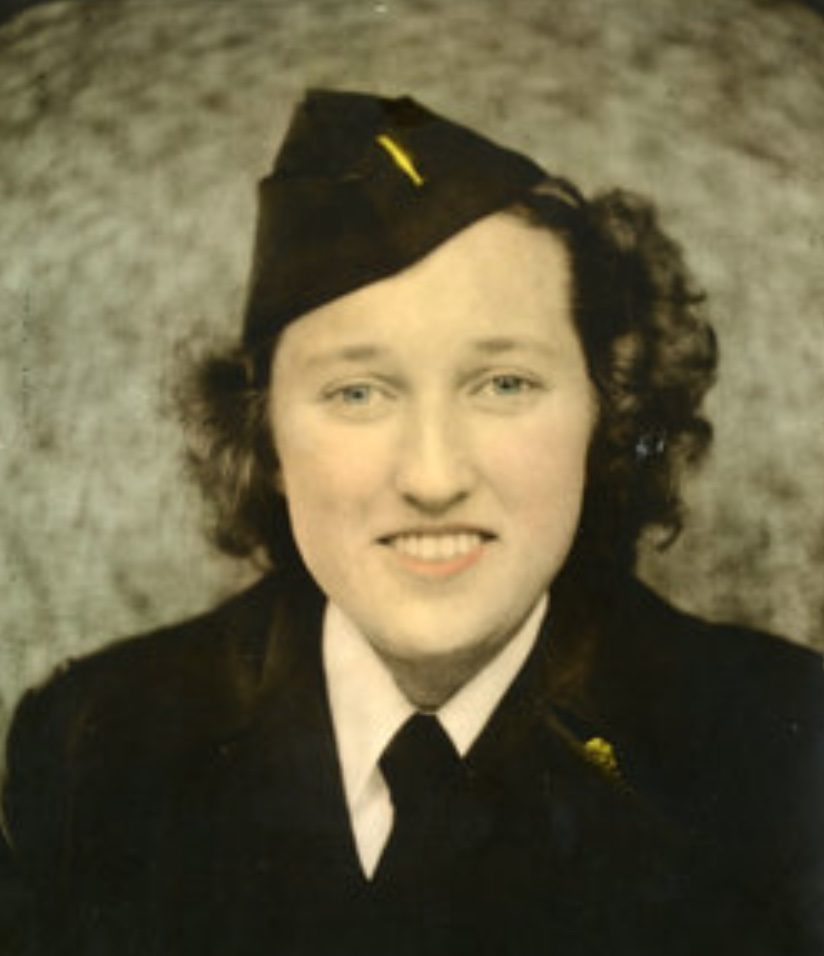
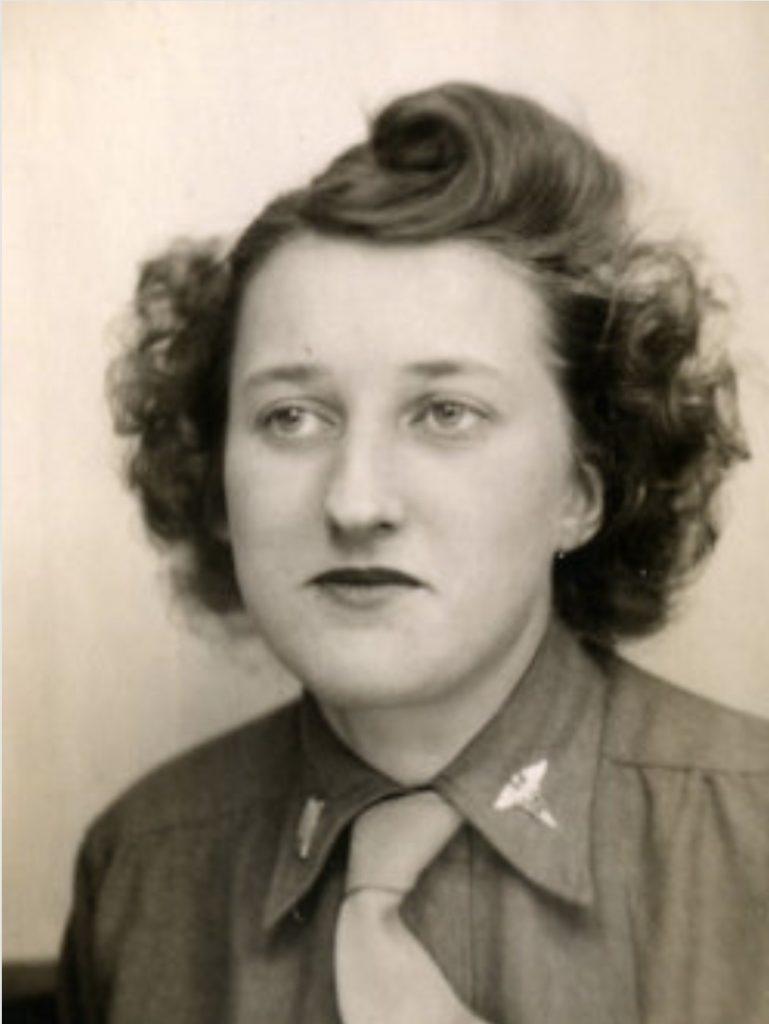
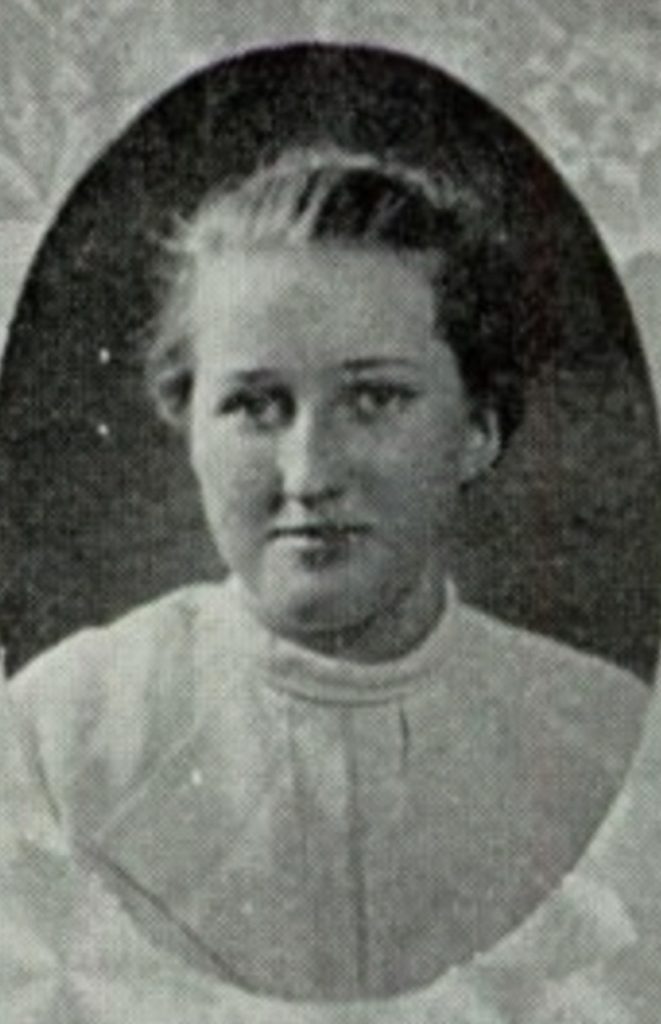
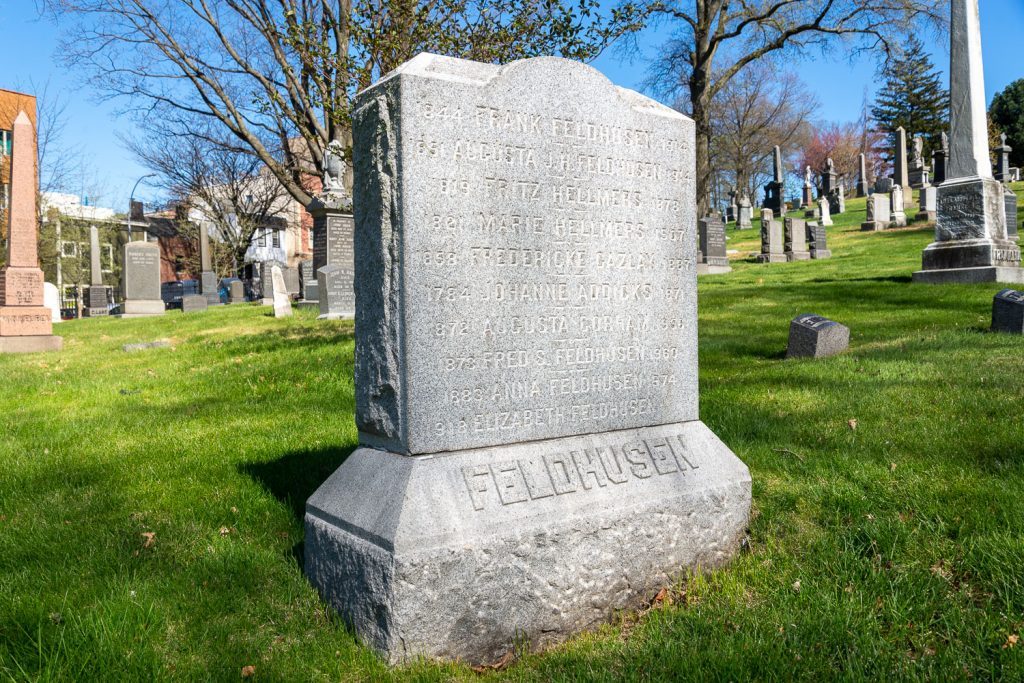
FINN, MICHAEL THOMAS (1913-1976). Sergeant, 14th Regiment, United States Army; New York State National Guard, 106th Regiment, Company G. He was born in Brooklyn to Michael Finn, a native New Yorker, and Anna Finn, who had immigrated from Ireland. The 1920 census shows that the Finn family lived at 396 Hamilton Lane in Brooklyn. The parents, Michael Finn, who worked as a busman at a saloon, and his wife Anna, were both thirty-three years of age. They had six children: their eldest was their son Joseph, who was fifteen and worked as an errand boy at a sugar company, daughters Veronica and Agnes who were thirteen and eleven, Michael who was six years old, John three, and Howard who was one year old. The Finns also had their eighteen-year-old niece Mary Driscoll, a labeler at a paint factory, living with them at the time. Michael was further described as white, attending school, and being able to read and write.
In 1925, according to the New York State census, the Finn family moved to a home at 1516 10th Avenue in Brooklyn. Michael’s parents were now thirty-eight years old. His father worked as a produce peddler and his mother Anna did housework. These records differ from the previous ones in listing Anna as a United States citizen. Their son Joseph, who was now twenty, worked as a chauffeur, Veronica, eighteen, was a telephone operator, and Agnes, sixteen, worked as a cashier. Michael, aged eleven and his younger brother John, aged eight, attended school. Howard was now six years old and the Finns now had a seventh child, a daughter by the name of Dorothy who was four years old.
By the 1930 census, the Finn family had moved again. Except for Veronica, Michael and the rest of his siblings lived with their parents, now at 420 16th Street in Brooklyn, where they owned their home. Michael was seventeen years old and worked as an office boy. His father, now forty-three, continued to work as a produce merchant at a fruit market, his brother Joseph, twenty-five, was a chauffeur at a battery company, and his sister Agnes, twenty-one, was a shirt ironer at a laundry business.
Just a few years later in 1933, at the age of nineteen, Michael enlisted in the National Guard, 106th Infantry, Company G. Finn’s service card shows that at the time his home address was still 420 16th Street in Brooklyn and that, until at least March of 1937, he served with the National Guard until he was reassigned as reservist.
On the May 29, 1937, Finn married Catherine McCabe, twenty-five, who was originally from Scotland. The 1940 census records show that the couple lived in a rented home at 427 16th Street in Brooklyn. Finn, who was now twenty-six years old, was a high school graduate who worked forty-two hours a week as a clerk at an insurance company and had an annual income of $1,800.
In the fall of that same year, Finn enlisted for service. His World War II draft registration card describes him as twenty-seven years old, 5′ 7″ inches tall and at 160 pounds. He had a light complexion, blue eyes and brown hair. The document indicates that he was an employee of Equitable Life Insurance Company at 393 Seventh Avenue in New York City and his wife Catherine was listed as his next of kin. He served as a sergeant in the 14th Regiment of the United States Army. Finn and his wife had one son Thomas, born in 1944. At the time of his death, Finn was survived by his wife (who died in 1999) and his son (who died in 2008). Section N, lot 43277, grave 1.
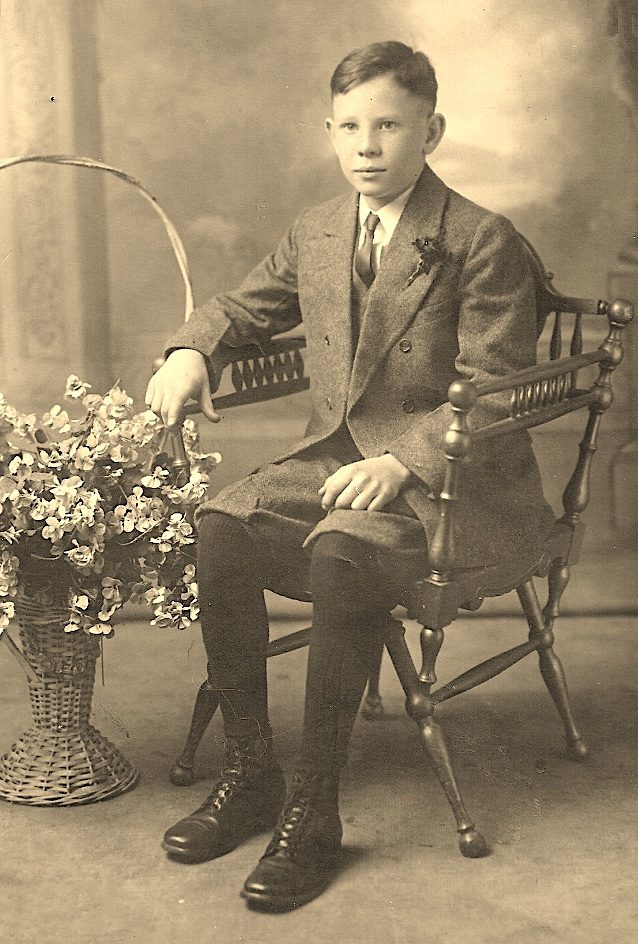
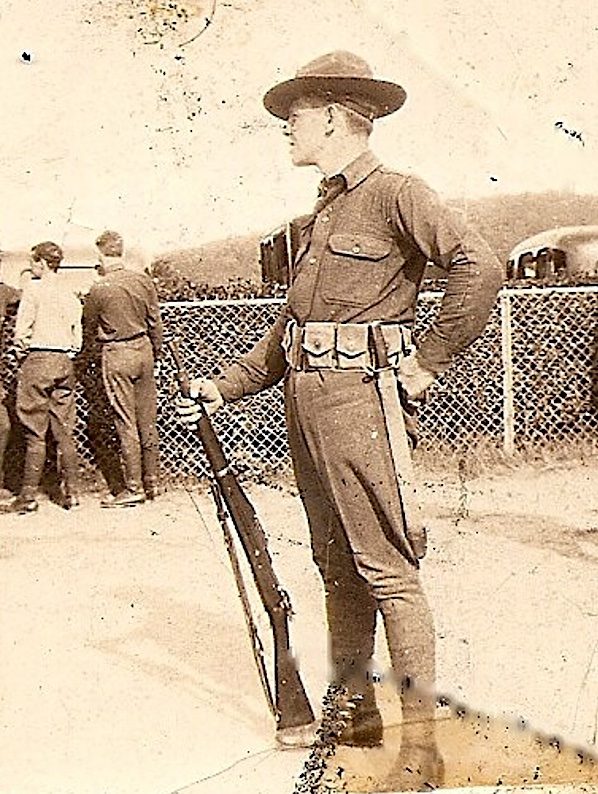
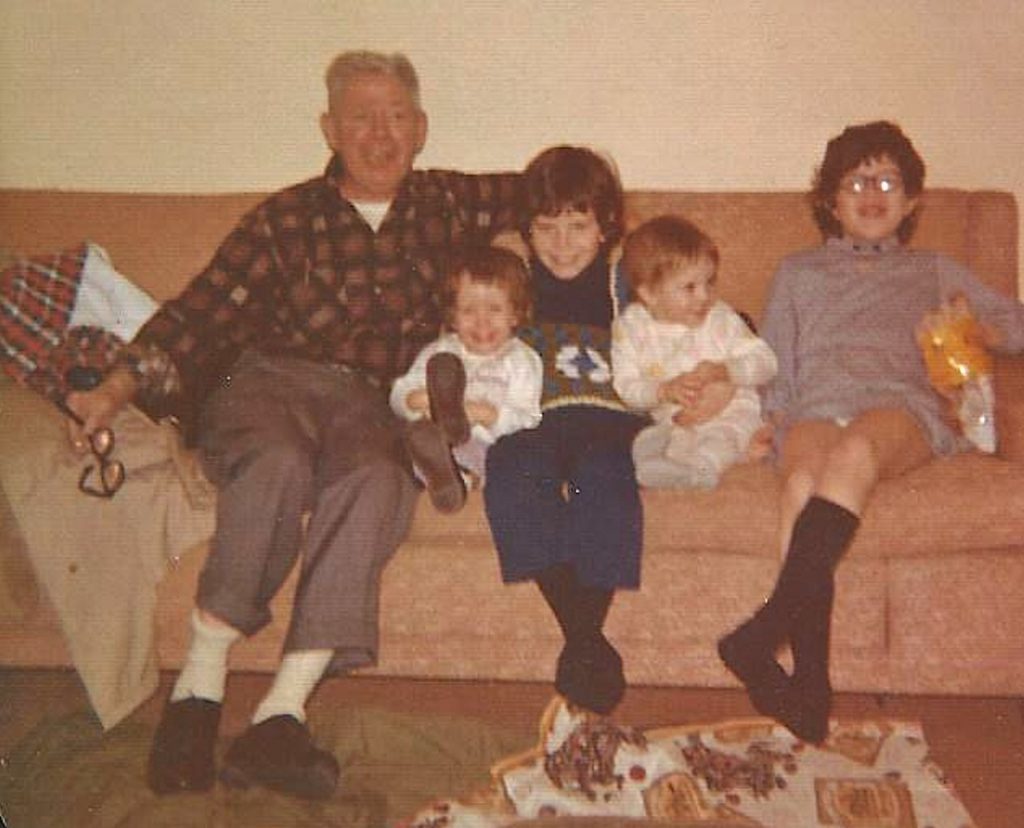

FIQUET, CLAUDE JACQUE (1926-2015) Seaman first class, United States Navy. Born in Hackensack, New Jersey, Fiquet was the second child of Juliette Fiquet and George Fiquet, French immigrants who moved to New Jersey in 1922 and 1923, respectively. According to the 1930 census, his mother was a building superintendent and his father was a salesman in the garment industry; the 1940 census lists his father’s occupation as baker, working 48 hours a week. Fiquet had an older brother Lionel, and two younger brothers, Jacque and Bernard (as per the 1940 census).
At the age of four, Fiquet was living with his family in the Bronx on Woodycrest Avenue, Block H # 1200 (1930 census). He was 14 years old when they lived in Brooklyn, and at the time had completed 6th grade in elementary school, as per the 1940 census. At the age of 20, Fiquet was described on his World War II draft card as being 6 feet tall, white, with hazel eyes and blond hair.
Claude Jacque Fiquet served as a second class seaman and then first class seaman from May 26, 1944 through October 26, 1945 on the tank landing ship LST-1023. He was discharged on May 12,1946, at the age of 20 as per his registration card; that same document listed his residential address as 339 19th Street in Brooklyn.
As per his daughter, Fiquet married Josephine (née D’Amelio) on April 26, 1953. From 1993 to 1998, they lived on 1241 East 32nd Street, Brooklyn. Fiquet was 89 when he died. His obituary in the Daily News states he worked as a UPS Master Mechanic for 30 years, after which he spent his retirement with his “longtime friend and sweetheart, Rose.” He was survived by his brother Lionel, his five children Giorgina, Michael, Virginia, Juliette, and Rocco, his grandchildren John Patrick, Jacqueline, Christopher, Sara, Justin, Taylor, Brianna, Christopher, Marcus, and Sebastian, and his great-grandchild Scarlett. His funeral mass was held at St Athanasius Church in Brooklyn. Section 176, lot 44603, grave 70.
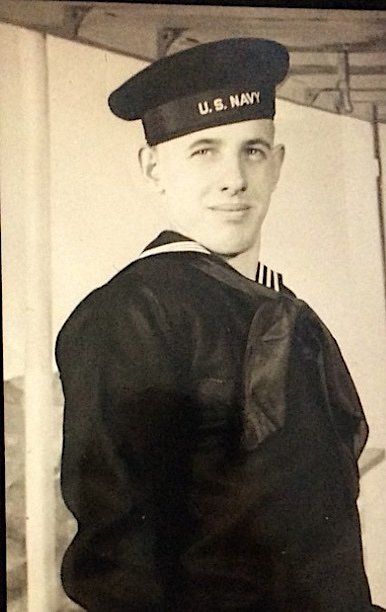
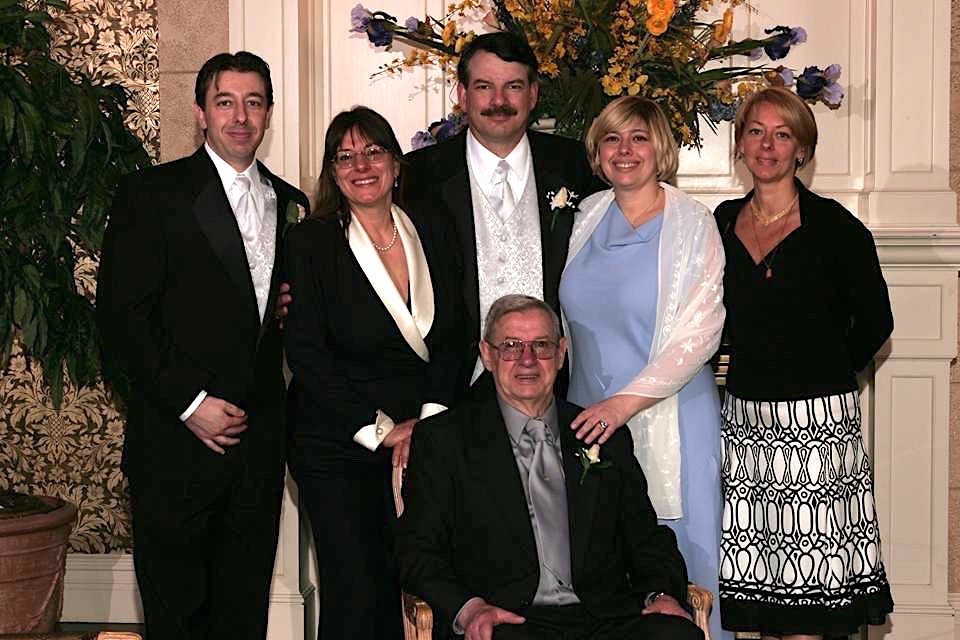
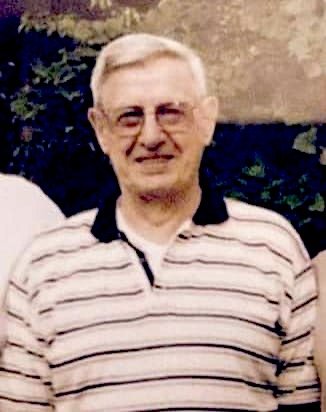
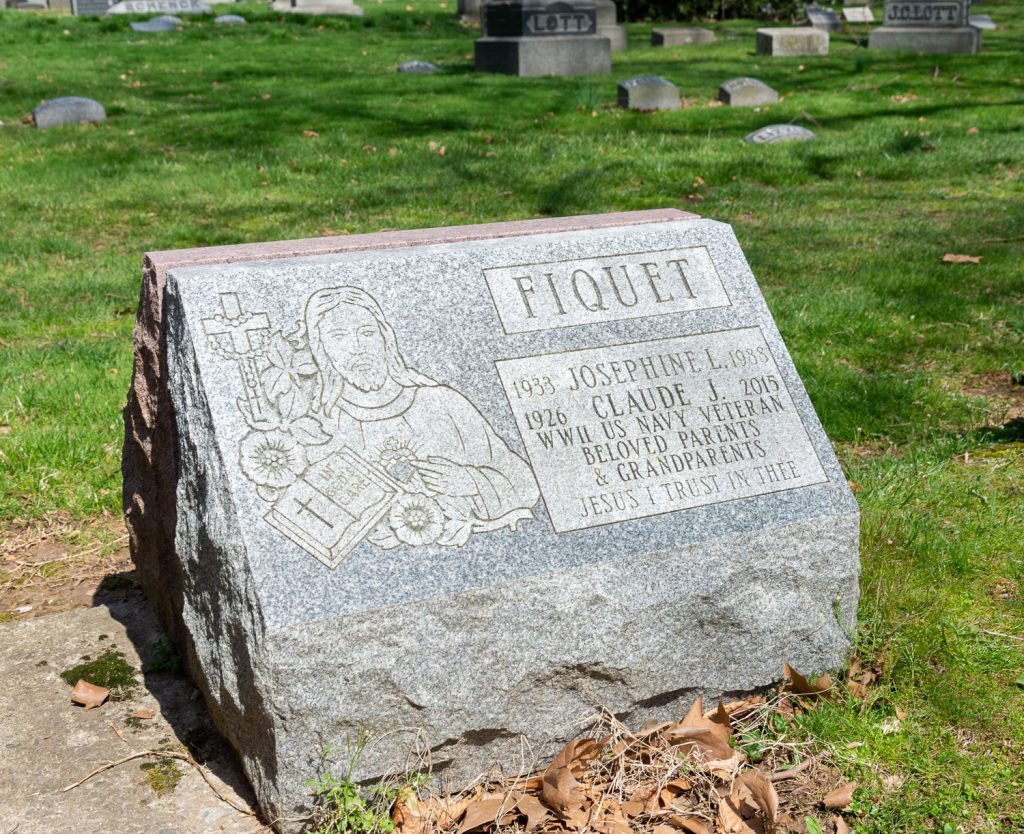
FISHEL, HENRY DETLEV (1925-2016). Private, United States Army, unit unknown. As noted by his daughter, Fishel served in the Army. He may be the Henry Fishel who, according to the National Archives Website, was born in 1925 in either Danzig (Gdansk, Poland) or Germany. As per this World War II Army enlistment record, Fishel lived in Kings County, New York, and enlisted on March 15, 1944, at Camp Upton in Yaphank, New York (on Long Island, in Suffolk County). His grade designation was private with no branch assignment. The enlistment record also notes that he was not yet a citizen, had completed four years of high school, and was single, without dependents. The record’s term of enlistment states: “Enlistment for the duration of the War or other emergency, plus six months, subject to the discretion of the President or otherwise according to law.” Section 31, lot 44902, grave 80.
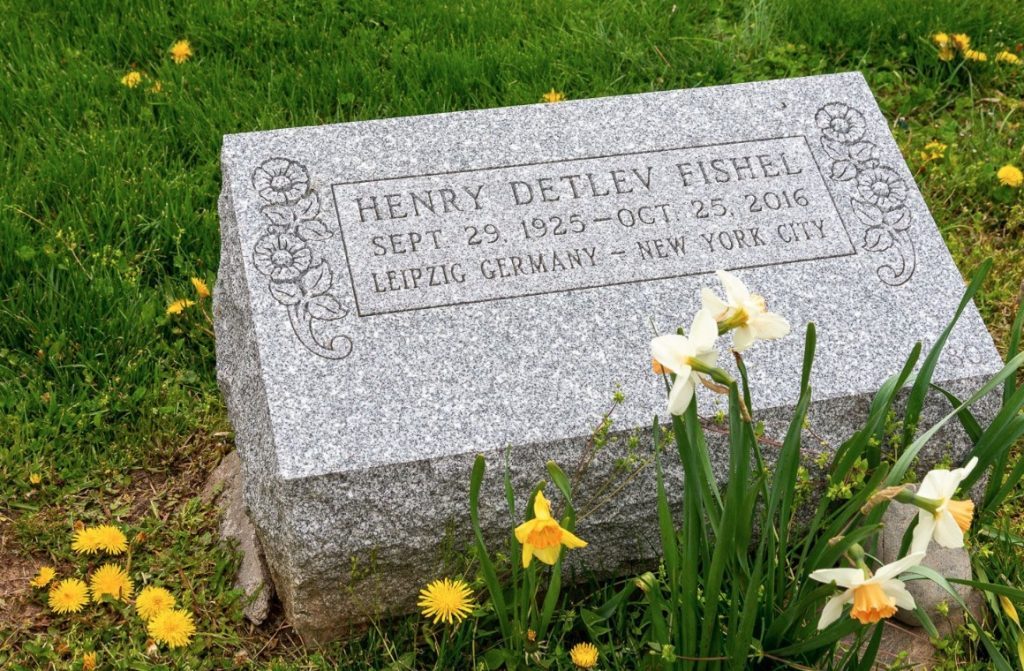
FLEMING, JAMES FRANCIS (1916-1995). Tech 5, United States Army. Fleming was born on Staten Island to parents Denis J. Fleming and Mary Agnes Fleming (née Murphy). His father was an Irish immigrant who, according to the 1930 census, had found enough success as a mason in a construction firm to own their home. Mary and Denis raised five children, Catherine, the eldest, James, and his younger siblings Denis, Margaret, and John.
By the census of 1940, the household had expanded to include James’s maternal grandmother, and James was listed as working as a mason, like his father. That year, when he was 24 years old, he registered for the draft, and less than a 12 months later he enlisted in the United States Army and served until his discharge in September 24, 1945.
The details of his service are vague. His designation as a Tech 5 indicates that he had skills that the Army needed, and while this level would have corresponded to the rank of corporal, in the tech wing it was without higher rank but not responsibility. Further details of his service are unknown.
Fleming married Marie H. Osgood on January 16, 1946, according to their marriage license, and together they raised three children, James Jr., Gary, and Donna. Like his father, James Jr. answered the call to duty and served as a major in the United States Air Force in Vietnam.
According to his death record from Ohio, Fleming had two years of college education and had continued to work as a stone mason following his return from the war. He was brought back to Brooklyn and reunited with his wife at Green-Wood Cemetery. Section 60, lot 1033, grave R.
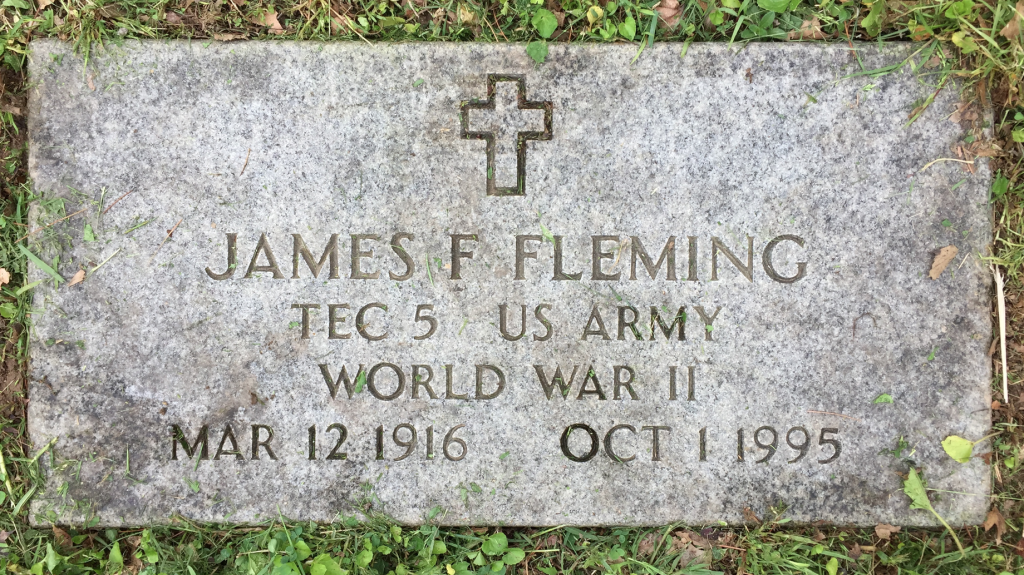
FLYNN, JEROME PATRICK (1915–1997). First sergeant, 29th Infantry Division, United States Army. Referred to as the “Mayor of 16th Street” in his obituary from the New York Daily News, Jerome Flynn was first recorded as living at 360 16th Street in the 1920 census when he was four years old. His parents, Mary and Patrick, were both immigrants from Ireland. At the time of that census, Patrick owned the home the family occupied, and in addition to Jerome and his older brothers Francis and Dennis, maternal aunt and uncle Francis and Anna lived there as well. Unfortunately, Patrick died when Jerome was in his eighth year, but the family stayed in the home, letting out rooms to two cousins and several boarders, according to the New York State census of 1925.
Jerome was a top student during his four years in high school, and graduated cum laude from St. John’s University. After graduation he took a position as a bookkeeper in the banking sector, and was working for the Guaranty Trust Company, as per his draft registration papers. Like the house he had grown up in, Flynn would return to this career after the war.
When he enlisted in the United States Army as a private on October 29, 1942, it was noted that he was single with dependents. His enlistment was coded such that he was contracted to serve for the duration of the war, and indeed he did, first in Europe and when the war ended there, in the Philippines and Japan. At the end of the war in the European Theater, a bookkeeping system was put in place whereby soldiers were sent home based on dependents, medals for combat achievements, and other factors.
Before shipping out to Europe, Flynn had married Annabel Midbto, a daughter of Swedish immigrants, on the June 13, 1943, in Virginia, where the 29th Division was based. According to the 29th Division’s official website, “in eleven months of nearly continuous combat from D-Day to the Elbe, the 29th Division had participated in seven major offensives, gaining a reputation as one of the U.S. Army’s finest outfits in World War II.” As noted, instead of heading home after the division pushed into Germany and saw the war in Europe end, he was sent to the Pacific and fought in the Philippines Liberation Campaign. For his service he was awarded the American Campaign Medal, the Asiatic–Pacific Campaign Medal, the European-African-Middle Eastern Campaign Medal, the Good Conduct Medal, and the Philippine Liberation Medal, as well as the World War II Victory Medal.
Returning to his family home in Brooklyn, he raised a family there with his wife Annabel, together sharing the lives of their six children, Thomas, Margaret, Dennis, Anne, Peter, and John, as well as their five grandchildren, Alyson, Sereane, Kathleen, Flynn, and Damon. Section 26, lot 44610.
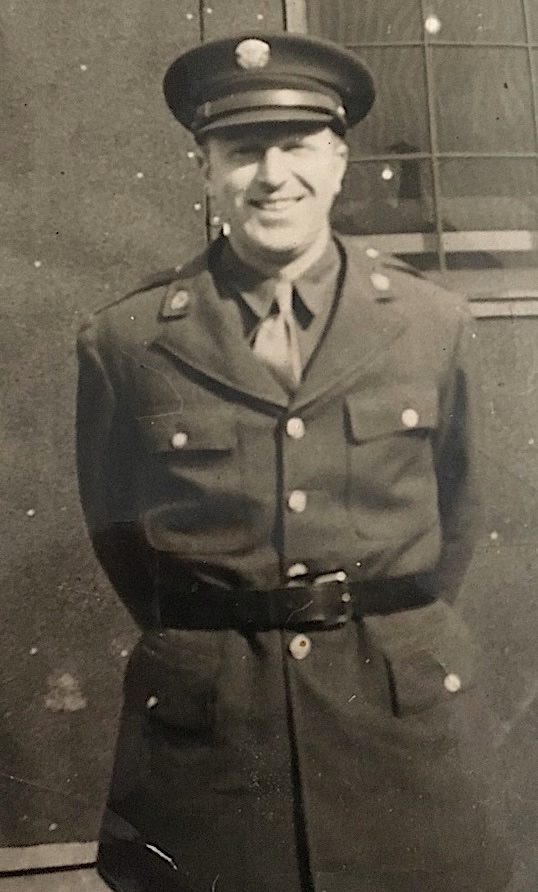
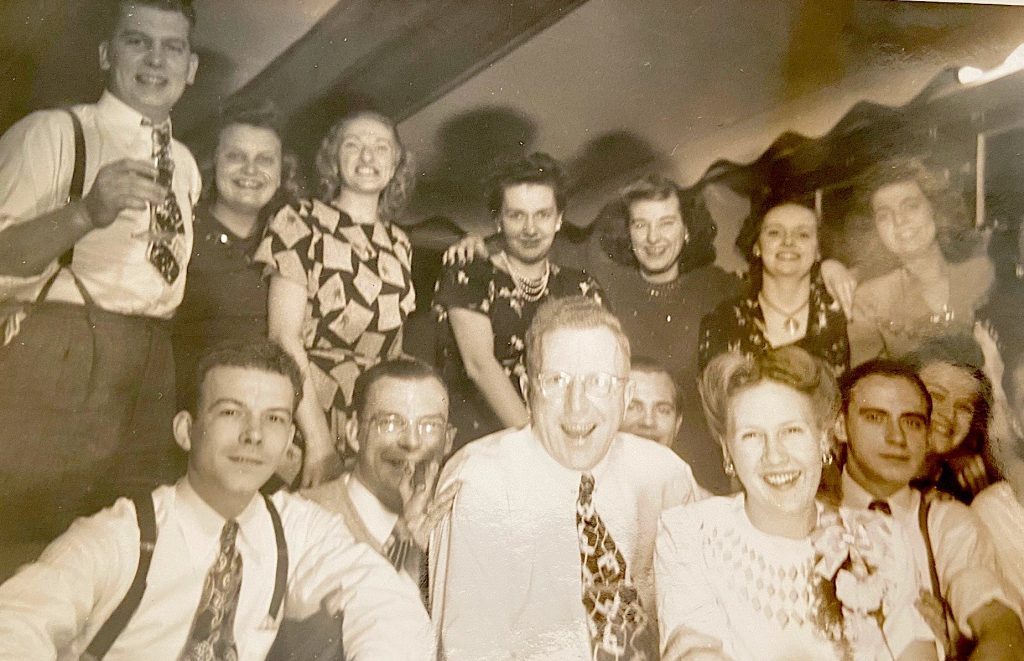
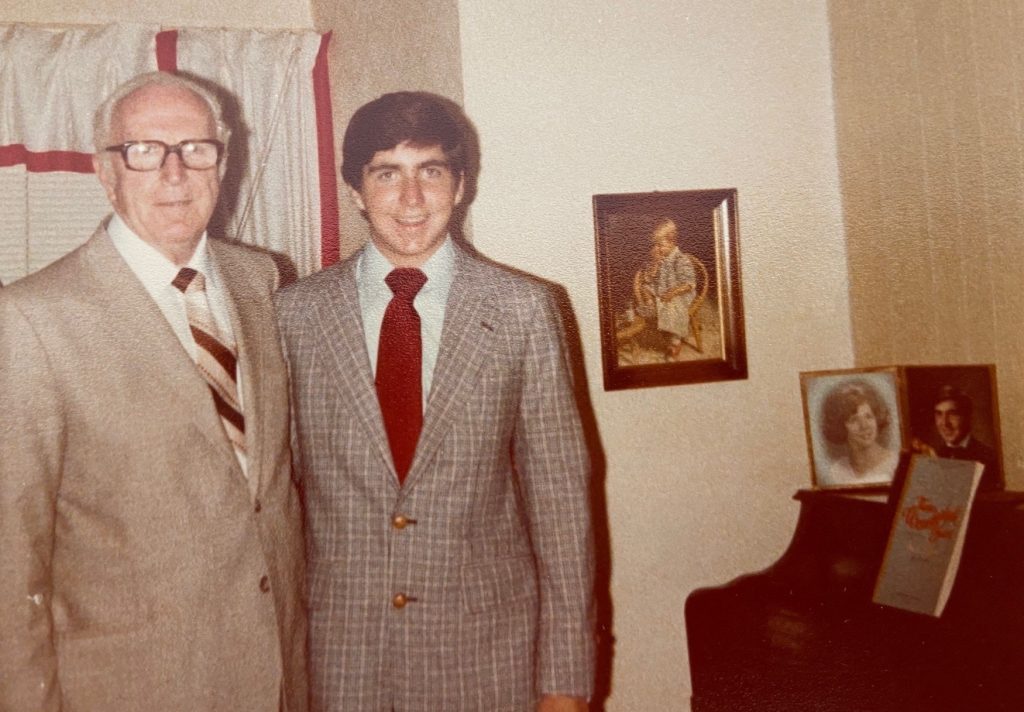
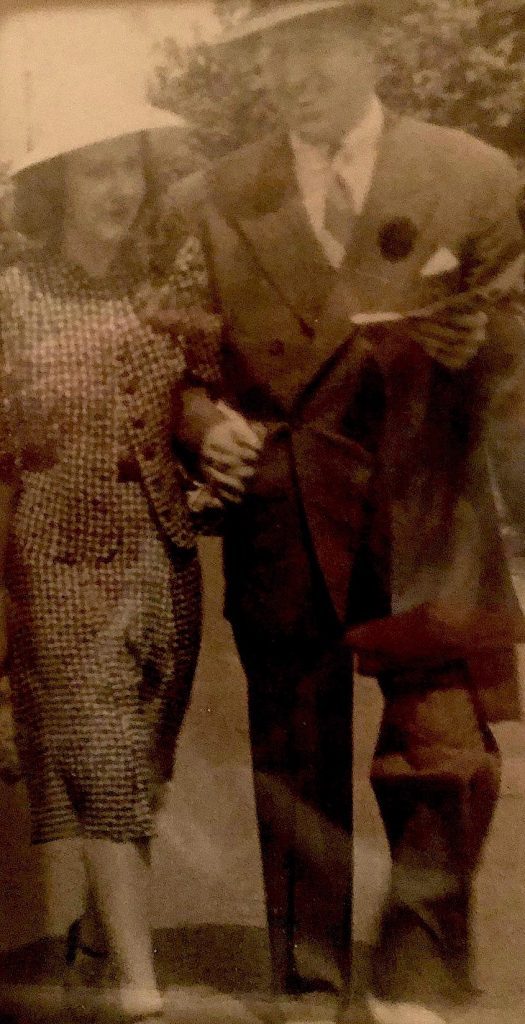
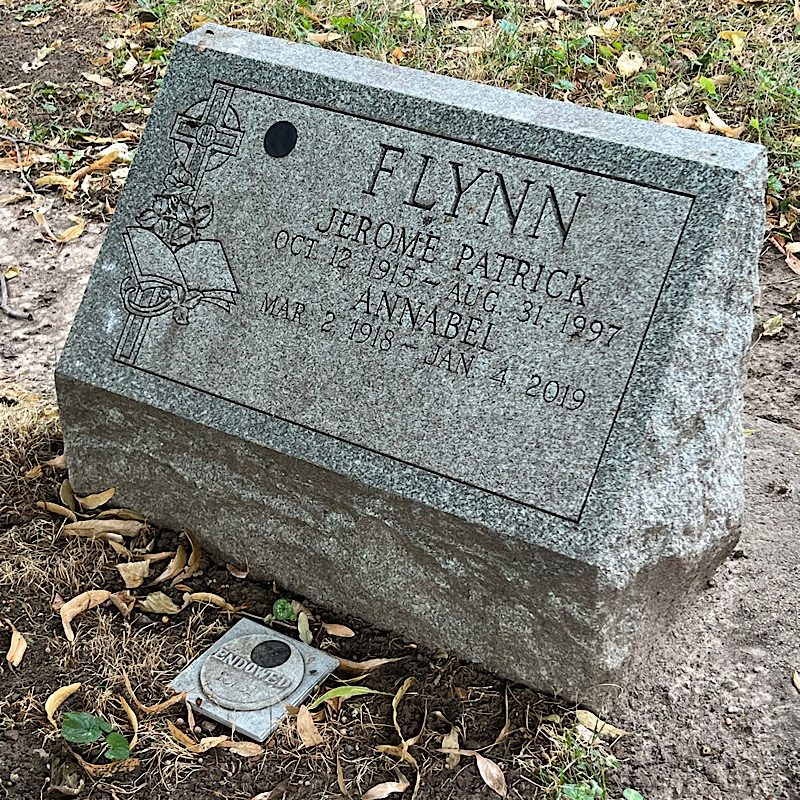
FONTANA, DOMINICK SALVATORE (1916-2003). Corporal, 351st Infantry Regiment, Company A, 88th Division, United States Army. Fontana was born in Calabria, Italy, to Grace Marra and Vincent Fontana. Dominick was the sixth child of eight siblings. Before Dominick’s birth, his parents, who already had three children, traveled to the United States and lived with Vincent’s brother in Brooklyn. In 1910, Grace gave birth to a son, Vincent Jr., in New York. The following year, a daughter, Angela, was also born in New York, but died in infancy. At some point following Dominick’s birth in 1916, the Fontana family moved permanently to the United States. Dominick attended elementary school in Italy and then completed the 8th grade in New York.
At the time of the 1930 census, the Fontana family was living at 540 Hicks Street in Cobble Hill, Brooklyn, and they rented their house for $26 a month. Vincent Sr. worked as a longshoreman and had submitted his first papers to become a citizen of the United States. Grace cared for the children and their home. Although neither of Dominick’s parents attended school in the United States, they were able to read, write, and speak English. Dominick’s older brother Vincent Jr. and his two younger siblings, Anna and Joseph, also lived with them. Vincent Jr. worked as a butcher. By 1930, Dominick’s two older siblings, Anthony and Josephine, were married and lived with their families at a different address. According to the SS Conte Grande passenger ship’s records, in the summer of 1931, Dominick’s mother took him and his two younger siblings to visit their other older sister, Teresina, who was living in Italy.
According to the 1940 census, the Fontana family had moved down the block to 571 Hicks Street and rented their new home for $16 a month. By that point, Vincent Sr. had been naturalized, but did not seem to be employed. Grace continued to run the household.
It appears that Dominick and some of his brothers founded a butcher’s shop called Fontana Bros., in 1937, at 132 Kane Street, corner of Cheever Place, in Brooklyn. In 1940, Dominick worked as a butcher and earned $2,200 annually. His brother, Joseph, was also employed as a butcher, earning $700 a year. Anna worked as a packer for a date factory and earned $600 annually.
In October 1940, at the age of 24, Fontana registered for the United States military draft. His draft registration card lists his employer as Fontana Bros. and his father is listed as the person who will always know his address. Dominick is recorded as 5′ 4″ tall, weighing 125 pounds, having blue eyes, brown hair, and a light complexion. Two months later, Dominick married Concetta Senatore, who went by Connie. He changed his address on the draft registration card to 28 Tompkins Avenue, Brooklyn, where he presumably had moved with Connie. His mother, as per death records, died soon after, in 1940.
In 1942, Dominick enlisted to the United States Army at Fort Jay on Governors Island. While there are no existing records of the details of his service, according to his daughter Amelia he served in the 351st Infantry Regiment, Company A, part of the 88th Infantry Division. Fontana took part in the Naples, Foggia, North Apennines Po Valley, North Africa Casablanca, Anzio, and Casino battles and campaigns, as per his daughter. His military honors include the American Service Medal and the European-African-Middle Eastern Service Medal. Fontana had three brothers-in-law in WWII service while he was active in the military.
After his discharge, Fontana continued to run his butcher shop and lived above the shop with his wife Connie. Around 1959, he bought the building. Next door, Connie opened a store selling candles and jewelry. The couple retired in 1992, passing the businesses on to their granddaughter, Denise Taormina, who combined the two storefronts into a popular antique shop called Little Luna Vintage Goods. In 2012, the buildings were renovated. Section 10, lot 44063.
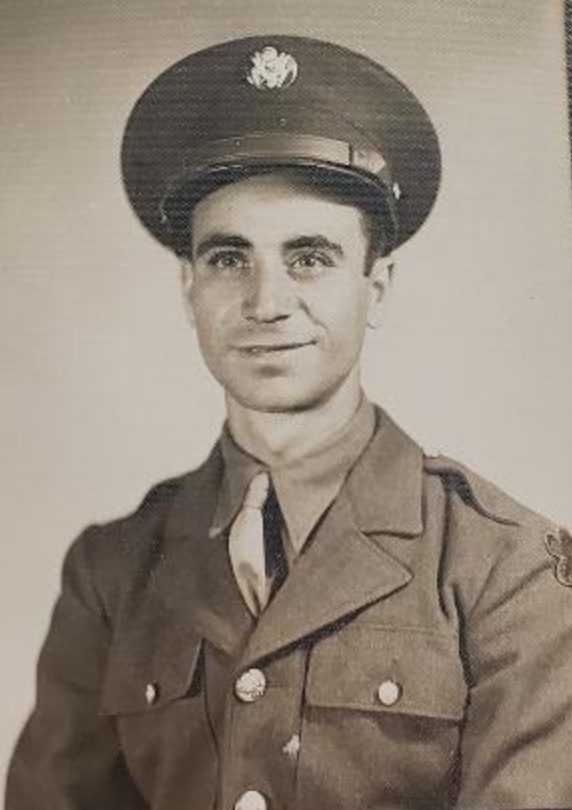
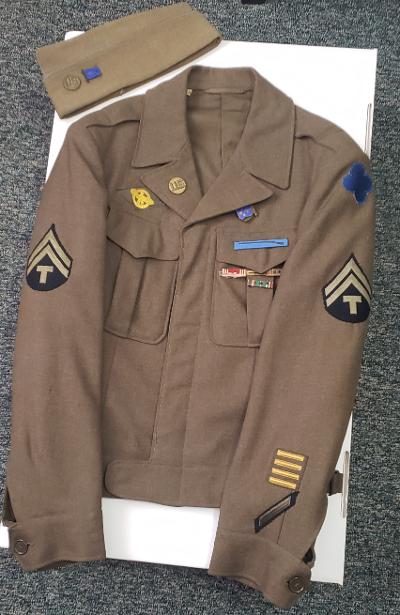
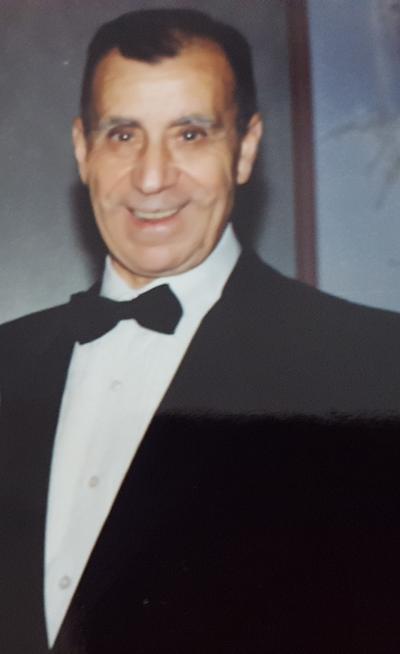
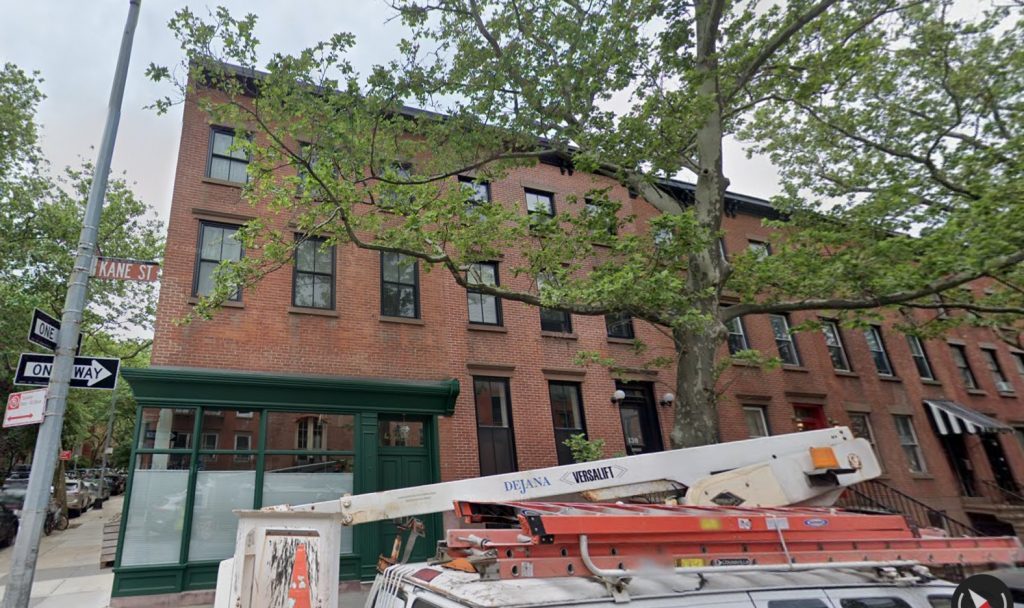
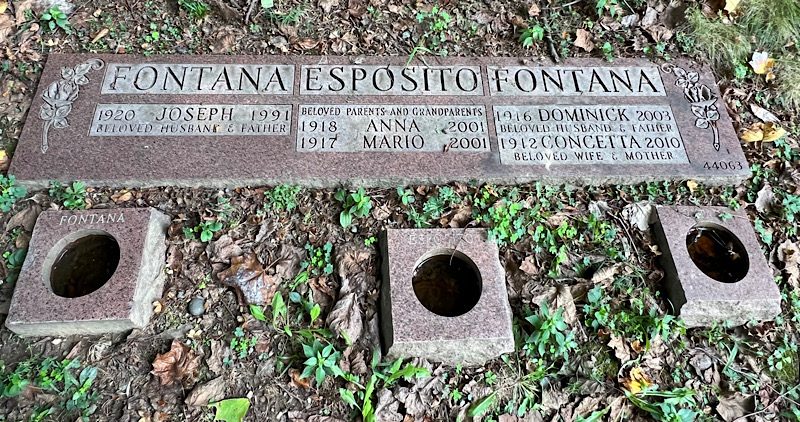
FRANKEL, FLOYD EVERETT (1913-1976). Private first class, United States Army. Frankel was born in Brooklyn to Swedish immigrants Anna Carlson and Carl Albin Frankel. According to 1910 census records, his parents immigrated to the United States in 1904 and 1902, respectively, and his father worked as a machinist. His mother could read and write English and was a housewife. His father spoke English, was able to read and write, and was a naturalized citizen. Floyd had two older brothers, Herbert and George, and the family lived at 5317 7th Avenue in Sunset Park, Brooklyn from 1910 to 1925. Anna’s brother, John, lived with the Frankels. Floyd attended elementary school at P.S. 104 through the 8th grade and graduated from there in 1928. According to the 1930 census, the Frankels owned their home, which was valued at $12,000, at 642 84th Street in Brooklyn. Carl Frankel died in 1934.
In his early 20s, Frankel played recreational tennis and according to the Brooklyn Times Union, he made it to the fourth round of the Long Island Centre Championship in 1934. He continued playing tennis for several years and in 1940 participated in a citywide singles tournament at McKinley Park in Brooklyn.
At the time of the 1940 census, Frankel was employed as a machine operator and living with his widowed mother and his brother George. The census record notes Frankel didn’t attend high school or college after graduating from 8th grade. In 1940, at the age of 27, Frankel registered to be drafted into the United States military. His draft registration card lists his employer’s name as Loose Wiles Biscuit Co. and his mother is listed as the person who will always know his address. Frankel reported he was 6′ 3″ tall, 180 pounds, with brown hair, blue eyes, and a light complexion.
Frankel married Angelina Lucante in 1942 and moved into her family’s house at 1348 78th Street in Bay Ridge. Only four months later he enlisted to the United States Army. While the details of his service are not known, according to his niece he served in the 903rd Training Group at Fort Jay on Governors Island. Discharged the following year, in 1943, he appears to have lived the rest of his life with his wife in Brooklyn. She died in 2002; they are interred together. Section R, lot 42537.
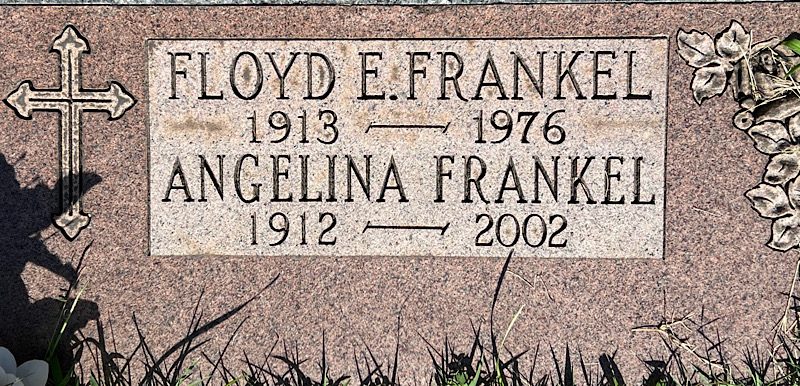
FRY, VARIAN MACKEY (1907-1967). Journalist, author, and humanitarian, Varian Fry is credited with helping 2,000-4,000 refugees escape the Nazis during World War II. Fry was born in New York City. His parents were Lilian Mackey and Arthur Fry, who managed the Wall Street firm of Carlysle and Mellick.
Varian Fry’s paternal grandfather, Charles Reuben Fry, worked for the Children’s Aid Society of New York and was active in the welfare program that transported children from crowded eastern cities of the United States to foster homes largely in the rural Midwest. About 250,000 children were relocated from 1854 to 1929, according to The Orphan Trains, a book written by Varian Fry’s second wife, Annette Riley Fry, published in 1994.
The Fry family moved to Ridgewood, New Jersey in 1910, where Fry grew up. When he was nine years old, Fry and his friends led a fund-raising bazaar for the American Red Cross that included a vaudeville show, an ice cream stand, and fishpond.
Fry was educated at The Hotchkiss School from 1922 to 1924 and graduated from Riverdale Country School in 1926. He attended Harvard University where he founded “Hound & Horn” with Lincoln Kirstein. He graduated in 1931 with a degree in classics, per the Holocaust Encyclopedia. According to the Andy Marino’s book A Quiet American: The Secret War of Varian Fry, it was through Kirstein’s sister that he met his future wife, Eileen Avery Hughes, an editor of Atlantic Monthly, who was seven years his senior and had been educated at Cheltenham College and Oxford University. They married on June 2, 1931.
According to the Holocaust Encyclopedia, Fry worked as a researcher and editor at several magazines in the early 1930s, during which time he traveled to Nazi Germany to report on the country under Hitler’s rule. He witnessed an anti-Jewish riot in Berlin on July 15, 1935, and wrote several dispatches that were published in the New York Times, describing what he had seen:
I saw one (Jewish) man brutally kicked and spat upon as he lay on the sidewalk, a woman bleeding, a man whose head was covered with blood, hysterical women crying. . . Nowhere did the police seem to make any effort whatever to save the victims from this brutality.
Fry resigned as editor of the foreign policy magazine The Living Age, to work for the North American Committee to Aid Spanish Democracy but left in 1937 and began to write books for the Foreign Policy Association, including War in China, The Good Neighbors, Bricks Without Mortar, War Atlas, and The Peace that Failed. After Germany’s invasion of France, Fry helped gather more than 200 notable Americans for a meeting on June 25, 1940 to found the Emergency Rescue Committee (ERC), a private American relief organization, with the goal of rescuing endangered artists, writers, and intellectuals in France. The ERC vowed to aid anti-Nazi refugees, Jews and non-Jews alike, who would be targeted for arrest and worse by Nazi Germany.
Fry and others met with First Lady Eleanor Roosevelt to enlist her help; she used her influence to obtain “emergency” non-quota visas for a number of endangered intellectuals. Fry, with no relevant experience or training, volunteered to be the ERC’s representative in France who would guide the rescue efforts. Initially, he planned to be in southern France for three weeks. According to the Jewish Virtual Library, Fry’s mission was to aid anti-Nazi refugees who were in danger of arrest by the Gestapo, and he was given $3,000 (which he hid, taped to his body) and instructions to explore rescue possibilities for those on the list. He flew to Europe on August 4, 1940, and remained in France for 13 months, often under surveillance, and was, more than once, questioned, and detained. He established a French relief organization, The American Relief Center, and worked behind its cover using volunteers and illegal means – forged documents, black-market funds, and clandestine escape routes – to enable endangered refugees to leave France for safety. Fry and his small team helped at least 1,500 refugees escape from France to Spain and provided support to more than 2,000 others.
This is a short list of some of the cultural luminaries he helped rescue: artists Jean Arp, Marc Chagall, Marcel Duchamp, Jacques Lipchitz, and Wilfredo Lam; writers Hannah Arendt, André Breton, Arthur Koestler, Heinrich Mann, and Franz Werfel; musician Wanda Landowska; anthropologist Claude Lévi Strauss; scientists Jacques Hadamard, the “Einstein of France, and Noble Prize-winning biochemist Otto Meyerhof; film director Max Ophüls; and composer Alma Mahler Gropius Werfel.
On August 29, 1941, Fry was arrested by the French police and expelled from France. He was told that his expulsion had been ordered by the French Ministry of the Interior, “with the approval of the American embassy.” He spent more than a month in Lisbon before returning home to New York in October 1941. Neither the State Department (which had repeatedly attempted to thwart his rescue work) nor the ERC received Fry warmly upon his return because he had flouted policy and employed extralegal methods in his rescues.
Once he returned to the United States, Frey began work as the assistant editor of The Nation magazine. In December 1942, after information about the mass murder of Jews in Europe began reaching the United States, he wrote an article for The New Republic magazine titled “The Massacre of the Jews,” describing events he had witnessed.
Deemed unfit for military service, Fry spent most of World War II preparing his memoirs. He and his wife Eileen divorced after he returned from France, and she died on May 12, 1948. Fry married Annette Troth Riley, 16 years his junior, in 1950. They had three children but separated in 1966. After the war, Fry worked as a journalist, magazine editor, and business writer. He also was a film producer and taught in colleges. In the 1960s, he taught Latin, Greek, and French in secondary schools in Connecticut.
Shortly before Fry’s death, in 1967, he was made a Chevalier of the Légion d’honneur by the French government, France’s highest decoration of merit. Per the Holocaust Encyclopedia, this was the only official recognition Fry received in his lifetime. In 1991, the United States Holocaust Memorial Council recognized Fry’s heroism. In 1998, Fry was the first American to be honored as a Righteous Among the Nations by Israel’s Yad Vashem, the memorial to Holocaust victims in Jerusalem, an honor given to non-Jews who risked their lives to save Jews during the Holocaust. He is the subject of several books and documentary films about his humanitarian efforts.
Varian Fry died of a cerebral hemorrhage on September 13, 1967. He is interred with his parents, his paternal grandparents, his son Thomas Varian Fry, his first wife, Eileen Avery Hughes, and his second wife, Annette Troth Riley Fry.
As Roger Cohen reported in The New York Times of April 1, 2023, in reviewing “Transatlantic,” a Netflix series about Fry,
In 2019, James D. Fry, his son, wrote a letter to The New York Times stating that “My father was indeed a closeted homosexual.” He was responding to a New York Times review by Cynthia Ozick of the Orringer novel that said of Fry, “there is no evidence of homosexuality,” contrary to the novel’s portrayal of him.
Section 11, lot 28208.
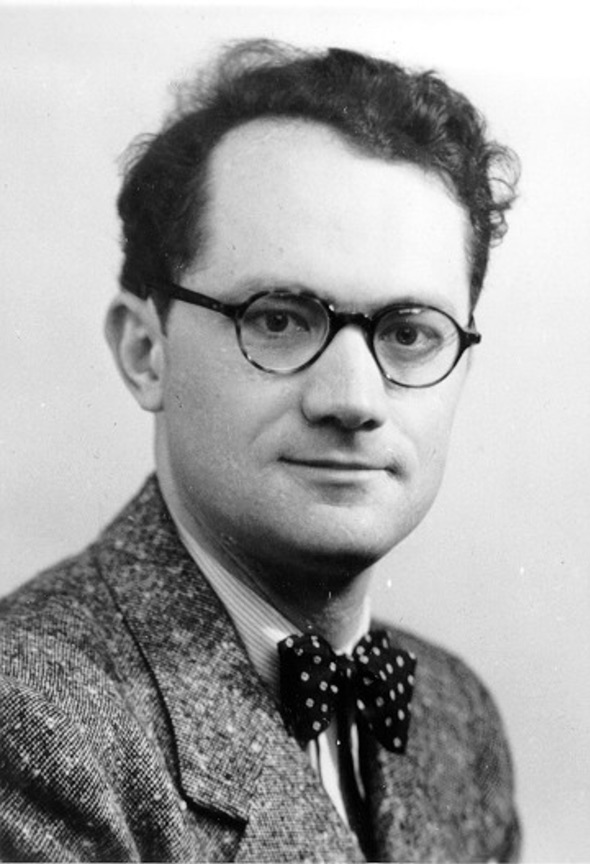
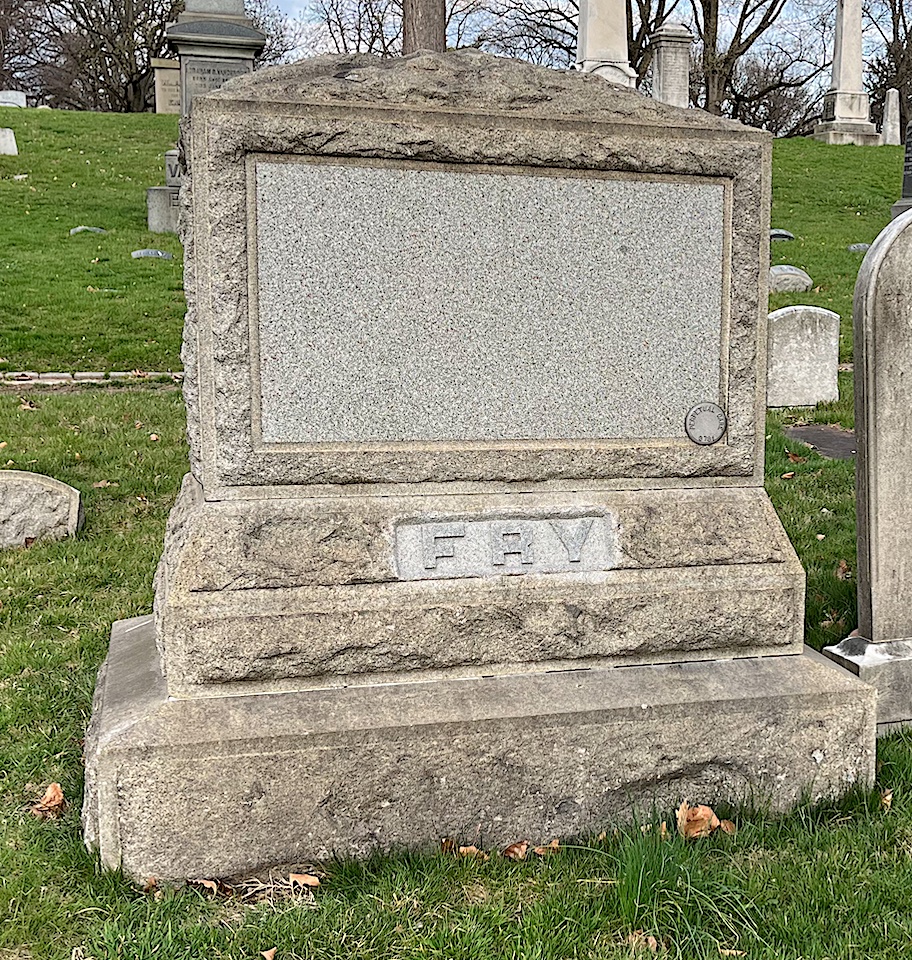
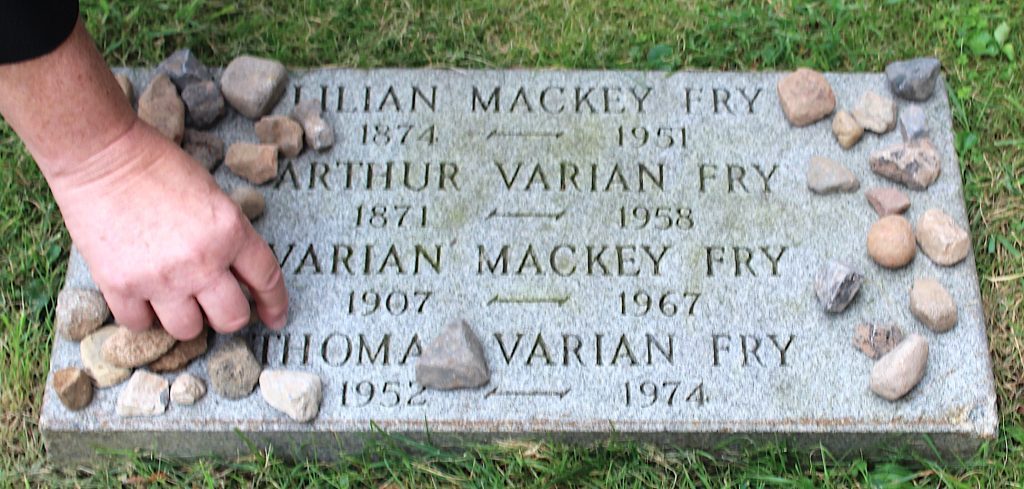
GALLI, HENRY (1925-2001). Seaman second class, United States Navy. Galli was born in Brooklyn. The 1930 federal census records that his parents, Henry and Mary, were born in Italy and his father was a laborer. The family lived on West 15th Street in Brooklyn. Galli had eight older siblings: Gus, Frank, Nancy, Helen, Joseph, Vincent, Rose and Fred. On three federal censuses, Galli’s father’s first name was documented as Americo (1920 census), Henry (1930 census), and Ararico (1940 census, transcribed as Maerica). As per the 1940 federal census, Galli resided on East 13th Street in Brooklyn with his parents and four siblings. He was a student and had completed his education through eighth grade. His father was a carpenter for the Works Projects Administration.
Galli’s World War II draft registration card cannot be located. However, the National Archives Database has records for a “Henry Matty Galli” with the same social security number and date of birth as Galli. The World War II Navy muster rolls document that Galli enlisted in the Navy on May 1, 1944 in New York. The August 30, 1944 World War II Navy Muster Rolls’ Report of Changes states that Galli was received for duty by the USS Iowa on August 19, 1944, and he received training from the Naval Training and Distribution Center at Camp Shoemaker in California. As per the muster roll for the crew of the USS Iowa, dated September 30, 1944, he boarded that ship on August 19, confirming the aforementioned report. The July 1, 1945 Navy muster roll of the crew for the USS Iowa records that Galli was still assigned to the ship. Galli’s nephew, Robert Galli, shared that his uncle also served on the USS Enterprise.
Both the USS Iowa and the USS Enterprise were warships of note during World War II. The USS Iowa was a lead ship (the first of a series of battleships all constructed according to the same general design) and the USS Enterprise participated in more major encounters in the war with Japan than any other American ship. Whether Galli served on either or both the USS Iowa or the USS Enterprise, he may have participated in the Okinawa Campaign, as both warships took part in that campaign during Galli’s recorded service time. The Naval History and Heritage Command from the National Museum of the United States Navy describes the Okinawa Campaign as follows:
Under heavy naval gunfire and aircraft support on April 1, 1945, U.S. Forces invaded Okinawa, Japan. This landing had the codename of “Operation Iceberg” and was the last major amphibious assault of World War. II. To Japan, the islands were the barrier to a direct invasion of its homeland. To the Allies, once the island was under their control, it would clear the path for the final invasion of Japan…The U.S. Navy lost 32 ships and craft, mostly by kamikaze attacks, and 368 ships and craft were damaged. Seven hundred and sixty-three aircraft were lost with over 4,900 sailors killed or missing in action, with an additional 4,824 being wounded. Okinawa was declared secure on June 21.
As per the WW II Navy muster rolls, dated January 1, 1946, Galli held the rank of seaman 2nd class. The January 1, 1946 Recapitulation Sheet denotes a J1 change of status, indicating a transfer. Little is known of Galli’s life after his service. The New York Marriage License Indexes record that Galli married Mary Spagnola in 1957. According to the United States Public Records Index from 1992, his address was 1779 81st Street in Brooklyn. Section N, lot 43350, grave 117.
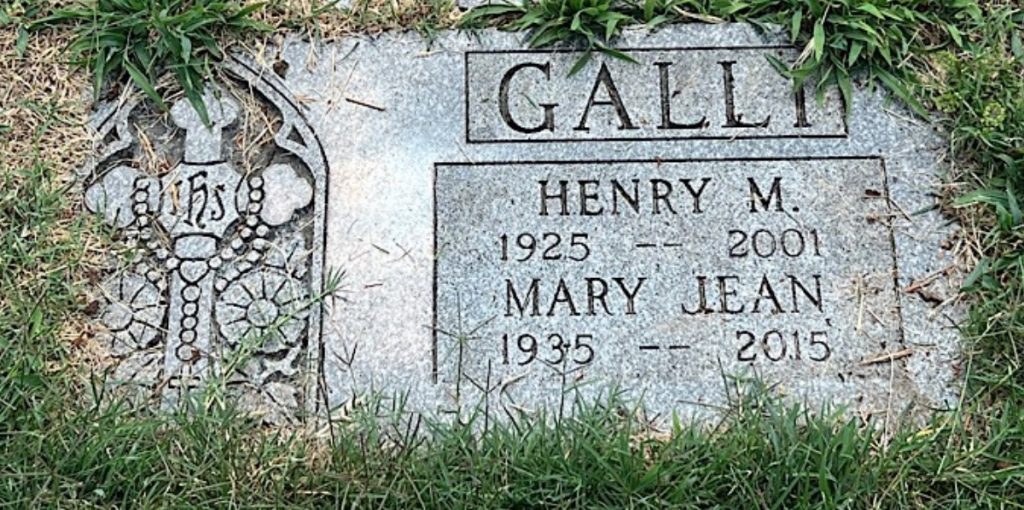
GAMBARDELLA (or GAMBERDELLA), THOMAS (1921-1998). Private first class, 8th Army Field Artillery Battalion, Battery C, United States Army. Thomas Gambardella was born to Italian immigrants Antonio and Annie. Thomas was the couple’s seventh child. According to the 1925 New York State census, Thomas’s family, which by then also included a younger brother named Demenzio, lived in Brooklyn and his father, Antonio, worked at a grocery store. In 1930, the federal census reports that the family was living on Henry Street in Brooklyn and had added a ninth child, three year old Gabriello. At this time, Antonio was still working for a local food business, as the shopkeeper at a fruit store, and Thomas was attending elementary school.
By the time of the 1940 census, the Gambardella family was living at 217 Union Street in Carroll Gardens. Antonio now worked as a laborer on a steamship. Thomas no longer attended school and it appears that he was no longer living at home. Census records offer conflicting information about whether Thomas left school in 5th grade or 7th grade, but his highest level of education was elementary school.
In April 1939, Thomas, and two other teenagers, were arrested for planning a robbery of the Warwick Theater on Fulton Street. According to The Brooklyn Daily Eagle, each teen possessed a loaded gun. Thomas and the others were each charged with possession of a loaded revolver in violation of New York’s Sullivan law. This law, passed in 1911, made it a felony to carry a concealed firearm in public without a license. It appears that Thomas’s case was resolved with him being sent to reformatory school. The May 1940 census lists Thomas as attending the New Hampton Farms Reformatory School located in Goshen Town in Orange County, New York. The reformatory school where Thomas was sent was known as a “prison without walls” and boys spent their time working to sustain the compound, scrubbing the floors and working on the farm. The school was almost self-sufficient with its own dairy and animal farm, orchard, vegetable gardens, bakery, laundry, and kitchen. Later on, recreational facilities such as a swimming pool, bowling alley, card room, baseball and handball fields, and a movie house were added too.
By March 1941, Thomas was back living in Brooklyn with his family and, at the age of 20, he registered to be drafted into the United States military. His draft registration card lists that he was unemployed and his mother is listed as his next of kin. Thomas is recorded as 5′ 7″ tall, 133 pounds, with brown eyes, brown hair, and white with a dark complexion. The following year, Thomas enlisted in the United States Army in Jamaica, New York.
According to information provided by his son, Anthony, Thomas Gambardella served in the 8th Army Field Artillery Battalion, Battery C. He held the rank of private first class. Thomas’s son further reports that his father took part in the United States Army’s Central Europe, Normandy, Northern France, and Rhineland campaigns and fought in battles in Normandy, Bastogne, and Hürtgen Forest. Gambardella’s military honors include the Bronze Star, American Defense Service Medal, and the European-African-Middle Eastern Service Medal. Two years after his enlistment, Thomas was admitted to a hospital for treatment of a non-combat-related condition.
According to his son, after being discharged from the Army in 1945, Thomas returned to Brooklyn and began working as a longshoreman. Thomas married Rose Capaccio in 1949 and the couple had two children, Anthony and Roseanne. As per Anthony, Thomas worked as a longshoreman for approximately 40 years. However, it appears that he may have had other business endeavors. In 1968, Thomas Gambardella, then living on 44th Street in Brooklyn, was tried for loansharking, a crime that involves lending money at an extremely high rate of interest. According to an article in The New York Times, it appears that Gambardella was acquitted after two witnesses who had initially provided evidence against him refused to testify at trial. The witnesses claimed that their testimony implicating Gambardella, which they had previously sworn to before the grand jury, was false, and they refused to testify against him. But the Times quoted one of the witnesses, who worked as a longshoreman at Bush Terminal, as saying that he “was told the other day that if I testified now I might get hit on the head with a crate.”
Gambardella lived in Brooklyn for another thirty years until his death in 1998. His last residence was in the Kensington neighborhood of Brooklyn. The family gravestone spells the surname as Gamberdella. Section 130, lot 39030.
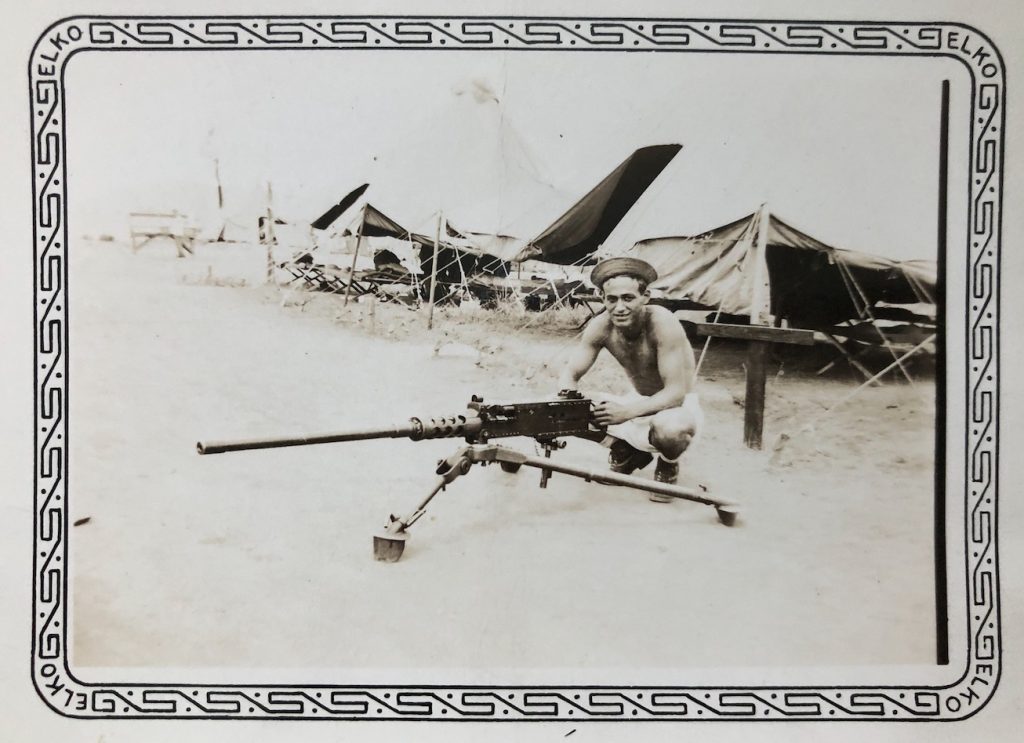
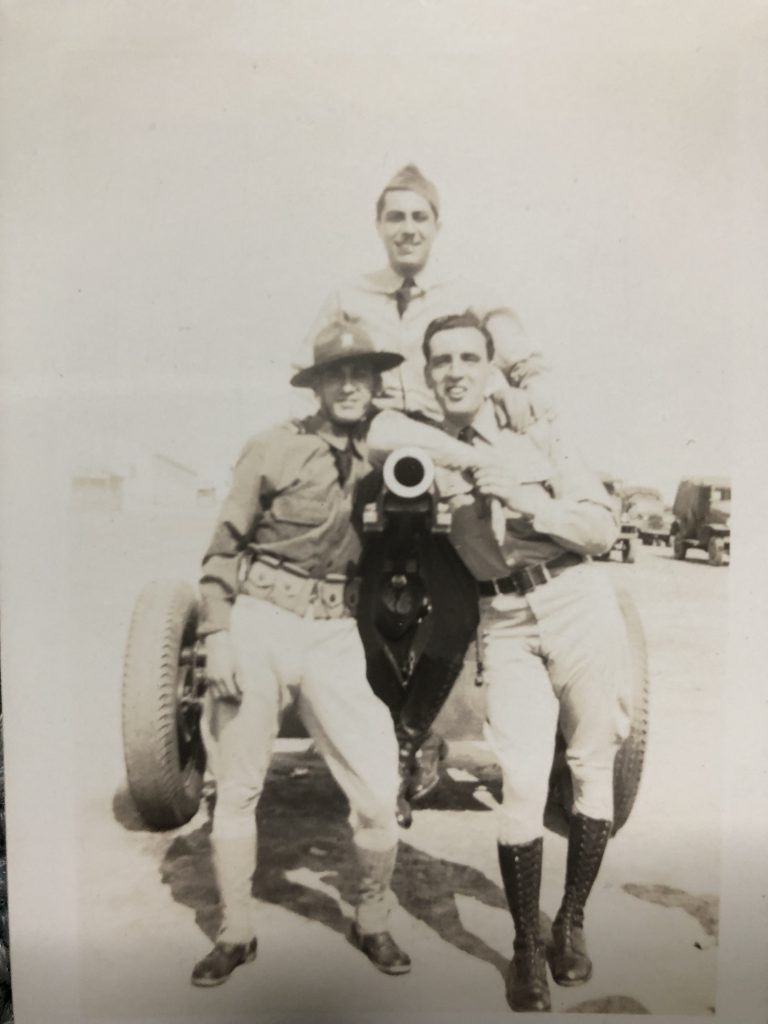
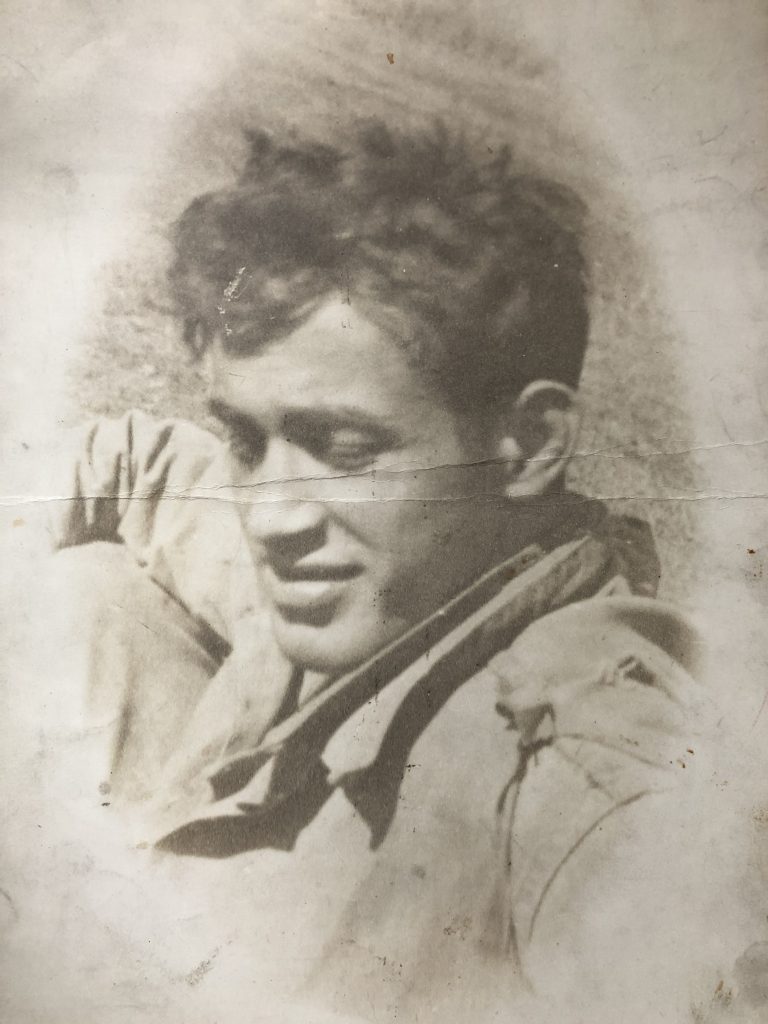
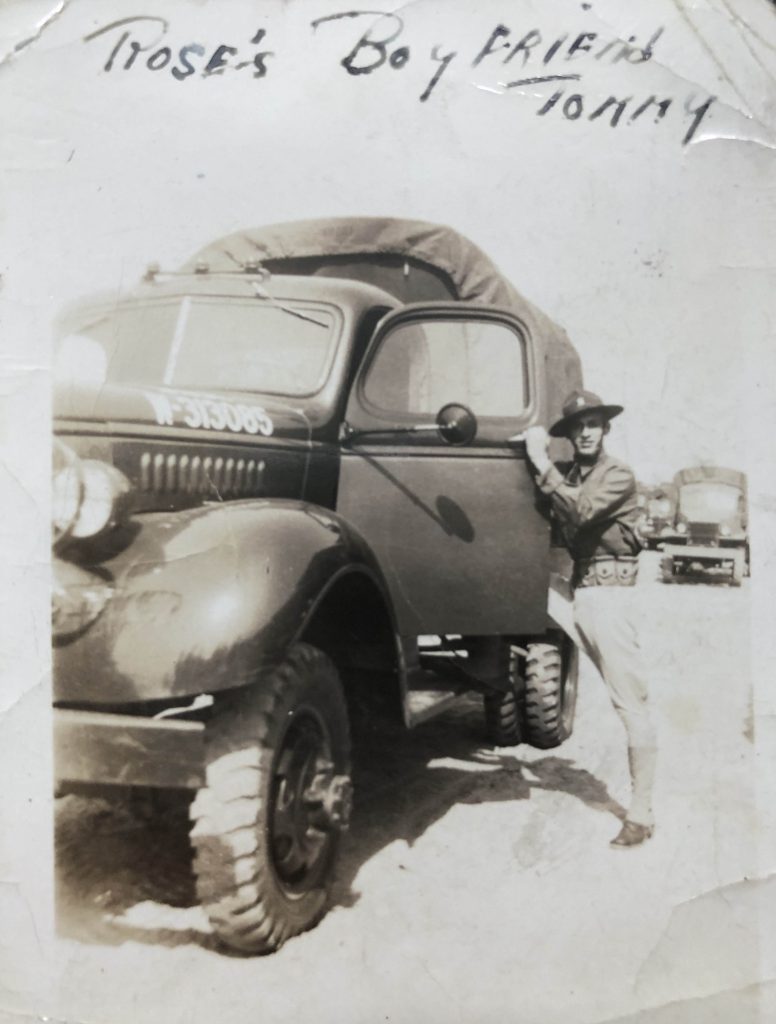
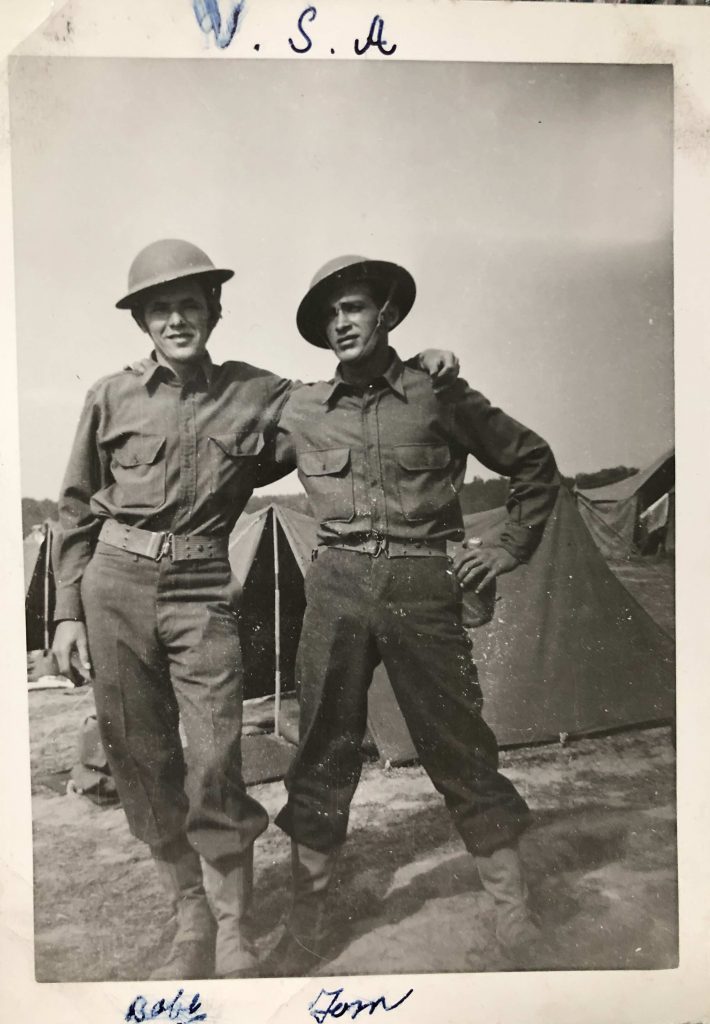
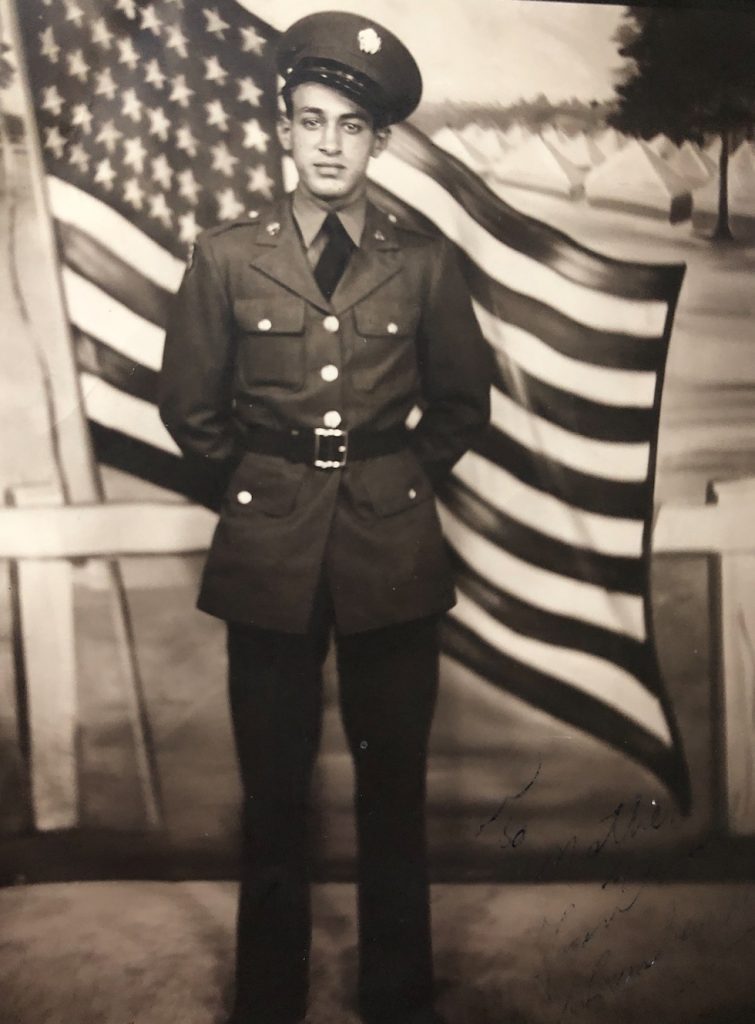
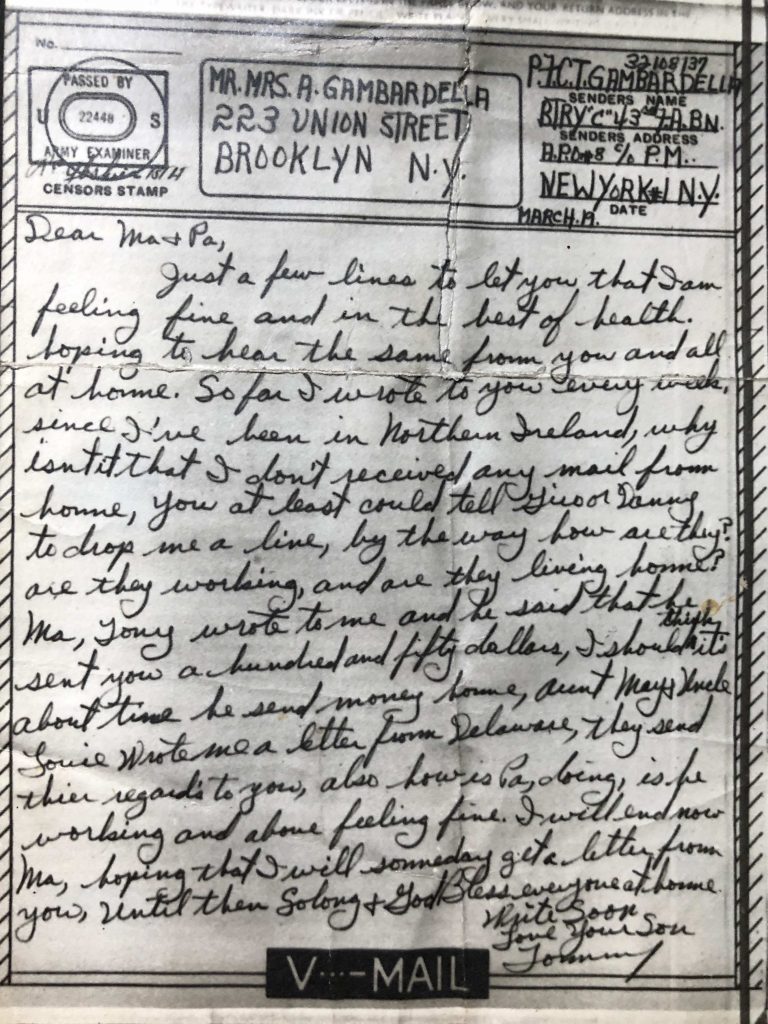
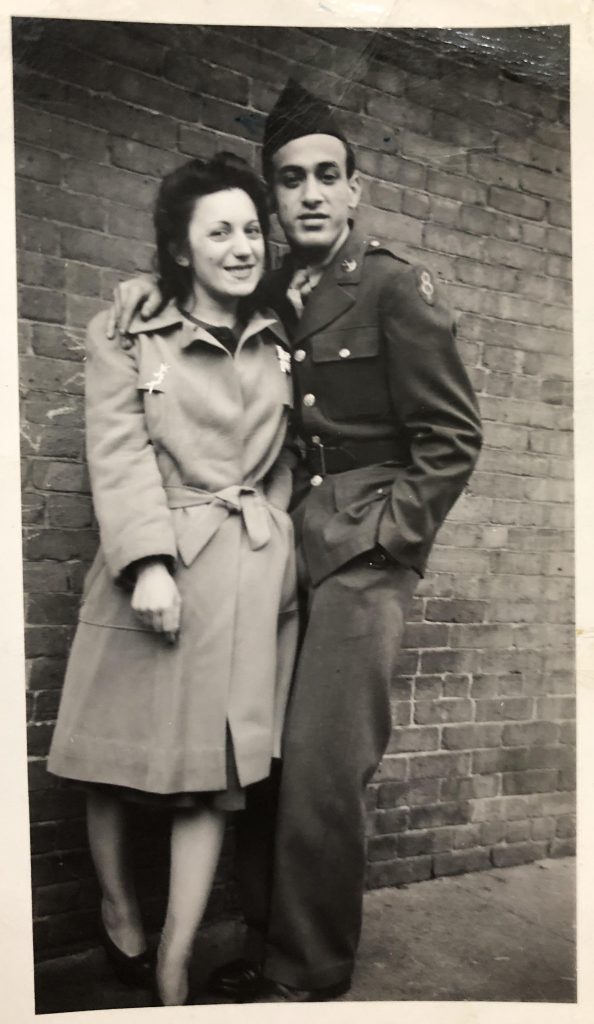
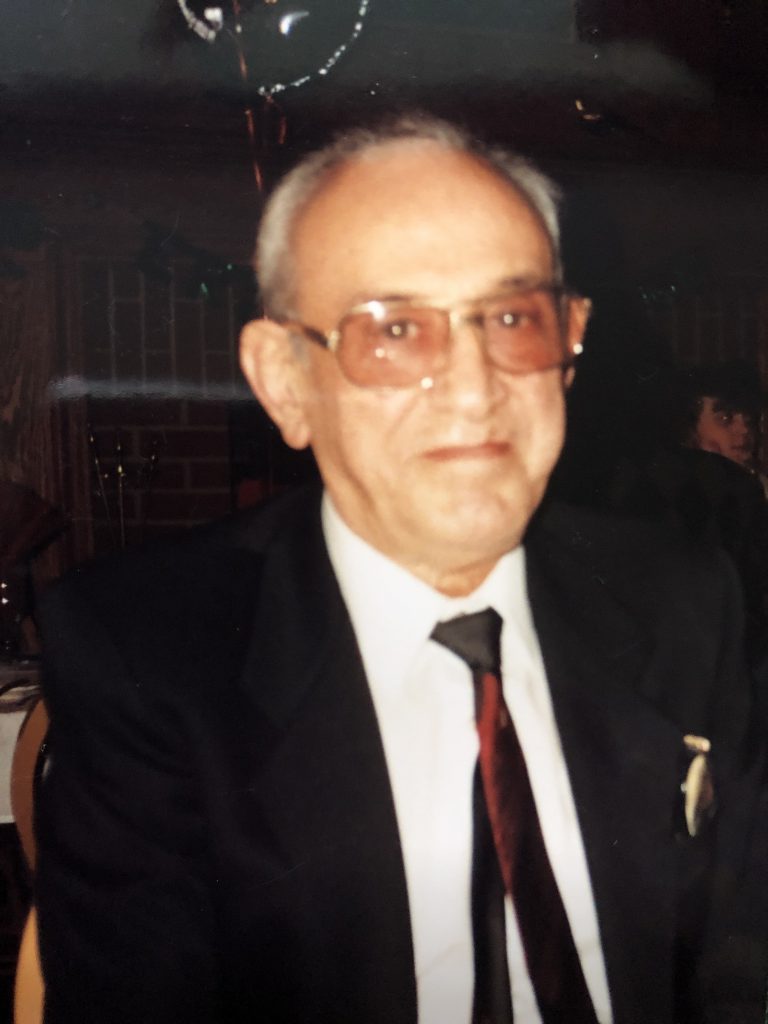
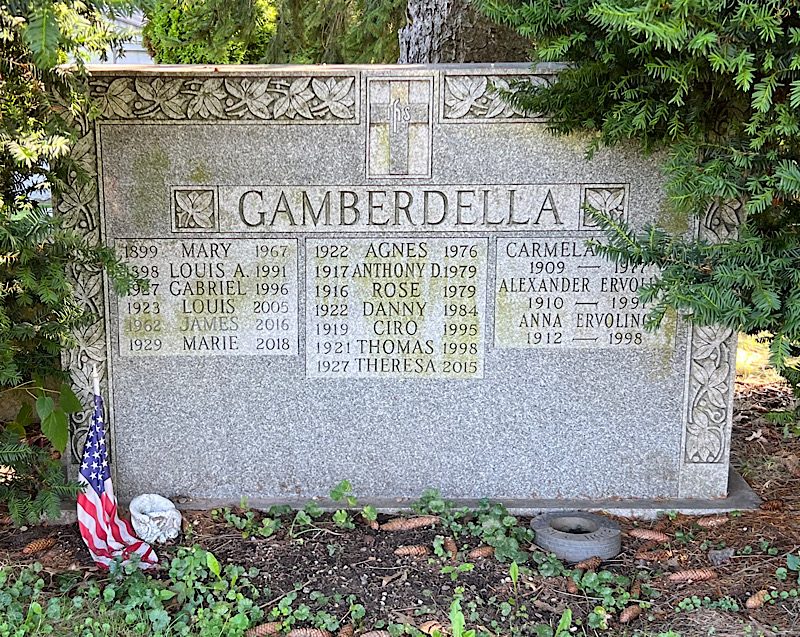
GARRIGAN, JR., JOHN FRANCIS (1922-2000). Private first class, United States Marine Corps. Born in Brooklyn to John Garrigan and Anna McKibbin Garrigan, John Francis Garrigan had two older sisters, Grace and Rita. His parents were born in the United States and had an elementary school education. Both of Anna Garrigan’s parents, James and Mary McKibbin, were born in Northern Ireland. At the time of Garrigan’s birth, his father worked as a street sweeper and his mother was a housewife.
By 1925, the family lived at 361 Baltic Street, Brooklyn, according to the 1925 New York State census. At the time of the 1930 federal census, the elder John Garrigan was employed as a Department of Sanitation driver. The family rented an apartment at 494 Court Street in Brooklyn and owned a radio. The 1940 federal census lists the family living in a rental apartment at 70 2nd Street in Brooklyn. The senior John Garrigan was still working for the Department of Sanitation, while Grace, the eldest daughter, worked as a telephone operator.
According to his daughter, John Francis Garrigan attended Roman Catholic elementary school at St. Mary Star of the Sea School on Court Street in Brooklyn. She was not sure if he attended high school.
When John Garrigan registered for the draft, at 20 years of age, he was living with his family at 70 2nd Street in Brooklyn. His listed his mother as his contact, and his employer was Namm’s Department Store on Fulton Street in Brooklyn. A.I. Namm & Son Department Store took up almost an entire block in downtown Brooklyn and was founded in 1887.
Based on an Application for Readjustment Allowance supplied by his family, Garrigan enlisted in the United States Marine Corps on September 5, 1942. He was qualified as a M-1 Rifle Marksman, served in the Asia-Pacific area, and was awarded the Certificate of Satisfactory Service and a Good Conduct medal.
During the war, on April 11, 1944, while Garrigan was in the Marine Corps, his mother passed away. According to an April 20, 1944 death notice in The Brooklyn Citizen, her father, James McKibbin, was still alive when she died.
Garrigan was honorably discharged as a private first class on January 3, 1946. His monthly rate of pay at discharge was $56.75. On his last Marine Corps muster roll, he is listed as having sailed from Honolulu to Bainbridge, Maryland. He was awarded a travel allowance of 5 cents per mile to travel from Bainbridge to his home in New York City.
Garrigan and Margaret Theresa McCarthy took out a marriage license in Brooklyn on September 10, 1949 and married later that month. They had one child, Anna. Garrigan worked at First National City Bank (later known as Citibank) as a guard or messenger, according to his daughter. He suffered a stroke in 1979 when he was only 57 years old, after which he went on disability and never worked again.
John F. Garrigan died on January 15, 2000. His wife, Margaret, died in 2006. They are interred together at Green-Wood. Section C, lot 44702, grave 76.
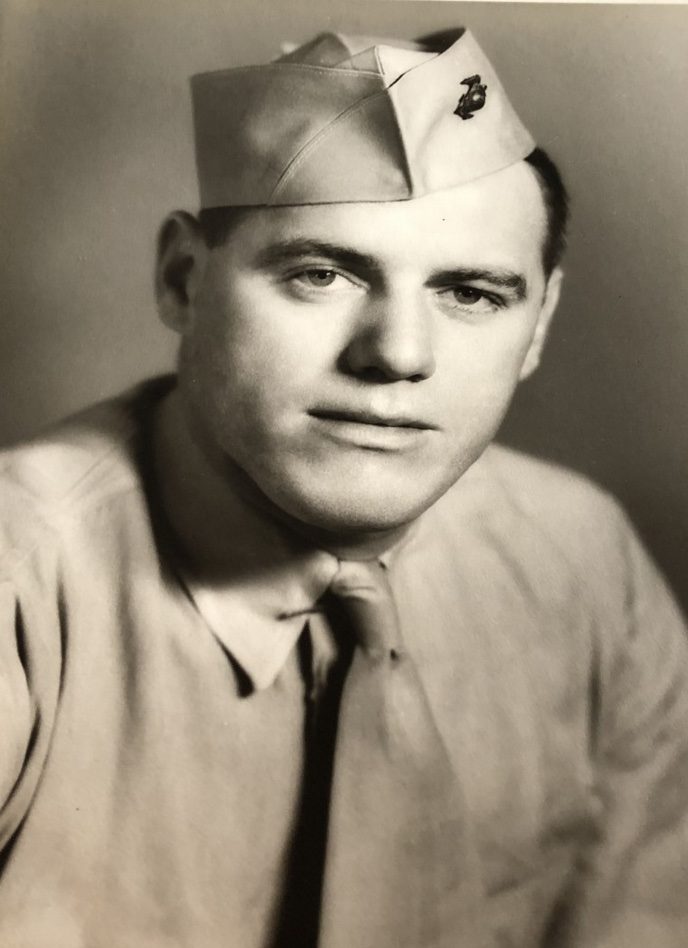
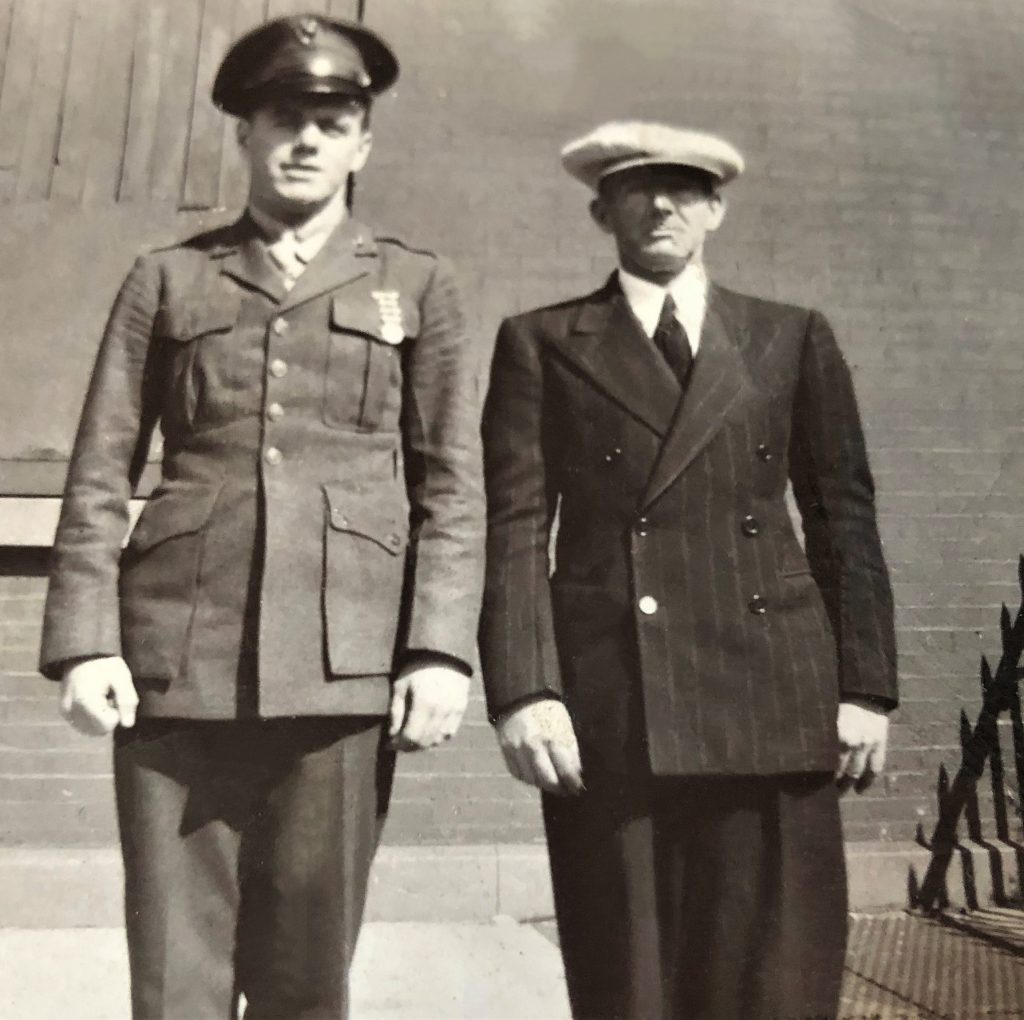
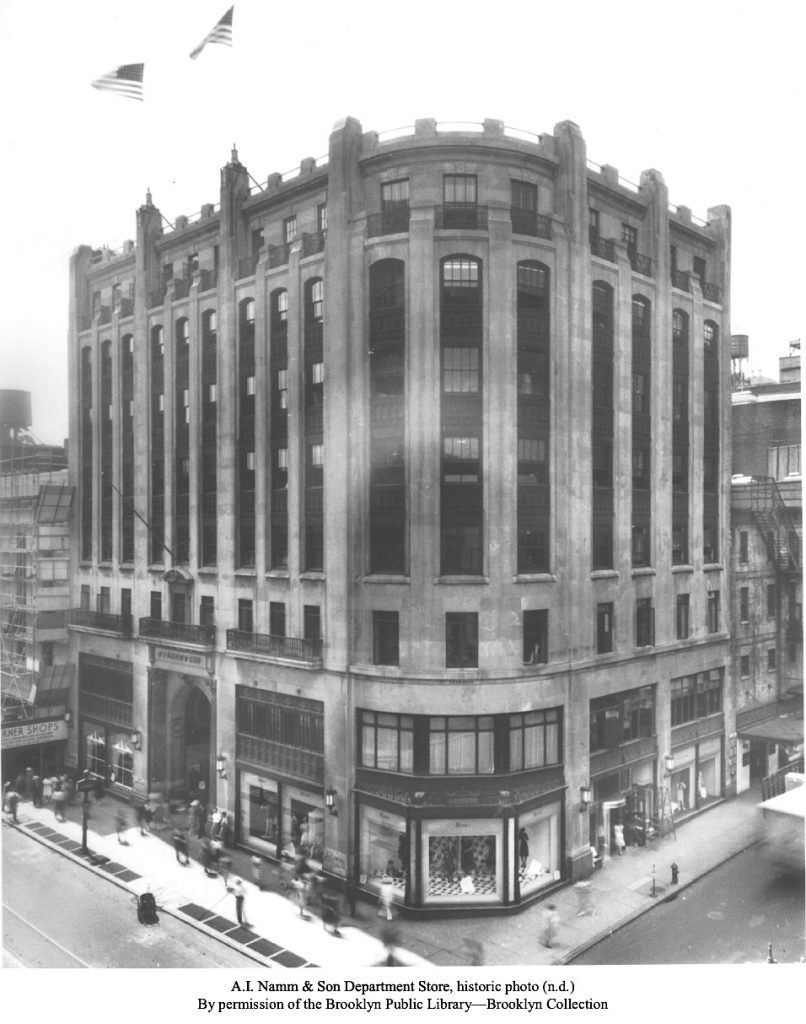
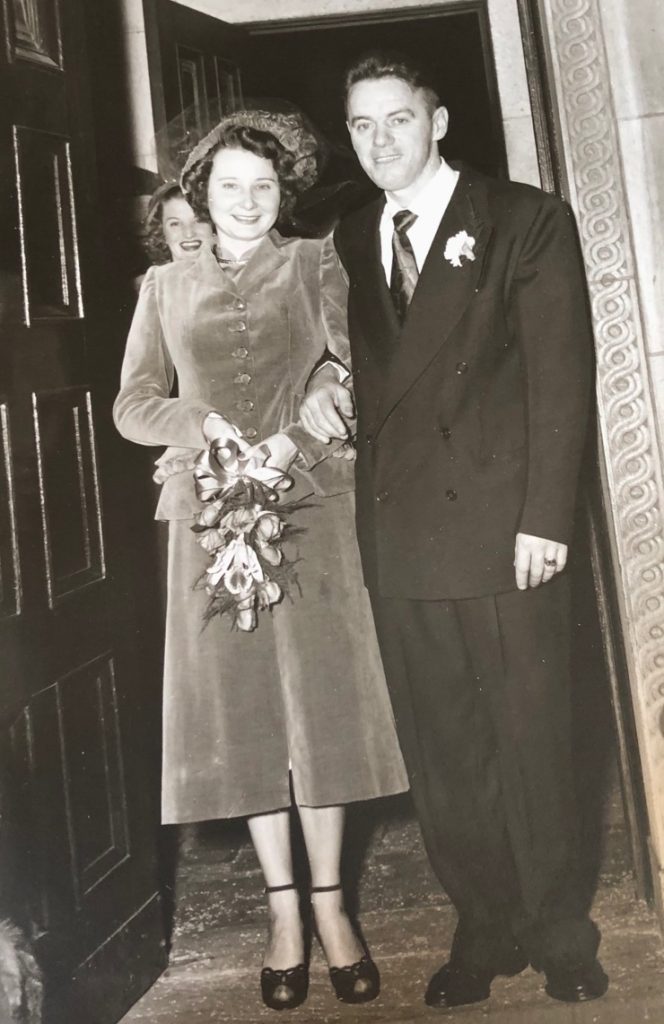
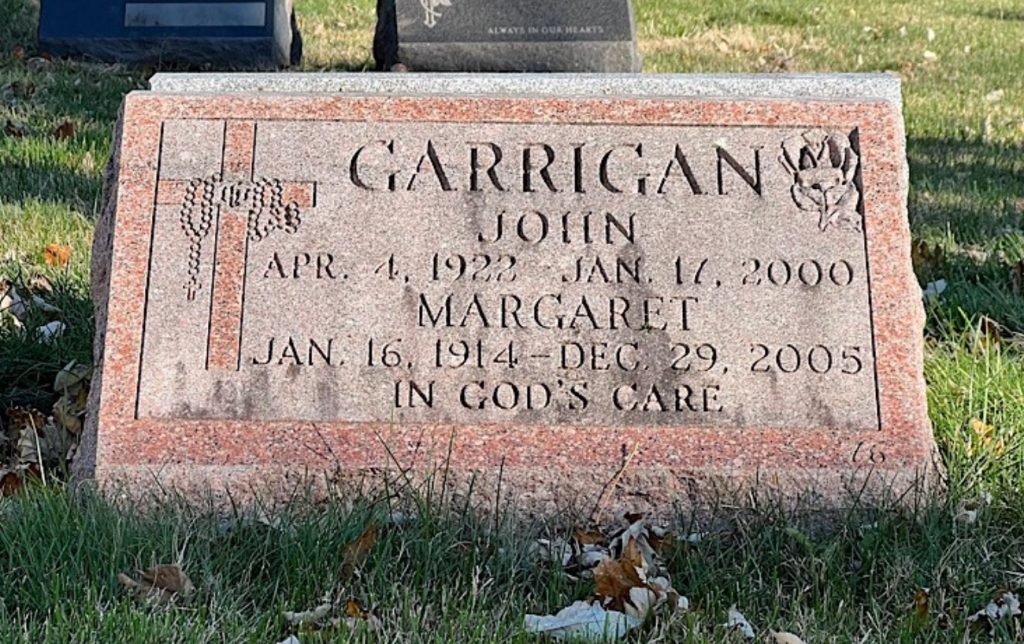
GAVARIS, PROKOPIOS (1920-1989). Sergeant, United States Army. Prokopios Gavaris’s father was Eustaras Gavaris and his mother Aspasia (Kapinaros) Gavaris. Although his older siblings were born in Greece, according to the United States Social Security Applications and Claims Index, Prokopios was in fact born in Brooklyn, New York. According to a relative, his parents were in the United States looking for a suitable husband for their daughter, who had settled in America, while Aspasia Gavaris was pregnant with him. Prokopios was born in Brooklyn and after a fitting match was found, the family and new baby returned to Greece before immigrating to the United States.
Gavaris’s siblings ranged from 10-20 years older than him. One passed away young and two others moved to Canada. After her marriage, his sister, Sophia, lived in both Chicago and Bloomington, Indiana, before returning to New York. According to family members, Gavaris, who was also known as Pete, attended high school in Greece. His absence from New York City censuses during that time period suggests this may be accurate. Indeed, he is listed as a passenger on the Ile de France, a ship that departed from Le Havre, France, and arrived in New York in May of 1939. Gavaris was 19 years old.
Gavaris’s draft card is dated July 28, 1941. His height is listed as 6′ and both his hair and eyes are listed as brown. His occupation is identified as waiter, though he is listed as unemployed. For “Name and Address of a Person Who Will Always Know Your Name,” it lists H. Costas, who was the husband of his sister, Sophia. Their address is given as 505 12th Street, Brooklyn.
On February 21, 1942, Gavaris enlisted in the United States Army. Initially stationed in England, he saw combat in France. At one time, his late nephew had photographs Gavaris took of a downed German plane, but they have unfortunately been lost. His cousin reports that Gavaris drove a bulldozer and in that job, assisted in the burial of victims at the Auschwitz concentration camp. He does not appear to have told this to anyone else, which is in keeping with how quiet he was about his war years. Gavaris achieved the rank of sergeant and was given an honorable discharge from the Army, completing his service on October 9, 1945.
Called by a family member “a born gentleman” and “the sweetest of fellows,” Gavaris became an avid golfer. After the war through the early 1980s, Gavaris, who had worked previously as both a waiter and a bartender, was part owner of Merchants Restaurant on Hudson Street in Manhattan. He never married or had children, but according to his cousin, he was a wonderful uncle and great-uncle. Gavaris’s last known address before his death on September 4, 1989, is Hampton City, Virginia. He was buried in Green-Wood Cemetery two days later. Section 58, lot 44604.
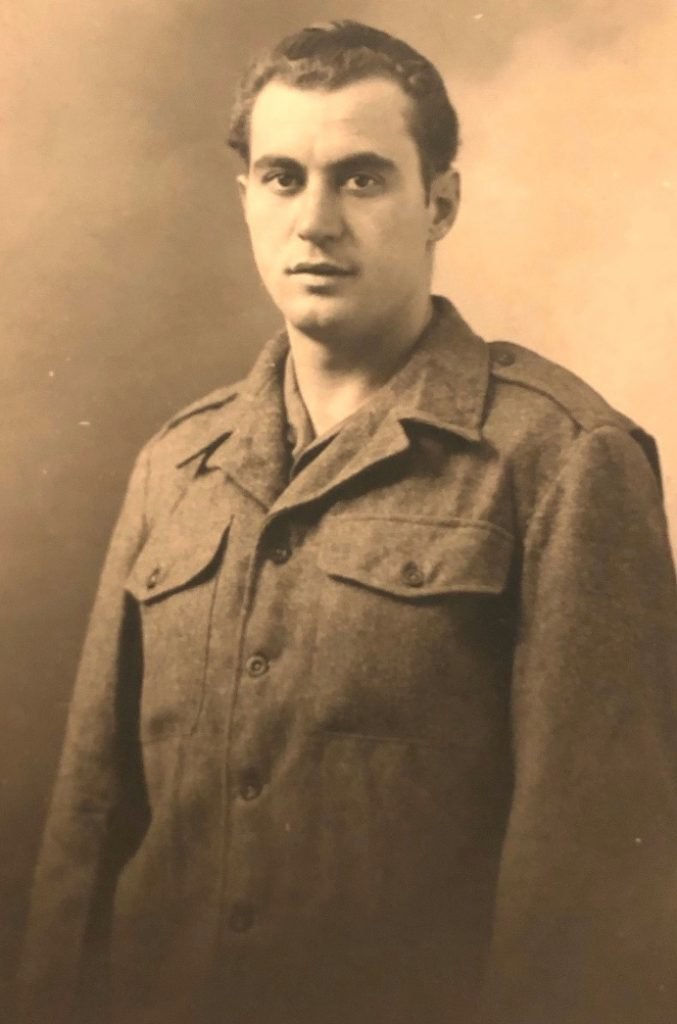
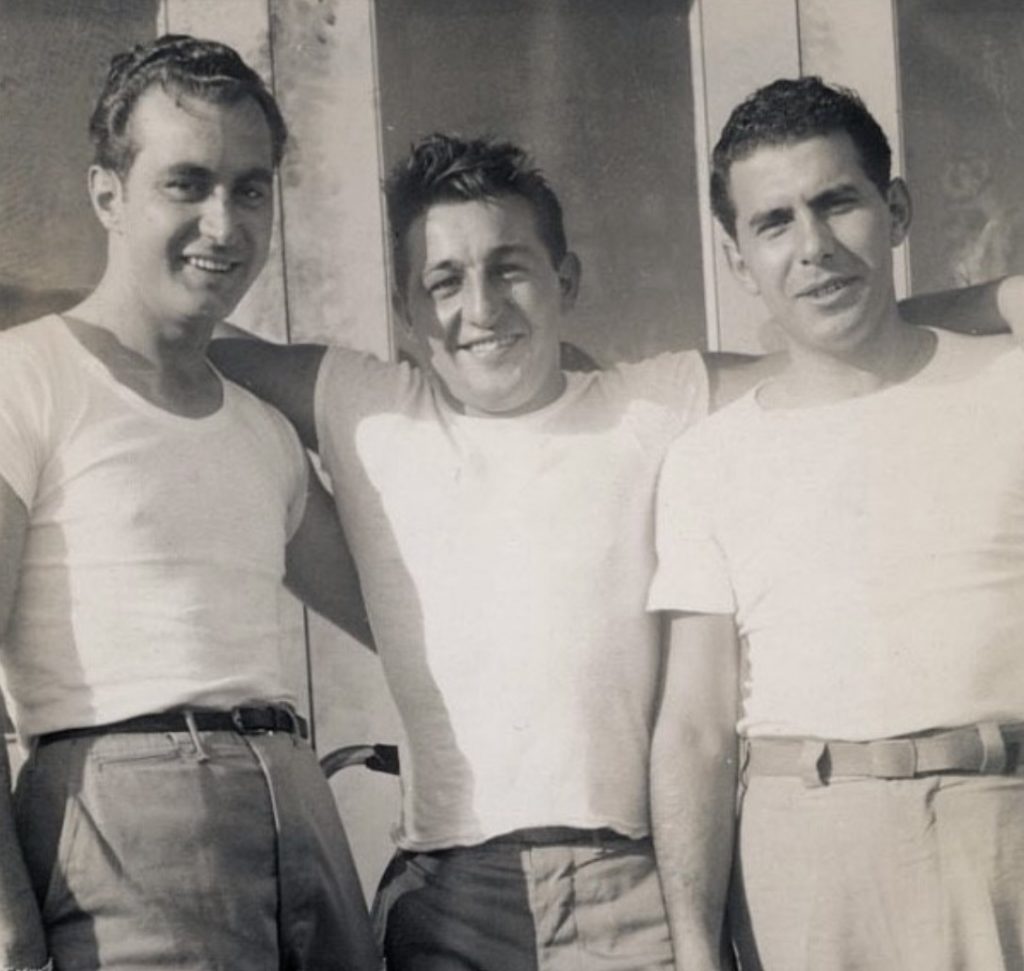
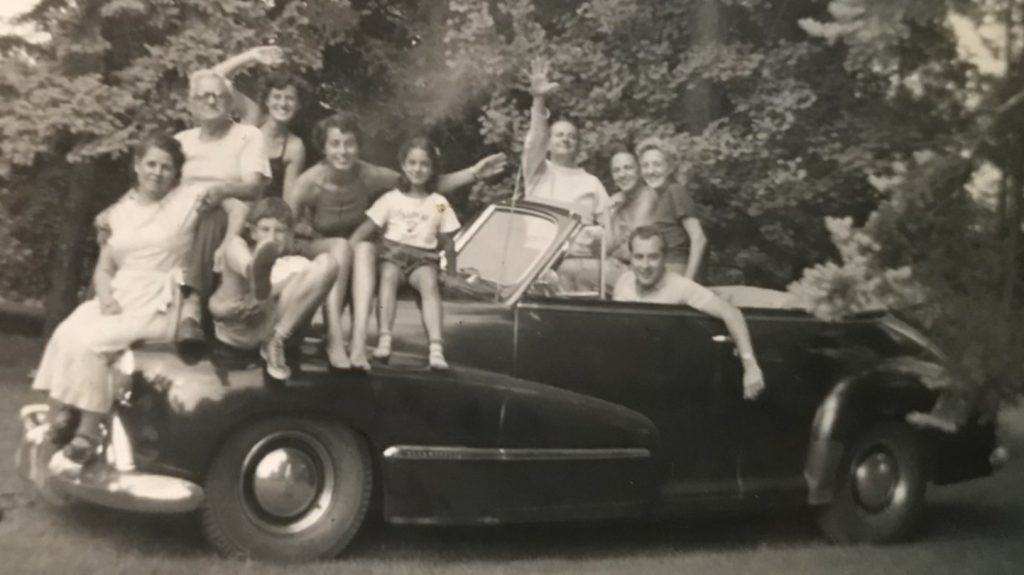
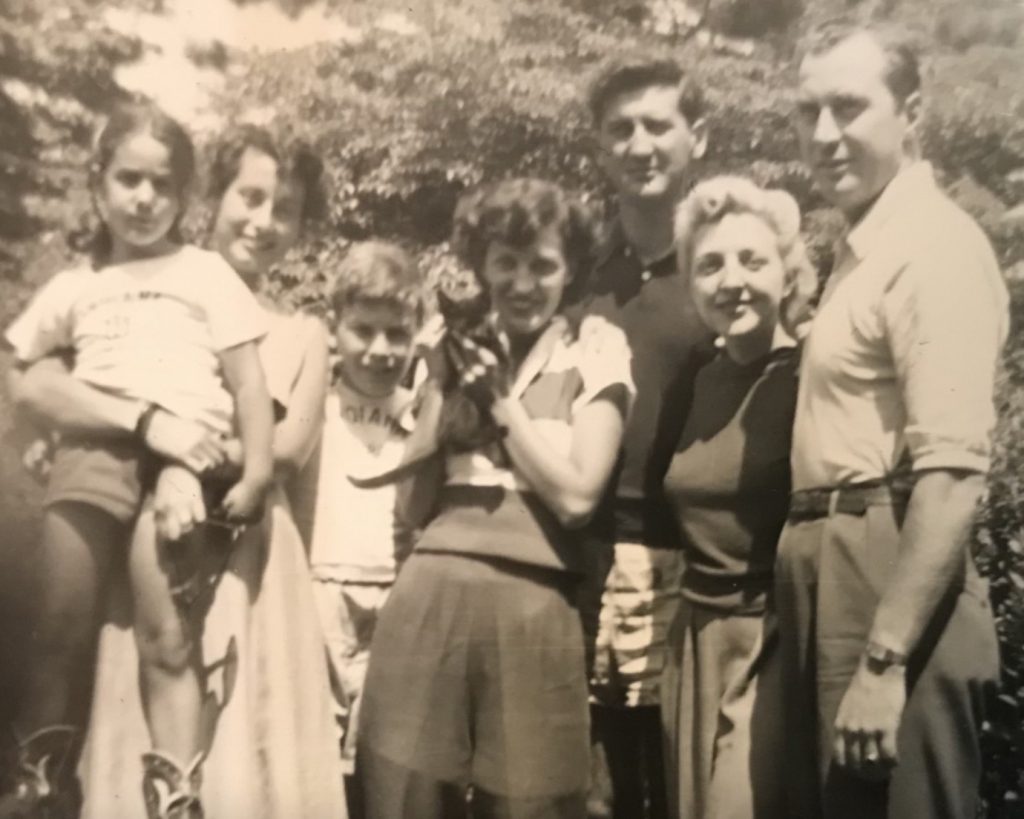
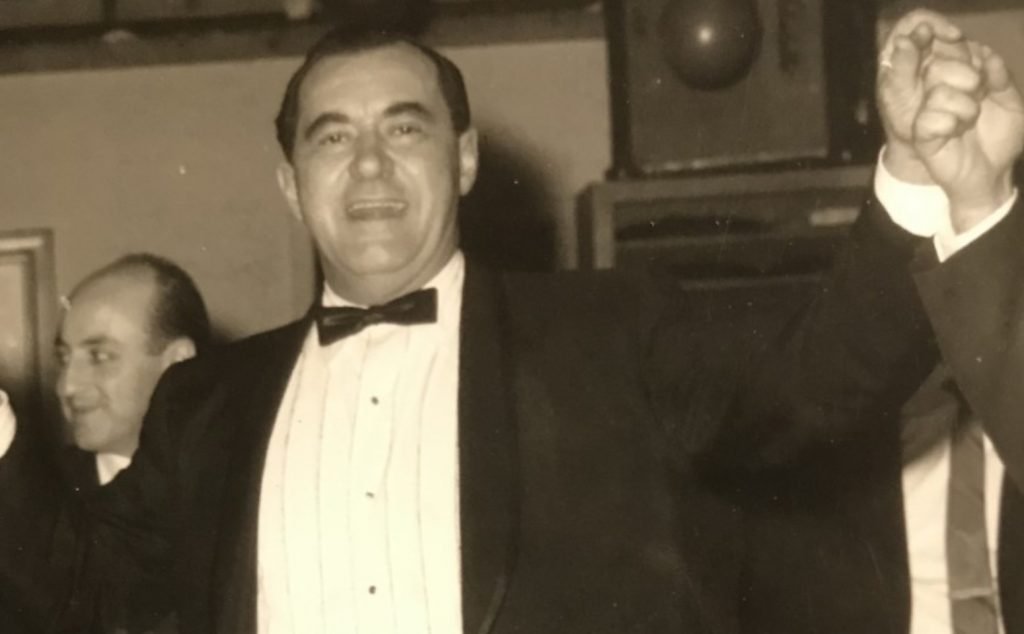
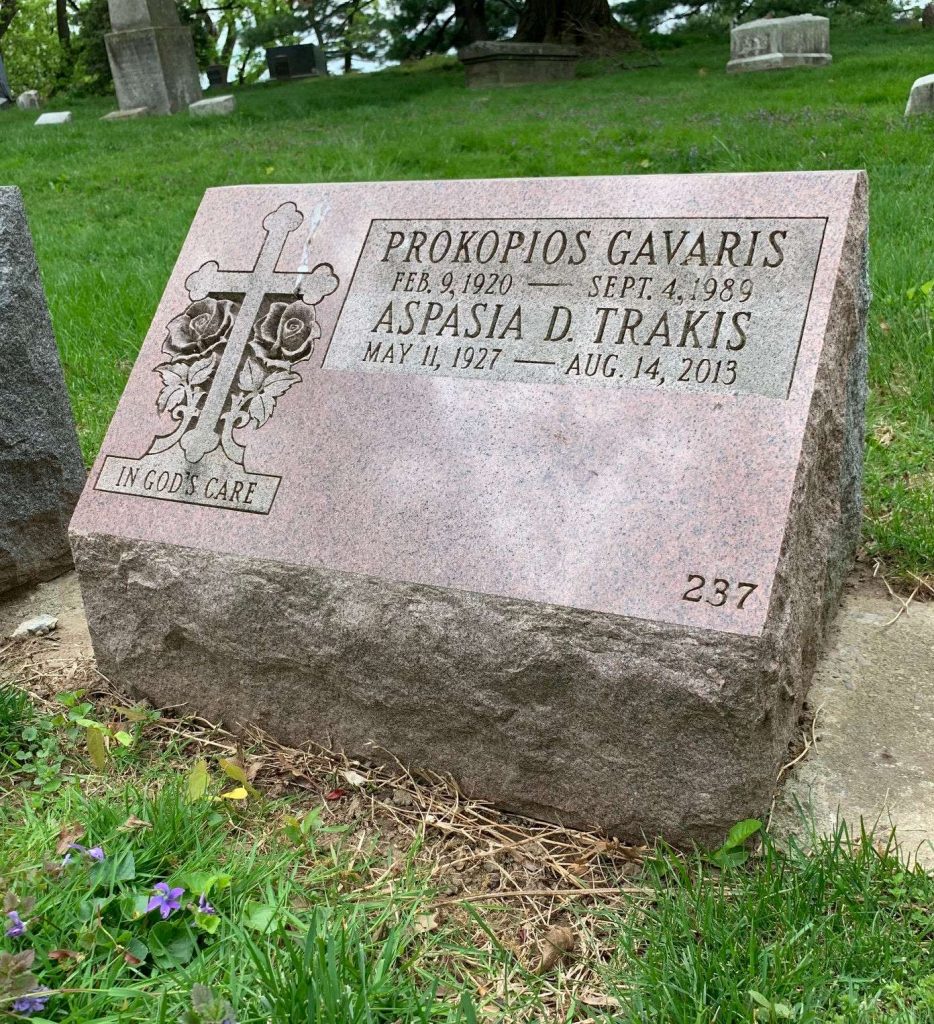
GAWLINSKI, STANLEY JOHN (1918-2004). Corporal, 101st Airborne Division. Three years before Stanley Gawlinski was born, his parents, John and Anna (nee Siolek) emigrated to New York from a part of Poland, territories which had been divided between three empires just before the World War I began, and the site of the beginning of the second World War. According to the 1920 census, Stanley’s father was a longshoreman, and the family, including older sister Josie, was renting an apartment at 148 Prospect Avenue. Their apartment house and neighborhood was occupied predominantly by Polish and Russian immigrants. The neighborhood that they lived in, according to the 1925 New York State census, a home at 275 23rd Street, Brooklyn, was a little more diverse, with families from England, Germany, Austria, Romania, and Italy, but still overwhelmingly Polish. That year, nine-year-old Josephine and seven-year-old Stanley were listed as attending school, learning to read and write, skills that must have made their parents, who had settled in the United States without those abilities, very proud. Four years later John, their father, died of chronic myocardia at the age of 36. The family was not found in the 1930 census, but by 1940 they were recorded as living two doors away from the residence where they had last lived. Stanley was listed as working as a laborer with two years of high school education from Murray Hill Industrial High School, his sister was a finisher at a laundry, and his mother was working as an office cleaner.
On October 16, 1940, Gawlinski registered for the draft, and on May 12, 1942 he enlisted at Fort Jay on Governors Island and began his service in the 101st Airborne Division, known familiarly as the “Screaming Eagles.” According to his son, Gawlinski served in the Ardennes, Rhineland, and notably Central Europe, during which time he was made a corporal. It has been said that it takes a certain type of person to jump out of a perfectly good airplane in the best of times. Stanley was doing it in the worst. If he was at the Battle of the Bulge, it was his general who sent the one word reply to the German commanders who demanded their surrender: “Nuts.”
Gawlinski was discharged on October 28, 1945, and at the war’s end he was awarded the American Theater Medal, the European-African-Middle Eastern Service Medal and the Good Conduct Medal. He found work as a machinist apprentice on his return and on January 12, 1947, he married Victoria Basta. Together they had three children, Edward, Anna, and John. Section N, lot 42666, grave 1.

GERARD, JR., SUMNER PELL (1916-2005). Captain, United States Marine Corps. Born into a prominent American family, Sumner Gerard’s paternal ancestors were French Huguenots who came to New York, after several generations in Scotland, in 1776. On the maternal side of the Gerard family, a notable ancestor was Increase Sumner, governor of Massachusetts 1797-1799, among other accomplishments. According to the 1920 census, the well-connected and affluent family lived on East 72nd Street in Manhattan. His father, Sumner K. Gerard, was an attorney, investor and real estate developer. The household consisted of Sumner, his brother Charles Henry Sumner, who was two years younger, his parents, and ten servants. His older brother, James Watson Gerard II, is not listed in the 1920 census. In 1924, his parents divorced and his mother, Helen Coster Gerard, remarried in 1926. Her second husband, Arthur Train, was a lawyer and novelist who was famous for his legal thrillers. By 1930, Sumner was living on East 73rd Street with his brother, step-siblings, a governess, and seven servants.
Gerard graduated from the Groton School in 1934 and then went on to Trinity College at the University of Cambridge. He received his bachelor’s degree from Cambridge in 1937 and a master’s degree in 1939. While at Cambridge, Gerard became a certified pilot as a member of the University Aero Club. By 1940, according to the census of that year, he was living in New York City at his father’s house, and, as per his draft registration card, working as a political secretary for Councilmember Joseph Clark Baldwin, who later became a United States congressman.
In February 1941, Gerard was drafted into the Army as a private. A few months later, by June 1941, he was transferred to the Navy, commissioned as an ensign, and assigned to Washington, D.C., as an assistant administrator of export control. (This unusual move was noted in a newspaper item in the Montana Standard.) In August, 1942, Gerard, now a naval lieutenant, was sent as aide-de-camp to the Moscow Conference; the United States delegation was led by Averell Harriman. The conference, according to the Olean Times-Herald, was primarily an Anglo-Russian meeting between Churchill and Stalin. By 1943, according to muster rolls, he had become a Marine Corps captain in Company A. He trained as a parachutist while attached to the British Eighth Army and during the war years was posted to Africa, China, India, and Burma. Gerard was discharged from the Marine Corps as a captain in the intelligence service in 1945. He received the Army Commendation Medal and the Order of the British Empire.
In peacetime, Gerard initially returned to the family business, Aeon Realty Company, but by 1947 he had decided to go into ranching, and moved with his family to Montana in 1949. The ranch business was never profitable and his father continued to supply it with financial assistance. In Montana, he became involved in politics. He was elected to the Montana Legislature as a Republican representing Madison County in 1954, serving three terms, and was minority leader from 1959 to 1961. In 1959, he announced his campaign for the Republican nomination for the United States Senate, but lost the primary. He finished his political career as a state senator for Madison County. He served in the Montana Senate from 1962 through 1969 and was minority leader 1966 to 1969.
In 1969, Gerard left Montana for New Jersey to begin his next career. He was appointed by President Richard M. Nixon as a delegate to the Food & Agriculture Organization of the United Nations. From 1970 to 1974, he was the mission director for the United States Agency for International Development in Tunisia. Nixon then appointed him United States Ambassador to Jamaica in 1974, a post he was to hold through the Ford administration and the beginning of the Carter administration. He left the post in 1977.
Gerard then relocated to Florida and pursued an interest in marine biology. He sponsored underwater archeology expeditions, eventually becoming an adjunct professor of maritime archaeology at the University of Miami.
In his personal life, Sumner Gerard married Louise Taft Grosvenor in 1943. She came from another well-connected New York family: her father’s cousin was President Taft and her stepfather was a former governor of New York. Louise was a Vassar graduate. They had five children: Jenny, Molly, Helen, Anne and Sumner, before divorcing in 1967. In 1968, Gerard married Niki Dabrowski, who was born in Warsaw, Poland, and lived and worked in Rome, Italy, until 1964. Sumner and Niki divorced in 2004. They had no children. Gerard died in Florida of natural causes. He was buried in the Gerard family vault. Section 108, lot 16554, vault.
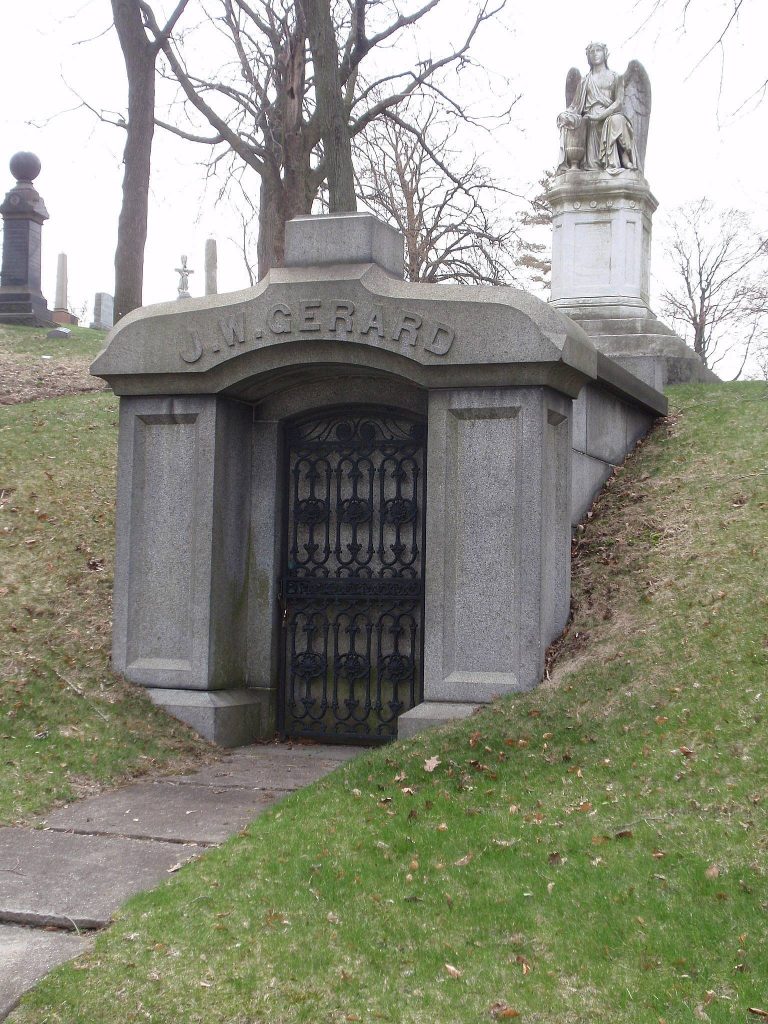
GERBING, RAYMOND F. (1919-1996). Rank unknown, unit unknown, United States Army. Born in New Jersey, the 1920 federal census reports that Gerbing lived with his parents, Howard and Florence, in West Hoboken, New Jersey. Both parents were born in New Jersey. His father is listed as head of household and worked as a clerk in a brokerage house. Also in residence at the household was Gerbing’s maternal grandfather, Andrew Lutz, a lithographer. According to the 1930 federal census, the family had relocated to West New York, New Jersey. Gerbing’s mother had passed away and his father was employed as manager of a brokerage firm. The census states that Gerbing’s paternal grandmother lived with her son, Howard, and her two grandchildren, Howard Jr. and Raymond. As per the 1940 federal census, the family still resided in West New York. Gerbing’s father was employed on Wall Street, Howard Jr. was a newspaper representative at an advertising company, and Raymond was a Wall Street clerk.
According to Raymond Gerbing’s World War II draft registration card, he lived at 6045 Boulevard East, West New York, New Jersey. His date of birth was July 1, 1919 and he was employed at the Lapham-Davis-Bianchi brokerage firm located at 522 Fifth Avenue, New York City. His registrar’s report describes him as 6′ tall, 170 pounds with blue eyes, blond hair, and light complexion. According to the Department of Veteran Affairs BIRLS (Beneficiary Identification and Records Locator Subsystem) Death file, Gerbing enlisted in the Army on March 18, 1943 and was discharged on January 28, 1945. There is no documentation as to which unit Gerbing served in or where he served during the war.
Little is known about his life after the war, except that he applied for a marriage license 11 days after his discharge. As per the New York Marriage License Indexes, Gerbing married Geraldine Di Rienz on February 8, 1946 in Brooklyn, New York. He last lived in Brooklyn. Hillside Mausoleum, Phase II, Section 2201E.
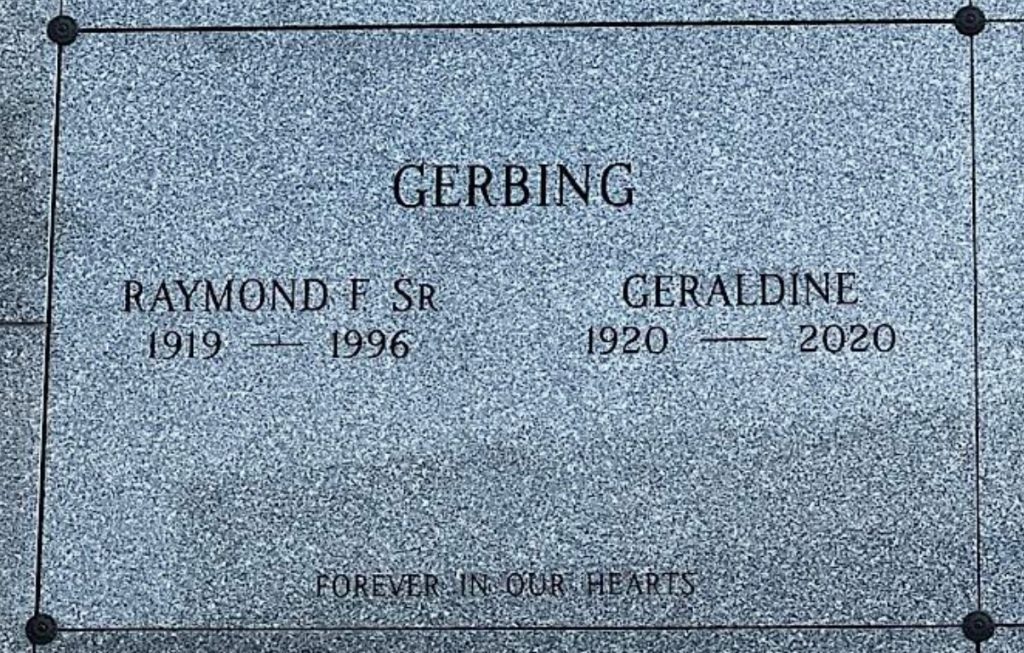
GIBALDI, ANTHONY (1921-1975). Technician fifth grade/corporal, Corps of Engineers, United States Army. Anthony Gibaldi was born in 1921, the fourth of six sons, to Carmelo and Lenora Gibaldi., who had immigrated from Italy in 1907. According to the 1925 New York State census, the family lived on Hicks Street in Brooklyn, and father Carmelo worked as a dock laborer. By the 1930 federal census, the family was living on Henry Street; by 1940 they were on President Street. According to that year’s census data, 19-year-old Anthony had completed one year of college and worked as a packer in a drug manufacturing company.
In 1942, Gibaldi, soon after his 21st birthday, registered for the draft. He was still living on President Street, and worked at the United States Government’s Picatinny Arsenal in Dover, New Jersey. Anthony was described as 5′ 6″ in height, weighing 135 pounds, with brown eyes and black hair. He was inducted into the United States Army eight months later, in October 1942. Just before his enlistment, Anthony and Margaret Tesoriero obtained a marriage license.
As a tech corporal, Gibaldi provided skilled assistance in the construction of steel, wood and concrete structures, such as bridges, buildings, and roads in the European Theater of Operations. He participated in the Northern France campaign (Battle of Normandy); the advance to the Rhine (Siegfried Line campaign); and the Western Allied invasion of Germany (Central European campaign). He earned three Overseas Service Bars and three Bronze stars, along with a Good Conduct Medal, according to family member Lorraine Grecco. He was discharged from service on October 15, 1945.
Gibaldi died in 1975, about a week before his 54th birthday, leaving his wife, Margaret, and brothers Ignatius, Angelo, Louis, Joseph, and Paul. He is buried along with his wife, mother-in-law, and father-in-law. Section 34, lot 39840, grave 1.
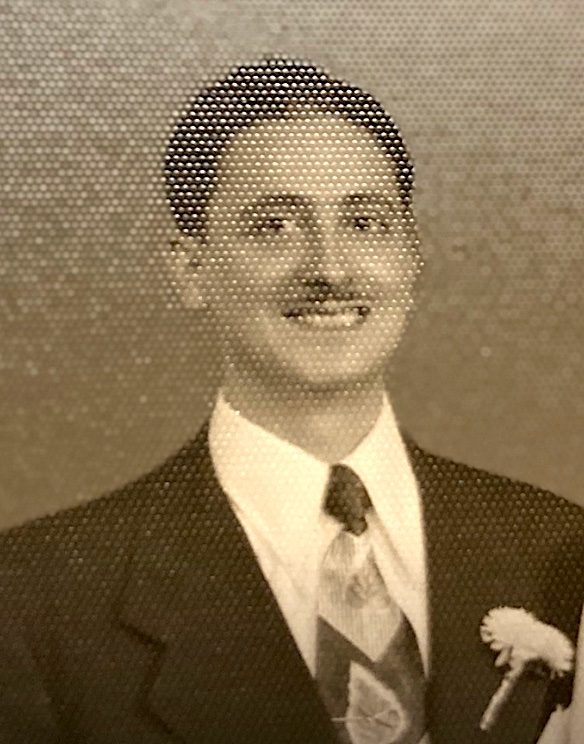
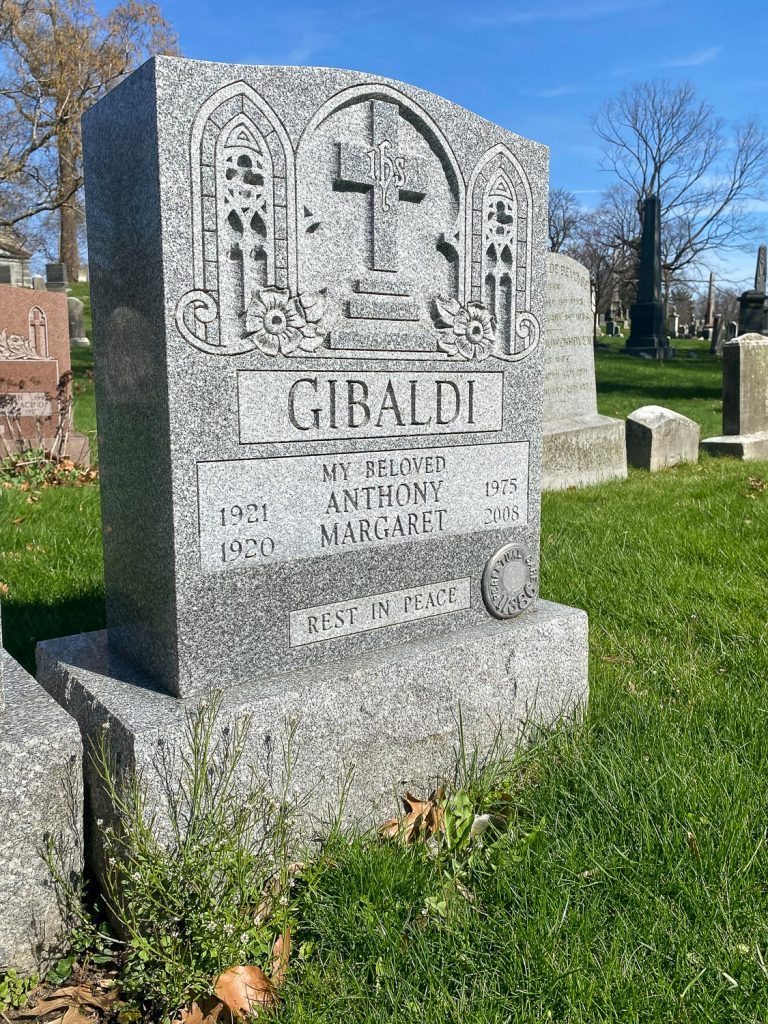
GIGLIO, FRANK (1926-1945). Private fourth class, 6th Marine Division, United States Marines. Frank Giglio was born in Brooklyn. Giglio’s father, Angelo, was born in Licata, Italy in 1886 and immigrated to the United States in 1902. His mother, Giovannina (Jennie), was also born in Licata in 1897 and arrived in the states in 1912. According to the 1925 New York State census, recorded a year before Giglio’s birth, the Giglios resided at 1476 Ocean Parkway in Brooklyn. Angelo is a citizen and is the head of the household. There are seven children, ranging in age from newborn to 12 years old. Also residing in the residence are Angelo’s brother, Sars, and his wife, Anna.
The 1930 federal census records that Giglio’s family still resides on Ocean Parkway. His father is a stevedore, loading and unloading cargo at the docks. The family now includes nine children. As per the 1940 federal census, the Giglios have relocated to Lewisboro in Westchester County. Giglio’s father is now a steward for the French Lines and a 10th child is listed on the census. The two oldest daughters, Agatha and Concetta, have married and are living elsewhere. At the time of the census, the eight children still living with their parents are: Venora (21), Rose (20), Gloria (18), Benjamin (17), Sylvia (14), Frank (12), Angelo (11) and John (6). The 1941 Katonah High School yearbook records Giglio as a freshman and he is pictured with his classmates. Prior to Giglio’s enlistment in the Marines, his older brother, Benjamin, enlisted in the Army Air Corps in 1942 and was discharged on November 25, 1945, with the ranking of staff sergeant. His brother-in-law, Captain George Byrd (see), Rose’s husband, was also in the United States Army during World War II and served in Italy.
On May 23, 1944, Giglio enlisted in the United States Marines, 6th Marine Division. As per the July 1, 1944 Muster Roll of Officers and Enlisted Men, he is listed as a private stationed with the Eighth Recruit Battalion at Parris Island, South Carolina. The October 1944 United States Marine Corp Muster Rolls details that he is a private in infantry training at Camp Lejeune in North Carolina. Three months later, as per the January 1945 Marine Corps Muster Rolls, Giglio is assigned to the First Battalion, Fourth Marines, Sixth Marine Division. Sadly, the Marine Corps Casualty Indexes record that Giglio was killed in action in Okinawa, Japan, on April 14, 1945. He was in service for only one year and would have celebrated his nineteenth birthday the next month. According to the National World War II Museum in New Orleans, Louisiana:
…The battle for Okinawa drug out over nearly three months and included some of the worst kamikaze attacks of the war. By the time Okinawa was secured by American forces on June 22, 1945, the United States had sustained over 49,000 casualties including more than 12,500 men killed or missing. Okinawans caught in the fighting suffered greatly, with an estimated 110,000 civilians killed….
On April 5, 1949, his father applied for a government-issued granite headstone. In addition to that gravestone, and a bust of him at his grave, Giglio’s name appears on two memorials commemorating his sacrifice for our nation. A November 1950 issue of the Brooklyn Eagle announced that Giglio was included on the Brooklyn War Memorial, a listing of more than 7,000 World War II veterans who died. On June 11, 1975, the Okinawa Peace Memorial Park erected a granite memorial of Servicemen Casualties in the Battle of Okinawa. The memorial, called “The Cornerstone of Peace,” is a collection of stone plates with the names of fallen soldiers and civilians. Section 128, lot 37296, grave 2.
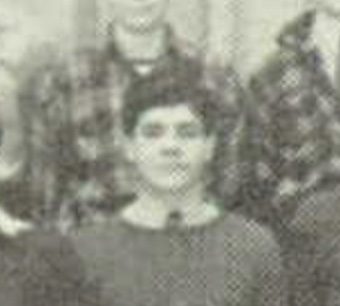
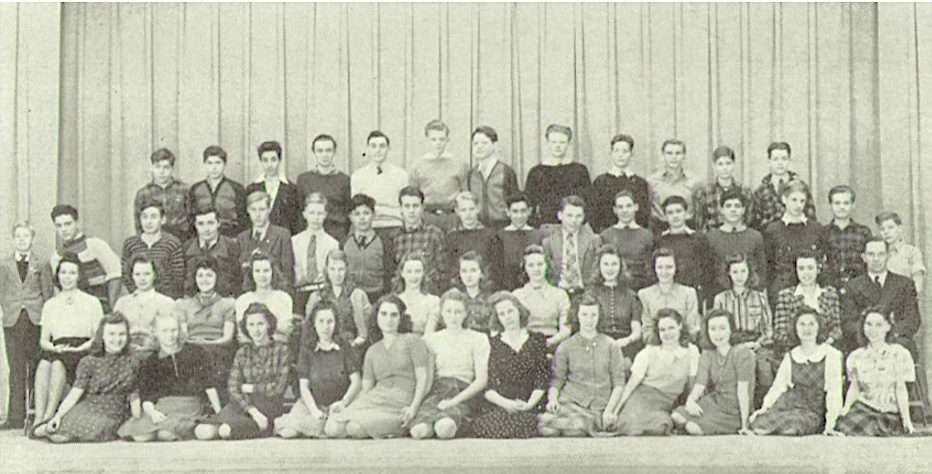
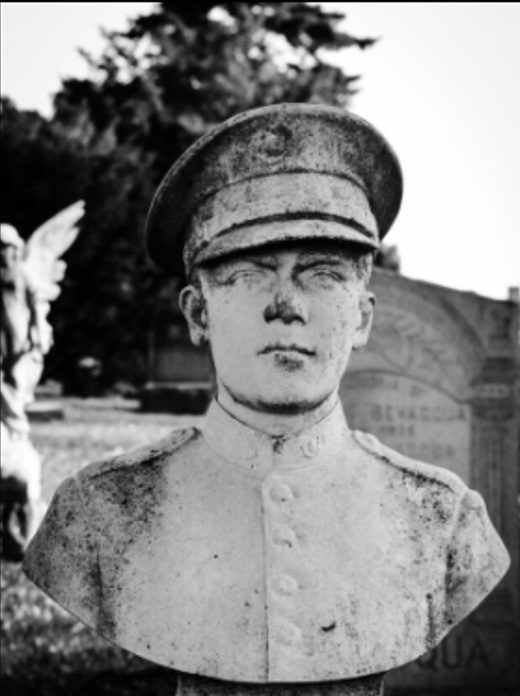
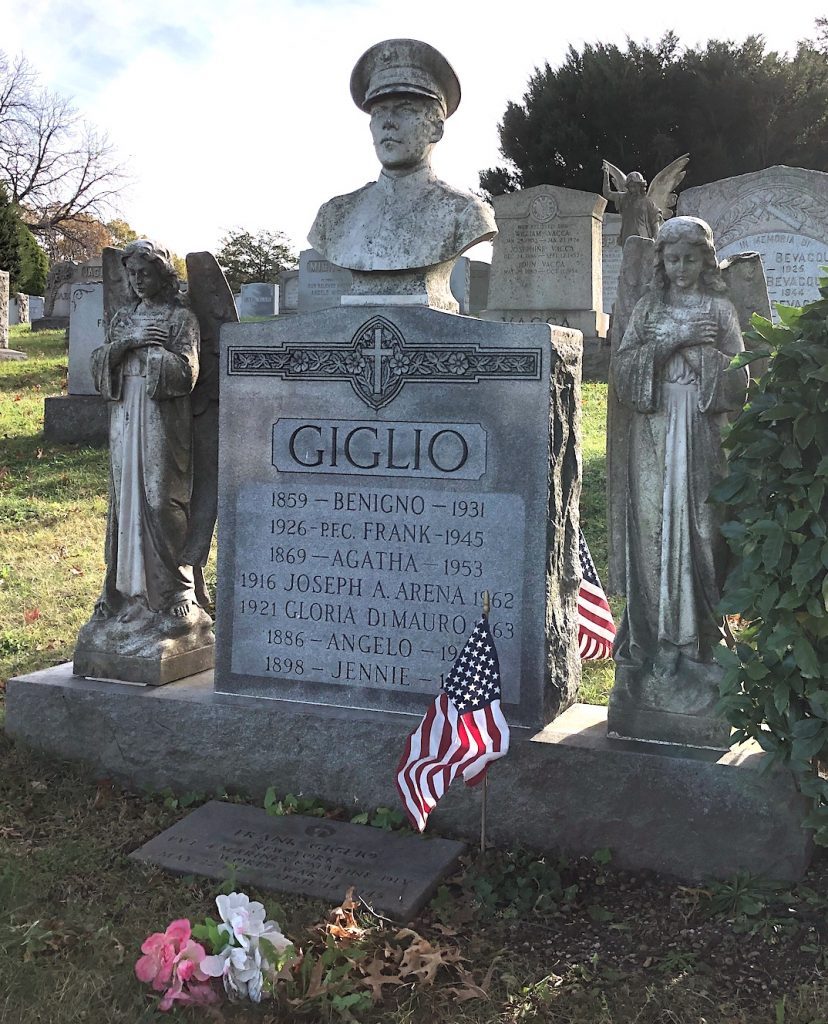
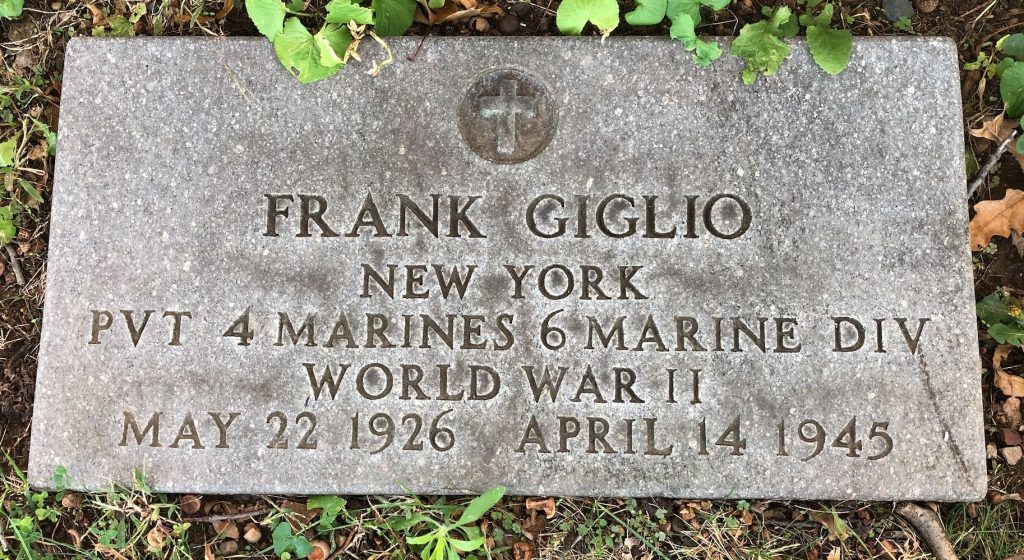
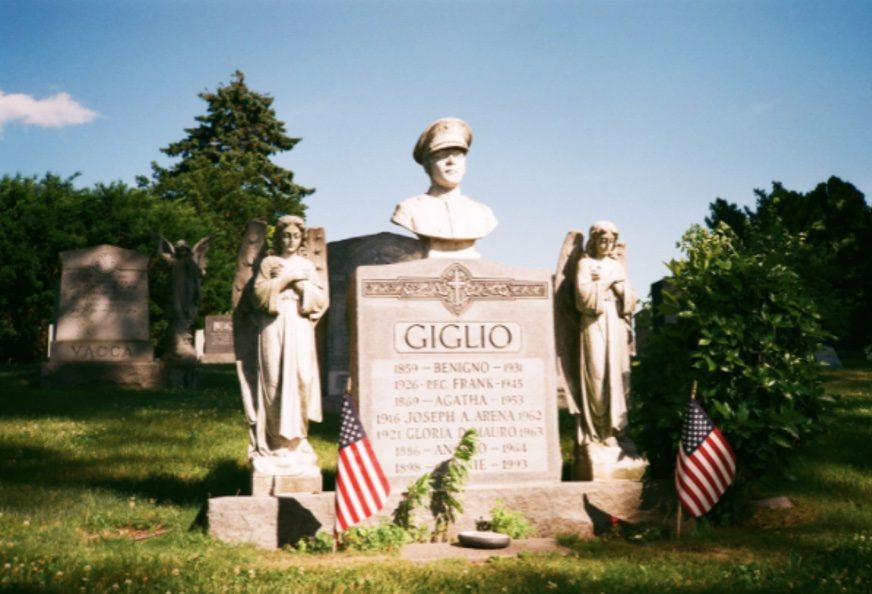
GILI, ANTHONY JOHN (1928-1999). Corpsman 3rd class, United States Navy. Anthony Gili was born on Mulberry Street in Manhattan to Charles Carmelo Gili and Eva (Colombo) Gili, a seamstress. His father, who was born in Malta, was a Maltese merchant seaman, according to his grandson, and became a naturalized United States citizen in 1933. His mother was born in New York; her parents were from Italy. Anthony’s sister, Angelina, was born in 1931. By 1940, according to the census for that year, the family had moved to Bedford Avenue in Brooklyn. Anthony attended Boys High School on Marcy Avenue in Brooklyn. He enlisted in the Navy on March 9, 1946, just a few weeks after his 18th birthday, and trained as a pharmacist’s mate with the rank of corpsman third class.
After his discharge on January 8, 1948, Gili worked for 20 years as a printer/foreman at Van Reese Press on West 26th Street in New York City. Then, with his cousin Tony Gili, he founded Copymate, Inc., located at 42-53 Main Street, Flushing. The business was registered with the State of New York in 1974.
He and his wife Carole bought a home at 204 East 2nd Street in Brooklyn and raised four children: Charles, Anthony Jr., Christopher and Elizabeth Anne. Gili was a Boy Scout Leader for Troop 184, based at Immaculate Heart of Mary Parish, and was a Little League baseball coach for the 70th Precinct Youth Council.
In retirement, the Gilis moved to Mystic Islands, New Jersey. Carole worked in the Showboat Casino in Atlantic City and Anthony worked part time at the Taj Mahal Casino as a slot machine attendant. His son Charles commented that he was very creative and loved to draw and paint, carved wooden birds and decoys, and spent time with his children and nine grandchildren.
Gili died on January 14, 1999. Said his son: “We were all at his bedside when he passed away at my sister’s home in Pennsylvania, with music from the WWII era playing in the background. He was an incredibly hard worker and loving husband, father and friend.” Section 112, lot 38513, grave 2.
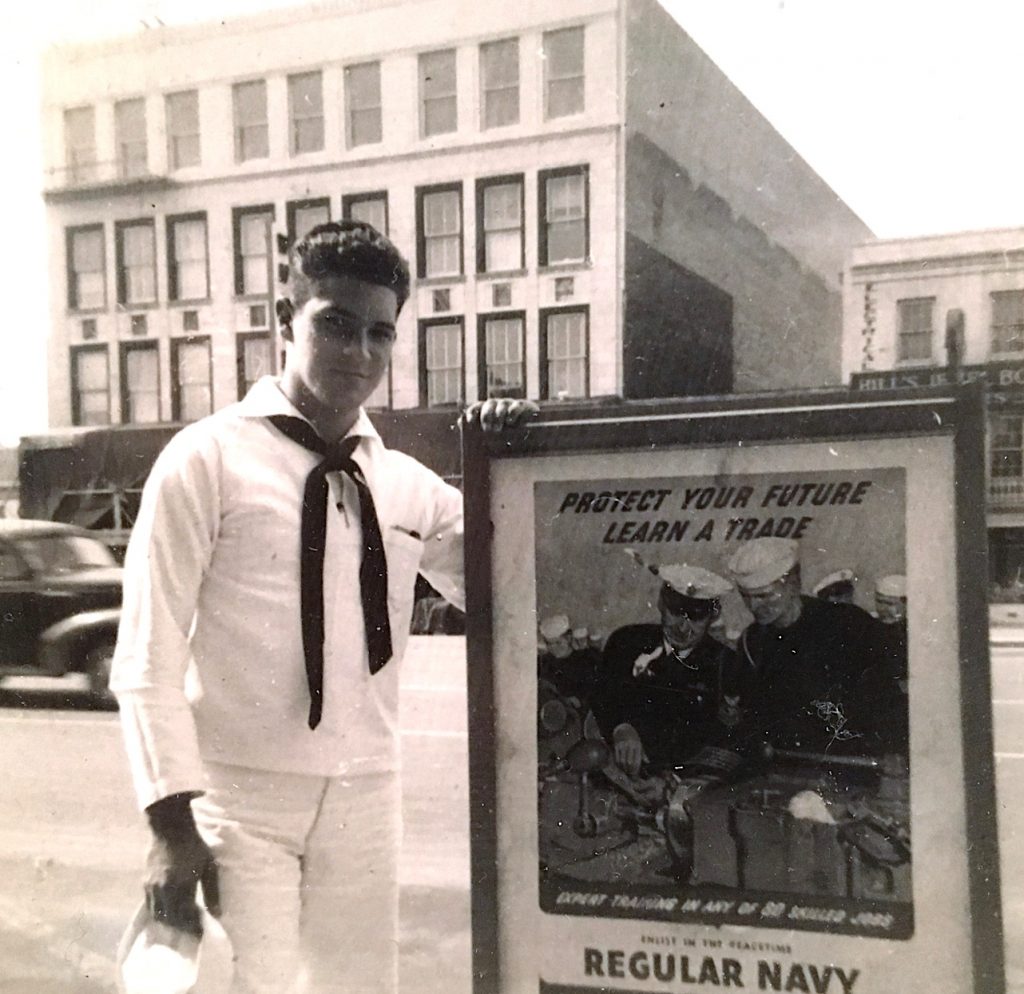
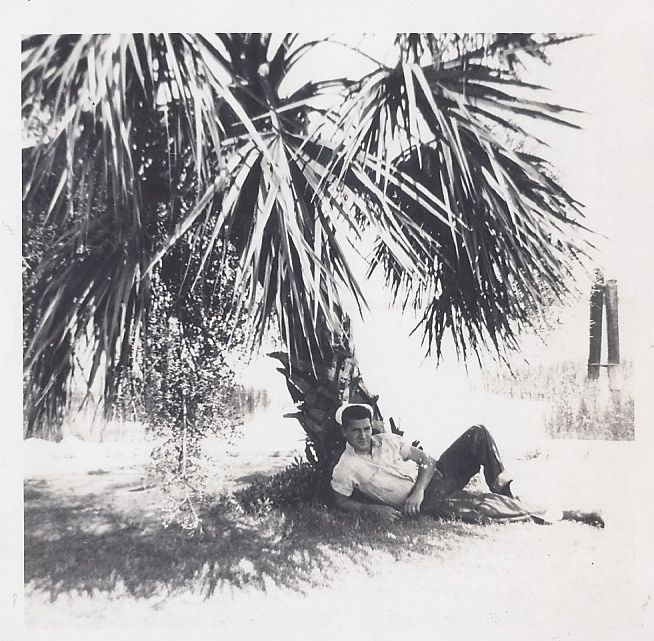
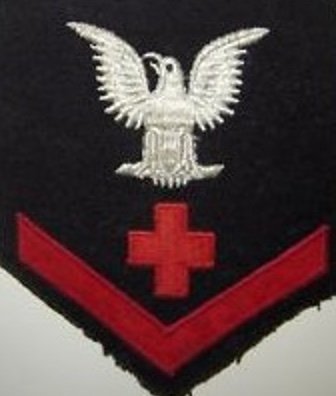
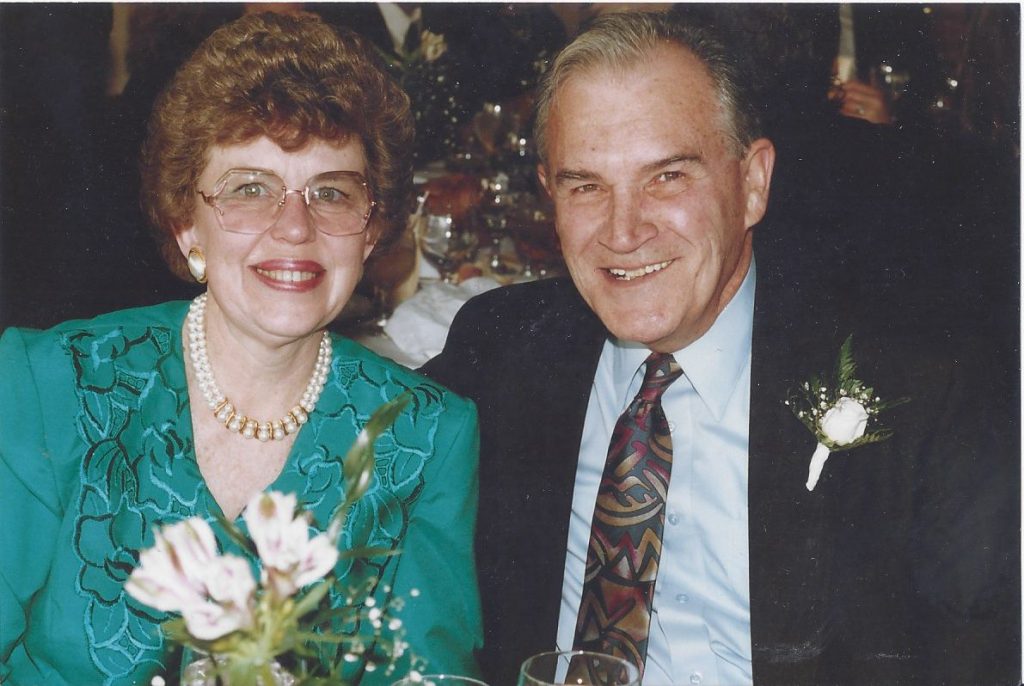
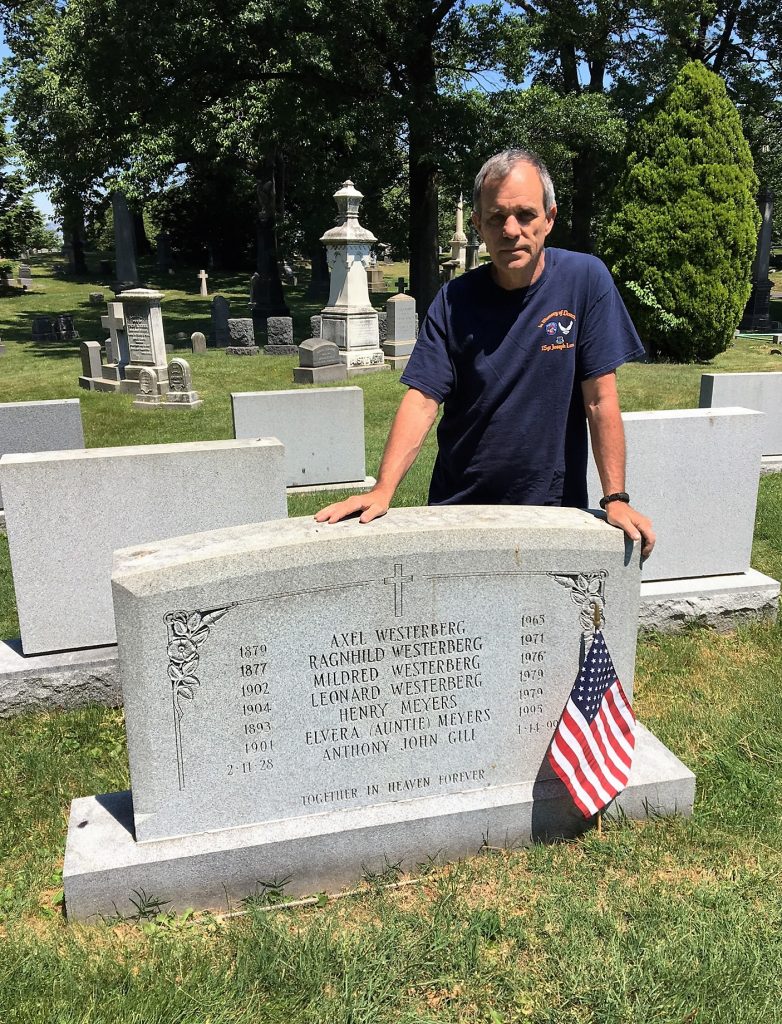
GIORDANO, ANTHONY (1920-1983). During the year 1920, Anthony was a popular name for boys born to Brooklyn families with the surname Giordano. There are at least four listings for Anthony Giordano in the census of 1930. Beyond their shared name, certain threads tie them together. For each, at least one parent was born in Italy, there was at least one older sibling one of which being a brother, however their fathers were employed in vastly different occupations. While it would be fascinating to learn if they knew one another, if their paths crossed during the war, we will confine ourselves to this Anthony Giordano. Born in 1920 to parents Frank and Rose, Anthony was raised with his older brother Joseph in the house the family owned at 7115 13th Avenue in Brooklyn, according to the 1930 census. Frank and Rose both had been born in Italy, and in the United States Frank worked as a tailor. Both boys were in school, according to that census, and would continue their studies through high school and into college, where the 1940 census found them. By that year, their father had changed jobs, becoming a bus driver. The family still lived in the same house.
On June 9, 1941, Anthony and his fiancée Rose Diomede were granted a marriage license. Less than a month later, on July 1, 1941, 21-year-old Anthony Giordano registered for the draft; his registration recorded him as standing at 5′ 5″ tall and weighing 150 pounds. He had moved from his family home to a place that he shared with his wife at 8 2nd Place. He was already familiar with the build-up for the war, working as a civilian providing transportation services to the Brooklyn Army Terminal. The terminal was the largest military supply base in the United States following its completion in 1919 through World War II, and employed 20,000 military and civilian workers during the latter. According to the Terminal’s website, it was the headquarters for the New York Port of Embarkation, the final point of departure for soldiers heading overseas to serve. Giordano’s service there may have kept him from entering the Army sooner, but on March 5, 1943 he officially entered its ranks, and served until October 12, 1945. Following the war, he and his wife shared their home with three children, Marlon, Vincent, and Veronica, and years later shared their lives with grandchildren John and Melissa. Rose, born a year earlier than her husband, lived nearly 20 years after his passing, and is remembered as a loving wife, mother and nana. Section Rose, lot 43900.
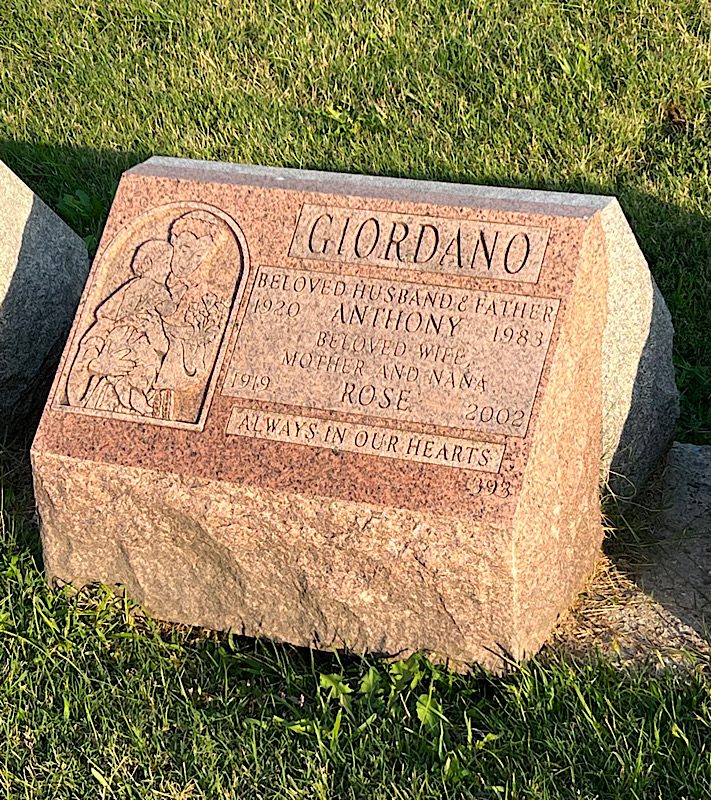
GOLUB, LEON ALBERT (1922-2004). Private, Army Reserves, assigned to Army Corps of Engineers. Leon Golub, a globally celebrated, figurative expressionistic artist, was born in Chicago. His Cook County, Illinois birth certificate lists his father as Samuel Golub and his mother as Sarah Sussman. By the time the 1930 federal census was recorded, Golub was eight years old and living at 1137 Independence Boulevard in Chicago with his parents, both of whom were born in Russia, and his 13-year-old sister, Gail P. Golub. His father was 44 and his mother 38. The 1940 federal census, when Golub was 18, shows the family living at 3510 Pine Grove Street in Chicago. Golub was in his first year of college and living with his parents and sister.
Golub registered for the draft on June 30, 1942, while he was a student living at 7154 Yates Avenue, Chicago. He listed Sarah Golub, his mother, as his contact. He had brown hair and eyes, with a dark complexion, was 5′ 11″ and weighed 135 pounds.
After graduating from the University of Chicago, where he received a B.A. degree in 1942, Golub enlisted in the Army Reserves at Camp Grant, Illinois, on March 4, 1943, according to Britannica. World War II hospital admission records show that he was hospitalized in April 1944 for acute nasopharyngitis and in October 1944 for acute tonsillitis.
From 1947 to 1949, he studied under the G.I. Bill at the School of the Art Institute of Chicago (SAIC), receiving a B.F.A. in 1949 and an M.F.A. in 1950 as per the broadartfoundation website. The 1950 federal census lists his family living at 7158 Gates Avenue in Chicago, with Sarah as the head of household. Gail and Leon were both living with her, as was her 66-year-old elder brother Morris Sussman. Leon Golub was attending school.
In the 1950s, Golub was a leader of Chicago’s figurative movement challenging the dominant styles of Abstract Expressionism and Pop Art, per the aforementioned website. He was involved with other Chicago artists, forerunners to the Chicago Imagists, who were labeled the “Monster Roster,” because of their affinity for often grim, mystical figurative work. He was featured in a 1955 ARTnews article, “Is There a New Chicago School?,” and included in the 1959 Museum of Modern Art exhibition, New Images of Man.
It was Art Institute in Chicago that Golub met the artist Nancy Spero. They were married in 1951, soon after her return from studying painting in Paris, and remained married and artistic collaborators until his death in 2004. The couple lived in Italy in 1956. Golub taught briefly at Northwestern University and Indiana University before moving to Paris in 1959. They returned to the United States in 1964, settling in Manhattan, and Golub became involved in the Vietnam-era peace movement. During this period, his work was inspired by Greek tragedies and ancient mythology. Another group of later paintings, his “Mercenaries” series, profiled the harshness of paramilitary soldiers in Latin America and South Africa. He worked with unstretched canvases, giving his paintings a raw and gritty quality, according to britannica’s website and became known as a critic of the abuse of power, whether domestically or overseas.
The United States Public Records Index shows that Golub lived in Manhattan at 171 West 71st Street in Manhattan in 1974 and at 530 LaGuardia Place in 1978. He and his wife had adjoining studios in Greenwich Village. Golub taught at the School of Visual Arts in Manhattan and at Rutgers University in New Jersey, according to his August 24, 2004 New York Times obituary. The Golubs had three sons: Stephen Golub (1953-2020) was a widely respected economics professor at Swarthmore College; Philip Golub is Professor of International and Comparative Politics at the American University of Paris; and Paul Golub, born in 1961, is a theater director and acting teacher based in France. Leon Golub had six grandchildren.
Golub’s artwork is held in the permanent collections of the world’s major museums, including the Brooklyn Museum, the Uffizi in Florence, Italy, the Metropolitan Museum of Art, the Whitney Museum, the Jewish Museum, and the Museum of Modern Art in New York, the Art Institute of Chicago, and the Tate Gallery in London, United Kingdom.
Leon Golub was living in Manhattan when he died of complications after surgery, on August 8, 2004. His August 12, 2004 obituary in The Guardian sums him up: “Leon was an unforgettable man, a great mentor, a big-hearted painter of unforgiving images, whose worth has yet to be fully acknowledged.” He is interred with Nancy Spero, his wife and artistic collaborator, who died in 2009. They share a granite gravestone which has their names and life dates carved into it. The front of the gravestone also bears carvings of figures, across its bottom, similar to Nancy Spero’s “Cri de couer,” which has been described as “a passionate cry against war.” However, some critics have interpreted “Cri de couer,” and these carvings on their gravestone, as mourning for her husband. On the back of the gravestone are carved two lionesses; Leon Golub viewed himself as a fighter and a hunter, a conscience of the world. “Live & Die Like a Lion” was the exhibition of his work that toured internationally after his death. Section 106, lot 45363, grave PREM.
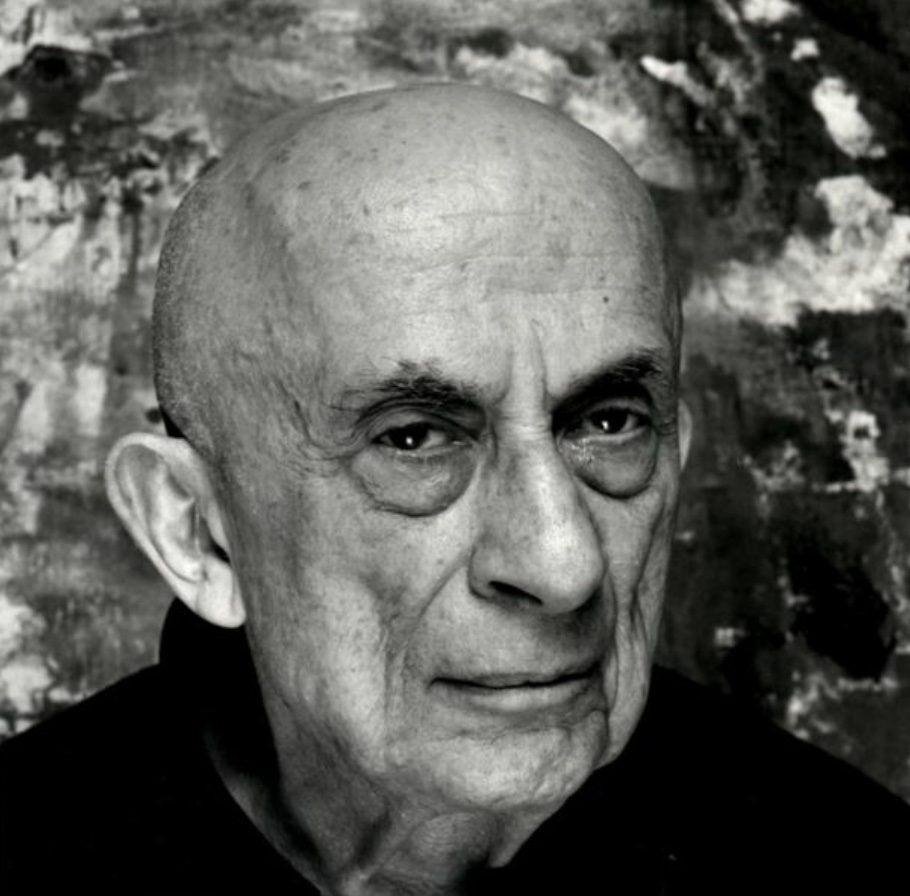

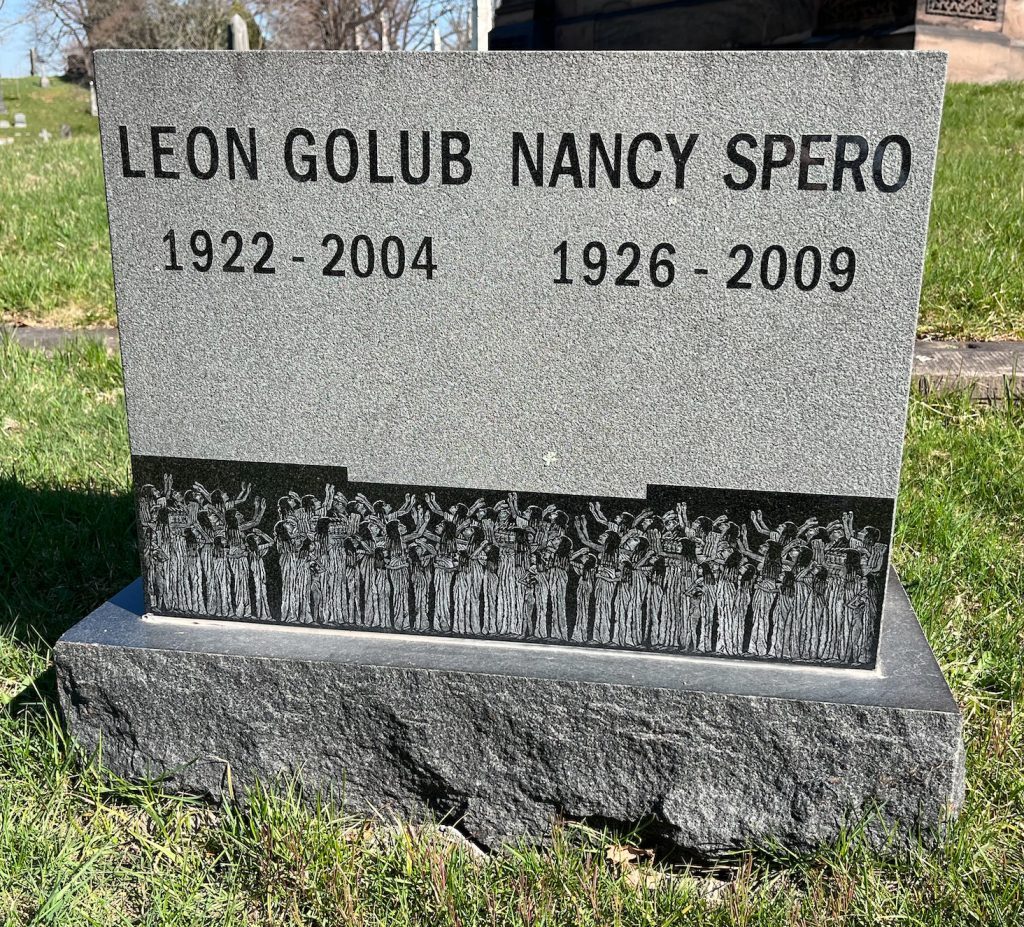
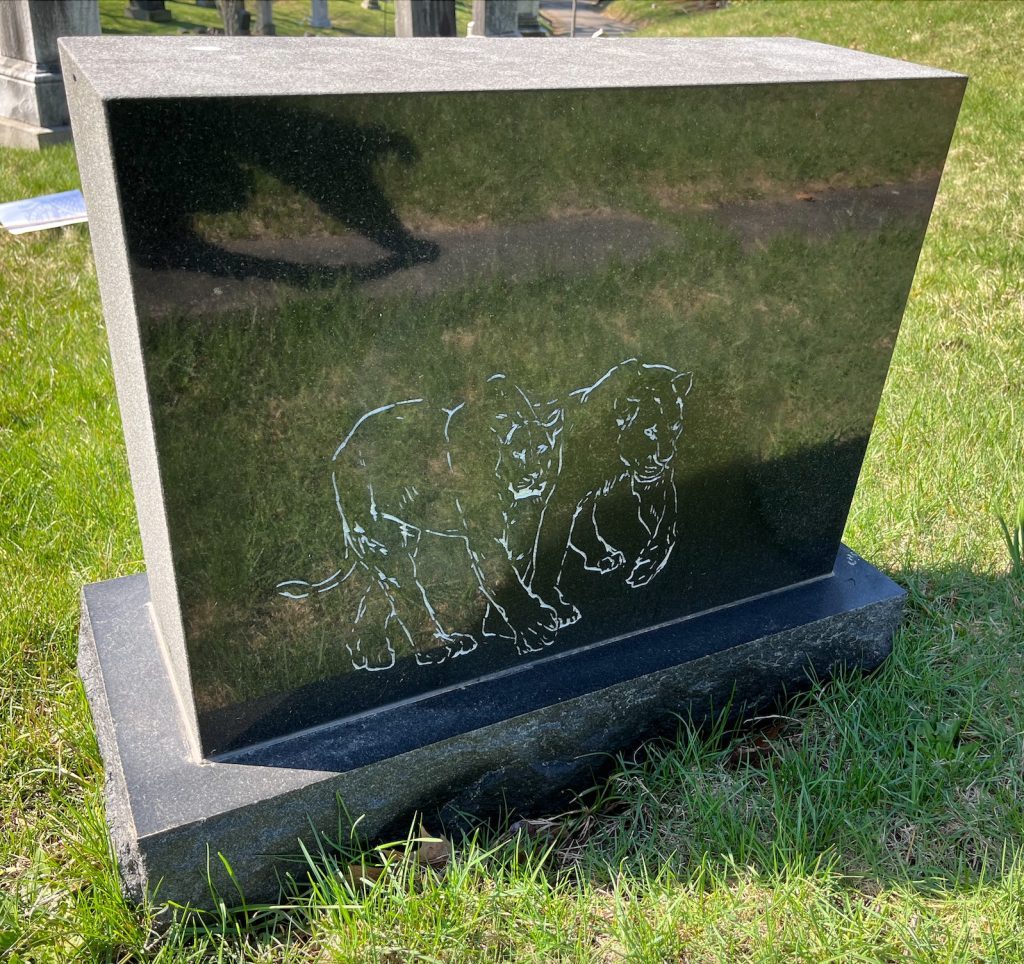
GOVERNALE, FRANK (or FRANCESCO) J. (1914-1982). Corporal, 547th Field Artillery Battalion, Seventh United States Army. Born Francesco Governale in Harlem, Frank Governale was living with his parents, John and Nancy Governale, in 1920, according to the federal census of that year. Both parents were born in Italy and Italian was their native language. Governale had six siblings: Lucille, age 18; Josephine, age 14; Francis, age 12; Joseph, age 10; Morris, age 7; and Concetta, age 3. Lucille Governale, Frank Governale’s grandmother, age 60, and Mary Govissel, his aunt, age 22, also lived at the same address.
All of the Governale children were living with their parents five years later, per the 1925 New York State census, but, by the 1930 federal census, the two eldest daughters were no longer living in the household 406 East 101st Street. Frank was attending school.
The United States Marine Corps muster rolls show that Corporal Frank Governale, with a muster date of June 1936, was stationed with Company A, 3rd Battalion, Fleet Marine Corps Reserve, at the New York Navy Yard in Brooklyn. His draft registration card, signed when he was 25 years old, lists his mother, Nancy Governale, as his contact. They were living together at 406 East 101st Street in Manhattan, and Governale was unemployed. He was 5′ 6″ tall, weighed 150 pounds, with hazel eyes, brown hair, and a light complexion.
Governale and Frances A. Corallo were married during World War II, on June 12, 1943, at St. Lucy’s Church, 344 East 104th Street in Manhattan.
Governale was a true hero during World War II. Jill Fiordilino Marro, Governale’s eldest grandchild, reports that he was a medic with the Seventh Army in Europe and was awarded the Bronze Star Medal for heroic achievement in a combat zone. He also helped to liberate the Dachau Concentration Camp.
The Seventh Army, absorbed into the newly created Sixth United States Army, fought its way across the Rhine River into Germany in the spring of 1945. According to a document entitled “Travels of the 547th Field Artillery Battalion,” the unit boarded the USS Uruguay on December 8,, 1944, at the 42nd Street pier, and then left New York Harbor the next day for Southampton, England, where the ship docked on December 20, 1944. They traveled by rail from there to Portland, England, and, on December 22, 1944, the battalion sailed on a tank landing ship to Le Havre, France. They then traveled to Camp Twenty Grand, a temporary United States Army “tent city” in Normandy, France, where they stayed from February 17, 1945 until March 5, 1945. They then entered Germany with the Ninth Army and stayed overnight in Aldsdorf, North Rhine-Westphalia. From there, the battalion moved to various locations within the area of North Rhine-Westphalia in Germany – Sandfort, Bönninghardt, Menzelen, Büderich, Lintfort, Detteln (here they crossed the Rhine River), Mengede, and Grossholthausen – from March 7, 1945 to April 16, 1945, when they started their move toward the Elbe River. They stayed overnight in the forest near Luntorf and then moved on to Timmerlah, near Braunschweig (Brunswick), in Saxony, and crossed the Weser River on April 17, 1945. On April 20, 1945, they were in Gnadau in Saxony-Anhalt, and, on May 11, 1945, they moved to Weferlingen, near Helmstedt. It is there that the document ends. During their time in Germany, in addition to the Ninth Army, they supported the British 2nd Army.
Governale’s World War II era dog tag lists his wife as his next-of-kin, with her address at 60-43 71st Street, Maspeth, Queens, New York, his religion as Catholic, and his blood type as Type A. He was discharged from the Army on November 30, 1945. According to Jill Marro, he never spoke to his family about the war or his heroic deeds.
Ms. Marro related that her mother and uncle were born when the family lived at 1168 Stratford Avenue in the Bronx, New York. By 1950 the family was living at 25 Pratt Street in New Rochelle, New York, per the 1950 federal census, and their children, Joseph F. Governali and Bernadette F. Governali, were 7 and 4 years old. Governale was a butcher and was the proprietor of his own business. The Governales moved to Mount Vernon, New York, where they lived for many years, but also had a country home in Foster, Rhode Island, near Providence. That is where Governale passed away, on May 30, 1982. He was interred at Green-Wood on June 3, 1982; his wife had been interred there just two days before, on June 1, 1982, in grave 2. Section 41, lot 44317, grave 1.
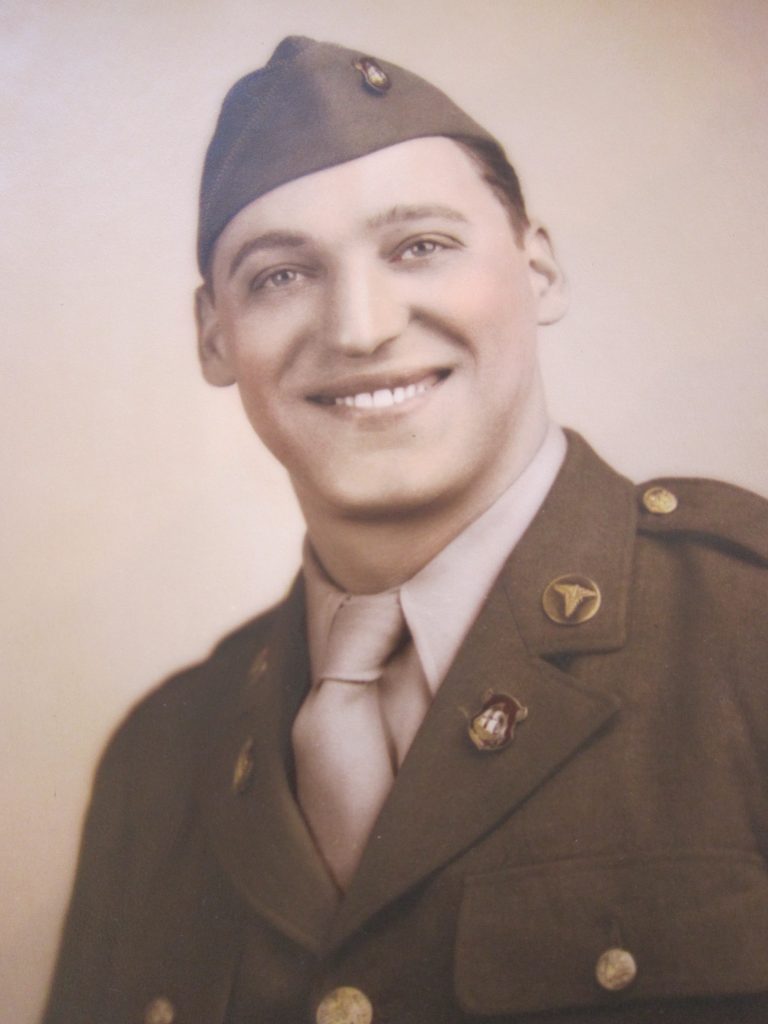
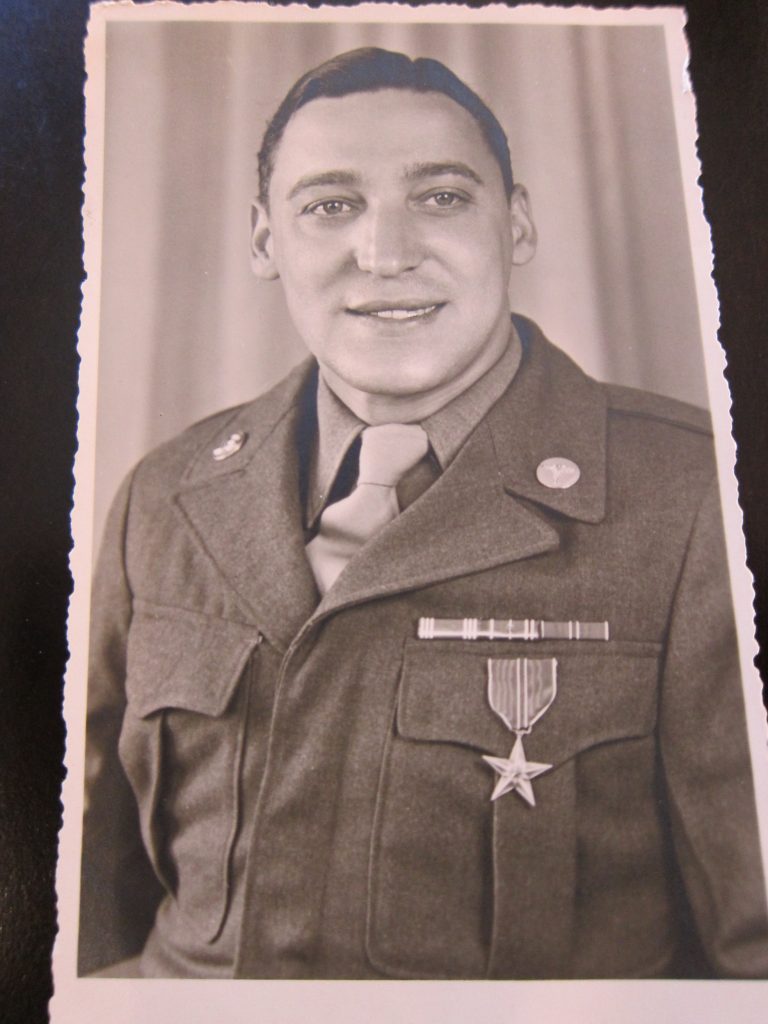
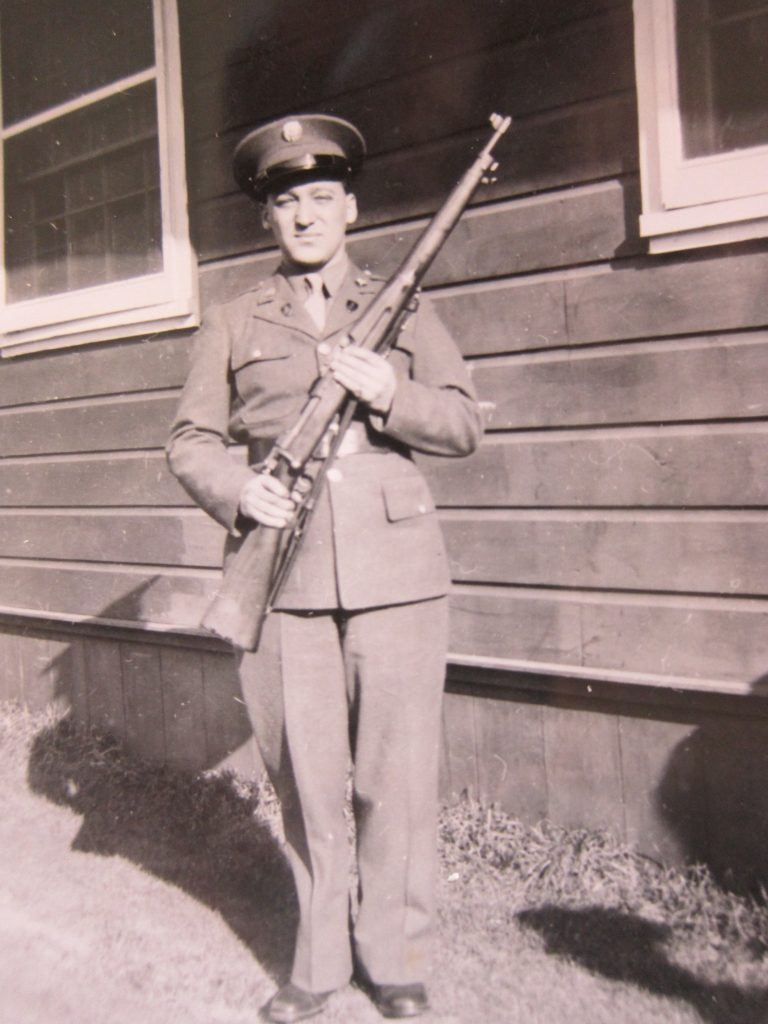
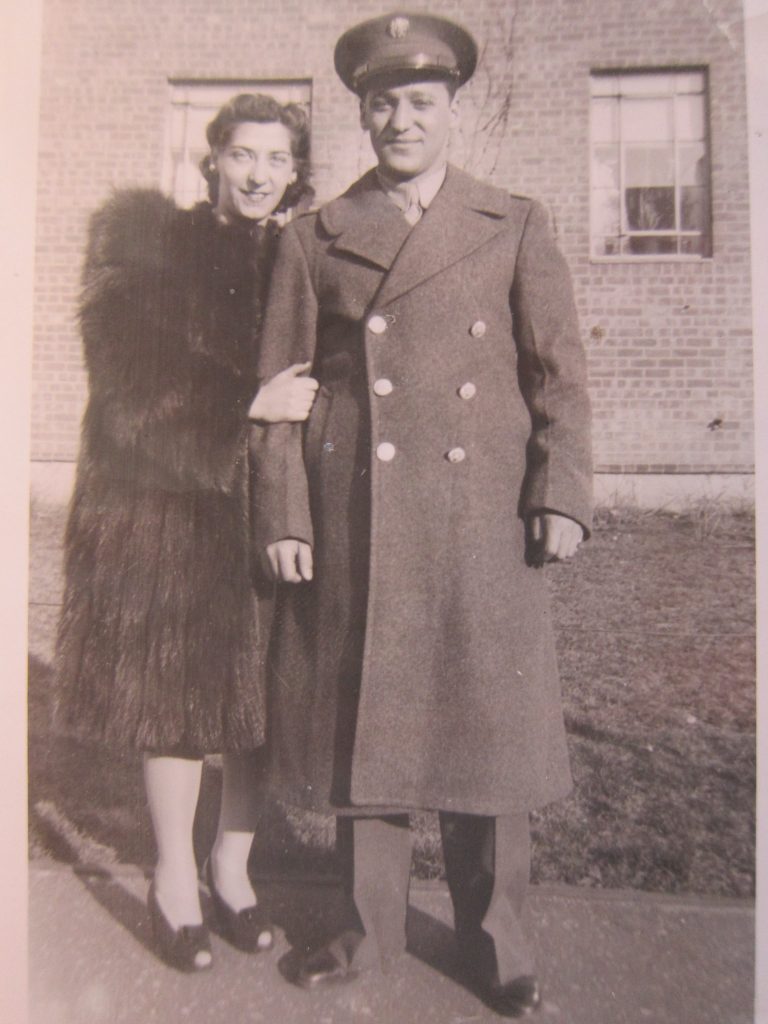
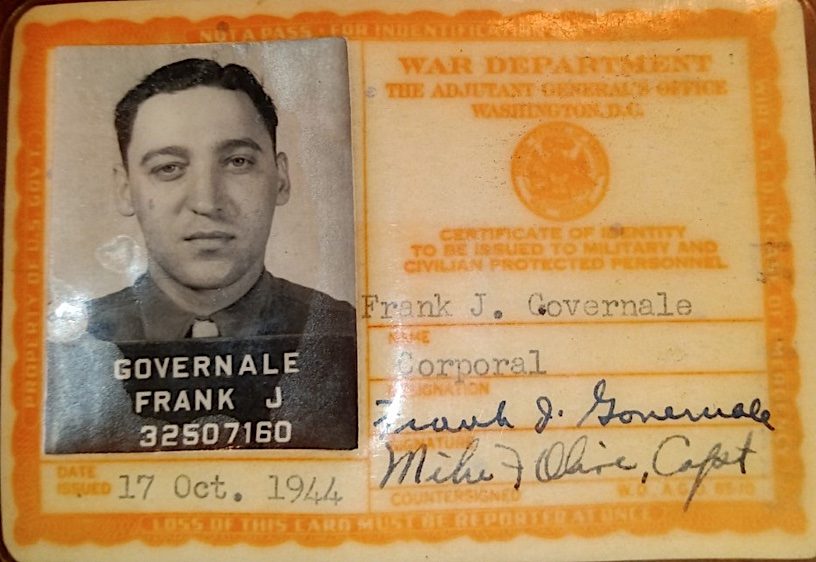
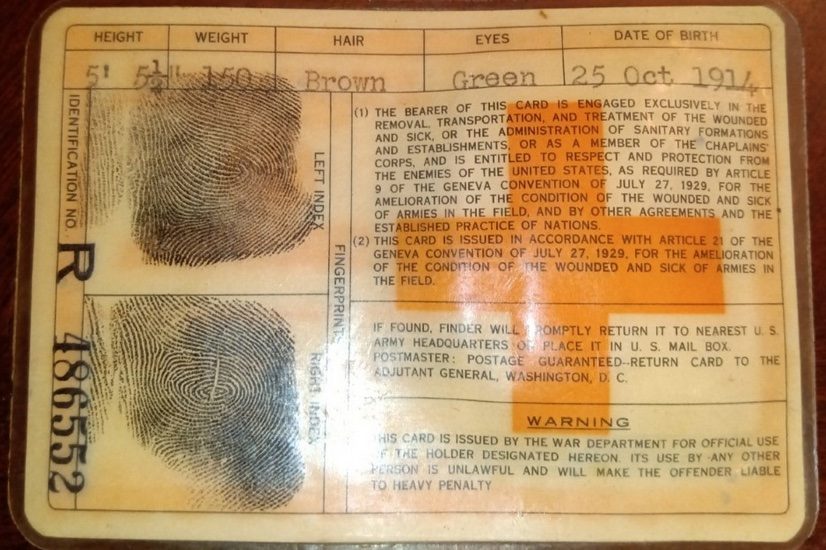
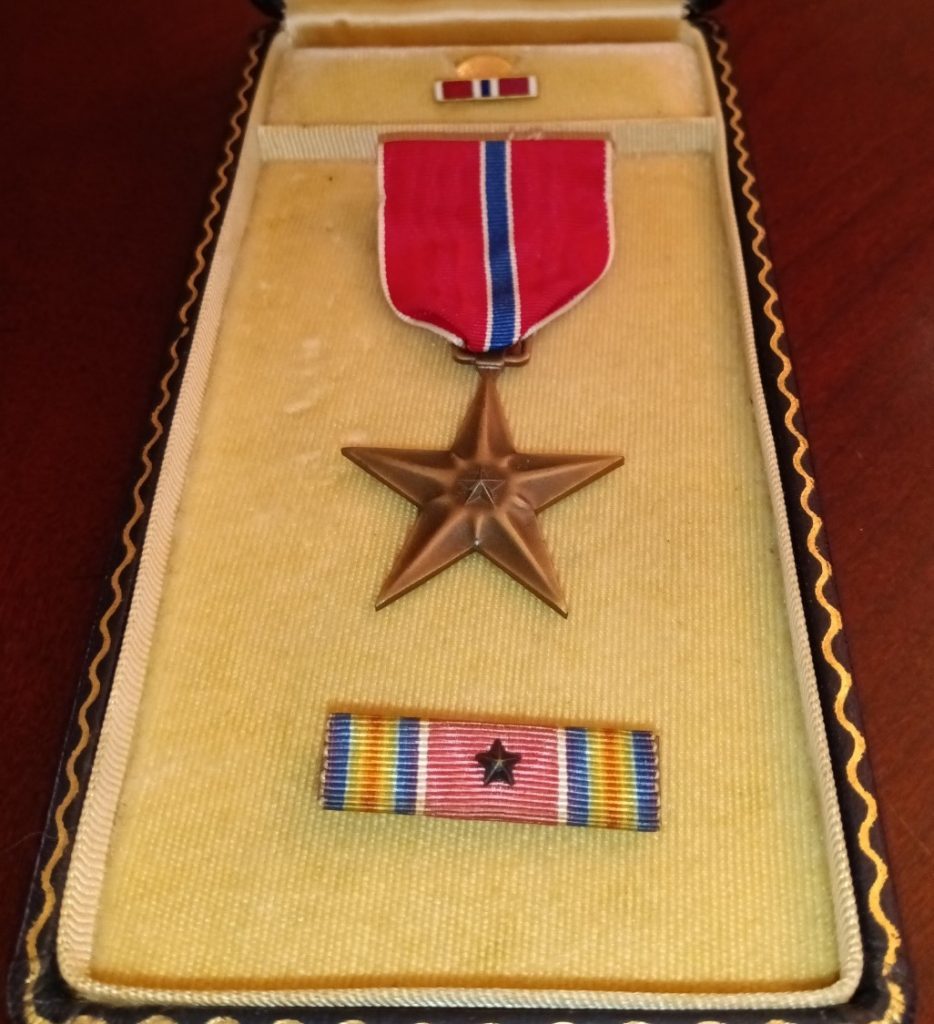
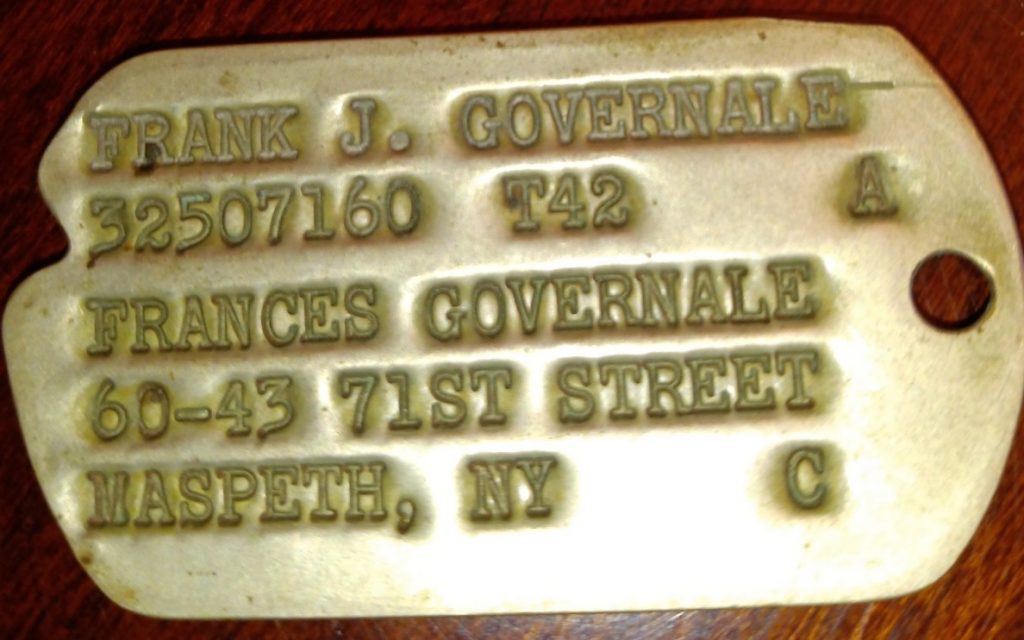
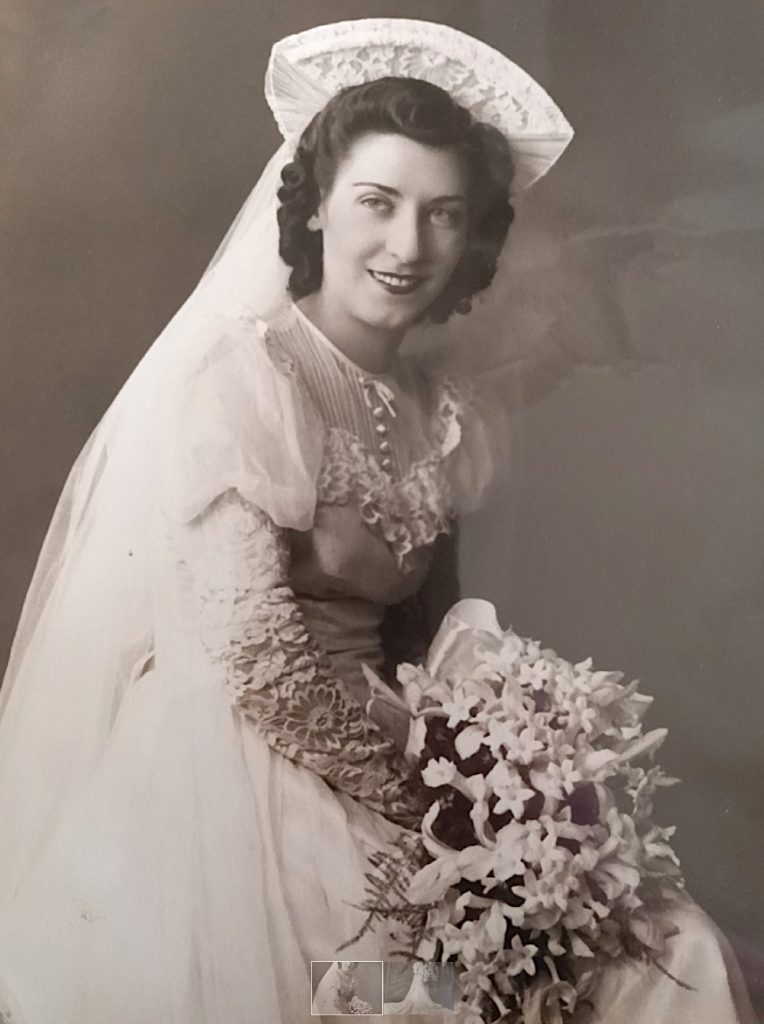
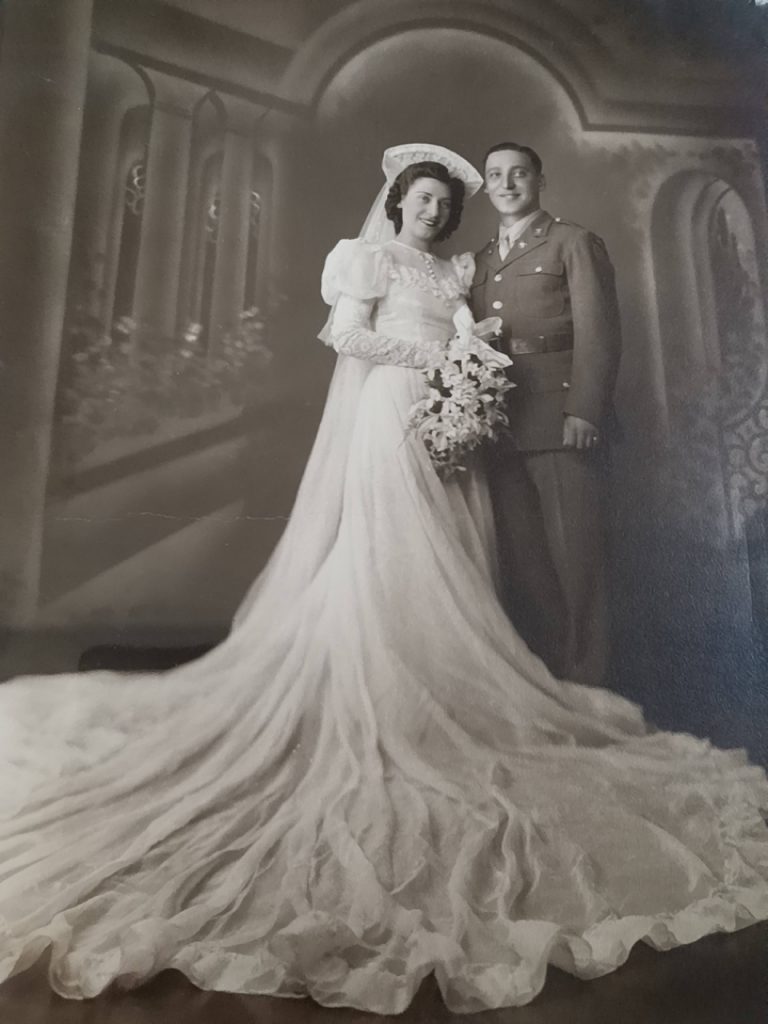
GRAVENHORST, CHARLES KIRCHOFF (1924-2018). Cannon company sergeant, 407th Infantry Regiment, 102nd Infantry Division, United States Army. Charles was born in Brooklyn to Paul Gerhard and Linda Kirchoff Gravenhorst. The 1925 New York State census shows infant Charles living in Brooklyn with his parents and older brothers, George, age 9, and Paul, age 5. Olga Trelland, possibly a servant, also lived in the household. As per the 1930 census, the family lived at 27 Prospect Park West. Margaret Weisner, a servant, was living in the household and Charles was attending school.
As a student at Brooklyn Poly Prep, Charles was named to the honor roll in fifth grade, as per the Brooklyn Daily Eagle on October 17, 1934. The Brooklyn Daily Eagle noted on March 11, 1938, that Charles, a Secord Form student, had made honor roll. His family traveled aboard the Monarch of Bermuda on April 2, 1938, presumably on vacation. Gravenhorst made the credit list, a distinction below honor roll, as featured in the Brooklyn Daily Eagle, October 18, 1839. At the time of the 1940 census, Charles was a high school student. His family was living at 234 Eighth Avenue in Brooklyn. Margaret Weisner was still living with them. His obituary in Patch, a local news source, confirms that he attended Poly Prep Country Day School, graduated in 1942, and then entered Princeton University. Although sources indicate his attendance at Princeton, his name is in the 1944 yearbook for New Jersey State Teachers College at Trenton.
At the time Charles filed his World War II draft registration card, he was 18 years old and living at 234 Eighth Avenue in Brooklyn. He had a home phone and named his father as his emergency contact. The accompanying registrar’s report states that he was 6′ 1″ tall and 160 pounds with blue eyes, brown hair and a light complexion. World War II interrupted his education. Gravenhorst’s Army enlistment record documents that he enlisted as a private at New York on March 23, 1943, and that he was 68″ tall and 148 pounds. His obituary in Patch confirms that he enlisted in 1943 and served as a cannon company sergeant in the 407th Infantry Regiment, 102nd Division, known as the “Ozarks.” He was awarded numerous decorations for his service including the Bronze Star for heroic achievement during the Battle of the Bulge.
Gravenhorst returned to school after his military service and became a magna cum laude graduate of Princeton University in 1946 with a major in history. The subject of his undergraduate thesis was President Grover Cleveland’s second administration. According to the 1950 census, he was living with his parents at 35 Prospect Park West in Brooklyn, single, and working as a production manager in the advertising industry.
He married Ellen Slatt at the Lutheran Church of the Epiphany in Hempstead, followed by a reception at the fashionable Garden City Hotel on Long Island on September 13, 1952. Some details of their marriage plans had been announced in the Brooklyn Daily Eagle the previous month, on August 17. That feature story reports that Charles’s father had died. Charles’s brother George would be the best man and his brother Paul and brother-in-law Axel would be ushers at the wedding. The Brooklyn Daily Eagle gave additional details of their wedding on the Society page on September 15, detailing the dresses of the bride and others in the wedding party. That story noted that Ellen attended Hunter College and worked for General Electric Co. in Manhattan and that Charles worked for the advertising firm of Benton & Bowles and was a member of the Princeton Club. The couple honeymooned in Virginia. Their marriage announcement in Newsday confirms Gravenhorst’s service in the Army during World War II. Charles and Ellen first lived in Fresh Meadows, Queens, then settled on Long Island, in Garden City, Northport and Huntington. The couple had four children. United States Public Records Index notes that he lived at 23 Lisa Drive in Northport and had a second address at 25 Cedar Valley Lane in Huntington, Long Island.
In civilian life, Charles utilized his photography skills and had a successful career in print, radio and television advertising, beginning at Benton & Bowles and then as a vice president at Gaynor & Ducas, Gordon & Short, Inc., and Bozell & Jacobs, Inc. He traveled daily to New York City on the Long Island Railroad when he was not traveling internationally. He specialized in international airline travel and also had other clients including IBM and the Montreal Exposition of 1967.
From 1995-2002, he lived at 944 Santa Alicia Drive in Rohnert Park, California. As per his obituary in Patch, he was married to Ellen for more than 65 years, and had lived in Northport, Long Island, for nearly 20 years. He died in Sonoma, California, where he lived near family in Rohnert Park. Section 206, lot 34151.
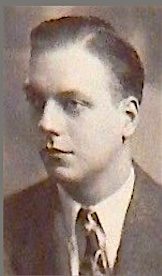
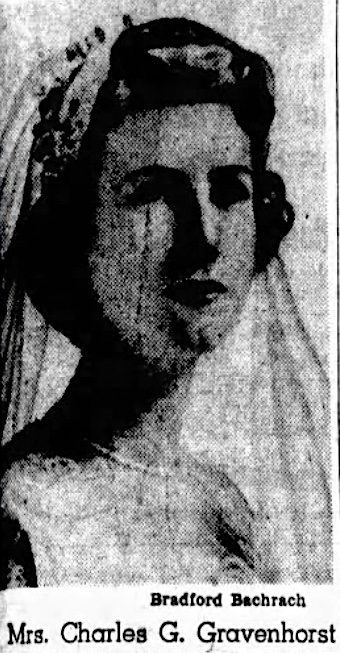
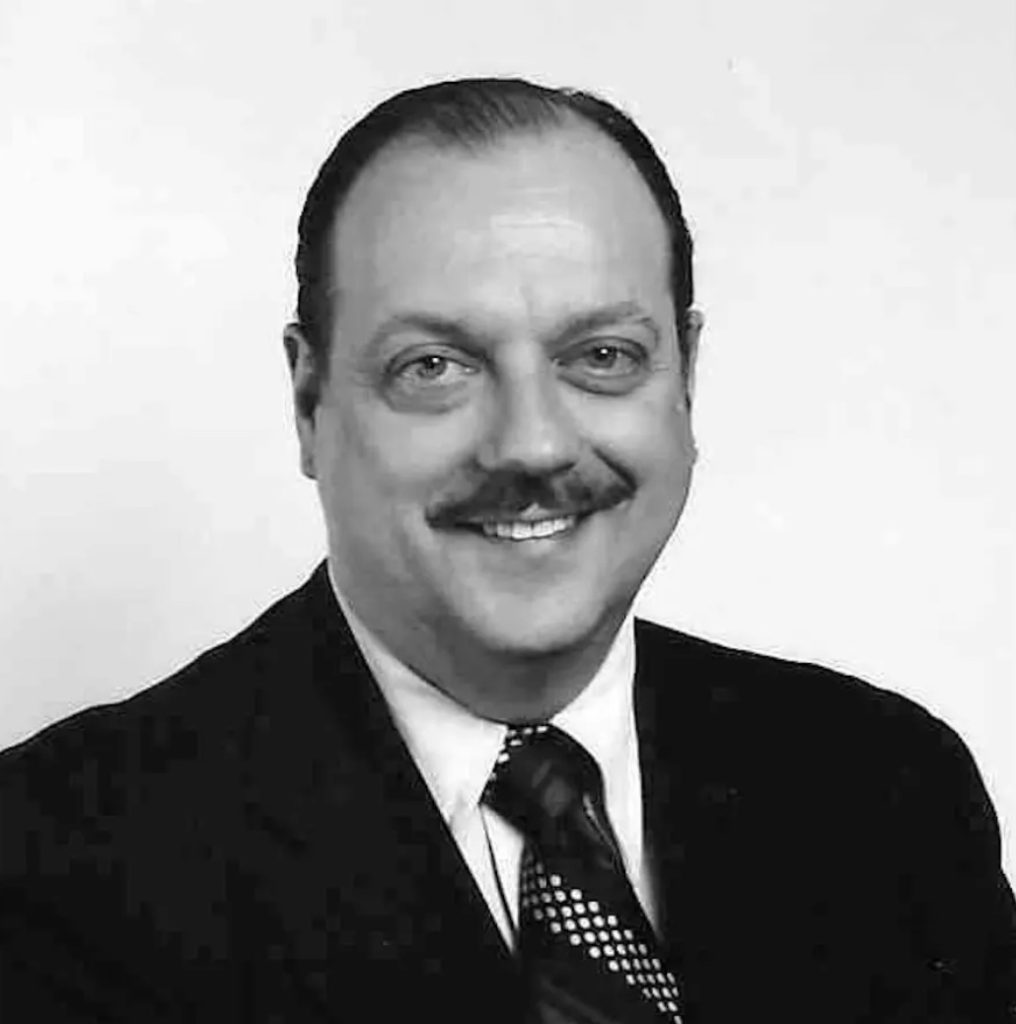
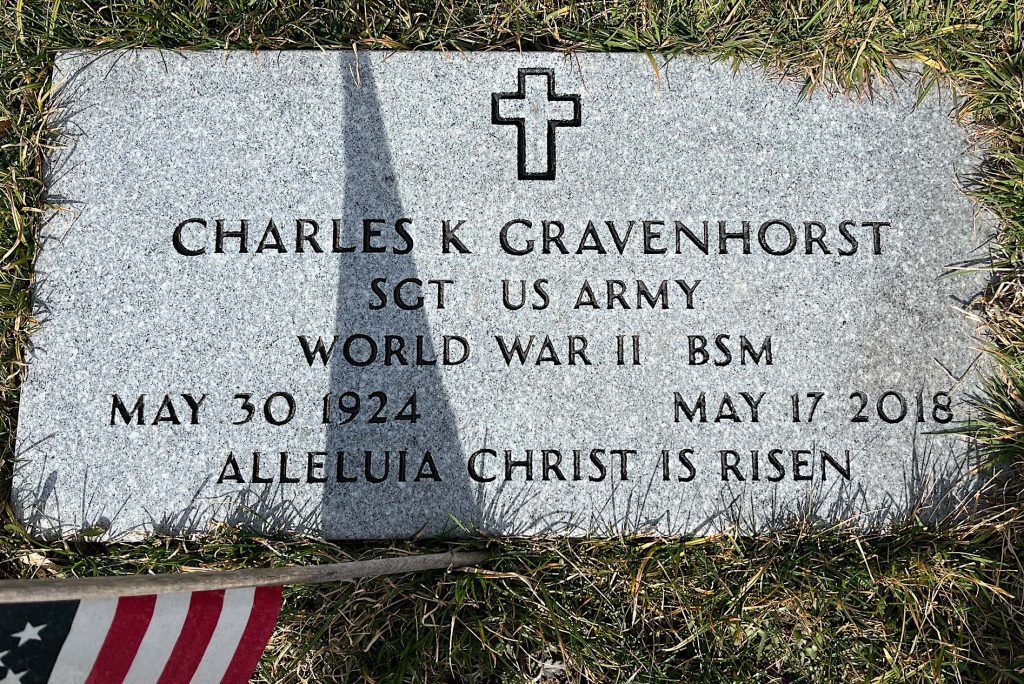
GRILLO, JOSEPH JOHN (1912-1966). Private, United States Army. According to the 1920 census, Joseph J. Grillo was residing in Brooklyn with his parents, Joseph and Ida, and his siblings, Mario, Carmella, Paul, Alfred, John, and Helen. His father, also Joseph Grillo, was born in Italy and worked as a laborer. He immigrated to the United States in 1901, while his wife, Ida, immigrated in 1908 with their son Mario, who was 12 in 1920. Joseph J. Grillo and the rest of his siblings were all born in New York. The 1920 census lists Joseph’s age as six, but other records indicate that he was born in 1912. The 1925 New York State census lists 12-year-old Joseph J. Grillo residing on Fort Hamilton Avenue in Brooklyn, with his parents and nine siblings. Angelina, Rose, and Mike had been born since the 1920 census.
By the 1930 federal census, Joseph J. Grillo was 17 years old, still residing on the same street in Brooklyn, now renamed Fort Hamilton Parkway, and was no longer attending school, but working as a printer in a shop. His father worked as a laborer. The 1940 census shows that Joseph J. Grillo, at 27 years of age, had completed his education through the first year of high school and was working as a driver for a coal yard. His father continued his employment as a laborer. The family, including siblings Paul, Alfred, John, Helen, and Rose, resided on 41st Street in Brooklyn.
Grillo’s draft registration card, filed on October 16, 1940, when he was 28 years old, shows him living at 1102 41st Street in Brooklyn, with his father, living at the same address, as his contact. Joseph was 5′ 9″ tall and weighed 168 pounds, with a dark complexion and brown eyes and hair. He worked for Burns Brothers at 163 6th Avenue in Brooklyn.
According to his enlistment record, Joseph J. Grillo enlisted in the Army on March 14, 1942, at Camp Upton in Yaphank, New York. The record indicates that he was married and held the civilian occupation of a driver. His service number was 32227967. That record lists his height as 5′ 7″ and weight as 140 pounds.
Joseph J. Grillo was discharged from the Army on September 17, 1945. At the time of his death, he resided in Brooklyn. Section 134, lot 39100, grave 50.
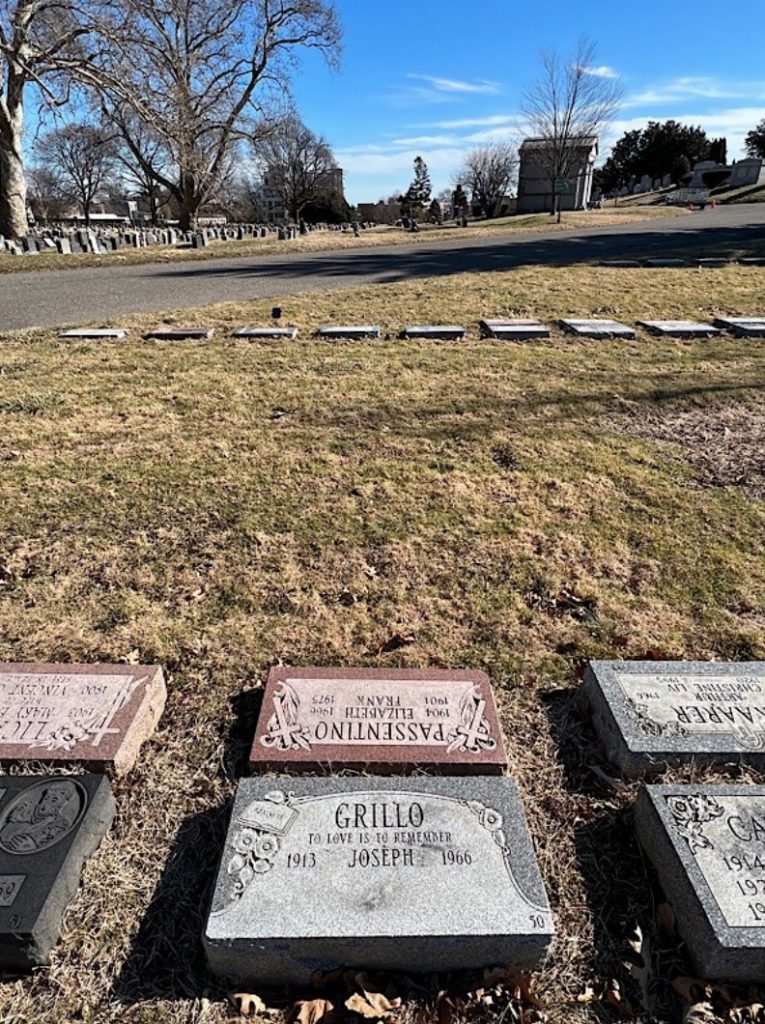
GUARRASI, PHILLIP (or PHILIP) (1920-1997). Corporal, United States Army. According to the 1930 federal census, he was nine years old, born in New York, lived with his parents, Joseph (who was a longshoreman working on the docks) and Frances, as well as eight siblings, and resided on 20th Street in Brooklyn. In 1935, his father, living at 135 21st Street in Brooklyn, became a United States citizen.
As per his 1942 draft registration card, he was living on 14th Street in Brooklyn and was working at E.J. Trum, a paper-goods manufacturer, on Richards Street there. He was 5′ 9″ tall, weighed 150 pounds, and had brown eyes, black hair, and a dark complexion, as well as a scar on his right thumb.
Guarrasi enlisted in the United States Army on October 13, 1942. He was promoted to corporal in March of 1943, as per a report in the Brooklyn Eagle, and was expected to be furloughed from Camp Breckinridge in Kentucky. He took part in the D-Day invasion at Normandy. Guarrasi was discharged from the United States Army on December 31, 1945.
On October 11, 1946, Guarassi married Anna D. Spinelli in Brooklyn. They welcomed a son, Phillip Jr., in 1948. Phillip, the father, died of natural causes. Section 28, lot 44610.
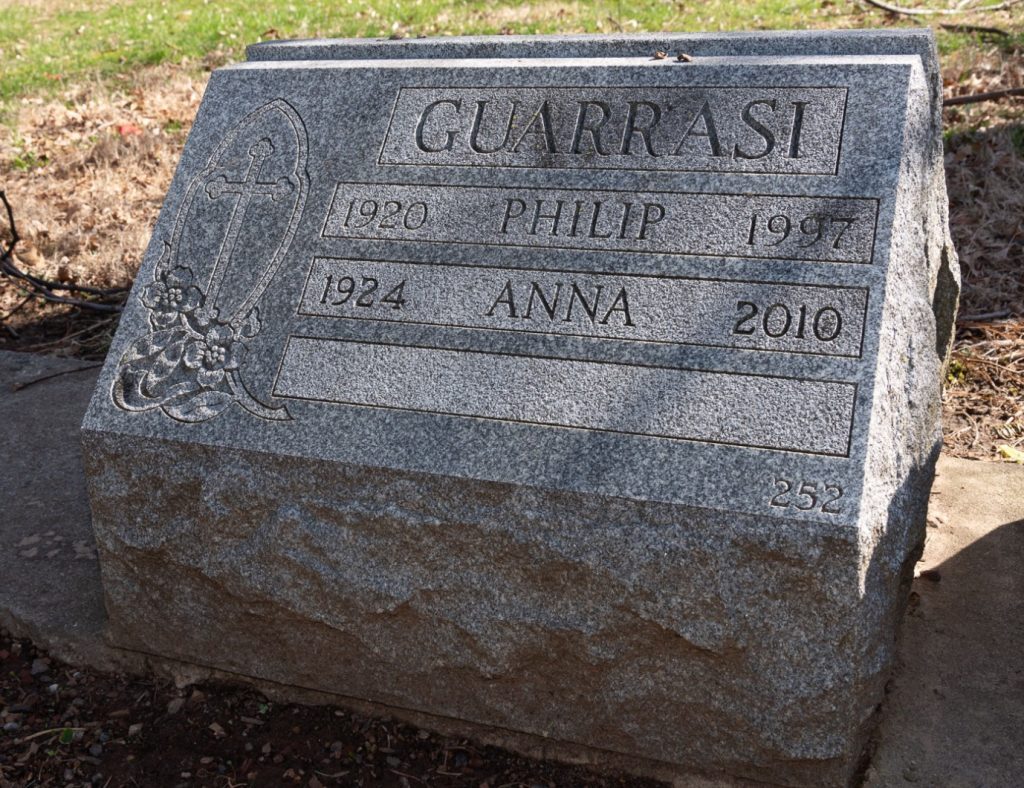
HALLOCK, GERARD (1905-1996). Major, 315th Troop Carrier Group, United States Army. Citing a memorial for Hallock from the Princeton Alumni Weekly, he was born in Pottstown, Pennsylvania and attended the Hallock School, founded by his father. As per his father’s obituary in the Brooklyn Times Union on March 2, 1935, his grandfather, also Gerard Hallock (this veteran’s great-grandfather), was a founder and editor of the New York Journal of Commerce and an organizer of the Associated Press. In addition, Civil War General Henry W. Halleck, who is buried at Green-Wood, was a family member as was Fitz-Greene Halleck, a well-known poet.
The 1910 federal census records that the 5-year-old Hallock lived with his parents, Gerard and Adele, in Great Barrington, Massachusetts. He and his older sister, Martha, were born in Pennsylvania. Both parents were born in New York and his father was a principal of a private school. According to the 1920 federal census, the Hallock family still resided in Great Barrington. The family grew with the births of two sons, Harlan and Richard. His father was employed as a teacher and is listed as head of household. Also residing with the family were three servants and a hired man.
The 1925 Princeton University Yearbook lists Hallock as a sophomore. The Princeton University Yearbook from 1926 records that he was a member of the Princeton Terrace Club, an organization that “provides meals, social events and live performances to its members and their guests.” He also organized the Care Committee where members kept in touch with ailing classmates. According to the Princeton Alumni Weekly, he had engaged in many responsibilities at the university, including class treasurer (1931-1941), president (1941-1946) and was a member of the nominating committee (1946-1996).
As per www.olympedia.org/athletes/86403, Hallock learned to play hockey at Princeton and played defense for four years until his graduation in 1926. In 1931, he co-authored a book with Alexander Sayles, How to Play and Understand the Game, which was published the same year. Hallock continued to play amateur hockey and became a member of the 1932 United States Olympic Ice Hockey Team. The team played at Lake Placid and was awarded a silver medal.
The New York City Marriage License Indexes records that he applied for a marriage license with Marion Wharton on September 15, 1937 in Manhattan. An article in The New York Times reports the couple’s engagement and that Hallock was employed by the City Bank Farmers Trust Company. The couple was married on October 5, 1937 in Islip, New York. A photograph of the couple on their honeymoon in Bermuda is pictured in the October 19, 1937 edition of The Brooklyn Eagle. The New York, United States Arriving Passenger and Crew Lists for the SS Monarch of Bermuda records the couple returned to Ellis Island from Hamilton, Bermuda, on October 29, 1937. The Hallock’s address is recorded as 397 Grand Avenue, Brooklyn. The 1940 federal census notes that the couple lived on East 74th Street in Manhattan and that Hallock was a bank manager.
His World War II draft registration card documents that he lived on St Mark’s Lane in Islip, New York, his wife was his contact person, and he was employed at Citizens Savings Bank, located at 570 Lexington Avenue, New York. His registrar’s report, dated October 16, 1940, describes him as 5′ 7½” tall, 157 pounds, with gray eyes, brown hair and a ruddy complexion. As per his New York Guard service card, he enlisted on January 23, 1941 and was discharged from that service on March 25, 1942. His change of address is recorded as the 51st Infantry.
According to the Princeton Alumni Weekly for “Buzz’s” memorial:
When WW II came, Buzz entered the Air Corps as first lieutenant. As intelligence officer with the 315 Troop Carrier Group (the group’s major responsibility was to deliver ground forces and supplies by parachute beyond the front line), Buzz saw service in seven European theater campaigns, for which his outfit received a Presidential Unit Citation. He held the rank of major when he left the service in 1945. Buzz’s 1937 marriage to Marion Wharton ended in divorce in 1974. He married Virginia “Ginnie” Levick, who died in 1979.
The memorial goes on to report that during the 60th reunion of the class of ’26, in 1986, Hallock was awarded the Class of ‘26 Council Award, on which the following words are inscribed: “The class of ’26 is proud of Buzz Hallock, a man of integrity, talent, and understanding. It thanks him for the work he has done for it and the university.”
As per the Hartford Courant of May 28, 1996, reporting his death, “Hallock served in the U.S. Army as a Major with the 313th (sic)Troop Carrier Group…. He was head of the Board of Trustees of Southside Hospital, Bayshore, New York, and had been Senior Warden for St. Marks Church, Islip, New York before moving to Essex five years ago.” Section ? , lot ?.
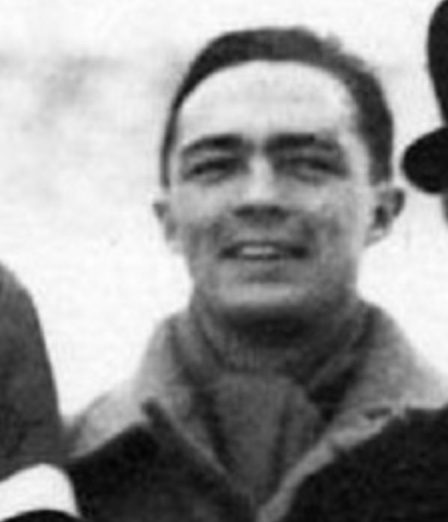
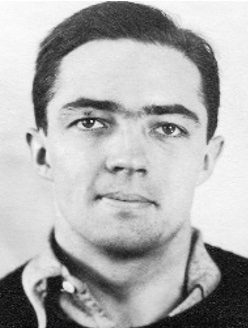
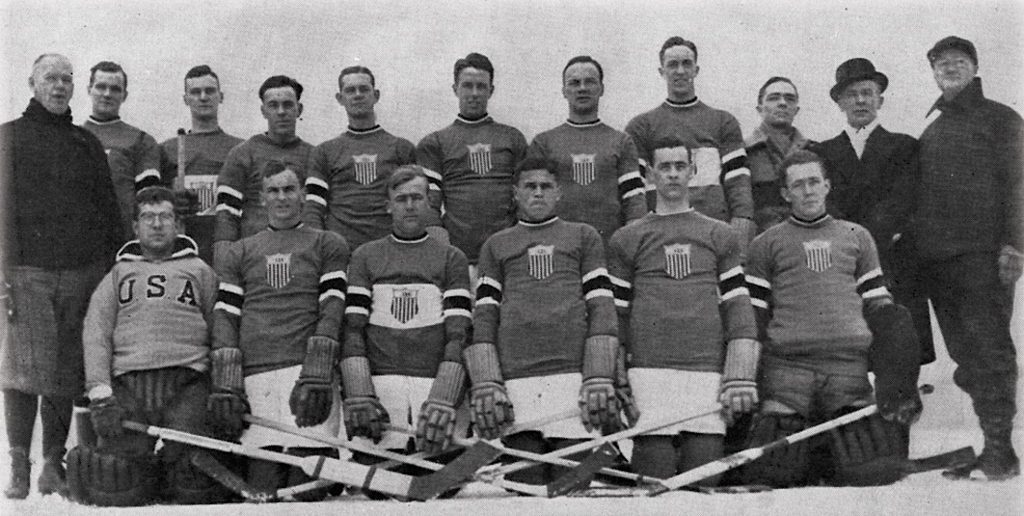
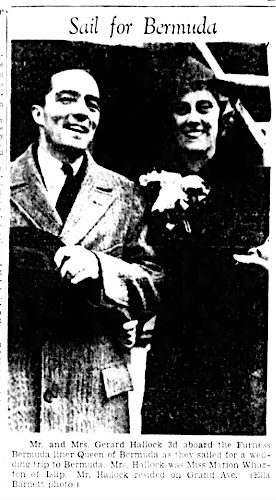
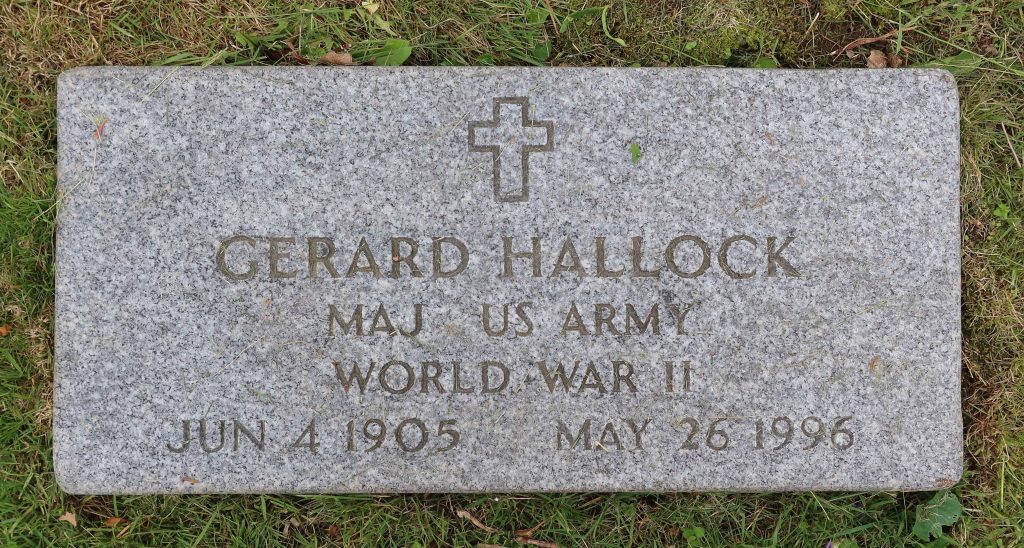
HALPIN, JOSEPH P. (1919-1993). Corporal, Air Force Division, United States Army. Halpin was born in Brooklyn to parents Patrick and Maud Halpin. Halpin’s mother was born in New York and his father in Ireland. As an infant, Joseph appears in the 1920 census with the family living on Seventh Avenue in Brooklyn. At the time his father, Patrick, 42, worked at a bookbinding factory and his mother, Maud, worked in the home.
The 1930 federal census reports that the family had moved to Camden, New Jersey. Joseph, at ten, is now the eldest of four children; William, 8, Francis, 3, and Eileen, 1. His father Patrick is now 51 and continues to work as a bookbinder. His mother Maude, 35, continues to work in the home. By the time of the 1940 censusthe family had moved back to Brooklyn, living on 15th Street. Halpin’s father, Patrick, 61, is working as a social service watchman and his mother Maud is now 46 years of age. At twenty, Halpin has completed three years of high school, and is working forty hours per week in a clerical job at a gas company, most likely Brooklyn Union Gas. His brother William, 18, has completed high school and is about to enter the workforce. Three younger siblings, Francis, 13, Eileen 11, and Evelyn, 9, are in school.
Halpin signed his draft registration card on October 16, 1940, at the age of 21. He listed his mother as “The Person Most Likely to Know Your Address.” At the time, he continued to work for the Brooklyn Union Gas Company. He listed his height as 5′ 6″, weight as 130 pounds, and was further described as white, with a light complexion, and having blue eyes and red hair.Halpin enlisted in the United States Army at Fort Jay on Governors Island, New York Harbor, on August 10, 1942.
According to his son, Patrick, Halpin worked as a power turret and gun sight mechanic. An article on “Individual Training in Aircraft Armament” from IBiblio.org reads:
The combat airplane was far more than a flying machine. It carried an array of complicated lethal machinery: machine guns, cannon, and bombs, as well as the necessary equipment for their operation and control, such as gun turrets, bombsights, and its companion piece, the automatic pilot. All such equipment was designated aircraft [armament].
Since the general airplane mechanic was not qualified to care for this highly specialized equipment, it became necessary to train thousands of experts in armament maintenance–more than 160,000 all told. Before Pearl Harbor, the airplane armament course given at Lowry Field, Colorado, lasted fifteen weeks and included instruction on both fighter and bomber armament. As the war progressed, the curriculum changed frequently, and the number of subjects included were steadily increased.
According to his son, Patrick, Halpin served in the Philippines, and was awarded a Good Conduct Medal, World War II Service Medal, and a Bronze Star. His Veterans Benefits Administration file lists his discharge date as December 17, 1946.
Halpin married Catherine V. Powers on July 3, 1947. The couple had one child, Patrick.
Halpin’s last residence was in Brooklyn. Both Joseph and Catherine died in the same year, Catherine seven months after her husband. Section 94, lot 44607, grave 92.
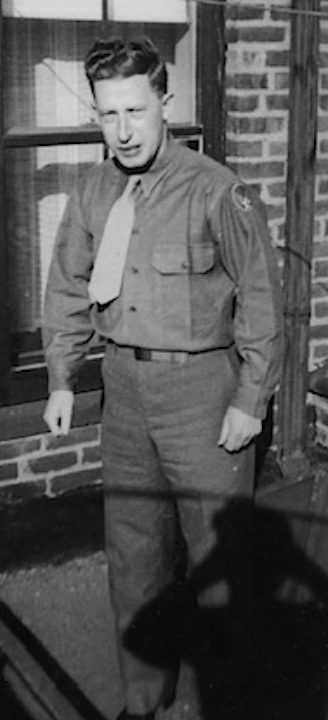
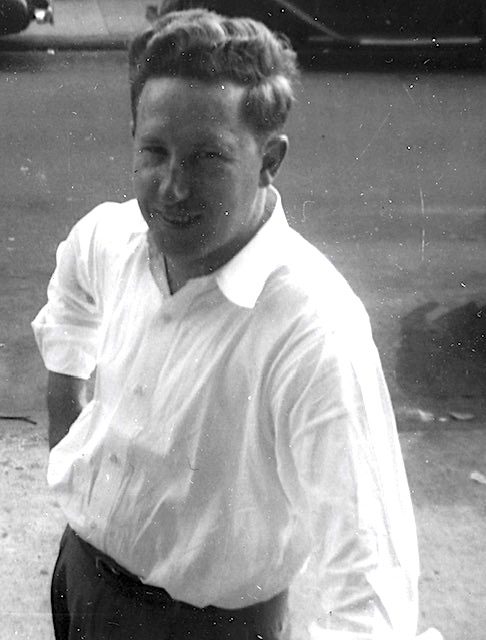
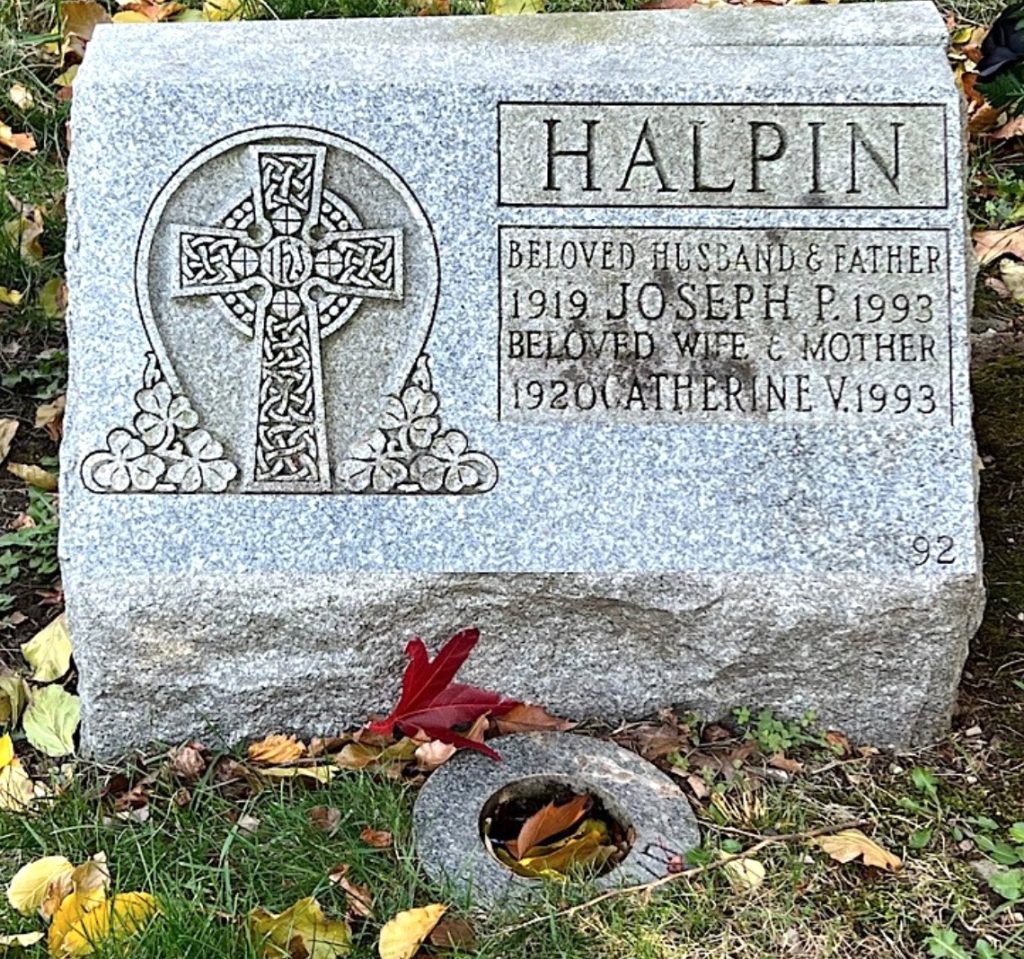
HAMEL, EDWARD C. (1907-1941). Captain, Royal Air Force Ferry Command. Hamel was born in New York City as per Green-Wood archives and his online family tree; his biography on Find A Grave incorrectly says Massachusetts. Birth records show that he was born in Bronx, New York, to Edward Louis and Marie née Glauda Hamel; the family then lived at 703 Eagle Avenue. His online family tree and census data note that he was living with his parents and younger sister, Alma, in Mount Vernon, New York, in 1920 and 1925; his maternal grandmother was living with the family in 1920 and Edward is listed as being in school in 1925. According to Episcopal Diocese of New York Church records, Hamel was baptized in New York City on June 5, 1925, at the Mount Vernon Trinity Church.
The 1929 Mount Vernon Directory identifies Hamel as a radio worker. The 1930 census shows that Edward’s father was an agent for a shipping company and that Edward C. was a wireless operator in the shipping business. The family was living at 411 South Second Avenue in Mount Vernon and included Edward’s parents, sister and maternal grandmother. He is also listed as a radio operator on the 1930 Merchant Seaman Schedule for 1930; the address of next of kin was given as 25 South Street in New York City. On December 24, 1931, he married Gertrude Nolte in the Bronx.
Hamel apparently did much traveling by ship after his marriage as part of his employment. His online family tree shows that he was in the West Indies, Central America and South America in 1933, when he sailed on the Pastores, and in Rio de Janeiro, Brazil, in 1939. His name appears on the manifest of the American Farmer, a vessel that left New York City and arrived in London, England, on March 1, 1935. Hamel is also on the manifest on the San Jacinto, a ship that left San Juan, Puerto Rico, and arrived in New York City, on February 15, 1940. He was married and still living in Mount Vernon at the time of the 1940 census. According to that census, the couple lived in a rental at 228 Sixth Avenue, he was employed as a pilot and had completed four years of high school.
During World War II, before the United States declared war, Hamel served as a captain in the Royal Air Force Ferry Command. As such, he flew new bombers from the United States to Great Britain. As per Green-Wood archives, Hamel was married and was a war casualty who died on August 14, 1941, in Ayr, Scotland, in an air crash. An Associated Press news article on Find A Grave’ ‘s website details the particulars of the crash. The plane carrying Hamel and others, which crashed on take-off, was carrying 22 people including Rt. Honorable Arthur Purvis, chair of the British Supply Council in North America; no one survived the crash. It was the second accident in a week involving the RAF (Royal Air Force) Ferry Command, in which another 22 men were killed. The plane involved in Hamel’s crash, which immediately burst into flames, was carrying the 12 Americans (eleven fliers and one radio operator) who had enlisted in the ferry service. They were traveling to North America so that they could fly more new bombers back to Great Britain. In addition to the 12 Americans were nine Canadians, including Purvis, and one Brit. Captain Hamel was listed among the dead; his home city was identified as Braintree, Massachusetts; that city is not listed on any of his census records. He was survived by his parents and sister. After his body was repatriated to the United States, he was buried at Green-Wood on February 17, 1949.
Hamel’s name appears on an online list, Commonwealth War Graves, of the final resting places of British Commonwealth veterans. In addition, the victims of his air tragedy are commemorated on a memorial at Ayr Cemetery, erected by funds from the inhabitants of Whitletts, South Ayrshire, Scotland. Section 86, lot 2857, grave 110.
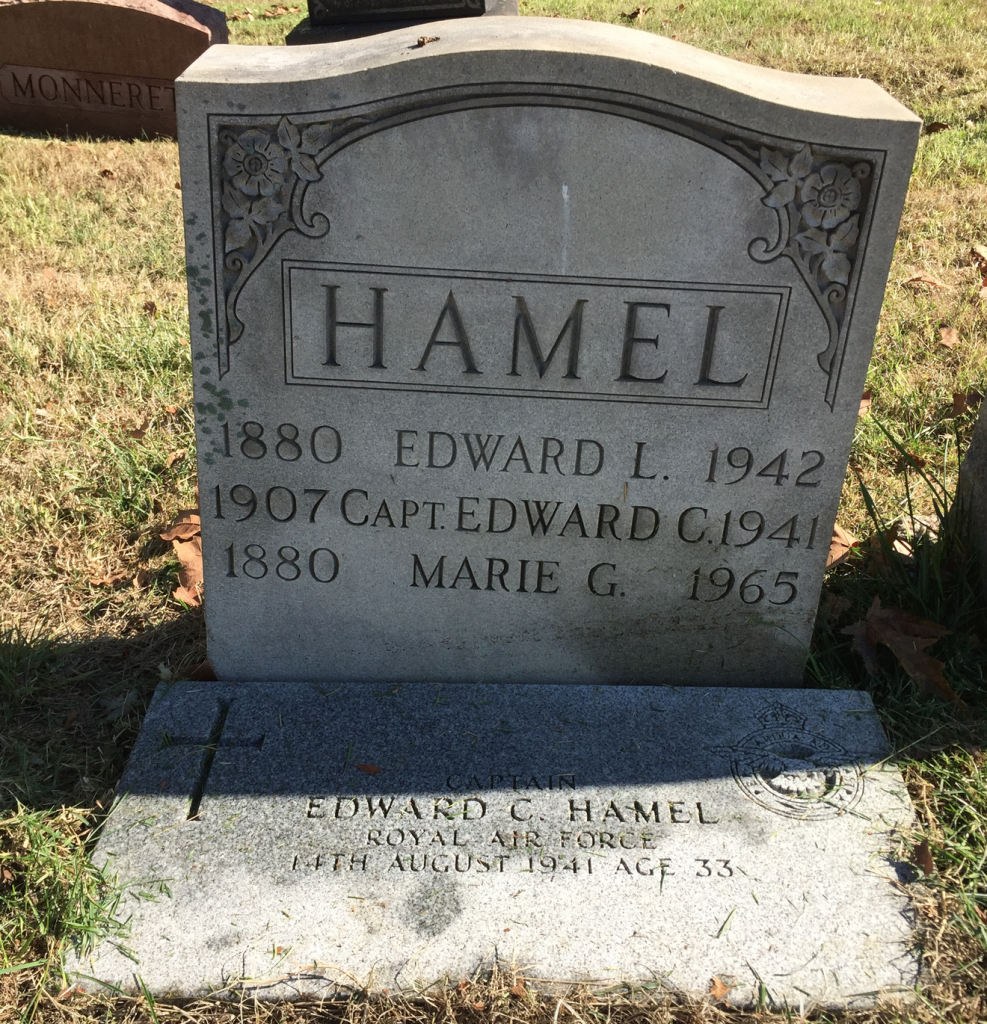
HAMM, FRANK COLEMAN (1901-1987). Lieutenant colonel, Medical Corps, United States Army. According to his grandson, Hamm was the son of a master railway carpenter, played Santa Claus in an 8th grade musical, and attended the University of Michigan and the University of Minnesota. He may be the Frank C. Hamm who, on June 15, 1918, departed on the Leviathan, a United States Army transport ship, from Hoboken, New Jersey, as a member of the 146th Infantry, Company C. He and his wife, Lisbeth, were married in 1935 at 35 Prospect Park West, Brooklyn. As per the 1940 census, he was living with his wife and two children on Henry Street in Brooklyn and was a doctor. He reported that he was working 60-hour weeks and had earned $5,000 for the year.
According to his draft registration card, he was born in Belle Plain, Iowa, lived at 1 Pierrepont Street in Brooklyn, and was self-employed at 80 Hanson Place. His grandson also relates that he was drafted at the age of 40. Hamm enlisted on April 30, 1942, and was discharged from service on April 1, 1946.
He eventually settled in New York, practicing urology. He was Chair of Urology at the Brooklyn Hospital Center from 1940 to 1970. From 1953 to 1954, he served as president of the New York Section of the American Urological Association (AUA). Hamm co-authored Urology in General Practice with Sidney R. Weinberg which was published in 1958. In 1961, he presented a dissertation, “Retroperitoneal Fibrosis,” after a AUA dinner and awards ceremony honoring the winners of the Ferdinand C. Valentine Prize Essay Contest for Residents. As per Benjamin B. K. Peng’s obituary “Dr. Frank Hamm, Professor and Chairman, Department of Urology at SUNY Downstate Medical Center, offered him a research fellowship on experimental induction of cancer in the bladders of animals from a joint 5-year award by the American Cancer Society and the National Institutes of Health.” According to the Preface from Urology in World War II, “A separate volume on urology as part of the series of volumes of the surgical history of World War II was conceived and authorized in 1961, sixteen years after the war ended.” Hamm’s contributing chapter, “Bladder Injuries,”can be found on page 385. At least two of his articles were published in the Journal of Urology: “Value of the Urine Sediment Smear for the Diagnosis of Cancer” with Nathan Lieberman and Philip C. Cabaud in Vol. 89, Issue 3, March 1963, and, “Hemangiosarcoma of the Ureter: A Case Report” with Richard L. Fein in Vol. 93, Issue 6, June 1965.
In 2019, the Brooklyn Hospital Center celebrated 175 years of service to the community. The Center recognized 175 individuals throughout the years that have made a “unique contribution of the depth, individuality and well-being of Brooklyn.” Hamm was posthumously given his award on June 20, 2019. He died on Shelter Island and is buried in the Higgins Mausoleum, a tomb located on Green-Wood’s Battle Hill. Section G, lot 23554.
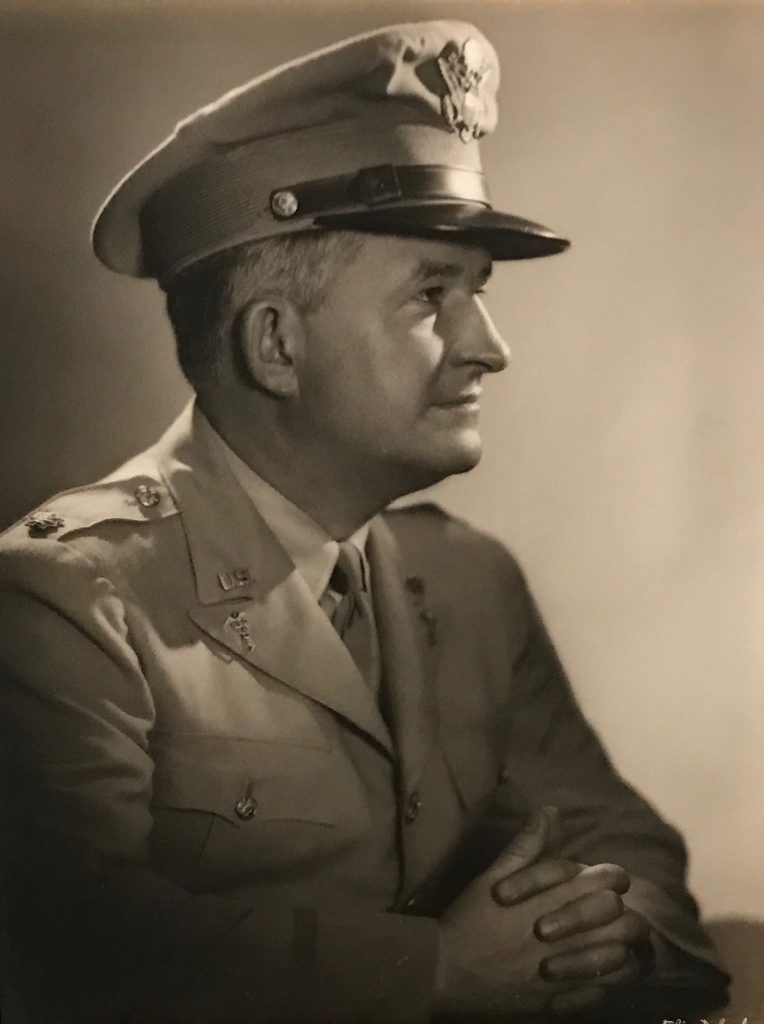
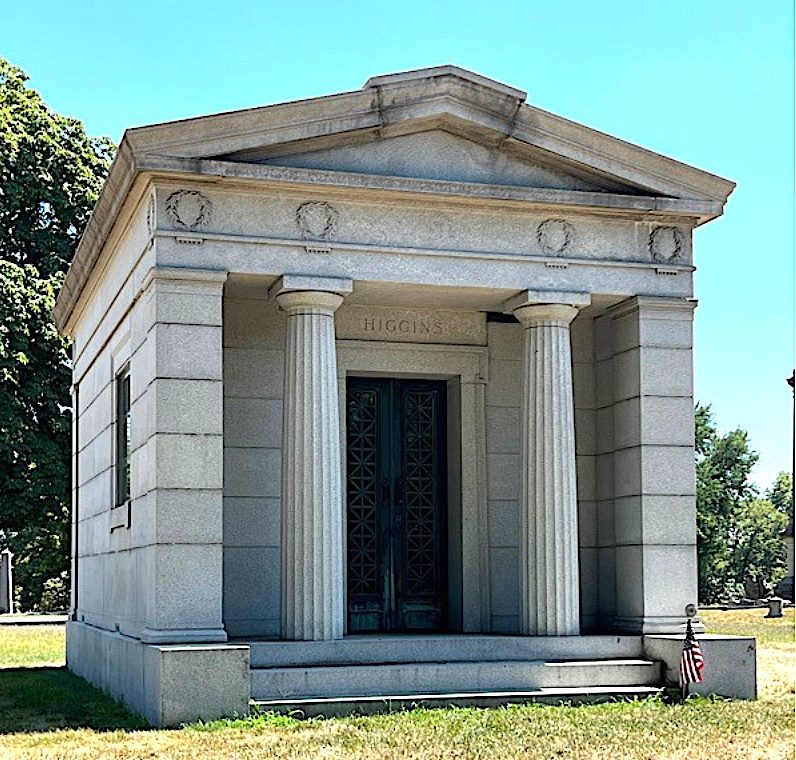
HARNED, JOHN S. (1916-1954). Private, United States Army. Born in Brooklyn, the 1920 federal census reports that he resided with his parents, Floyd and Viola, on Bedford Avenue in Brooklyn. His father was a shipping clerk for the Rockefeller Foundation and the family lived with Harned’s maternal great-grandfather, John Sawkins. In 1923, his father applied for and received an Extension and Amendment on his passport which permitted Harned to accompany him to Peking (now Beijing), China. Harned’s father was assigned by the Rockefeller Foundation to be assistant comptroller at the Peking Union Medical College. Harned spent four years in China and learned to speak the language fluently.
Although there is no official documentation of a divorce between Harned’s parents, an announcement in the December 19, 1925 edition of the Bridgeport Telegram states that Harned’s father married Leah E. Taylor. One year later, as per the New Jersey Marriage Index, Harned’s mother, Viola, married William Barrse. The 1930 federal census records that the thirteen-year-old Harnad and his younger brother lived on Avenue I in Brooklyn with their mother and stepfather. His stepfather was an automobile sales manager. His mother and stepfather divorced in 1932, as reported in the December 18 edition of the Brooklyn Daily Eagle.
As per his World War II draft registration card, Harnad was unemployed. The registrar’s report describes him as 6′ tall and 145 pounds with brown eyes, brown hair and a sallow complexion. According to the World War II Army enlistment records, he was single, had three years of high school education, was a waiter, and entered service as a private on August 13, 1942. Little is known about Harnad’s service career. Harnad’s obituary in the Brooklyn Daily Eagle, dated January 29, 1954, reports that he was a cryptographer (one who writes or solves codes) during World War II. Given the date of his enlistment, he may have had involvement in the following event as described by The Impact of the Allied Cryptographers on World War II: Cryptanalysis of the Japanese and German Cipher Machines Katelyn Callahan, December 14, 2013:
In June 1942, the Japan government sent a message to its troops describing the plan of attack at Midway. A small number of Japanese troops were to distract the enemy by attacking a group of nearby islands, forcing the Allied troops away from the island of Midway; therefore, providing Japan with an easy victory. The message was intercepted and deciphered by the American cryptographers and they warned the Allied troops of the plan. In order to avoid suspicion that Purple (Japan’s electrical machine for encrypting messages) had been broken, the troops pretended to leave the island, making Japan think the Island of Midway was vulnerable. As soon as Japan began to attack, the troops turned around and initiated a surprise assault. The United States military was able to stop Japan from taking over the island, and assured themselves a surprise victory for the Allies.This was the Allied forces first major victory in the Pacific. It gave the Allied forces a secure base in the Pacific, and kept Japan from pushing forward towards the western coast of the United States and Hawaii.
After his tour of duty, as reported in the March 5, 1948 issue of the Brooklyn Daily Eagle, Harnad performed in a local theatrical production of Outward Bound. The article also states that he was a banquet manager at the Hotel Bossert and had performed in dramatics in Peking, China. Harnad’s obituary in the Brooklyn Daily Eagle relates that he was a banquet salesman at the Towers Hotel, lived at 19 East 19th Street in Brooklyn, and passed away suddenly. Section 204, lot 32503, grave FLC.
HEILBRUN, JAMES (1924-2008). Lieutenant junior grade, United States Navy. According to Prabook (World Biographical Encyclopedia), the economist and educator James Heilbrun was born in New York City on December 13, 1924, the son of Maurice L. Heilbrun and Hortense Unger Heilbrun. In the 1925 New York State census, Heilbrun, under one year old, is listed as residing with his parents, both age 27, at 73 East 90th Street in Manhattan, along with an elder sister, Betty Lee Heilbrun, age 3. His father worked in the bathrobes business. A servant, Louise Schmidt, age 40, also resided with the family. Heilbrun attended the Birch Wathen preparatory school (now the Birch Wathen Lenox School) in New York City and was a member of its student council in his sophomore year.
Heilbrun served with the United States Navy 1944-1946, reaching the rank of lieutenant junior grade. A document from February 10, 1946, when he was an ensign, shows him sailing out to sea. He served in the Pacific and was stationed in China. His ship was LST 1069, later known as USS Orleans Parish. It was launched in 1945 and sailed first to Hawaii, then, via the Marshall and Mariana Islands, to the Philippines, where it remained until after the Japanese capitulation. It then proceeded to Shanghai, China, and was one of the first American ships to steam up the Yangtze River since 1941. The ship remained in the Pacific until 1946 when it sailed back to the United States and was decommissioned in New York on August 6, 1946.
Jim, as he was known, married Carolyn Gold in 1945, while both were still in college. They obtained their marriage license on February 19, 1945, in Manhattan, and were married the next day, per the Harvard 1946 yearbook. Carolyn Heilbrun was born on January 13, 1926, in East Orange, New Jersey, the only child of Archibald Gold, an accountant, and Estelle Roemer Gold. According to her obituary in the Chicago Tribune, the family moved to Manhattan when she was six. After her marriage, she graduated from Wellesley College in 1947 with a bachelor’s degree in English, a master’s degree in 1951 and a doctorate in 1959, both from Columbia University. She was a well-known feminist scholar, author, and professor. She taught at Brooklyn College, Yale, Princeton, Swarthmore, and other colleges, but spent most of her academic career at Columbia University, joining the faculty in 1960 as an instructor of English and comparative literature and retiring in 1992 as the Avalon Foundation Professor in the Humanities. She wrote nine scholarly books and was the author of the Kate Fansler mystery book series.
According to his listing in Prabook, and the Harvard 1946 yearbook, Jim Heilbrun received a Bachelor of Science degree, magna cum laude, from Harvard College in 1945, a Master of Arts degree in economics, also from Harvard, in 1947, and a Doctor of Philosophy (PhD) degree from Columbia University in 1964 (his obituary published in the Journal of Cultural Economics states that his doctoral degree was in economics). The home address listed for Heilbrun in the Harvard yearbook is 1230 Park Avenue, New York, New York. He was awarded the John Harvard Scholarship and was a member of Phi Beta Kappa. Heilbrun was on the Harvard Soccer Team and was a member of several college clubs, including the Council of Postwar Problems, of which he was chair. A photograph of the Harvard Postwar Council, 1943-44, shows Heilbrun in naval uniform. His granddaughter reports that he was in the ROTC while at Harvard.
Heilbrun had an illustrious career in the field of economics. Prabook lists his employment as follows: assistant economist, Prentice Hall Inc., New York City, 1947-1950; economics analyst, Chase Manhattan Bank, New York City, 1951-1955; instructor, Columbia University, New York City, 1961-1965; assistant professor in economics, Columbia University, New York City, 1965-1970, and research director of the Harlem Development Project, Columbia University, 1967-1968. He was an associate professor of economics at Fordham University in Bronx, New York 1970-1974, then a professor at Fordham 1974-1997, and a professor emeritus from 1997 on.
Heilbrun authored books on urban economics and the economics of the arts, such as The Economics of Art and Culture and Urban Economics and Public Policy. He was a devoted fan of the New York City Ballet for over 50 years.
Heilbrun and his wife had three children: daughters Emily and Margaret, and a son, Robert, along with two grandchildren, Penelope Duus and Matteo Heilbrun. Heilbrun lived in New York City all his life. He passed away peacefully in his sleep on April 8, 2008, at his home in New York City. His cremated remains were interred at Green-Wood on November 15, 2008. His wife, Carolyn, had predeceased him in 2003. There is no evidence that she is interred at Green-Wood. Section 105, lot 45149.
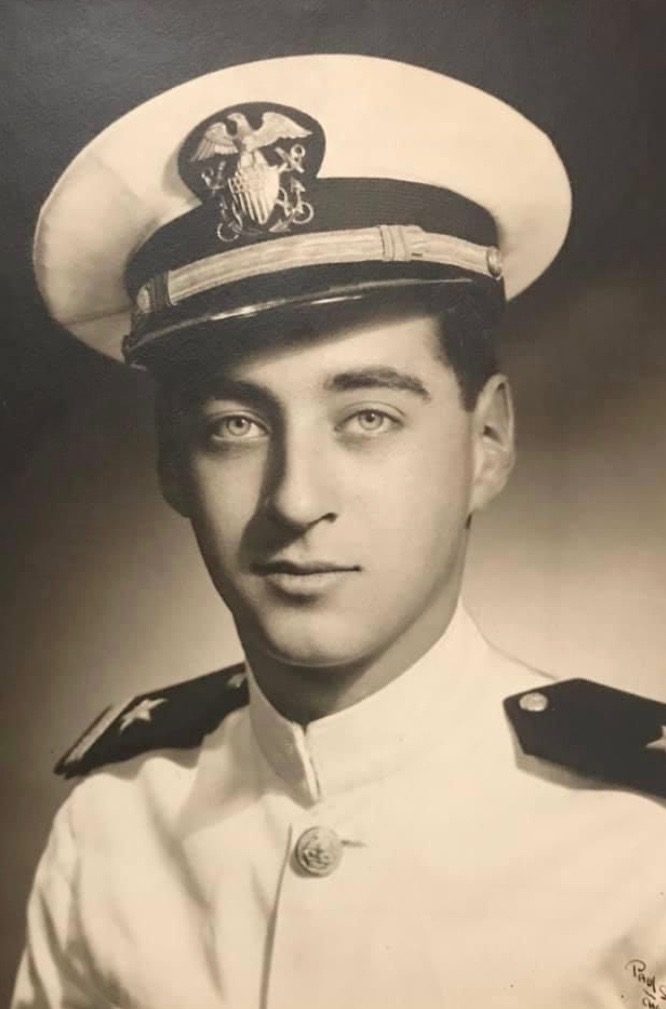
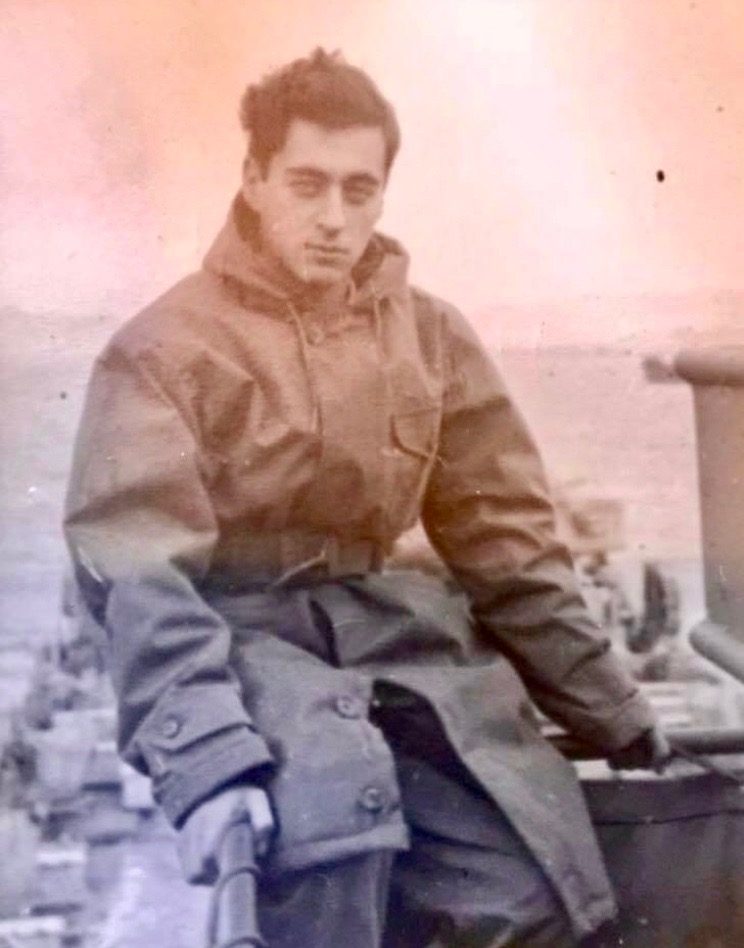
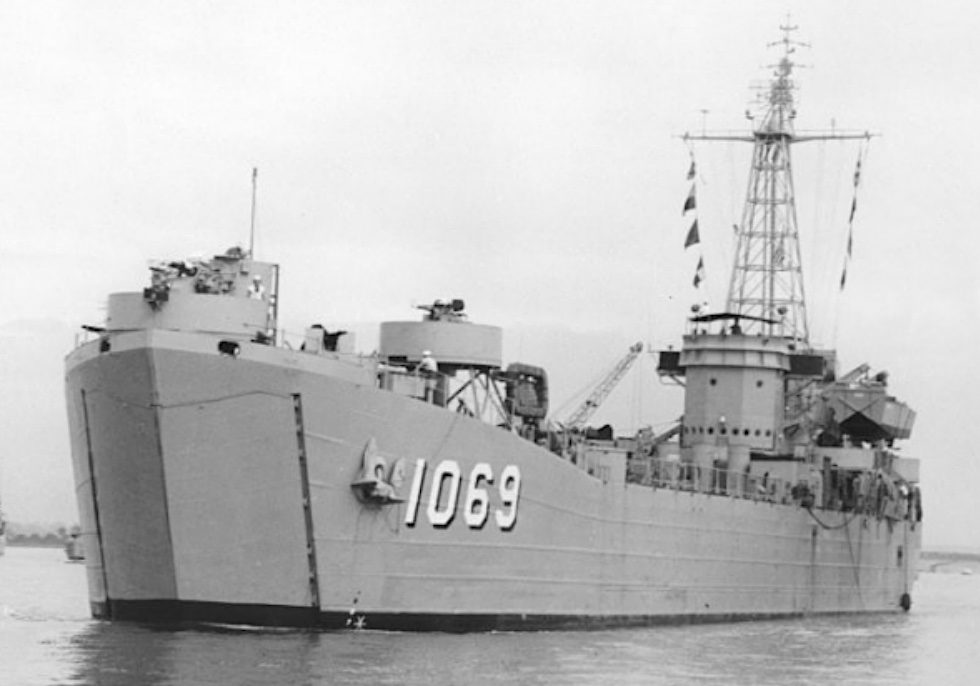
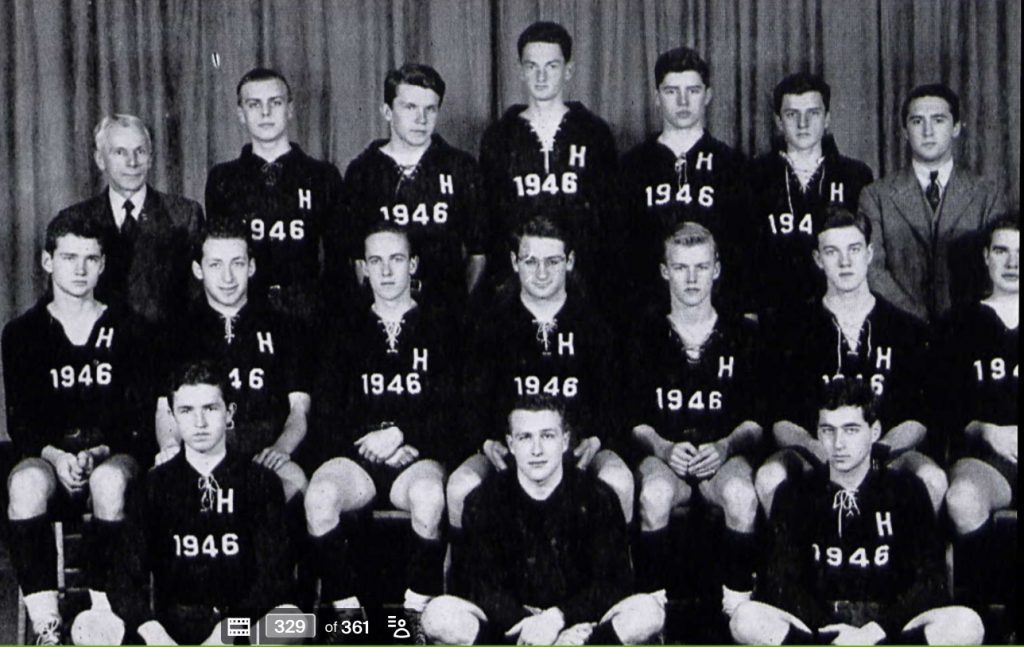
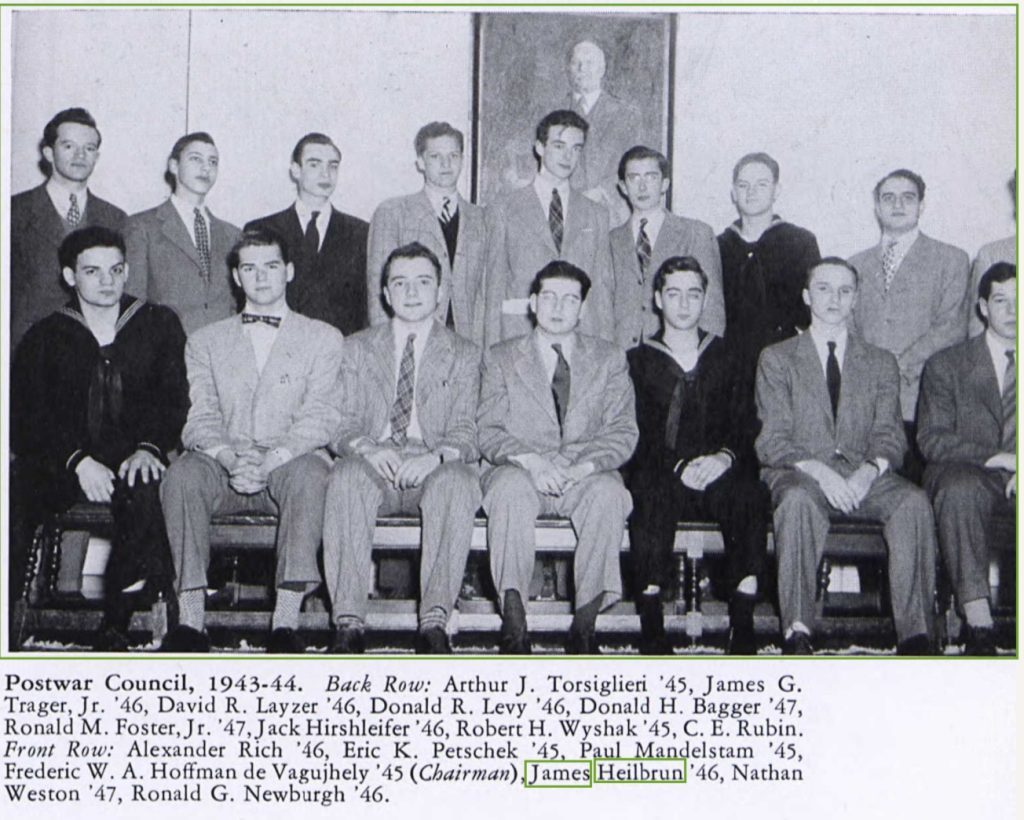
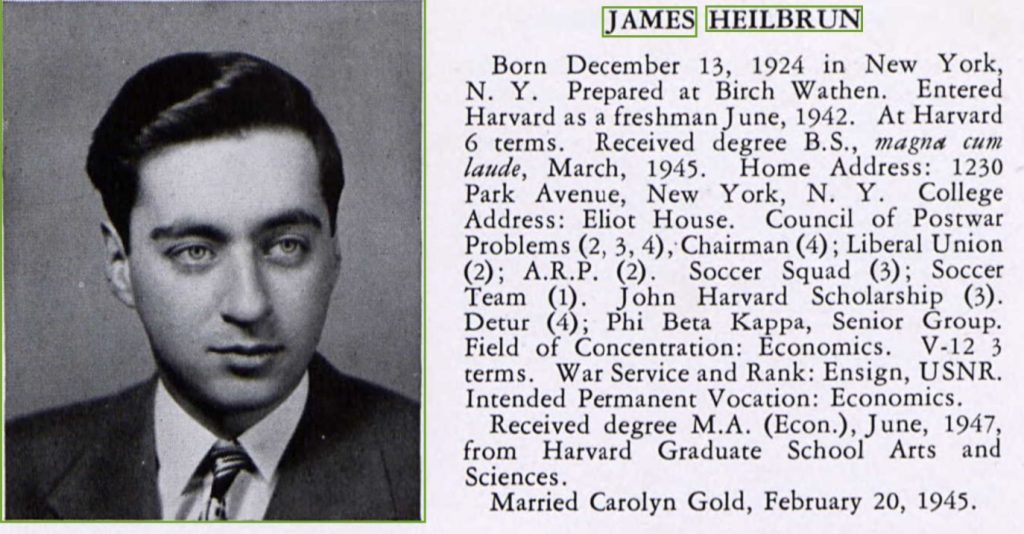
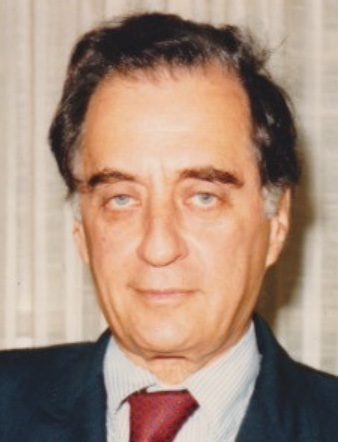
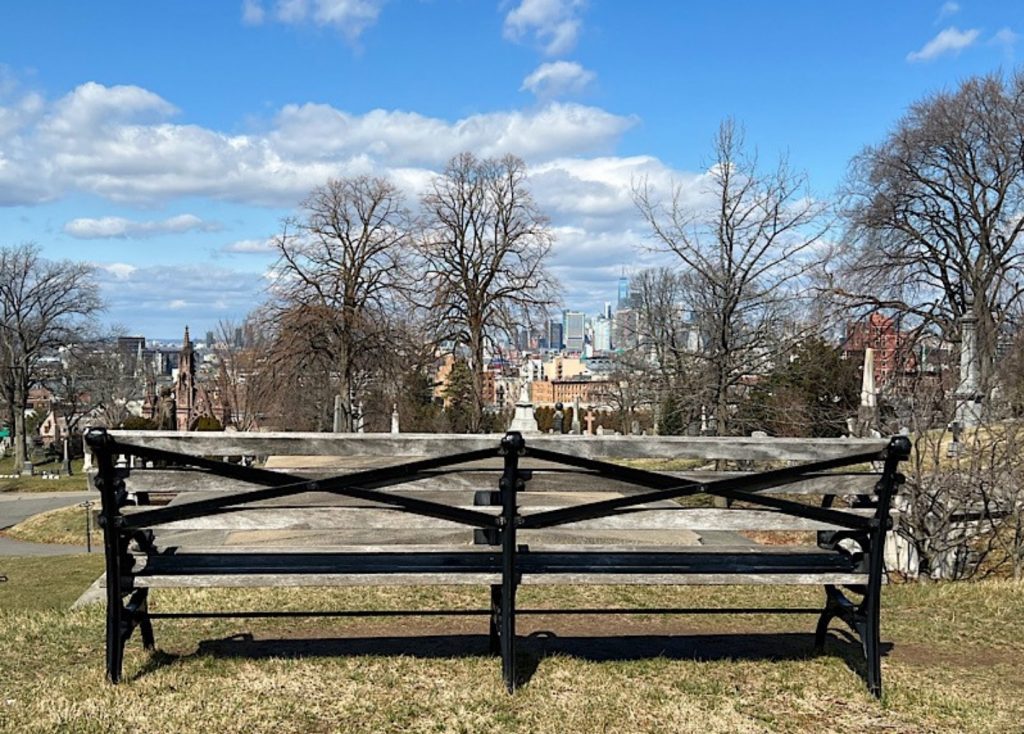
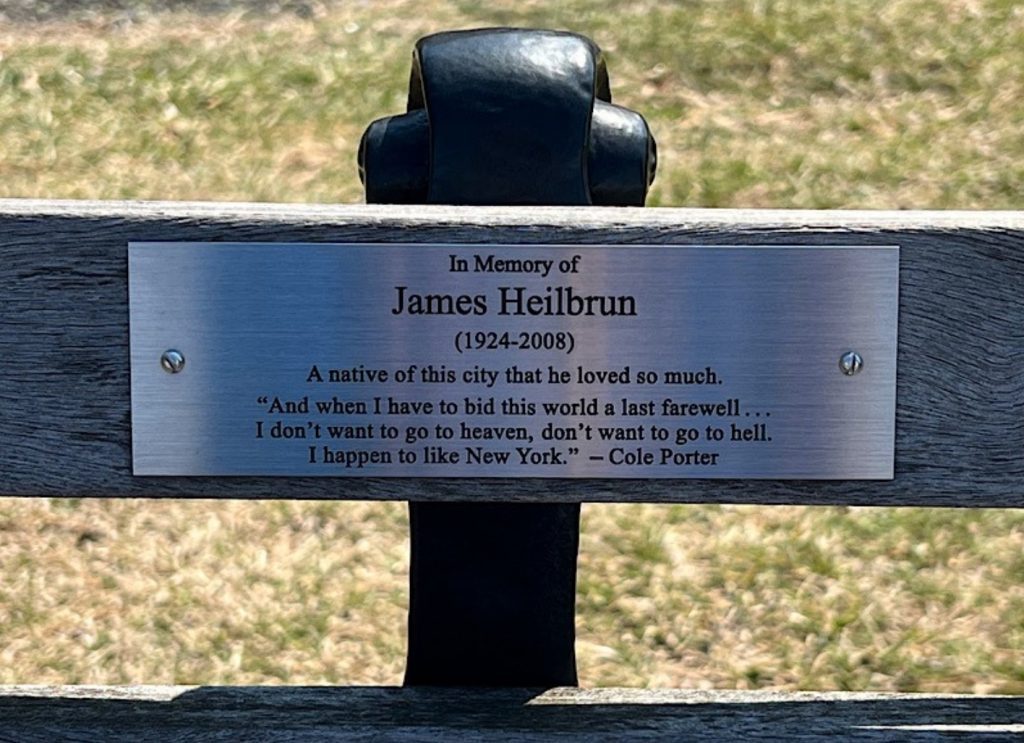
HEWITT, ROBERT (1921-1974). Sergeant, United States Army. Hewitt was born in Brooklyn. As per the 1925 New York State census, he lived with his mother and father, Emma Louise and Fred, at 1325 Flatbush Avenue. Both parents were born in New York City in the late 1800s. His father was an auto mechanic. Also in the household were Robert’s paternal grandmother, Agnes, and paternal aunt, May, a stenographer. His grandmother passed away in 1928. The 1930 federal census relates the same information as the 1925 census, except that Hewitt now has a baby brother, Herbert. His Aunt May (recorded as Mary) continued to live with the family.
As per Ancestry.com, Hewitt’s father passed away in 1937. Robert’s mother applied for a marriage license in April and married Burghart Fred Dilg. As per the 1940 federal census, the nineteen-year-old Hewitt was living with his stepfather and mother at 2503 Avenue D in Brooklyn. His stepfather (first name spelled Burgharette) was born in Connecticut and was a college-educated postal clerk. Hewitt had completed three years of high school, was a clerk, and had earned an income of $600 for 32 weeks of work in 1939.
According to his World War II draft registration card, Hewitt was 20 years old, resided at 956 East 22nd Street, and was employed by Lawyers Trust Company, located on 14th Street and 8th Avenue in Manhattan. His mother was named as next of kin. The registrar’s report, dated February 15, 1942, describes him as 5′ 10″ tall, 145 pounds, with blue eyes, blond hair, and light complexion. His World War II army enlistment records describe him as single with four years of high school. His civil occupation was listed as “bookkeeping machine operators.”
He was drafted on October 30, 1942 and entered active service in the United States Army on November 13, 1942. This date corresponds with the enlistment date on record with the Department of Veterans Affairs BIRLS (Beneficiary Identification and Records Locator Subsystem) Death File. There is no information regarding where Hewitt served his tour of duty.
In the December 31, 1945 issue of the Brooklyn Daily Eagle, Robert’s engagement to Elizabeth Almira McIntire was announced. The article relates that at that time Hewitt was a sergeant and stationed at Shaw Field, Sumter, South Carolina. As per the Department of Veterans Affairs BIRLS Death File and Ancestry.com, he was discharged on January 8, 1946. After his service, he and Elizabeth applied for a marriage license on November 9, 1946 in Brooklyn. Robert’s brother, Herbert, also served in the United States Army from 1952 to 1954. Herbert passed away in 2002 and is interred in Arlington National Cemetery. Section 206, lot 34468, grave FRC.
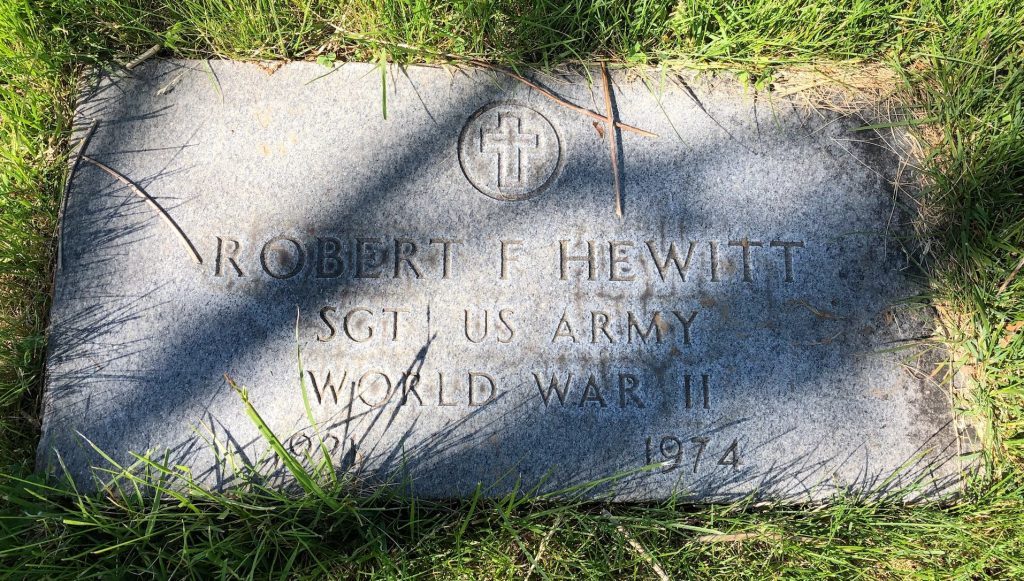
HOOGLAND, BENJAMIN TOWNSEND (1896-1949). Second lieutenant, New York National Guard, 51st Regiment, Company E. Benjamin Hoogland was born in Brooklyn to John H. Hoogland and Mary (Vrooman) Hoogland, both of whom were born in New York. By the time of the 1905 New York State census, nine-year-old Benjamin had been joined by two sisters, Elizabeth and Helen, and, in 1910, a brother, Frederick. At that time, the family lived at 744 Greene Avenue, in the Bedford-Stuyvesant neighborhood of Brooklyn.
Benjamin attended Adelphi Academy in Brooklyn, followed by two years at Cornell University, according to his listing at Find A Grave.com. He was a student at Yale University, serving in the Naval Training Unit there, when he registered for the draft in 1917, having completed two months of training as an infantry sergeant in Plattsburgh, New York. According to his draft registration card, he was tall and slender, with blue eyes and light hair. He listed his address as 495 East 18th Street in Brooklyn.
As per Yale in the World War, Volume II, and official naval records, he served from September 5, 1917 through March 5, 1919. Initially enrolled as a quartermaster second class at the recruiting station at Newport, Rhode Island, he served there until January 15, 1918, when he was commissioned an ensign in the United States Naval Reserve Force. He then attended the United States Naval Academy, and was commissioned an ensign in the United States Navy on June 9, 1918. He served from August to September, 1918, on convoy duty off the coast of Ireland on the U.S.S. Utah, continuing his service on that ship until March 1919, when he resigned. He was awarded the World War Medal for his service.
In his civilian, post-war life, Hoogland returned to live in his family home on East 18th Street in Brooklyn, according to the 1920 federal census. He described his occupation as office clerk, apparently in the advertising industry. He continued to travel, as he’d done since the age of 13: the Port of New York records his 1909 return home from London on the SS Minneapolis, and,as a seventeen-year-old, his 1913 return from Colombia, South America. After the first World War, he visited Bermuda in 1925; England in 1926; and Europe in 1928, arriving home from Cherbourg, France, at age 32, on the SS Majestic.
In 1932,John Hoogland,Benjamin’s father, died at age 66 of “heart trouble,” according to his obituary in the Brooklyn Daily Eagle. Sometime in the following decade, Benjamin moved to East 56th Street in Manhattan and was living there with his mother when he registered for the military draft in early 1942. The year before, Hoogland had joined the New York National Guard, the home militia, in Company E of the 51st Regiment, as a private. He was promoted to second lieutenant in 1943 and served until 1945, when he was 49 years old.
After World War II, Hoogland continued his career in advertising as a copywriter and assistant account executive at J. Walter Thompson in New York City. He was involved with the theater as a singer, actor, director, and writer, according to his listing at Find A Grave.com, and in 1943 co-authored a book, Let’s Do Some Gilbert & Sullivan: A Practical Production Handbook, published by Coward-MCann, Inc.
Hoogland died “suddenly,” as per an obituary in The New York Times, in 1949 at the age of 53. Services were held at the prestigious St. Bartholomew’s Church at 51st Street and Park Avenue in Manhattan. The Association of Ex-Members of Squadron A, Inc., put an announcement of his death in the Times. Section 193, lot 27327.
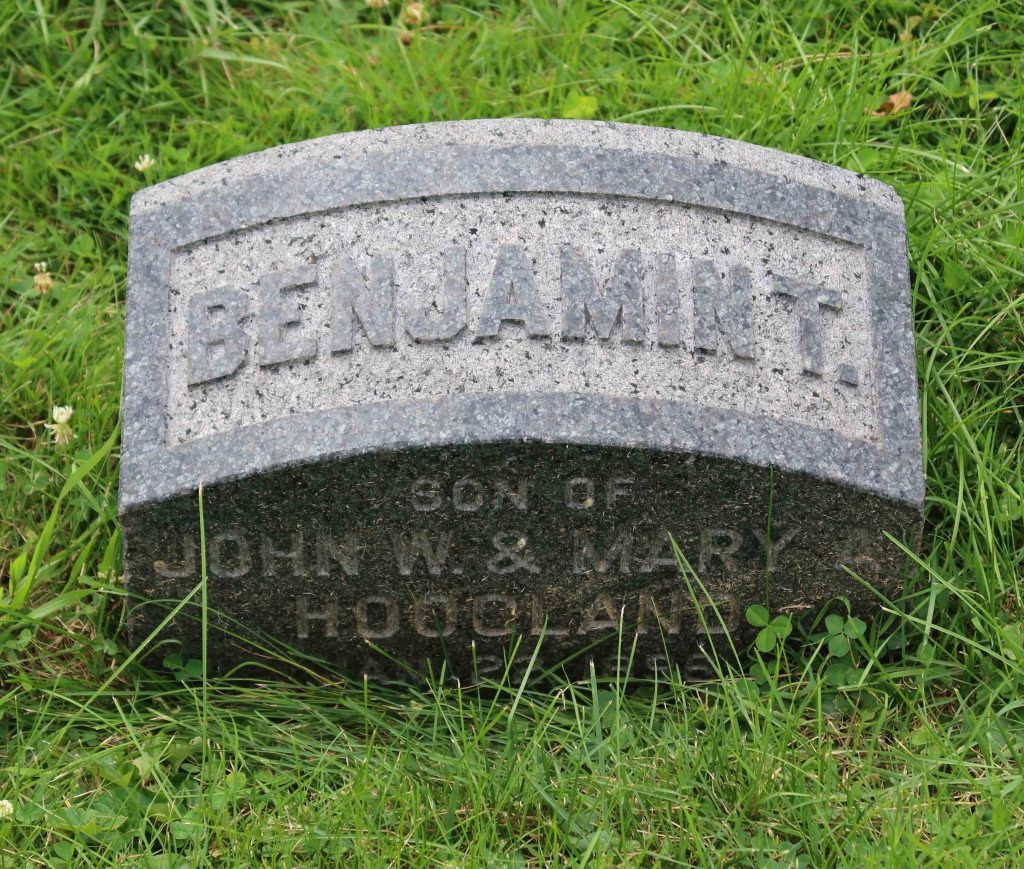
HUNKO, STANLEY (or STANISLAWA) VINCENT (1922-2011). Corporal, Second Guard Company, United States Marine Corps. A Brooklyn native, he was born at 174 Freeman Street, Greenpoint, to Polish-born parents, Antoni Sr. and Zofia Hunko, according to his daughter Veronica. Zofia was Antoni’s second wife, his first, Mary Zazyilla, having died in childbirth giving birth to her fourth child. Zofia’s first child was Stanley. She would have four other children, one of whom died at 11 days of malnutrition.
According to his daughter, Stanley left school in his early years, never completing high school, to help his father run his business, a neighborhood newsstand on the corner of Manhattan and Greenpoint Avenues in Greenpoint. When he registered for the draft, according to his registration card, he lived at 324-17th Street, Brooklyn, and was 23 years old. His brother Anthony was killed in action in 1942.
He enlisted in the Marine Corps on January 22, 1942, for four years, and served until January 25, 1946. At the time of his enlistment, he was described as 5′ 10″ tall, with a ruddy complexion, brown eyes and hair. His service in the Asia-Pacific Theater was from April 26, 1942 to August 20, 1944. His tour of duty began in San Diego, then Pago Pago in American Samoa. He participated in action at Guadalcanal, Operation Watchtower, British Solomon Islands (November 4, 1942-February 9, 1943); Tarawa, Gilbert Islands (November 20-24, 1943); and at Saipan, Marianas Islands (June 15-July 8, 1944), where he was wounded in action on the first day. He recovered but returned home with a piece of shrapnel in his leg. He received a Purple Heart Medal as a result.
Hunko was stationed in Newport, Rhode Island, during 1944 and 1945. During that time, on February 4, 1945, he married Jean Paul, also from Greenpoint, whom he had met prior to his service, according to his daughter.
He was discharged from the Guard Detachment, Defense Ordnance Support Facility, San Francisco, on January 25, 1946, as per his Certificate of Honorable and Satisfactory Service. His daughter, Veronica, writes that, on discharge, he was given a travel allowance of 5 cents per mile to return home to Brooklyn from San Francisco. He was recognized for his service, receiving an Honorable Discharge and Service Medal, Marine Corps Good Conduct Medal, World War II Medal, American Campaign Medal, Asiatic Pacific Campaign Medal. His monthly rate of pay at discharge was $69.30.
Following his service, on October 1, 1948, Stanley and Jean Hunko purchased their first house in Bay Ridge, Brooklyn. They raised four children: Veronica, Christine, Virginia and Gregory. As per his daughter Veronica, Stanley worked at the Brooklyn Army Air Force Exchange at the Brooklyn Army Terminal, from which he retired. When retirement did not suit him, he returned to work as a superintendent in a New York City building. After his second retirement, the couple moved to Toms River, New Jersey.
Hunko’s daughter reports, “Although he did not speak much of his time overseas, his love for the Marine Corps was deeply embedded in his soul. He proudly flew the Marine Corp flag alongside his American flag and had his Purple Heart designated license plate on his car.”
At the time of his death, the Hunkos had been married for 66 years. A funeral mass in his honor was celebrated at Our Lady of Czestochowa, Brooklyn. Stanley Hunko was buried in Green-Wood Cemetery with military honors, including an escort by the Patriot Guard Riders. After his death in 2011, Jean Hunko moved back to Brooklyn, where she lived out her remaining years. When Jean died in 2020, she was interred in the lot where Stanley and her parents, Ernest and Mary Paul, had been interred. Section N, lot 43011, grave 1.
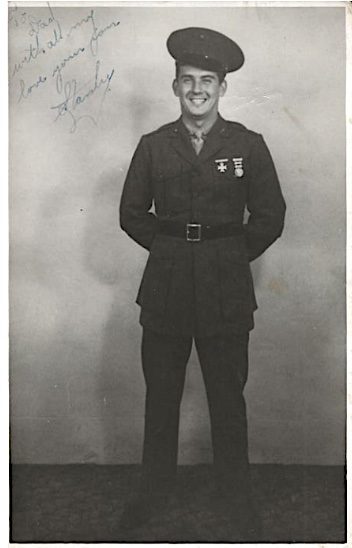
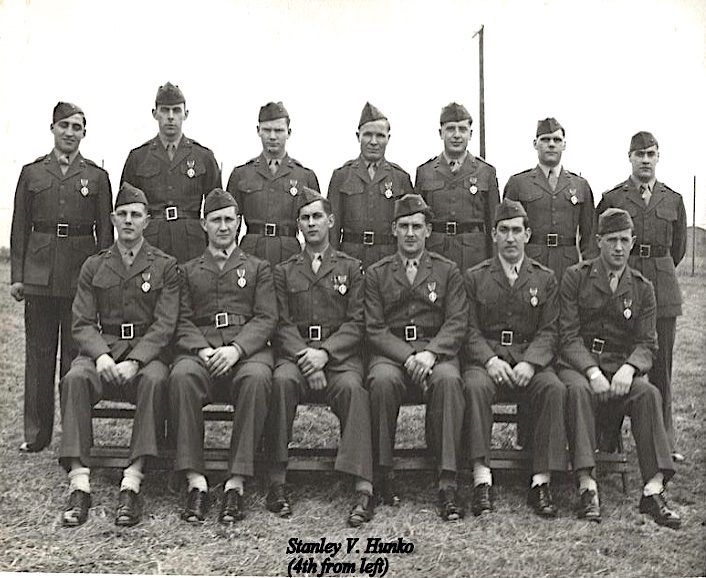
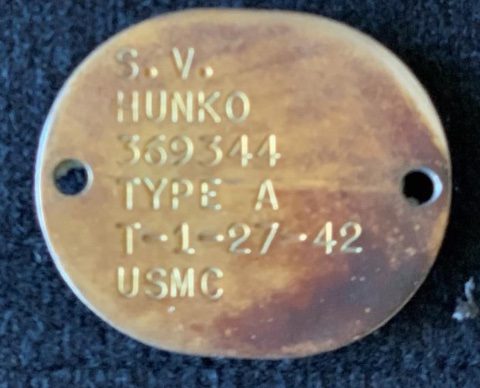
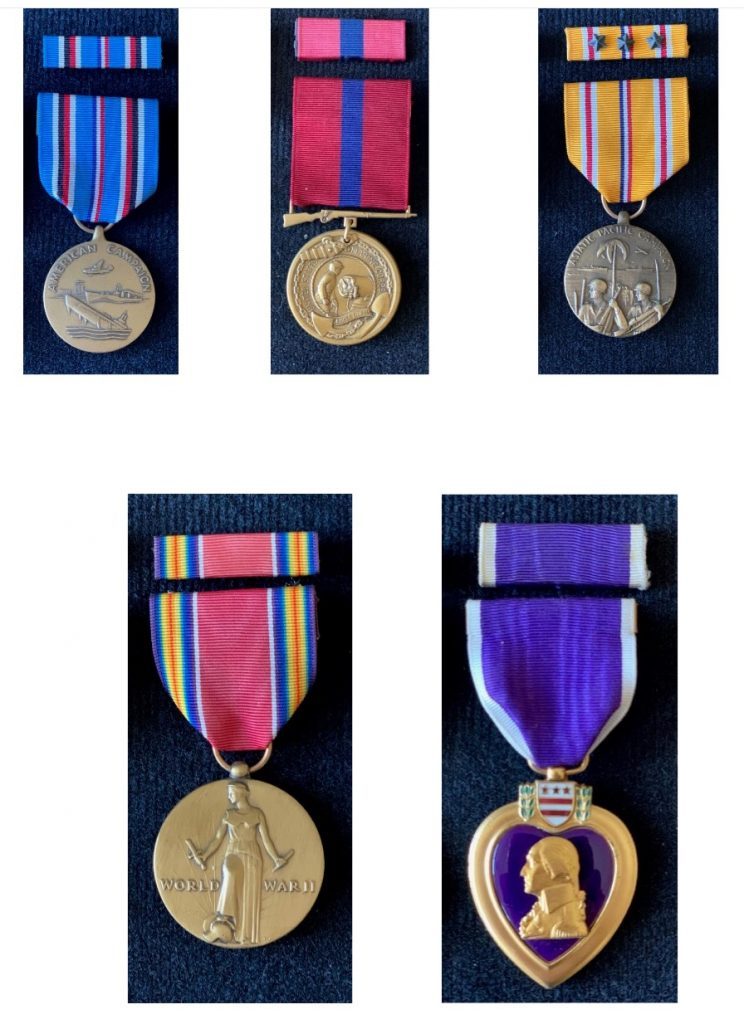
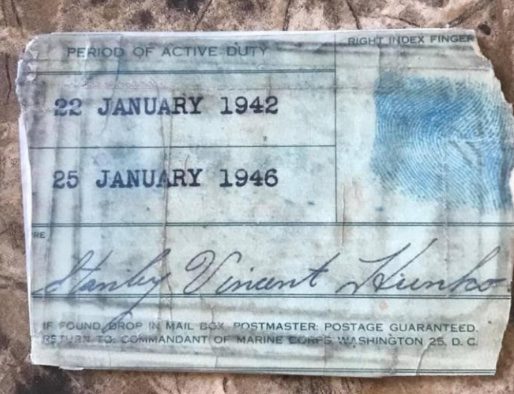
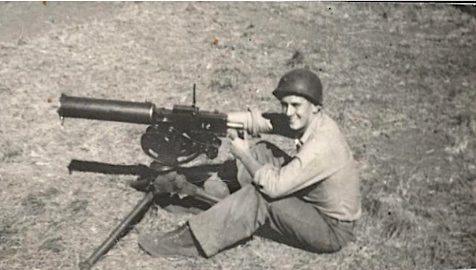
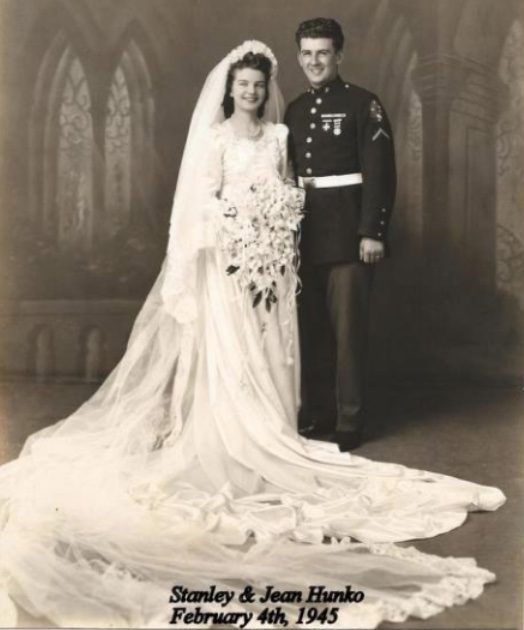
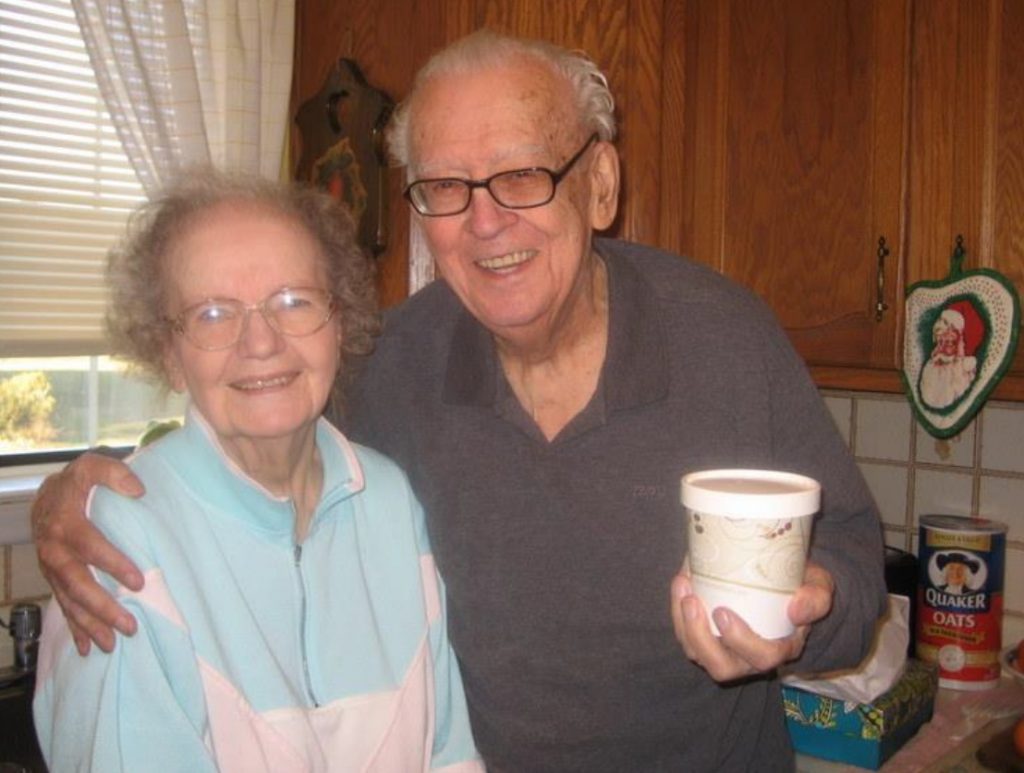
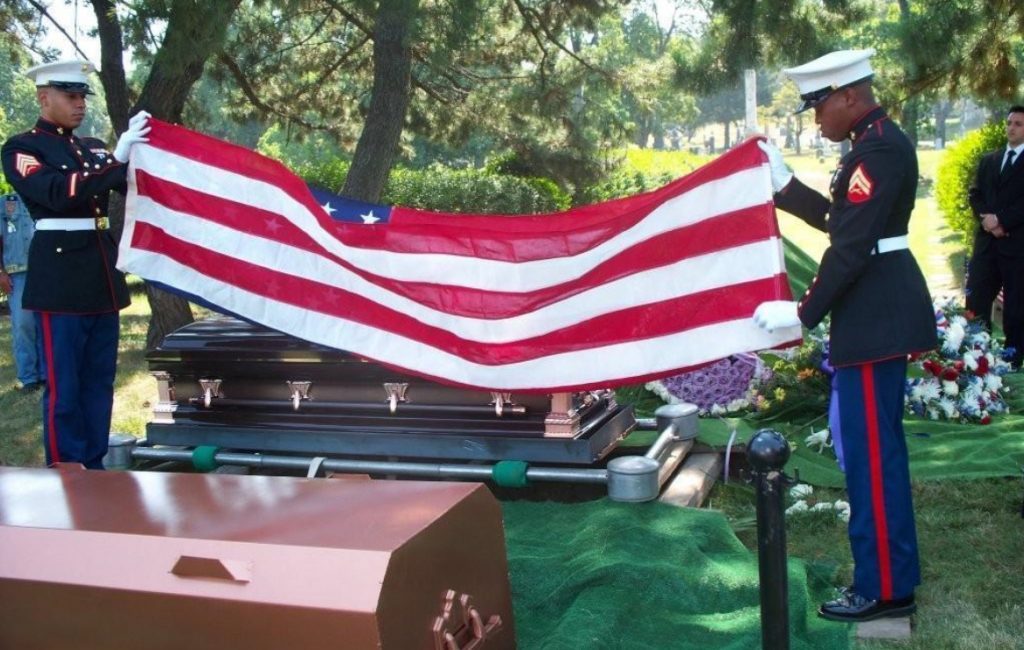
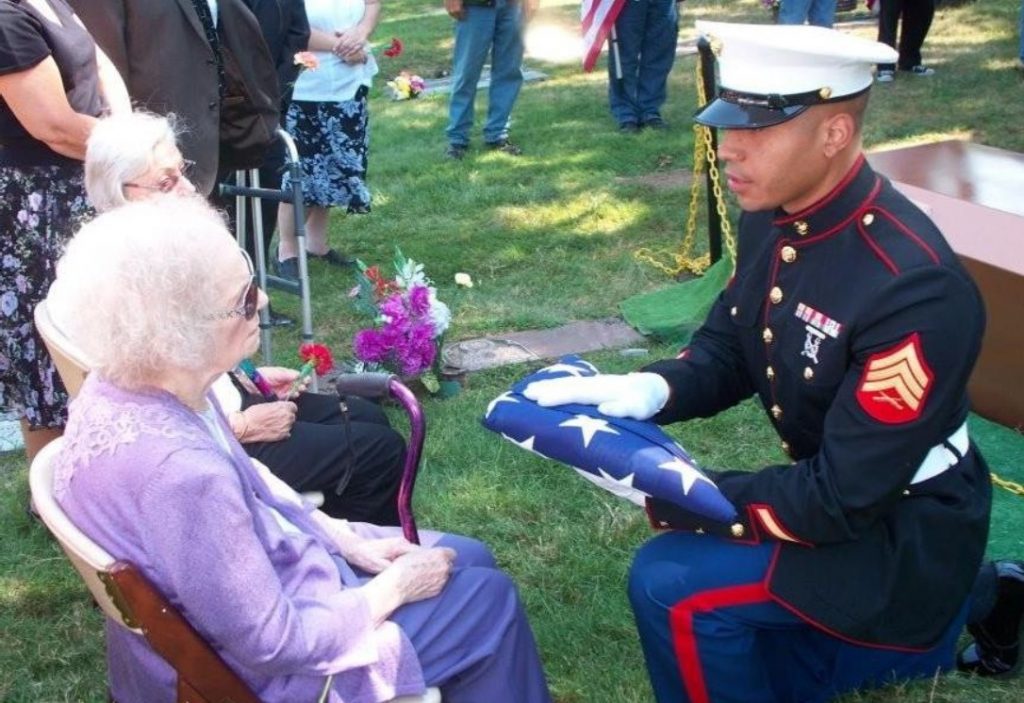
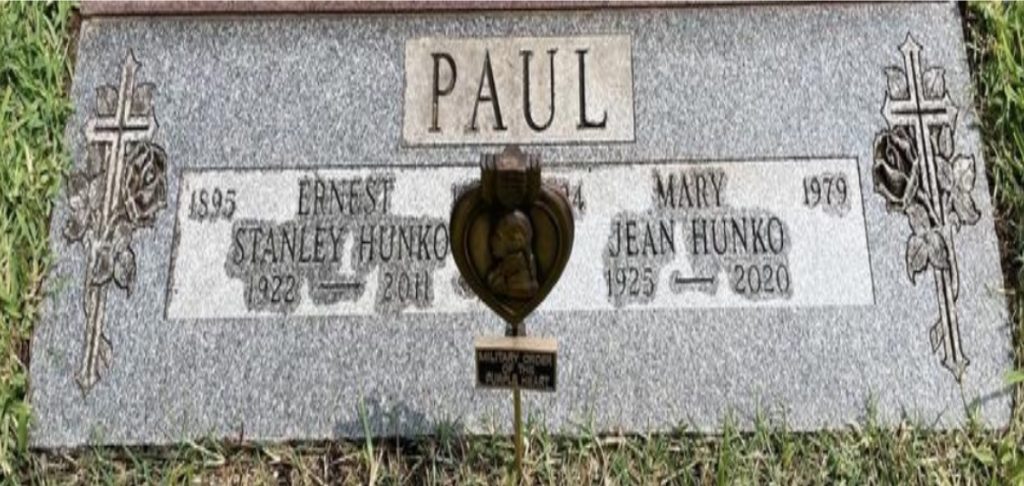
HUTCHEON, JR., FRANK EADIE (1921-1944). First lieutenant, United States Army. As per the 1930 census, Frank was born in New Haven, Connecticut, and was living at 620 6th Street in Lakewood, New Jersey, with parents, Frank and Jessica, and younger brother, Robert; his father was an automobile dealer. The 1940 census reports that he was still living in Lakewood at 149 Autumn Road with his family; Hutcheon had completed four years of high school.
Hutcheon registered for the draft on March 13, 1943. According to his draft registration card, he was a college student who lived in New Brunswick, New Jersey. His physical description notes that he was 6′ 1″ tall, 185 pounds with blue eyes, red hair and a ruddy complexion. At that time, he was in the ROTC (Reserve Officers Training Corps) at Rutgers University, living at 224 Ford Hall; his mailing address was P.O. Box 482, Lavalette, New Jersey. He listed his father as next of kin and noted that he had a home telephone.
Military records indicate that Hutcheon was a commissioned officer who was killed in action on December 12, 1944. His relative indicates that he served in the European Theater of Operation. His service is inscribed on his tombstone. Section 130, lot 36098.
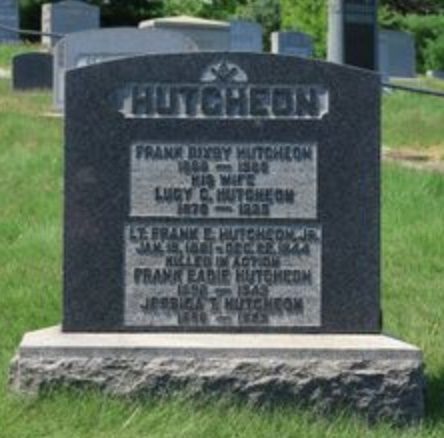
IMHOFF, CARL R. (1920-1944). First lieutenant, 157th Infantry, 45th Division, United States Army. Born in New York City, he lived at 139-14 225th Street in Laurelton, Queens, with his father Welebald, his mother, Claire, and his younger sister, Alice, according to the 1930 federal census. Both of his parents were born in Germany and immigrated to New York in 1914 and 1895, respectively. His father worked as an economist in the insurance industry. His parents owned their home, valued at $12,500.
As per the 1940 census, Carl was 20 years old, had completed one year of college, his family lived in the same house, and his sister worked as a cashier, having completed high school. The family home was valued at $11,000. His father was working for the Fire Insurance Company; his salary was $5,000.
Imhoff joined the Army as a first lieutenant, service No. 426019, and served in the 157th Infantry, 45th Division. He was killed in action on October 21, 1944. On May 14, 1948, he was interred at Green-Wood. Three months later, his father applied to the Department of Veterans Affairs for an upright marble gravestone; it now marks his grave. At that time, his father was living at the same address on 225th Street in Laurelton. Section 168, lot 16405.
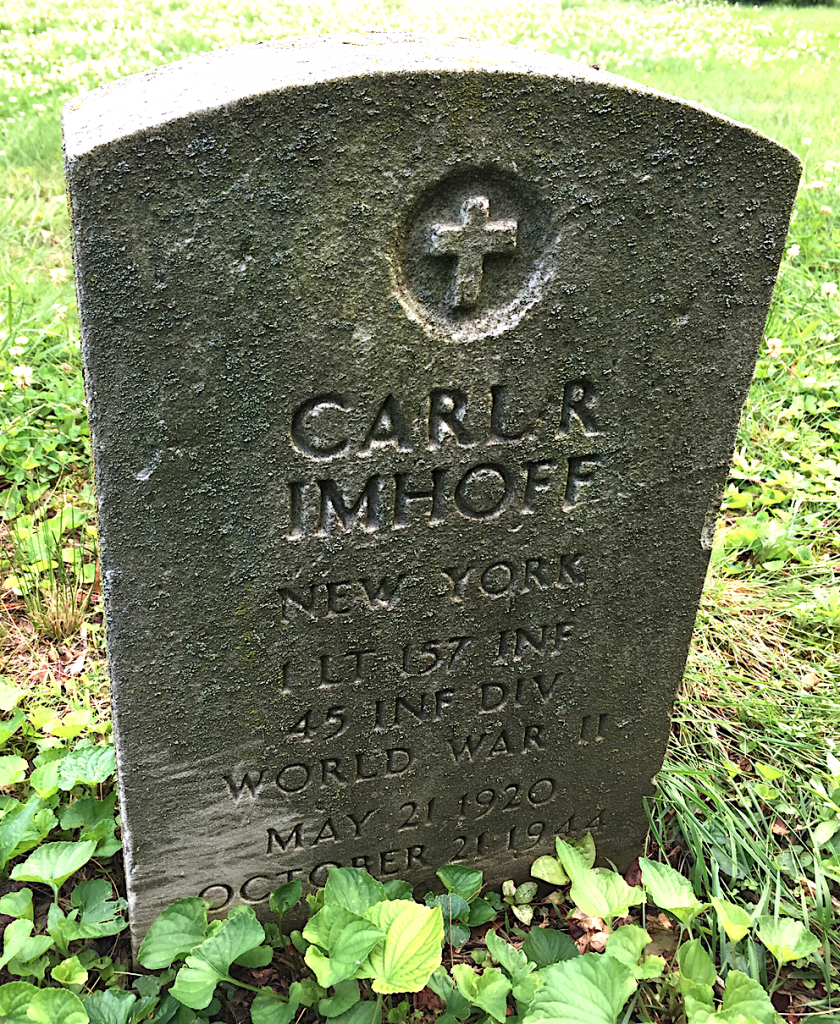
JACCARINO, FRANK (1916-1971). Private, United States Army. When the census of 1920 was taken, Frank Jaccarino was just four years old, living in Brooklyn with his family. His parents, Joseph and Jennie, were Italian immigrants, and had three children before Frank was born – Emily, Michael, and Antonio. A census is a fluid thing, dependent on the taker. Names and dates change, Jennie becomes Anna and Emma becomes Esther in the New York State census of 1925, and Frank loses a year, but these are inconsistencies in a ledger and not in a home, and this close knit family knew who they were and worked together to forge a life. By the census of 1930, a younger brother, Joseph, had been added to the family that was living at 118 Hamilton Avenue in Brooklyn. Frank was attending school and was noted as being able to read and write. He wouldn’t stay in school, leaving after completing eighth grade for work as a longshoreman on the city’s burgeoning docks. The 1940 census notes that he had worked 40 hours in the week prior to the information being collected and that he had worked 35 weeks in 1939. He was still living with his family in the same home that they had occupied for at least the past decade now with brothers Anthony and Joseph.
When Jaccarino enlisted in the United States Army as a private on October 7, 1941, he had become a foreman for the Columbia Stevedoring Company at 17 Battery Place in Manhattan. He enlisted at Fort Dix, New Jersey.
After the war, Jaccarino married and together with his wife, Joan, had a son, Frank Jr., and was a stepfather to two daughters, Cheryl and Judy. In lieu of flowers, those who remembered Frank were asked to contribute to the United Cancer Fund when he passed in 1971. Section 1, lot 41414.
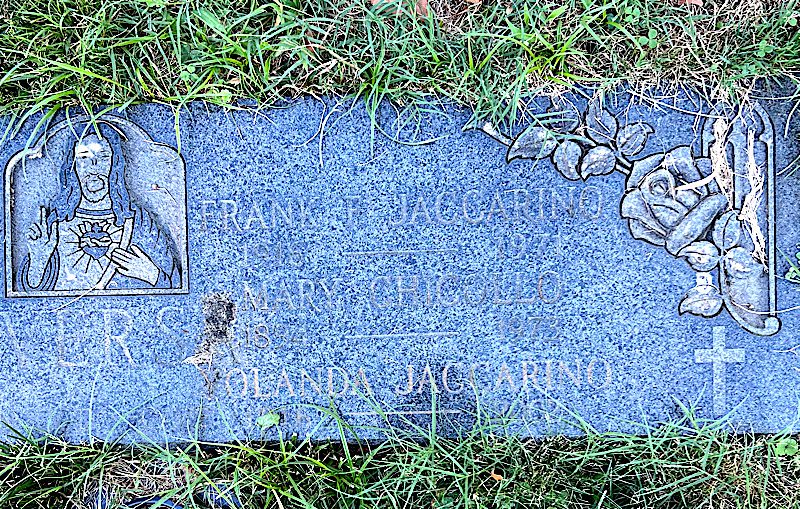
JEROME, LEONARD W. (1817-1891). Grandfather of Winston Churchill, stock speculator and sportsman. Born on a farm near Syracuse, New York, he graduated from college and became a lawyer in Rochester. But Wall Street, “a jungle where men tear and claw,” beckoned, and he went there, making and losing fortunes as a Wall Street speculator. He often hosted lunches for the financial editors of the Herald and the Tribune, at which he let slip information which, when published, helped his investments. One investment of his lost close to a million dollars in two hours. His partner in many of these speculations was William Travers, who also shared Jerome’s love of horses. Jerome, Travers, and August Belmont founded the American Jockey Club in the 1860s. He and Travers also helped to found the Saratoga Racing Association. In 1866 he opened his racetrack, Jerome Park, in what is now the Bronx, on 230 acres. It was the first flat race track in America and had a grandstand which seated 8,000. Jerome Park soon became the fashionable place for New Yorkers to see and be seen during the spring and fall. He also built the boulevard running from Macomb’s Dam to Jerome Park; Jerome Avenue still carries his name, though Jerome Park is long gone.
Jerome and his wife had three daughters, all of whom married Englishmen. The most famous of these marriages was that of his daughter Jenny to Lord Randolph Churchill. Their child was Winston Churchill, who was to lead Great Britain during World War II. His home at Madison Avenue and 26th Street, designed by Thomas R. Jackson (see), was built in 1859 for lavish entertaining and was one of the first and most distinguished French Second Empire mansions in New York City. It had a theater which seated 600, on the stage of which Jerome gave young and attractive female singers, with whom his relations were notorious, an opportunity to perform. As his sister once said of him, he had “much sense of honor and hardly any sense of sin.” His adjoining stables were carpeted and paneled in black walnut. It was from these stables that Jerome introduced four-in-hand driving (four horses and a coach) to America. At the first ball held at his mansion, one fountain circulated champagne, the other eau de cologne. It was at a meeting in his mansion that The Metropolitan Museum of Art was founded in 1869. The mansion, after it ceased to be a residence, became the University Club and then the Union League Club. It was designated a New York City landmark in 1965 but was torn down in 1974 when its owner (intentionally or otherwise) failed to repair a badly leaking roof.
Jerome was also active in supporting the Union during the Civil War. Jerome paid the expenses for the first great Union meeting at the Academy of Music. In the wake of the Draft Riots of 1863, he helped to finance the fund for its victims. He gave $35,000 for construction of the ship Meteor, which was designed to capture the Confederate ship Alabama. Section 37, lot 14234.
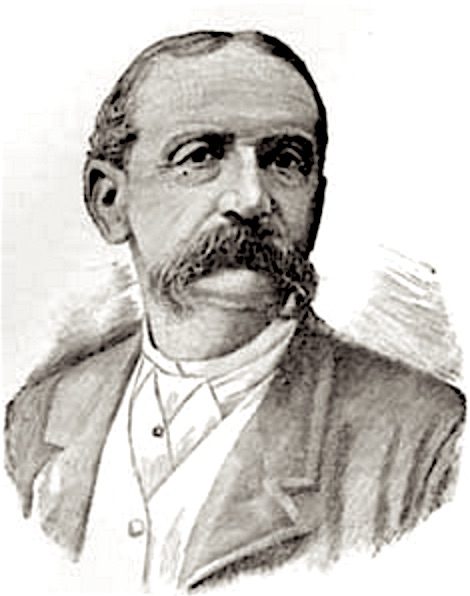
JOHNSEN (or JOHNSON), LORENTZ (or LAURENCE) EGENES (1911-1991). Corporal, 80th Division, United States Army. A Brooklyn native, according to the 1920 census, he lived on 41st Street in Brooklyn with his parents, both born in Norway, and two siblings. It appears that he visited Oslo (then called Kristiana) with his mother, in 1915, sailing there on the ship Jarnvag and returning on the Oscar II.
According to his enlistment records, Lorentz completed four years of high school. His son Paul states that he attended Stuyvesant High School. Lorentz Johnsen served twice in the United States Army. Prior to his World War II service, he enlisted in the Army on April 30, 1930, at age 18, where he served in the Headquarters Company, 93rd Infantry Brigade. He was honorably discharged three years later, on April 13, 1933.
Lorentz married Esther Violet Andersen on March 23, 1938. They had two children. At the time of his second enlistment, records state that he worked at Peerless of America, in Long Island, Queens. During World War II, according to his son Paul, he served in France and Belgium, and took part in the Battle of the Bulge. His son reports that he was a mechanical engineer. Johnsen died in Brooklyn. Section G, lot 1611 (Urn Garden).
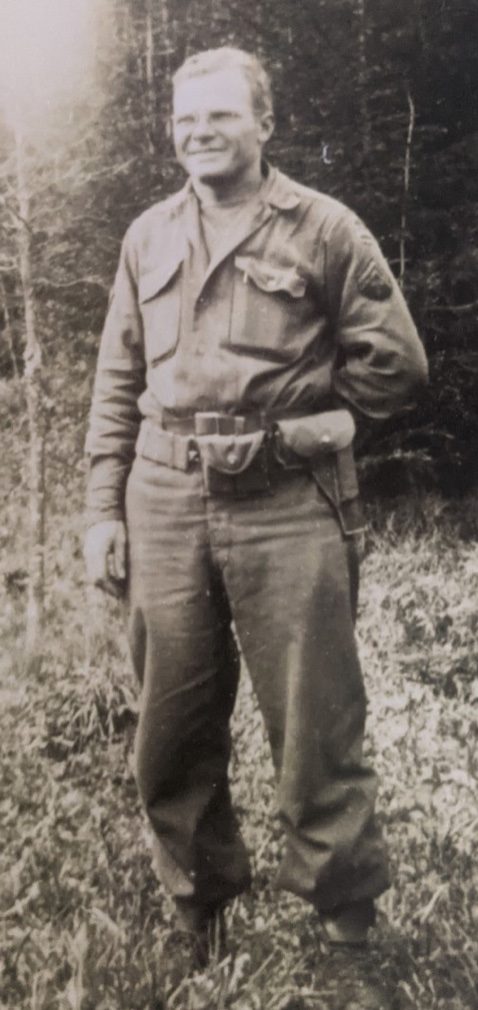
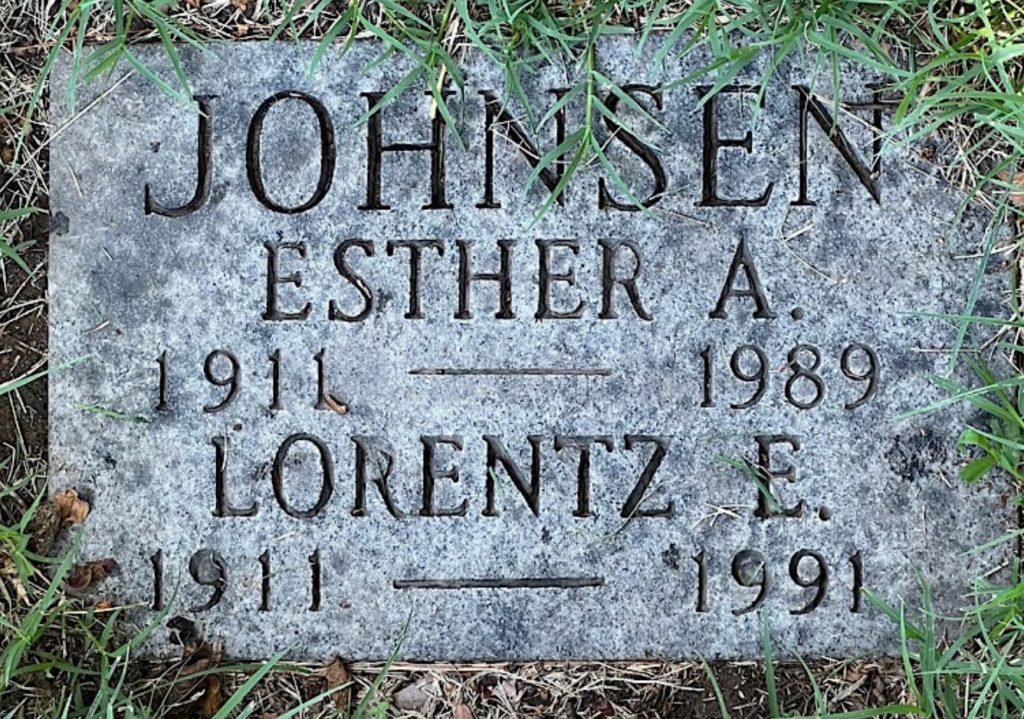
JOHNSON, ROBERT SHELDON (1919-1957). Lieutenant, United States Naval Reserve. According to the Ohio Birth Index, Johnson was born there. As per the 1920 federal census, he lived with his parents, Roy and Henrietta, at 1453 Lincoln Avenue, Lakewood, Ohio. His father was an engineer in the construction business. The Johnson family lived with Robert’s paternal grandparents, John L. and Elizabeth Johnson. His grandfather was a railroad conductor. Also recorded in the household is a boarder, Olga Edstrom.
As indicated in the 1930 federal census, Robert, his parents, and his grandmother still resided at the Lakewood, Ohio address. Robert was inadvertently omitted from the census page that lists his family and was recorded on another sheet. The 1937 issue of the Lakewood High School Yearbook refers to Johnson as “Bob” and records football, swimming, cinema, Hi-Art Guild, and auto as his extra-curricular activities. According to the 1940 federal census, he and his parents resided at the Lakewood, Ohio address recorded in the 1920 census. Robert was 20 years old, single, and had completed his 3rd year of college. His father is listed as a field engineer in the steel mill and oil refinery construction industries. As per school yearbooks, Johnson attended Purdue University in West Lafayette, Indiana. In 1941, he was a senior at the university.
His World War II draft registration card indicates that his address was still 1453 Lincoln Avenue and he named his father as next of kin. Under employer’s name, Johnson wrote “Student, Purdue University.” The registrar’s report, dated October 16, 1940 and stamped Lakewood, Ohio, describes him as 5′ 11″ tall, 160 pounds, with brown eyes, black hair, and dark complexion.
As per the Headstone Applications for Military Veterans, completed by his widow, Johnson enlisted in the Naval Reserve on August 25, 1942 and was honorably discharged on December 29, 1945. The application also states that he served on the USS Roy O. Hale (DE-336), classified as an Edsall-class destroyer escort in commission from 1944 to 1963. According to the Naval History and Heritage Command website, following are the events the USS Roy O. Hale took part in during Johnson’s enlistment:
Following shakedown off Bermuda, Roy 0. Hale served as a training ship for pre-commissioning details of escort crews in Chesapeake Bay and provided escort services between New York and Norfolk. On 1 July 1944 she departed Norfolk on the first of seven transatlantic convoys. Engaged in that duty until the surrender of Germany, her first convoy consisted of 24 ships bound for Taranto, Italy. On 20 July, 4 days after reaching her destination, she was at sea with the return convoy which she left at New York on 3 August. From 24 August to 27 September, she made another escort run to Italy, then shifted to the North Atlantic sea lanes. Between 30 October 1944 and 3 June 1945, she escorted five transatlantic convoys from the United States to ports in the United Kingdom and France.
After an overhaul, the destroyer escort departed Norfolk for the Pacific on 13 July. She underwent refresher training off Cuba, then continued on to San Diego and was engaged in further training when hostilities ceased. On 26 August, she sailed for Pearl Harbor arriving on 2 September for a month of escort and plane guard duty. On 17 October, she returned to San Diego with veterans awaiting discharge then proceeded to Panama and the east coast. Back in the Norfolk area by 3 November, Roy 0. Hale shifted to Green Cove Springs Fla. in early December and began inactivation.
As per Select Military Registers, Johnson is recorded on the January 1, 1943 Naval Reserve Register as an ensign. The July 1, 1944 Naval Reserve Register indicates he held the rank of lieutenant, junior grade. Johnson served in the European Theater of Operations and received the World War II Victory Medal and the European Theater Medal.
According to his obituary, Robert married Barbara in 1943. The couple had two children, Robert Sheldon Jr. and Suzanne. Section K, lot 18144, grave FLC.
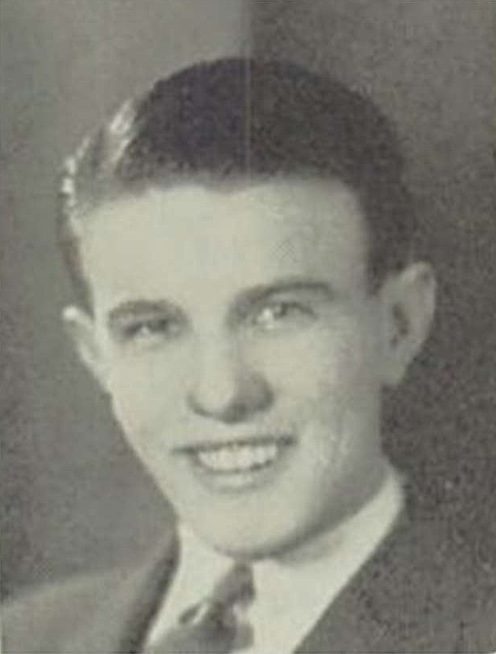
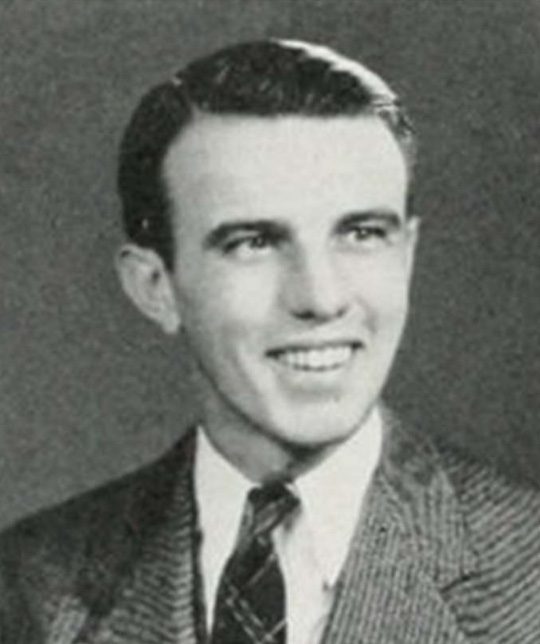
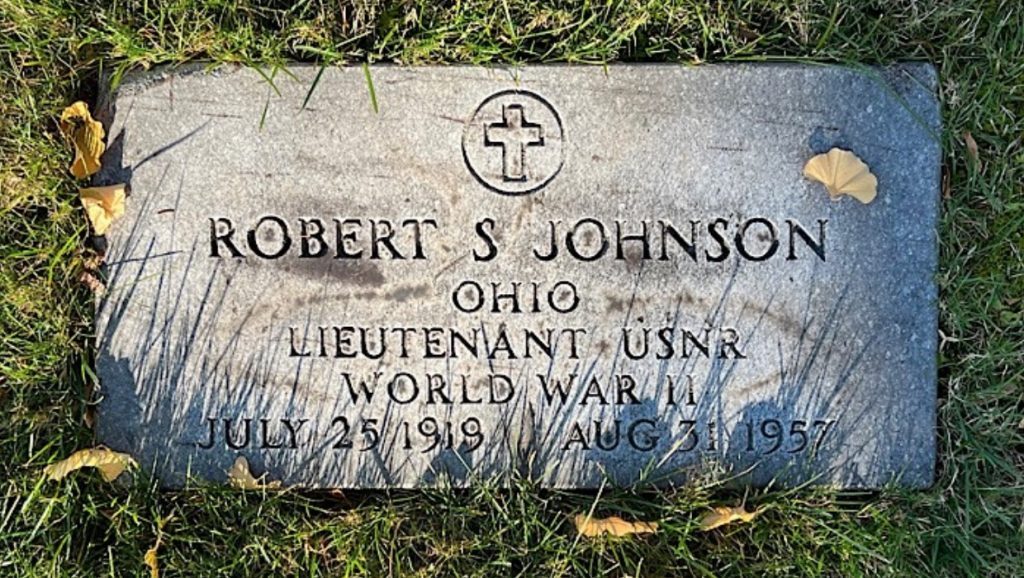
JONES, FRANKLIN CHESTER (1921-1977). Corporal, United States Army. Jones was born in Brooklyn. As per the 1925 New York State census, he lived with his parents, Benjamin and Viola, at 220 50th Street, Brooklyn. His father was an ironworker. Jones was the fifth of six siblings: the others were Adelle (misspelled as Adell on the census), Elsie, William, Marion (or Mariam), and his younger brother, Frederick (see). The 1930 federal census documents that the family resided at 1601 Bedford Avenue, both parents were janitors, and the family had grown to seven children with the birth of Albert. His father was born in New Jersey, as was his brother, William. His sister, Mariam, was born in Pennsylvania. He, his mother, and the remainder of his siblings were born in New York.
At the time of the 1940 federal census, Jones lived with his mother, listed as head of household, and four siblings on 58th Street in Brooklyn. Jones had completed school through the 8th grade and worked as a laborer for the City of New York. As per World War II Army enlistment records, Jones enlisted on May 22, 1941. His rank was private and the branch of service was field artillery. He had completed one year of high school and his civilian occupation was pressman. An article in the July 12, 1943 Brooklyn Daily Eagle records: “After a 30-day furlough Corp. Franklin C. Jones of 637 56th Street has returned to his post at Fort Knox. Corporal Jones, who has recently returned from a station in the Panama Canal Zone, has two brothers serving in the Seabees as first-class seamen.” Since Jones was reported as being stationed in the Panama Canal sometime between May 1941 and July 1943, he may have taken part in the following activities as described by weaponsandwarfare.com:
In 1941, a major command reorganization was precipitated when the United States took into protective custody the British possessions (and prospective base sites) of Jamaica, Antigua, St. Lucia, Trinidad, and British Guyana. To administer these new bases, and to quell issues of command extent between the various Army and Navy forces in the area, a theater command was established. The Caribbean Defense Command was officially activated on 10 February 1941, under the command of General Daniel Van Voorhis, then the commander of the Panama Canal Department. The Caribbean Defense Command was initially set up as strictly Army, and coordination with Navy operations was by “mutual cooperation.”
The Army and Navy personnel in Panama had been on full alert since midsummer 1941. The first immediate effects of the United States’ December entry into the war were ones of command structure and reinforcements. The first order of business was to create a unified command through which Army and Navy could be coordinated. President Roosevelt put the Army in charge of the Panama sector, and the Navy in charge of the more distant Caribbean Coastal Frontier on 12 December 1941. General Andrews thus assumed command of both Army and Navy forces in the area on 18 December 1941. Both air and ground forces were heavily augmented over the next two months, with the Panama garrison strength reaching 39,000 by the end of December, and growing to 47,600 by the end of January 1942.45
For those living and working in the Canal Zone, World War II was “a time of perceived danger during which the movement of materiel, troops and supplies through the waterway was a critical part of the war effort.” While Panama and the Canal both escaped enemy attack, a damaging U-boat campaign was carried out against shipping in the Caribbean. From February through December 1942, some 270 ships in the area had been sunk by U-boats. The peak of the German U-boat threat came in the summer of 1942. In the month of June alone, 29 vessels were sunk in the Atlantic Sector of the Panama Sea Frontier. Caribbean Defense Command peak strength of 119,000 was reached in December 1942. Of these, over half were stationed in Panama to protect the Canal from attack or sabotage. By mid-summer 1943, the U-boat threat was receding due to increased effectiveness of the theater’s antisubmarine forces, the effects of Allied victories in other waters, and the shift of U-boats away from the Caribbean.
As per a World War II hospital admissions card, Jones was admitted to the hospital in June 1944 for an undisclosed ailment (diagnosis withheld) and was discharged for duty on an unspecified date in 1944. A second World War II draft card for Jones, dated September 28, 1945, indicates that he was twenty-three years old, unemployed, and resided at 637 56th Street with his mother and brother, Franklin. His mother is named as next of kin. The registrar’s report describes him as 6′ 4″ tall, 175 pounds, with brown eyes, brown hair, and ruddy complexion. There is a note on the report that states “Discharge papers 9/24/1945.” There is no information regarding where he served during this re-enlistment.
After the war, on February 1, 1947, Jones married Anna Clair Bruce in Brooklyn, as indicated by the New York City Marriage License Indexes. The United States Department of Veterans Affairs BIRLS (Beneficiary Identification and Records Locator Subsystem) Death File indicates that he re-enlisted in the military on March 4, 1948 and was discharged on March 4, 1951. His employment card records that he lived at 772 54th Street in Brooklyn and was a machinist for six years at American Machine and Foundry. He then gained employment at the Bethlehem Steel Shipyard, was laid off on August 7, 1958, and resigned on August 20, 1958. He passed away in Brooklyn. According to his obituary in the Daily News, he was survived by his wife and seven children. Section 158, lot 14267.
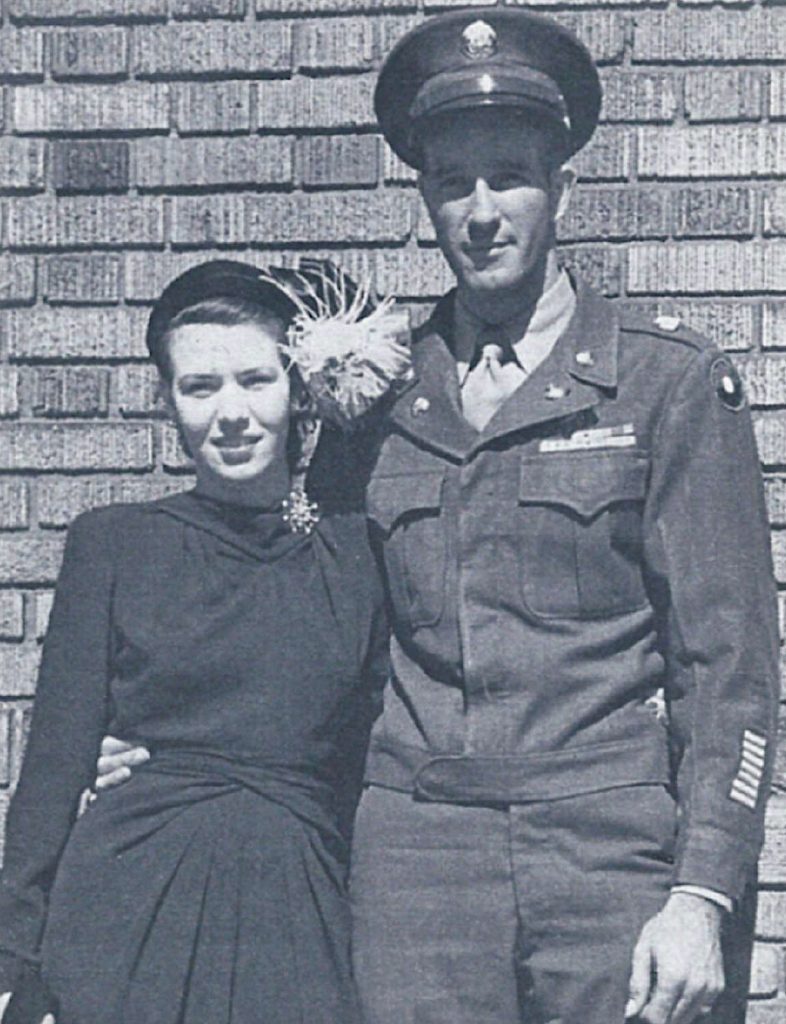
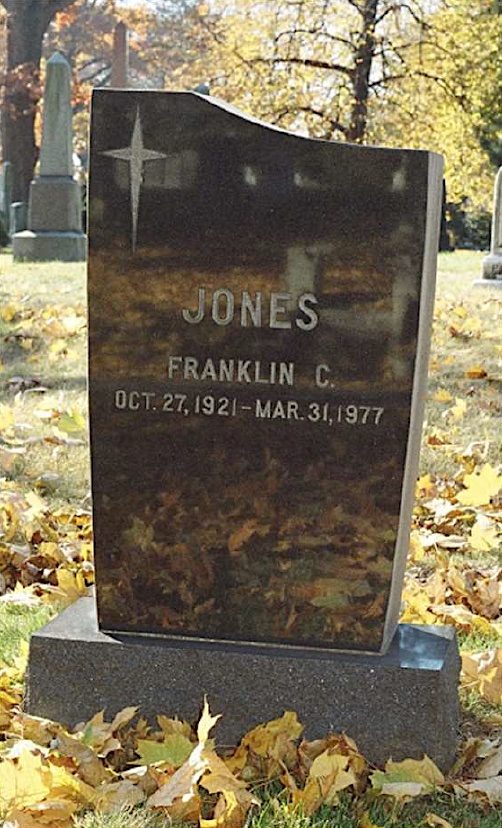
JONES, FREDERICK LEROY (1924-2003). Fireman first class, United States Navy. Frederick was born in Brooklyn, the sixth child of Benjamin and Viola Aldrich Jones. According to the 1925 New York State census, his father was employed as an iron worker and his mother was a homemaker. By the time of the 1930 federal census, the family had moved to an apartment house on Bedford Avenue, where both parents worked as its janitors, and had added a seventh child; Frederick’s younger brother, Albert. Benjamin Jones, head of the household, died two years later, in 1932. The 1940 federal census recorded the widowed Viola Jones as head of a household on 58th Street in Brooklyn that included high school-student Frederick and four other siblings.
In June 1942, 18-year-old Frederick registered for the draft. According to his registration card, he was employed with the Montrose Company of Brooklyn. The card described him as 5′ 2½” tall, weighing 132 pounds, with gray eyes, brown hair, and a dark complexion.
Many military records were lost in the ensuing years, so complete dates and details of Frederick’s Navy service have not been found. But a 1944 United States Navy battalion roster lists Frederic Leroy Jones, SF3c (shipfitter third class), of Brooklyn, in United States Naval Construction Battalion 040. He also appears on a list of discharges from the USS General Mann on November 25, 1947. His rank at the time of discharge was F1, or fireman first class.
The 1950 federal census documents Frederick, age 25, as living on 56th Street in Brooklyn with his mother, Viola. He worked as an exterminator for the government, apparently in a truck service.
In 1953, Frederick got married. His wife, Beatrice Asdourian, had been born in Manhattan one year earlier than Frederick. In 1956, he took a job as a groundskeeper for the government in Bayonne, New Jersey, and worked there until his retirement in 1981. Frederick and Beatrice settled in Woodbridge, New Jersey, around 1973, and were married for 50 years.
Of Frederick’s large Brooklyn family, three of his brothers were also veterans of World War II. Franklin Jones is buried in Green-Wood and Albert Jones is buried in a national cemetery in Florida. Frederick’s brothers-in-law, veterans Thore K. Thompson (see), Henry S. Thompson (see), and Walter C. Asmann(see) all survived the war and are buried in Green-Wood.
Frederick died early in 2003, and is buried in Green-Wood next to his parents. Section 158, lot 14267.
JONES, RALPH L. (1926-1994). Airman 3rd class, Army Air Corps, United States Army Air Force. Jones was born in Brooklyn. The Social Security Applications and Claims Index states his father was Hamilton L. Jones and his mother was Grace M. Kraut. According to the 1930 federal census, his parents were divorced and his mother was a stenographer. Jones, his mother and older brother, Irving, lived with his maternal grandfather on Prospect Avenue in Brooklyn. The 1940 federal census states that his family still resided with his mother’s family. His brother was listed as head of household and was an inspector at a manufacturing company. His mother was a secretary at a construction company.
According to his World War II draft registration card, Jones was 18 years old, resided at 1603 11th Avenue, and was employed by Virginia Polytechnic Institute. Under “place of employment,” Jones wrote “student and civil engineer.” His mailing address is recorded as Box 1139 V.P.I., Blacksburg, Virginia. The registrar’s report, dated June 30, 1942, describes him as 6 feet 1/2 inch tall, 235 pounds, with blue eyes, red hair, and sallow complexion.
On March 31, 1939, the Brooklyn Daily Eagle reported that Jones, a graduate of Manual Training High School (now John Jay Educational Campus), was a management engineering student at Rensselaer Polytechnic Institute in Troy, New York, and was appearing in the school production of “The Devil’s Disciple.” However, his schooling was interrupted by his military service. The Veterans BIRLS (Beneficiary Identification and Records Locator Subsystem) Record indicates that he enlisted on February 23, 1943 and was discharged on October 23, 1945. Little is known about his military service other than he was Airman 3rd class and served in the Army Air Corps. According to the Army Aviation website:
The Army Air Forces was formed in 1941, from the Army Air Corps, in response to the growing structure and mission that Army aviators were playing and the need for a more independent command structure. When created, several other nations had already adopted independent air forces but the United States made the decision to leave aviators as a part of the Army.
The Army Air Forces was born in one of the biggest steps toward an independent Air Force. With the threat of war looming, the aviation branch underwent a massive reorganization and the Army Air Forces was given control over all of Army aviation under the direct orders of then-Chief of Staff Gen. George C. Marshall.
At the Air Corps’ height, it had more than 2.4 million people and 80,000 aircraft in service and flew more than 2.3 million missions during World War II. Eventually becoming the Air Force in 1947, many of the pilots and missions of the Army Air Forces moved to the newly formed branch of service.
The Army was left with a handful of pilots and planes flying observation missions for field artillery units, but this would be short-lived as a new and revolutionary concept in aviation would change modern combat forever.
After Jones’s service, he seems to have returned to R.P.I. to continue his education. According to a brief announcement in the May 22, 1947 issue of the Brooklyn Daily Eagle, Jones had a role in Rensselaer’s play, “The Queen’s Husband.”
As per the New York Marriage License Indexes, Jones and Louisa E. Lobland applied for a license on October 29, 1949 in Manhattan. According to the Connecticut Divorce Index, the couple was married in November 1949, but separated in July 1962. At the time, they had two children under the age of 18. The divorce was made final in Danbury, Connecticut, on June 21, 1968. He was a driver for a bus company and had not remarried after his divorce. His last residence was 177 Whitewood in Waterbury, Connecticut. The date of his death is validated by the Connecticut Death Index. Section 181, lot 38137, grave 4.
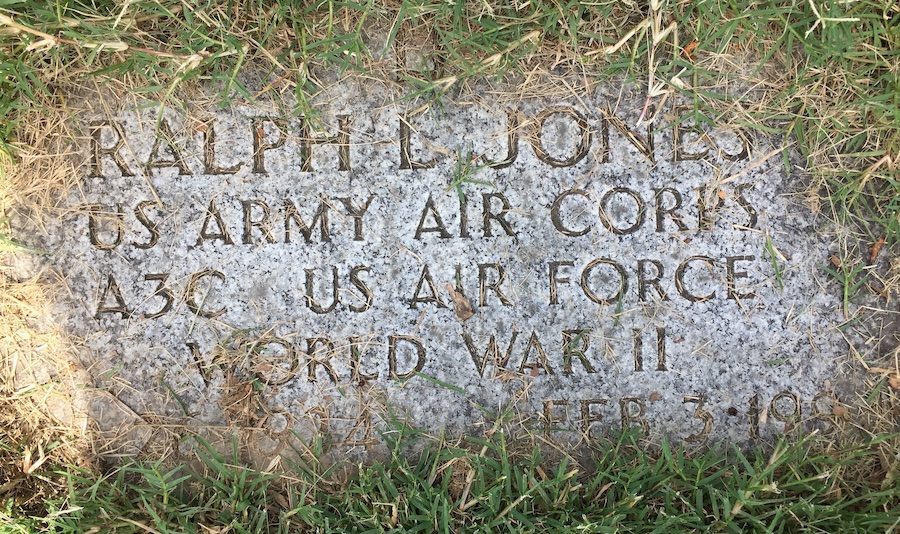
JUDSON, PHILIP MacGREGOR (1910-2002). Lieutenant colonel, United States Army. According to the Federal District, Mexico, Civil Registration Births, Judson was born on June 28, 1910 in Mexico. His father’s name is documented as Raymond Judson and his mother’s name is recorded as Isabel MacGregor. However, as per the United States Consular Registration Certificates, Certificate of Registration of American Citizens, his father’s name is recorded as Walter Raymond Judson. His father, born in Dayton Ohio in 1882 and a mechanical engineer, arrived in Mexico in 1905. He was accompanied by his wife, Daisy I. MacGregor, also born in Dayton. In 1907, the couple had a child, Robert Raymond, born in Mexico City. The family lived in Mexico from 1906 to 1914, and Philip was born in 1910. According to his biography on WikiTree, the “family returned (to Dayton Ohio) after being evacuated from Mexico in 1914 during the revolution. The family moved to Santiago, Chile, in 1917.” As per his mother’s United States Passport Applications, the family lived in Chile from 1917 to 1920. On October 18, 1920, Judson’s mother applied for an emergency passport in Santiago, Chile, for herself, Judson, and his two younger siblings, Federic, born in 1911 in Mexico City, and Mary Isabell, born in 1919, in Santiago, Chile. According to the New York, United States, Arriving Passenger and Crew Lists, Judson, his mother, and siblings arrived in the Port of New York in November, 1920, on the SS Esquire. A New York, United States, Arriving Passenger and Crew List from 1923, states that Judson arrived in New York City from Valparaiso, Chile, on the SS Santa Luisa. Judson, then thirteen years old, is documented as visiting his father. His address is recorded as St. John’s Military Academy in Delafield, Wisconsin.
The 1932 University of Wisconsin-Madison yearbook states that Judson graduated from St. John’s and majored in mechanical engineering. He was a participant in many committees and activities with the yearbook listing some, but not all of the following: Homecoming Chairman Bucket Brigade Committee (1929); Military Ball Assistant General Chairman (1929); Military Ball Provost Marshal and Military Police Committee (1929); member of the Cadet Corps, Drill Team, and Varsity Fencing Team; and, Secretary, Treasurer, and President of Theta Delta Chi. As per the WikiTree biography, he married Betty Peck in 1938.
Judson’s military service is gleaned from his biography on WikiTree:
From 1941-1942, he served in the US Army at Camp Roberts in California. In 1943, he graduated from the Chinese Language Course at UC Berkeley and served in WWII in the China-Burma-India theatre under General Stilwell from 1943-1945, where he rose to the rank of Lt. Colonel. He remained in the Army serving in many places around the world, including Alaska, Vietnam and Panama. His final Army assignment was as ROTC Commandant at Alfred University in Alfred, New York… He was awarded the Silver Star, the Bronze Star with V for valor, the Chinese Order of the Cloud and Banner and the Asiatic-Pacific Medal with 3 battle stars for combat service with the CBI during WWII. He was awarded the Commendation Medal with Oak Leaf Cluster for meritorious service in Panama and a Second Oak Leaf Cluster for his service in Professor of Military Science at Alfred University.
After his military service, Judson taught mechanical engineering at Alfred State College from 1963 to 1970. He and his wife, Betty, had two children, a son and a daughter. According to the California Marriage Index, he married Virginia Dean on July 31, 1971 at the age of 60. His last residence was recorded as Austin, Travis, Texas. However, WikiTree relates that he retired to Corte Madera, California, where he lived until his death in 2002. Section E, lot 36555.
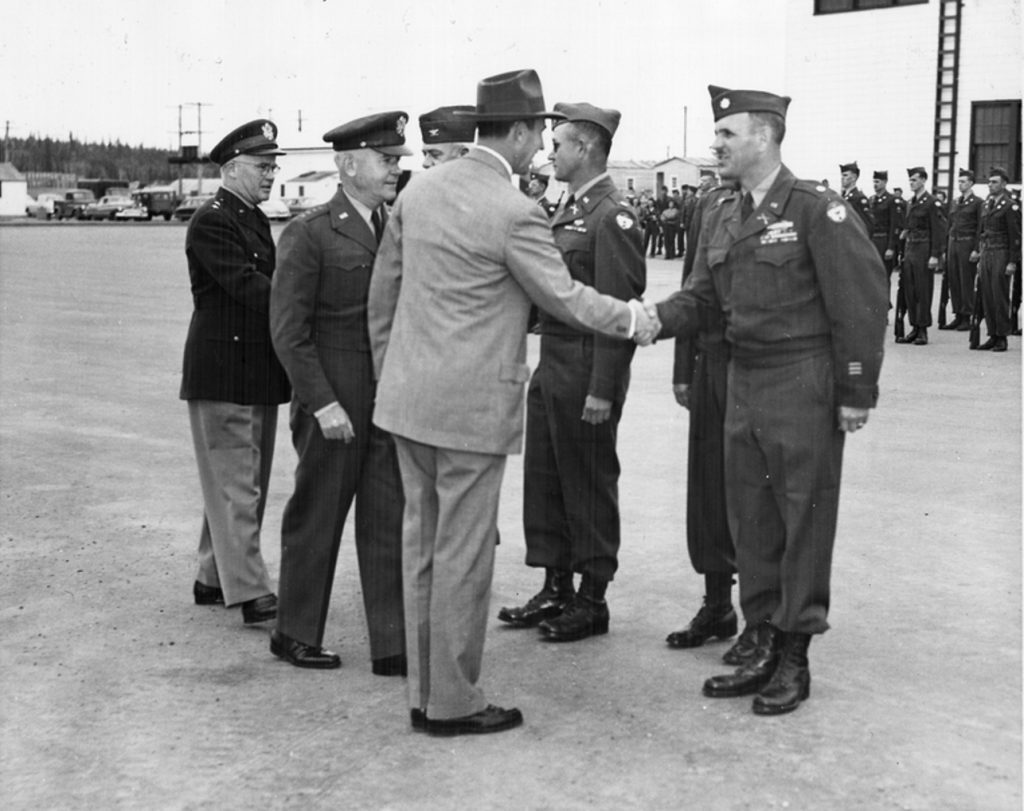
Harry S. Truman Presidential Library, 1949-1950.
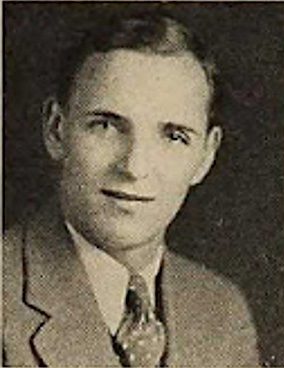
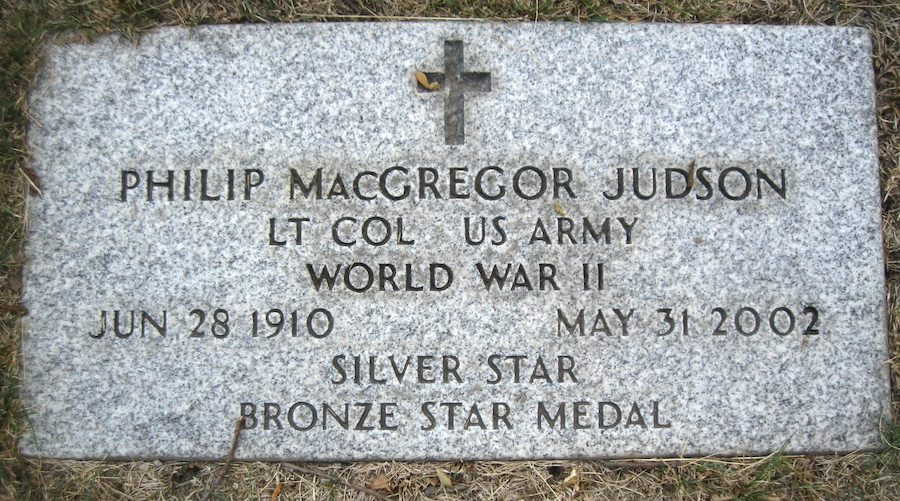
JUNKIN, RAYMOND (1918-1991). First lieutenant, United States Army. Raymond Junkin was born in Manhattan to John A. Junkin and Helen Gavin, both of whom were born in New York. By the time of the 1930 federal census, eleven-year-old Raymond was living in the Queens home of his uncle Nat, along with his father and grandmother.
In 1940, 20-year-old Raymond, a student at the University of Pennsylvania in Philadelphia, registered for the military draft, listing his address as 4220 Kissena Boulevard in Flushing, Queens. At the same address was his father, who would always know where to find him. The same year, Junkin married Muriel McCabe in Philadelphia.
On March 11, 1941, Raymond was inducted into the United States Army, having completed three years of college. His height was recorded as 5′ 9″, and his weight as 121 pounds. His occupation was recorded as draftsman. Sometime during his military service he rose to the rank of first lieutenant.
One of the first things Junkin did after the war ended was to marry Muriel McCabe—again. A marriage certificate gives the date as October 12, 1945, in Arlington, Virginia. The groom’s age was 27, his occupation was salesman, and his address was Burbank, California. The bride was 29 years old and resided in Hollywood. Both parties are listed as single and never married before.
He may have been the Raymond Junkin who, as per unspecified public records, lived on Dune Road in Westhampton Beach, New York, at some time. Section 143, lot 23418.
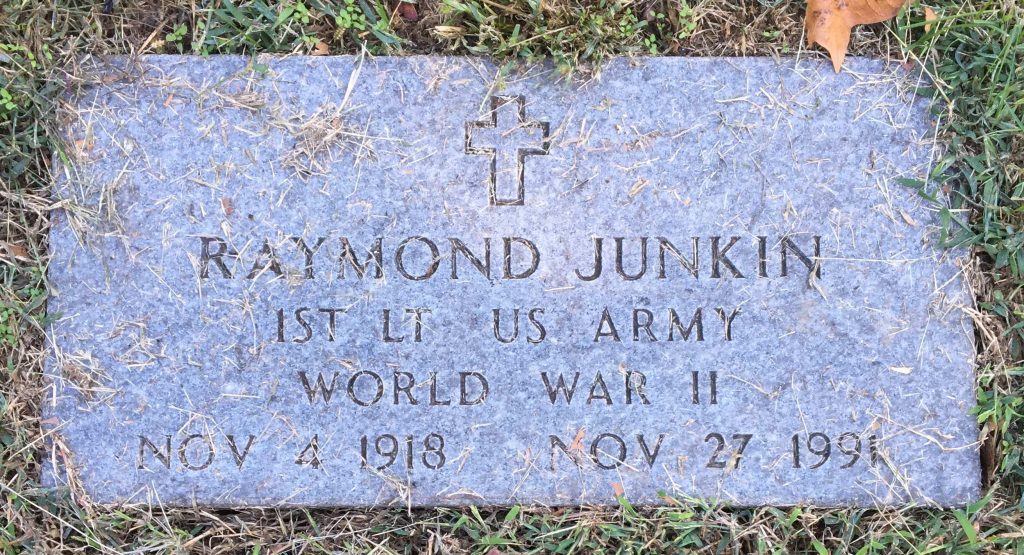
KABBEZ, GEORGE I. (1927-2020). Private first class, 3112 Signal Service Battalion, Company B, United States Army. George Kabbez was born in Woonsocket, Rhode Island. In 1945, 18-year-old George registered for the military draft, giving his address as 5008 9th Avenue in Brooklyn. For the person who would always know his address, he named a friend, Mr. Stumacher, around the corner at 5009 8th Avenue. George was still a student at the Brooklyn High School of Automotive Trades in Williamsburg, according to the card. According to his son, George Kabbez Jr., his father attended William E. Grady Career and Technical Education High School (which opened in 1941), in Brighton Beach; he completed three and one-half years of high school.
George was inducted into the Army on August 9, 1945—the day the United States detonated a nuclear weapon over the Japanese city of Nagasaki, and six days before Japan’s surrender. He sailed for Europe on January 12, 1946. Kabbez served in the Army as a private in Company B of the 3112 Signal Service Battalion. He was inducted on August 9, 1945. According to his son, his occupation was in general maintenance, as a “powerman”—a specialist in the installation, operation, and maintenance of generating equipment for electric power. He attained sharpshooter status in rifle marksmanship. He was stationed in the European Theater of Occupation during almost all of 1946 and was awarded the World War II Victory Medal as well as the Army of Occupation Medal. He arrived home on Christmas Day, 1946, and was honorably discharged January 30, 1947.
On November 17, 1962, according to his son, George married Renee Zraick. The marriage was officially recorded sometime in 1963. George and Renee had two children. Kabbez worked for 30 years at Ryan Brothers Garage in Brooklyn. In the early 1990s his residence was still reported as being in Brooklyn, but at some point after that he moved to Staten Island. He died at the age of 92. Section P, lot 38436.
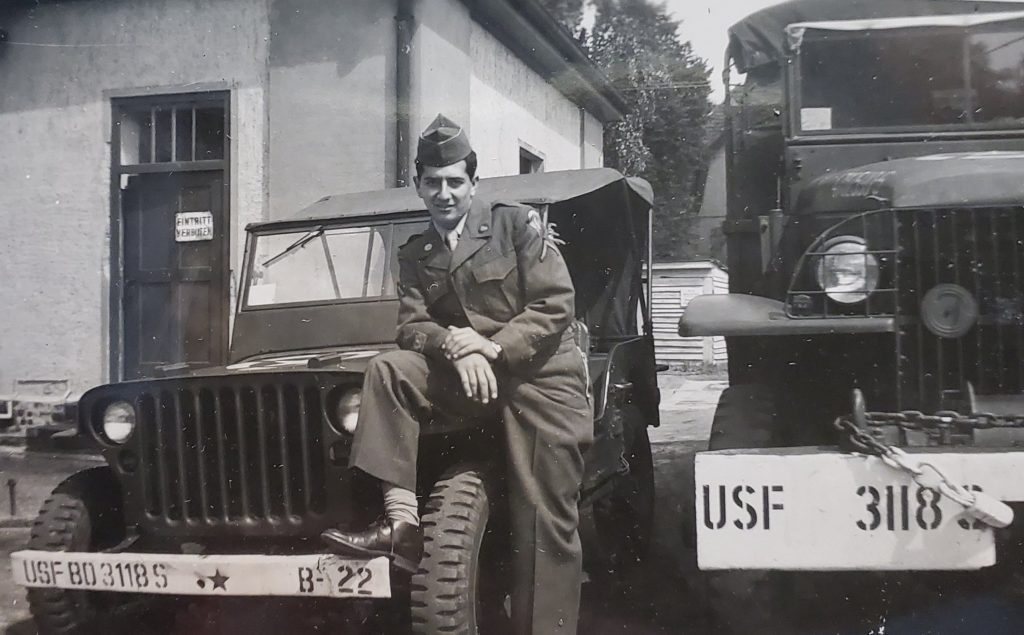
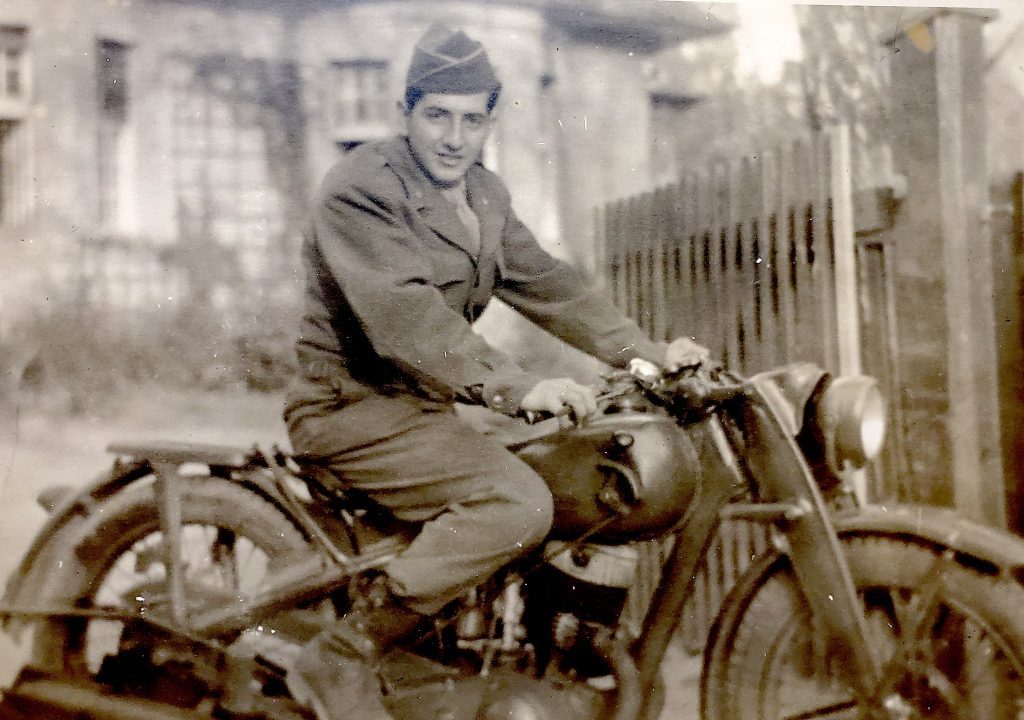
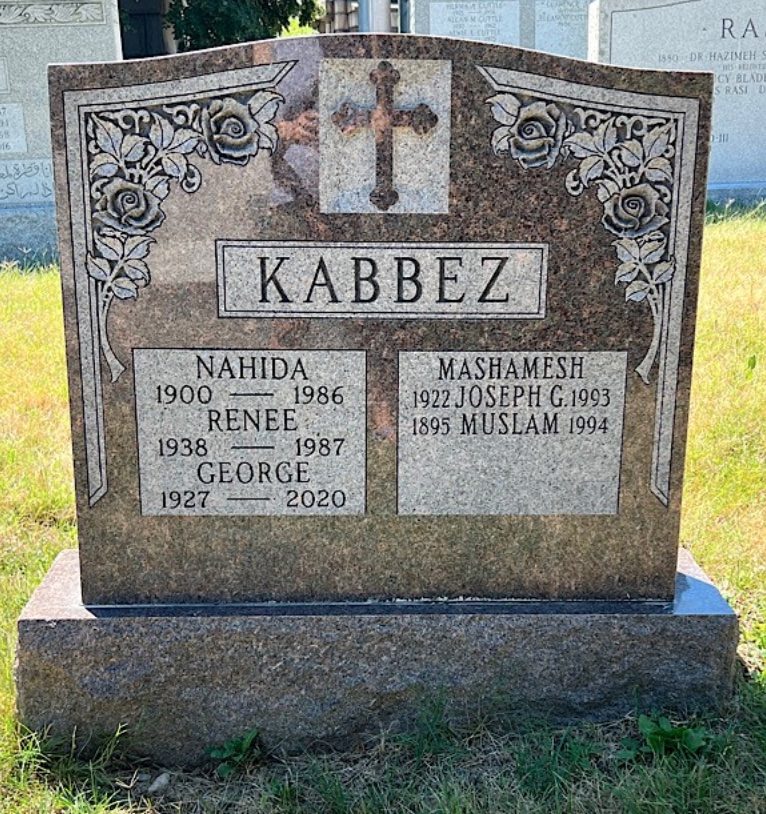
KAIATT (or KAIT), GEORGE (1918-1997). Private, United States Army. Born in Brooklyn, the New York birth index records his last name as “Kait.” The 1920 census reports that the one-year-old Kaiatt lived with his parents, Naif and Besima, his two older sisters, and a thirty-year-old uncle, Charles Zogub, in West Hoboken, New Jersey. As per that census, his father was born in Syria and immigrated to the United States in 1900 when he was 23 and his mother, who was also born Syria, came to the United States in 1903 at age 16. At that time, both parents worked. The census records that his elder sister, Alice, was born in New York in 1907, while Emily was born in New Jersey in 1911. The family surname is spelled “Kiatt” in this census. As per the 1930 census, the family was residing in Union City, New Jersey. His father had become a United States citizen and was a manager for Kimono Works. His mother was no longer working, nor was his uncle living with them. His two sisters worked as seamstresses for a dress company. This census records the spelling of the family surname as “Kaiatt” and that both sisters were born in New York.
According to the May 6, 1938, edition of the Brooklyn Daily Eagle, Kaiatt attended a dinner party in honor of the marriage of his friend, Anthony Bittar. Kaiatt attended the Columbia College of Pharmacy in New York City and its 1939 yearbook, Apothekan, lists Kaiatt and two friends as the “three musketeers” on the Hall of Fame page. By the time of the 1940 census, Kaiatt’s father had passed away and his mother was the head of the household. The family was then residing in Brooklyn. His sisters still worked in the garment industry and he is recorded as having attended four years of college. His occupation is listed as pharmacist.
On his draft registration card, Kaiatt listed 609 52nd Street, Brooklyn, as his address. However, that address has been crossed out with a red marker. The registration card lists Anthony Bittar, his friend from the 1938 dinner party, as his contact. Abraham Becker, at 5101 Sixth Avenue, is noted as his employer. Kaiatt’s World War II Army enlistment records disclose his enrollment date as October 9, 1942, at Fort Jay on Governors Island. He is described as single, 5′ 7″, and 174 pounds. As per his nephew, Kaiatt was a medic in the army, tending to many injured soldiers and witnessing some fatalities. He served in many battles in North Africa, especially in Morocco, and in the Italian campaigns.
After the war, Kaiatt enjoyed traveling. As per manifests from the cruise ship Nassau, he was a passenger for at least four consecutive summers, from 1954 to 1957, sailing from New York to Nassau and back. A TWA passenger list records him as arriving in New York from London on August 3, 1960. His address at the time was 8120 6th Avenue, Brooklyn, and the spelling of his last name reverted to “Kait.” Section 50, lot 38293, grave 2.
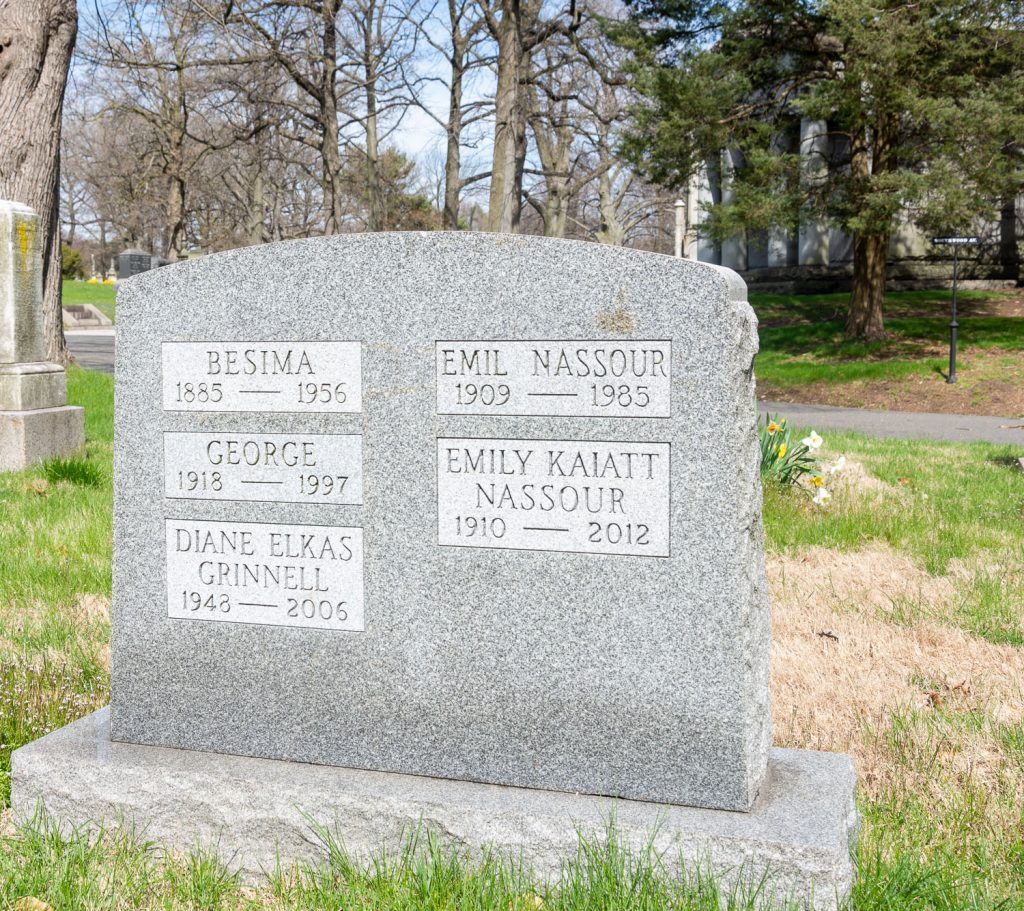
KAWAS, CHARLES JOHN (1919-1995). Tech 5th grade rifleman, 96th Division, 382nd Infantry, Company L, United States Army. As per the 1930 federal census, he lived with his parents, Paul and Wada, and four younger siblings at 554 7th Street in Brooklyn, New York. The census records that his parents were born in Syria and he was born in New York. His daughter, Mary Kawas Rotolo, shared that he attended Holy Name of Jesus School and Manual Training High School (now John Jay Educational Campus). According to the 1940 federal census, Kawas was twenty years old, single and lived on 15th Street in Brooklyn with his parents and siblings. He was employed, had worked for 28 weeks in 1939 and earned $1,125.
As per his World War II registration card, Kawas was twenty-one years old and resided at 462 15th Street in Brooklyn. He was employed at the Moon Silk Mill, located at 383 3rd Avenue in Brooklyn. His father was listed as next of kin. Kawas’s World War II Army enlistment records indicate that he was single, entered the service with the rank of private, had two years of high school, and worked in “the fabrication of textile products.” According to his daughter, Kawas’s highest rank in the army was Tech fifth grade, rifleman. He served with 96th Division, 382nd Infantry, Company L, and saw action on Leyte Island in the Philippines as well as Okinawa. Kawas may have taken part in the following engagements as described by the website about the 96th Infantry Division:
The 96th Infantry Division trained in Hawaiian Islands, July to September 1944, before entering combat in an assault landing in Leyte Gulf, Philippine Islands, between Tanauan and Dulag, 20 October 1944. Enemy resistance in the beachhead area was quickly broken and the Division had advanced to and secured the Tanauan-Dagami-Tabontabon sector by 9 November after heavy fighting. The Division continued to wipe out resistance on the island, engaging in small unit actions, patrolling, probing, and wiping out pockets of Japanese. Chalk Ridge was taken, 12 December 1944, and major organized resistance was at an end by Christmas Day. The next three months were spent in mopping up, security duty, training, and loading for the coming invasion of Okinawa. The Division left the Philippines, 27 March 1945, for Okinawa, making an assault landing on the island, 1 April 1945. The landing was unopposed and a beachhead was established near Sunabe, 1-3 April. Resistance stiffened considerably as the Division advanced to Gakazu Ridge, where fighting was fierce, 7-16 April. The 96th assaulted and cracked the fanatically defended enemy defense line, Tanabaru Nishibaru, 17-23 April, and after advancing slightly against extremely determined resistance, was relieved, 30 April, by the 77th Infantry Division. The Division trained and rested, 1-9 May, while elements mopped up bypassed enemy pockets and then returned to the offensive, 10 May, attacking and capturing Conical-Sugar Hill Ridge, 21 May, thus breaking the right flank of the Shuri defenses. Heavy rains the following week slowed down the advance. The offensive was resumed, 30 May, against weakening enemy resistance; Japanese north of Yonabaru-Shuri-Naha Road area were cleared out. Resistance stiffened again, 3 June, and Laura Hill was taken, 14 June 1945, only after a bloody fight; the last important Japanese defense position, the Yuza-Dake, Yaeju-Dake Hill mass, was secured by 17 June, and on 22 June all resistance was declared at an end. The Division patrolled an area from Chan to Ogusuku until 30 June. After resting in July, the Division left Okinawa for Mindoro, in the Philippines, and engaged in a training program. The Division left the Philippines, 17 January 1946, for the United States.
His daughter relates that Kawas was awarded the Bronze Star, the Asiatic Pacific Service Medal, the Good Conduct Medal, the Philippine Liberation Ribbon, and the World War II Victory Medal.
After his service, Kawas applied for a marriage license on November 18, 1946, as per the New York Marriage License Indexes. He married Margaret Griffin on November 8, 1946 and the couple had ten children: Teresa, Paul, Patricia, Thomas, Charles, Dennis, Doreen, Christine, Mary, and Richard. Kawas was employed as a textile worker in Manhattan’s Garment District. According to the 1992 United States Public Records Index, he resided at 10462 112th Richmond Hill, New York. Another residence is listed as 83 2nd Avenue, Lindenhurst, New York. The Social Security Death Index states that his last residence was in Brooklyn, New York. According to his obituary in the Daily News, dated October 24, 1995, he was survived by twenty grandchildren and five great-grandchildren. Section 104, lot 44606, grave 192.
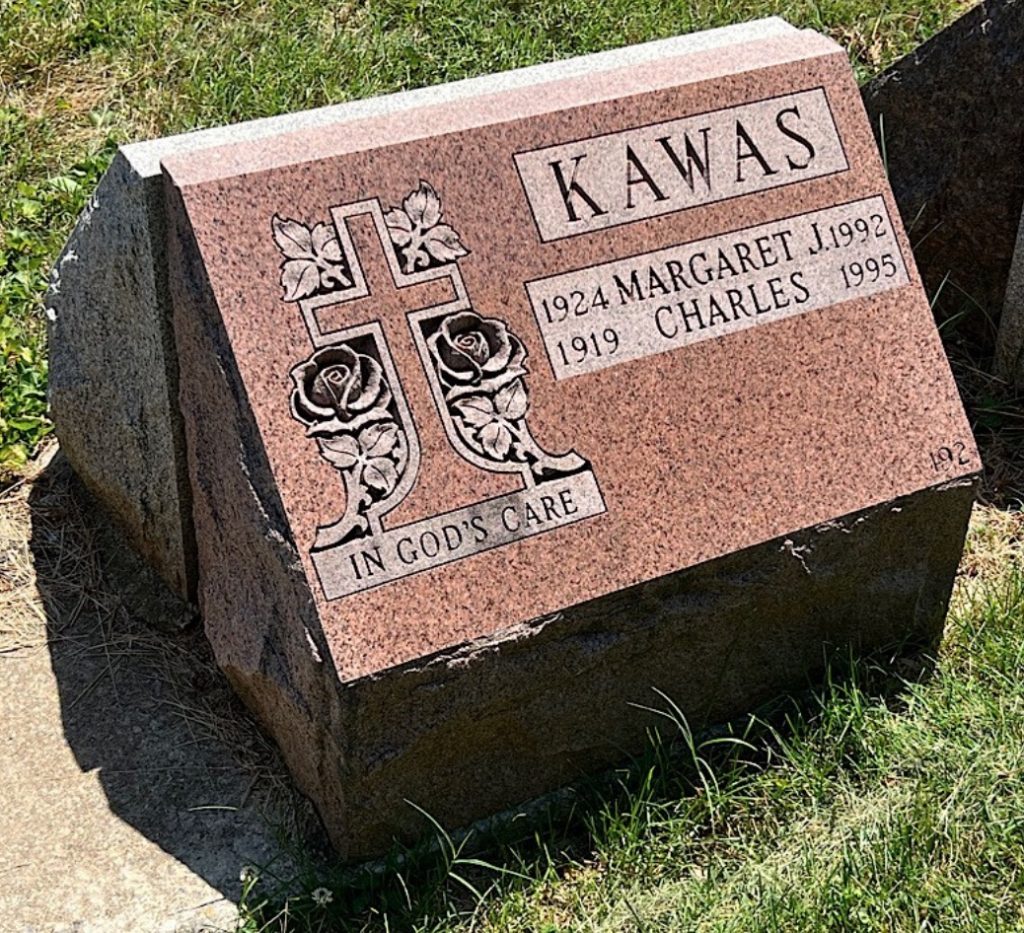
KERR, JR., CHARLES FREDERICK (1923-2018). Rank unknown, United States Army. Kerr was born in Brooklyn. According to his grandson, Kerr left home during the Depression to look for work. At fourteen years old, Kerr hopped a freight train with a friend and went first to Pennsylvania and then Ohio. After his friend chose to return home, Kerr continued his travels and for a time worked on a farm down South. The kind farmer whom he worked for eventually convinced Kerr to return to his family, and so he returned to Brooklyn.
According to the 1940 federal census, seventeen-year-old Kerr was living with his parents, Charles Sr., his mother, Helen, and his younger sisters, Theresa, Mary Ann and Edwina. Two maternal uncles were also part of the household. Charles Kerr Sr.’s occupation is listed as “sifter” for a powder company, and he had been unemployed for two weeks. According to the census, Kerr completed 7th grade, but went no further in school. He was working as a messenger for a telegraph company.
As per Kerr’s draft registration card, filled out on June 20, 1942, when he was 19 years old, he was employed by Robins Dry Dock and Repair Company in Brooklyn. He is described by the registrar as having blue eyes and brown hair.
As his grandson related, not long after Kerr took a job with Western Union, he decided to join the Army to fight in World War II. Kerr was among the soldiers who landed at Normandy; he also fought in the Battle of the Bulge.
Upon returning from the war, he met Eleanor Arthurs, whom he married in 1948. According to Kerr’s Bethlehem Steel Shipyard Employment Card, dated 1952, he had worked as a clerk in the United States Post Office for the previous two years. At the shipyard, he was employed as a laborer. The family lived on 5th Avenue in Brooklyn. Kerr and his wife had two children, Joann and Ronald.
A June 23, 2017 article from the Brooklyn Daily Eagle recounts an event from that April in which 50 veterans from New York City were given an opportunity to visit Washington, D.C. The 94-year-old Kerr was accompanied by his grandson, Liam McCabe. As per McCabe, it was his grandfather’s first trip to D.C. The veterans visited Arlington National Cemetery, the Lincoln Memorial, the Korean War Veterans Memorial and the Vietnam Veteran Memorial and the National WWII Memorial, which Kerr was especially moved by, according to his grandson. Kerr was interred in Green-Wood Cemetery on July 21, 2020. Section 1116, columbarium.
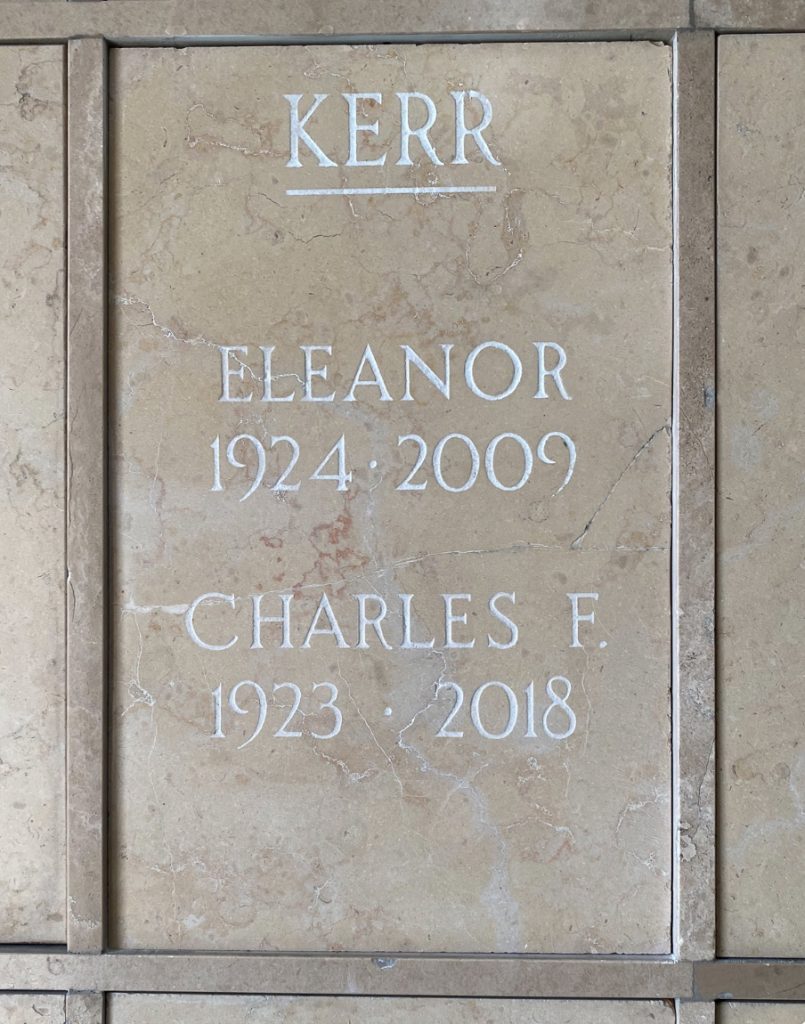
KHOURY, JOHN MICHAEL (1924-2020). Private first class, 7th Army, 100th Infantry Division, 399th Regiment, Company L. Khoury was born in Brooklyn to Syrian immigrants, Michael and Marie Khoury. According to the 1930 census, he lived at 540 East 48th Street, Brooklyn, which lists John, then 6, as the eldest of three children along with his sister Yvonne, 4 and brother Russell, 2. As per his obituary, he was a graduate of Manual Training High School (now John Jay Educational Campus), class of 1941, and studied at Columbia University where he played football but withdrew in his sophomore year to join the Army. By the time of the 1940 census, another child, Claire, had been born to the Khoury family. The family also employed a maid, Delia Lopez, 20, who, according to the census, lived in their home.
His draft registration card lists the same home address on East 48th Street. According to a self-published book about his war experiences, Love Company: L Company, 399th Regiment of the 100th Infantry Division During World War II and Beyond, Khoury was a “self-described tough kid from Brooklyn” who enlisted in the United States Army Enlisted Reserve program in October 1942, hoping to complete his college education before being called to active duty. This did not happen; Khoury’s army service began soon thereafter in the tank corps. He then was transferred to the air corps and ultimately, he became a sniper and rifleman. His book details brutal engagements as a member of the 7th Army in both France and Germany. He describes his view of the war as coming from the “subterranean level of a foxhole where all human senses are on full alert but the mind was atrophied.” The book jacket to Love Company describes each patrol as a “repetition of the last,” remembering the “shots of German burp guns and machine guns whizzing over my head as I hugged Mother Earth as they spewed bullets in tremendous bursts. Trees and branches splintered around me as they were hit…when we were bombarded with artillery shells, they tore up the ground and exploded in the trees showering us with shrapnel. They maimed and killed more men than any other weapon. The soldier had no defense against an artillery bombardment except to dig a foxhole with a cover. When you could fire back, you did it with anger and vengeance for the buddies that were hit.” According to Khoury’s son, John, the men in his father’s company called the German weapons “burp guns” because when they fired rapidly, the shots sounded like burps.
Khoury reports how the American forces “outfought the Germans in almost every battle,” his involvement in the surrender of a meticulously groomed high ranking German officer, the unsung hero of his war, Major General Withers aka Pinkey Burress, who as leader of the 100th Infantry, claimed “more enemy territory with fewer casualties than any other division in the war,” the “liberation” of cartons of “10-in-1” rations containing cans of orange marmalade, bacon, meat, and loaves of real bread and butter from the tanks of the 781st Tank Battalion, along with a full- sized shovel used to dig a foxhole in a quarter of the time it took with the regular entrenching tool, and incidences of unsettling friendly fire.
In addition, Khoury describes brutal house-to-house fighting during the Battle of Lemberg including the loss of his good “buddy,” Pfc. John W. Howe Jr. who had been “hit by shrapnel in several places, and his wounds were so severe that he did not survive.” After the battle, Khoury’s company was in reserve which allowed them to bathe out of their helmets, and shave a two week growth of beard with a dull Army razor. “I let my mustache grow just for a change. We scrubbed our clothes of the mud and filth. The supply sergeant gave each of us clean underwear and socks.”
On December 15, 1944, Khoury remembers reaching a wooded mountain facing the Citadel and Maginot Line at the town of Bitche, France. Some 500 yards away they could see huge concrete forts where the retreating German Army had taken up defensive positions. Khoury admits that they had no idea these fortifications were the strongest of the entire Maginot Line: “We only knew that this was the next objective. Looking at these gray, ominous forts did not make us feel very happy. We waited for orders to attack, but the enemy positions had to be softened up first.” Eventually it was the job of Khoury’s unit to take the forts where the Germans were waiting. “I had the task of carrying a satchel or beehive charge- a 25-pound, cone-shaped charge of TNT designed to cling to a vertical or horizontal surface. This had to be strategically placed by hand, and the fuse had to be ignited. Before it exploded, I would have enough time to find a cozy spot to wait in safety.” Khoury was skeptical that his job would be successful but he knew he would try to do it. “On other missions, I had known fear but I had not lost courage or determination. This time I had a mortal fear that it would be my last mission.” Eventually, the mission was aborted because all available resources were diverted to the Battle of the Bulge.
Khoury would see much fighting; a New Year’s Eve attack by the Germans on the 7th Army front, Hitler’s Operation Nordwind. The firing from the front lines was “furious and harrowing” and seemed to last for hours. The Germans were “drunk with schnapps” and returned very little fire. The German attack was broken. Despite this victory, Khoury was exhausted: “After two months of death and destruction I was tired of it and I felt like a very old man. I had thought for some time that the war was never going to end. What was the use of fighting? We had been living in the rain and snow during one of the coldest winters in recent European history. We shivered as we trudged out on patrols, and we never felt warm. Death would not have been a bad alternative. I did not tell my thoughts to any of my buddies. Besides, we had to move out to our next battle, and I had to forget such a stupid idea.” Khoury’s war soon ended: his feet became frostbitten and he was evacuated to a military hospital to recover. Khoury was hospitalized for weeks, during which time he gained enormous respect for the nurses who tended the sick, wounded and dying.
According to his obituary, Khoury remained in Europe with the army after the war, assigned to Kasel, Germany, where he managed a warehouse that provided food to displaced and destitute German civilians. According to his son John, the Germans were especially appreciative of the freshly ground coffee beans. Khoury was awarded the Combat Infantry Badge, Good Conduct Medal, European Theater Medal with Three Battle Stars, American Theater Medal, Army of Occupation Medal-Germany, Presidential Distinguished Unit Badge, Victory Medal, and Bronze Star with Oak Leaf Cluster for valor.
After his service, Khoury joined his father in the family textile business, married his childhood friend, Grace Magrabi, and moved to Tenafly, New Jersey, to raise their family. He was the father of four, Diane, Jeanne, Carol and John, and grandfather to George, Danielle, Mark and Nicole. He ran the family business with his brother Russel until he retired at 85. He was married for 68 years, his wife Grace having predeceased him. He was an active member of the Presbyterian Church of Tenafly. Section 128, lot 36787, grave 3.
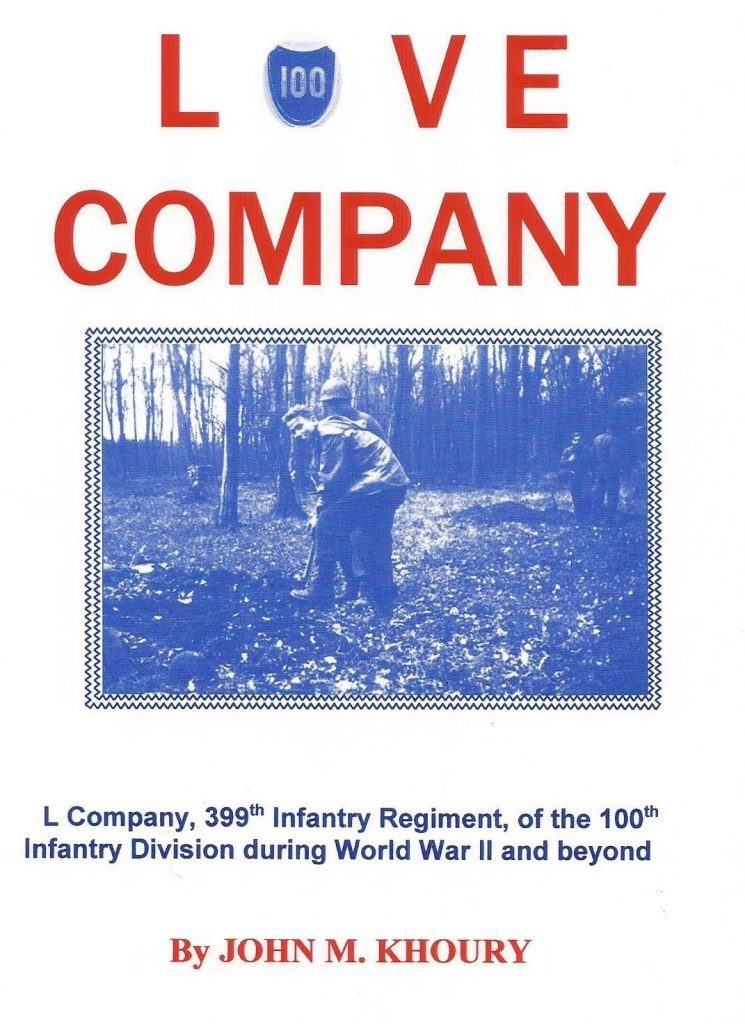
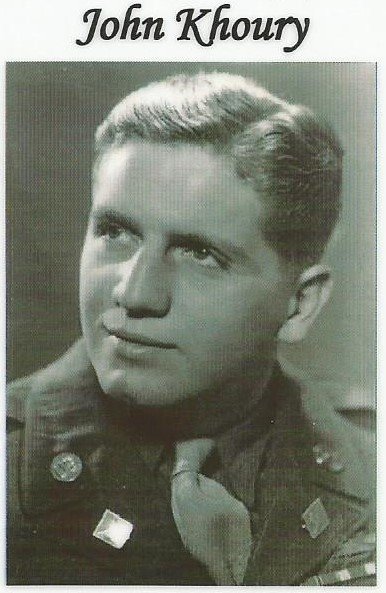
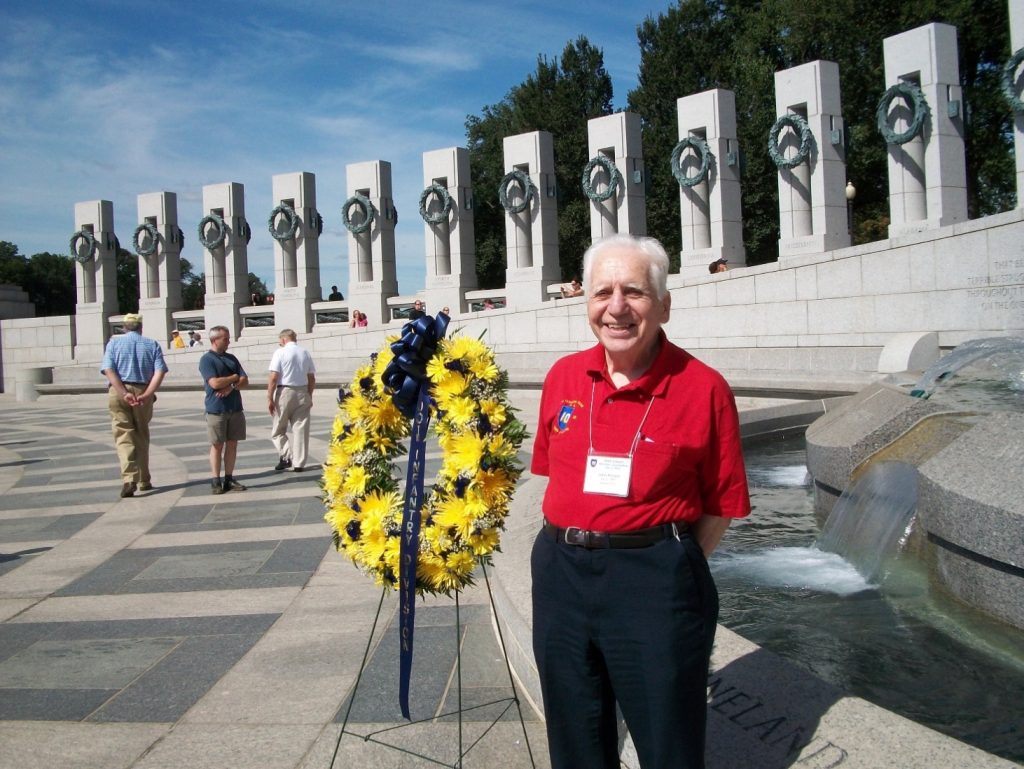

KLEINE, EDWIN DAWSON (1920-1967). Staff sergeant, 93rd Bomb Group, United States Army Air Force. Kleine was born in Queens, New York. As per the 1925 New York State census, he lived with his parents, George and Edith, and his older brother, Gilbert, in Queens. The 1930 federal census states that his father was born in New York and his mother was born in New Jersey. The family of four resided at 124-02 103rd Avenue in Queens. Similar to the 1925 census, the 1930 census incorrectly records Kleine’s birth year as 1921.
As per his World War II draft registration card, Kleine was born in 1920 in Woodhaven, Queens. He was a student at the Institute of Musical Art, located at 120 Claremont Avenue, New York City, and he still resided at 124-02 103rd Avenue in Richmond Hill, Queens. His father was listed as his next of kin. According to Army enlistment records, Kleine enlisted on July 21, 1942 at Fort Jay on Governors Island, New York. He was reported to have had completed three years of college, to have worked at “unskilled occupations in the building of aircraft,” and to have been 5’10” tall, weighing 186 pounds.
Little is known of his service during World War II or his civilian life after the war. The 93rd Bomb Group served in the Gulf of Mexico, the United Kingdom, and North Africa. A limited amount of information was detailed in Kleine’s engagement announcement to Betty Lou Nexsen in the Brooklyn Daily Eagle, dated December 26, 1943. According to the announcement, Kleine was 23 years old and a staff sergeant in the United States Army Air Corps. He was on active service in England with the 93rd Bomb Group and had received an Air Medal and three Oak Leaf Clusters for valor. As per the New York City Marriage License Indexes, he and Betty Lou applied for a marriage license in 1944 in Manhattan and was married on April 27.
In 1946, he was part of the committee of the Jewish Welfare Board that hosted a Thanksgiving party for Jewish War veterans in San Francisco, California. In April of 1947 he is listed on a program for a Passover seder held by the Jewish Welfare Board in San Francisco, as a veteran’s representative. In that same year, he is also listed on Jewish Welfare Board records as a member of the United Service Organizations (U.S.O.). From January 1, 1947, until April 1, 1951, he served as an officer in the United States Naval Reserve. At the time of his death, he was forty-seven years old and lived in Munsey Park, Nassau, New York. Section E, lot 36987, grave FLC.
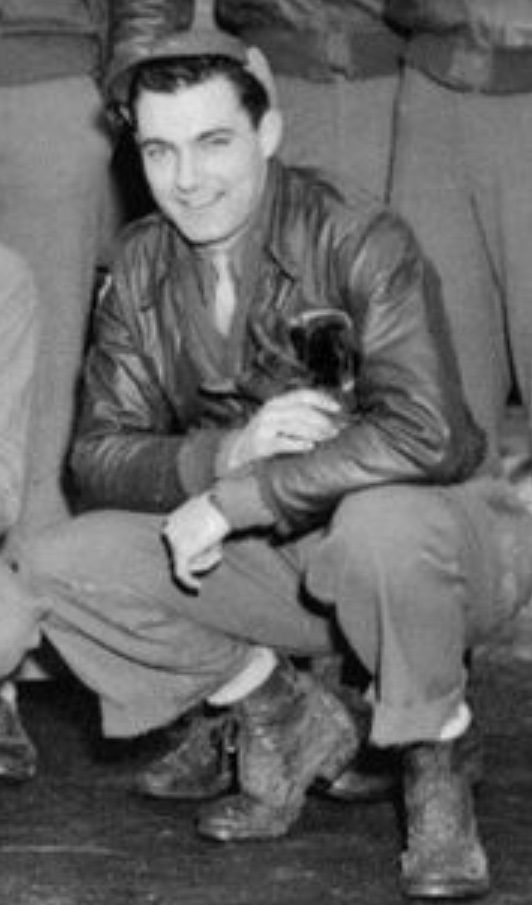
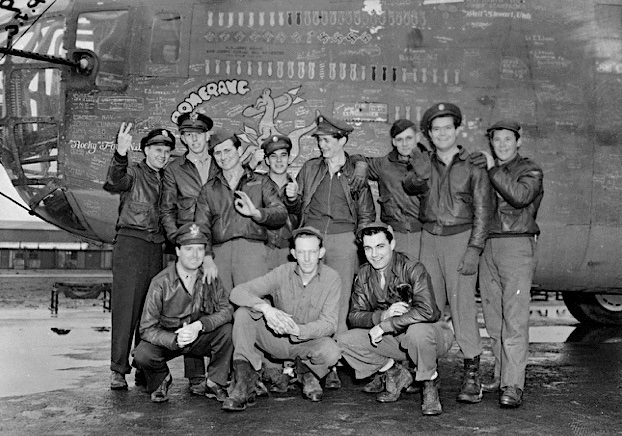
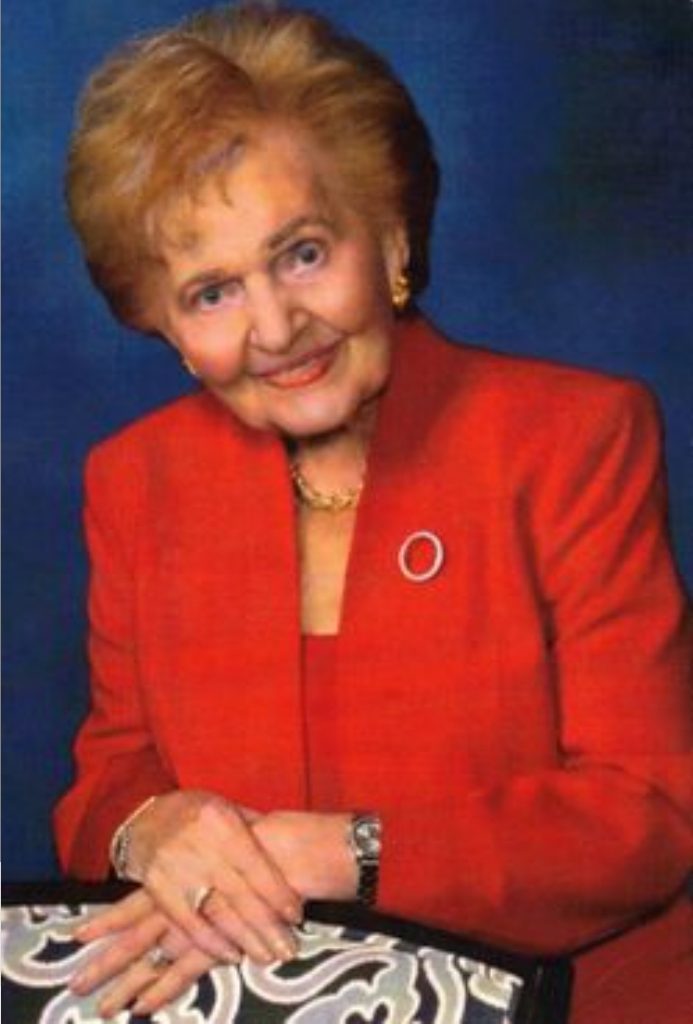
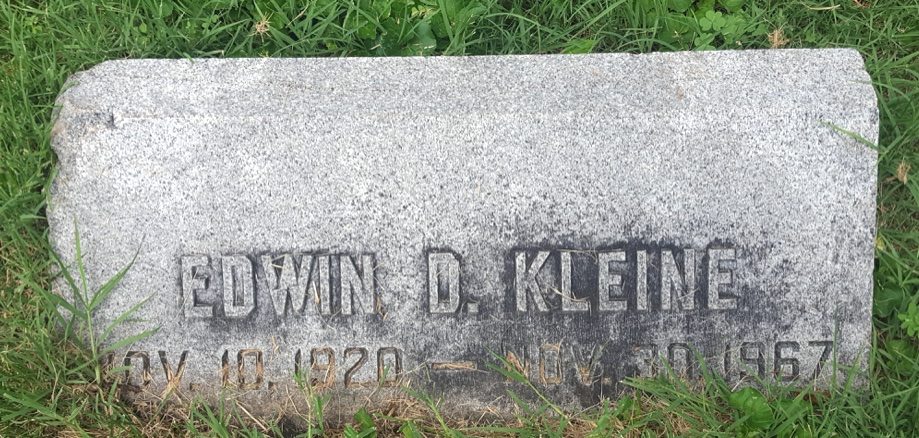
KLUG, CHARLES EDWARD (1924-2007). Private first class, 172nd Infantry, Company B; fireman first class, United States Naval Reserve. Charles Klug was born in Rutland, Vermont. According to his son, he attended Mount Saint Joseph Academy there.
In 1942, 18-year-old Charles registered for the draft, giving his address as Healdville, Vermont. Apparently Healdville was small enough that no street name or number was required. For the person who would always know his address, he named Mrs. Marie Dramis of Healdville. He was working at Fellows Gear Shaper, in Springfield, Vermont. His draft registration card describes Klug as 6′ 1″ tall, 165 pounds, with blue eyes and brown hair.
According to the Navy muster rolls, Klug, with the rating of seaman second class, reported aboard the cargo ship Arctic on April 15, 1943. Arctic’s mission was to provision the Pacific battle fleet, and in 1942 and 1943 the ship made several round trips between the Hawaiian Islands and Samoa, as well as points west. By February, 1944, while in Hawaii, Klug had been transferred to the “liberty ship” USS Prince Georges, which then carried men and materiel to battles in the Marshall and Gilbert Islands. Another round trip involved the ship in the invasion of Saipan in late June of that year. As per his honorable discharge, dated November 29, 1945, he had been promoted to fireman first class.
According to his son, Kenneth, Charles was awarded the World War II Victory Medal and, as a seaman on Prince Georges, a Bronze Battle Star. Kenneth also reports that his father served in the 172nd Infantry. That regiment, also known as the “Mountain Battalion,” was a unit of the Vermont National Guard that was inducted into federal service in February 1941.
On October 25, 1947, according to his son, Charles married Carmella Pierro. The Brooklyn marriage license application, however, was officially recorded on October 9, 1950. According to his son, Charles and Carmella had two children.
Klug worked for 10 years at Silvercup Bakery in Queens, according to his son. From 1974 to 2002, his address was recorded as 1160 56th Street in Brooklyn. By the time of his death in 2007, he was living in New Providence, New Jersey. Section 61, lot 44703, grave 114.
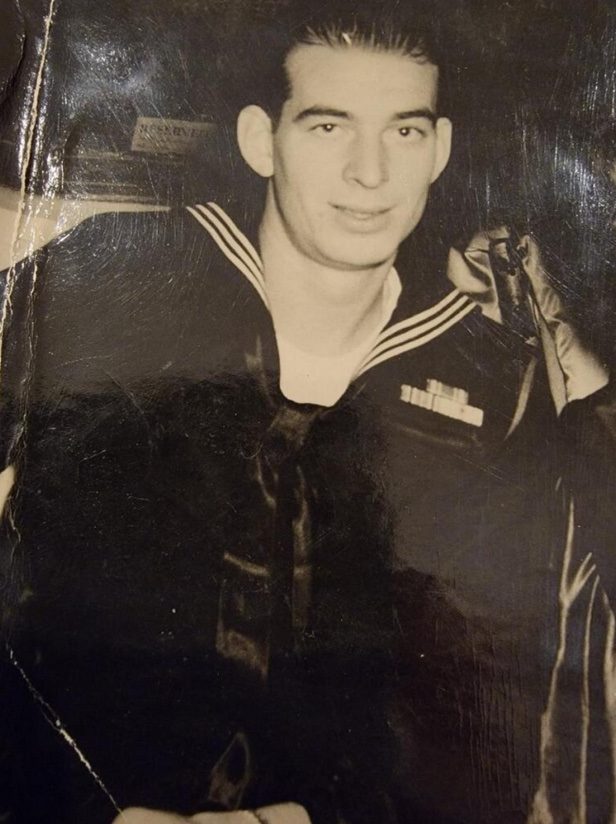
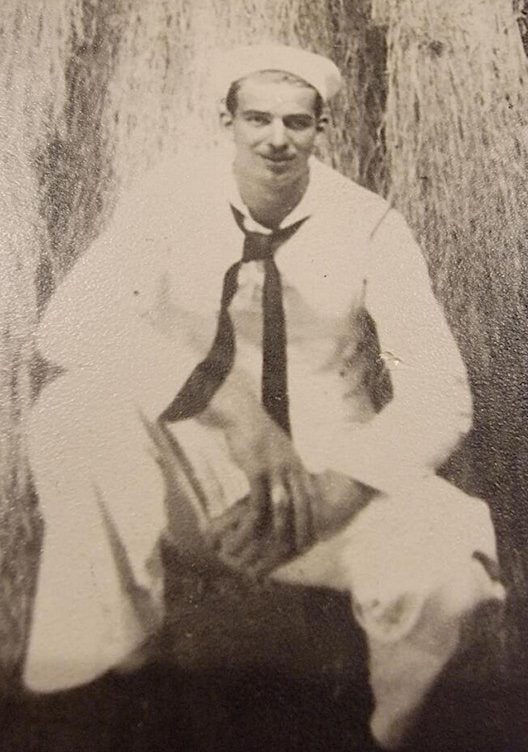
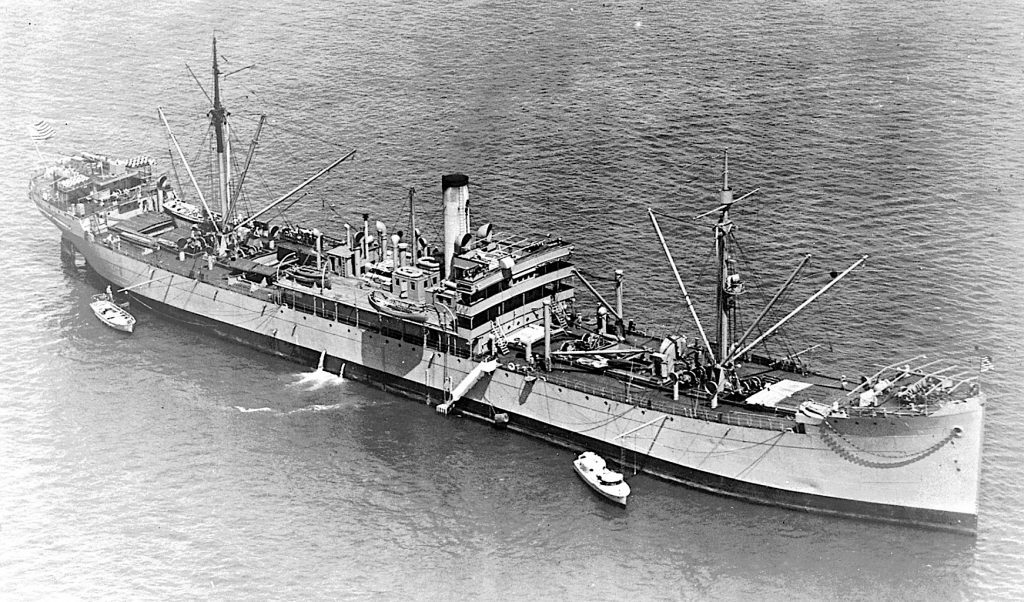
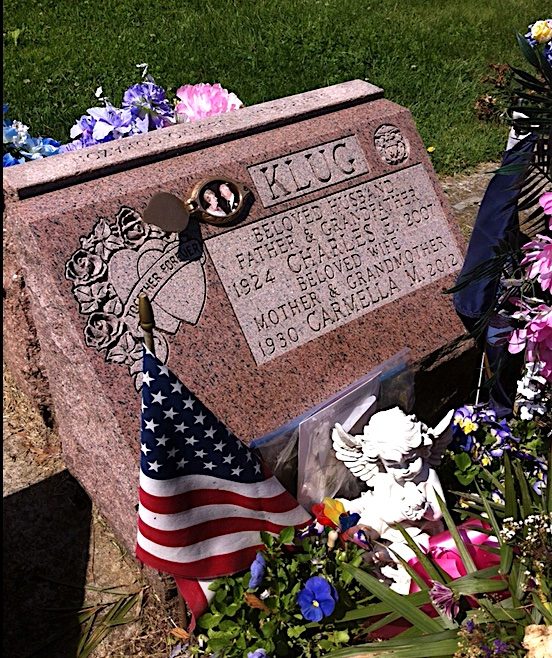
KRAFFT, HENRY JOHN (1911-1994). Private, United States Army. Born in Newark, New Jersey, Henry’s birthday is variously recorded as July 31 or August 1. He completed two years of high school and was working as an elevator operator in 1940, according to that year’s federal census. The year before, marriage license records show, he had married Frances E. Brown in Brooklyn, New York.
In 1942, at the age of 31, his draft registration records his new address in Belleville, New Jersey, his occupation as sales clerk, and his employer as the Globe Indemnity Company of Newark. In 1943, he and Frances became parents of Mary Emmons Krafft, who, according to the Belleville Times, grew up in Belleville, became a teacher in the New Jersey school system, and died in 1980, at age 37, predeceased in 1979 by her mother. Both Mary and Frances Krafft are buried in Green-Wood.
Little is known about Krafft’s military service. His enlistment record shows that he was called up on March 10, 1944, at Fort Dix, New Jersey. Around that time, army infantry troops were being marshaled for the planned invasion of Europe that began on June 6 of that year. A family member confirms that Krafft served in Europe then. His date of discharge from the United States Army is unknown.
Seven years after the death of his wife Frances, Krafft was married again, at age 75, in 1986, to Alice Marie Zyckowski, in Belleville, New Jersey. He died in 1994, just shy of his 83rd birthday.
Henry Krafft’s name was sent to the project by a cousin of his first wife, Frances, with this note: “I’m submitting this to honor Henry’s service to our country. He was in the infantry and literally walked across Europe to defeat the Axis Powers.” Section 168, lot 37940, grave 3.
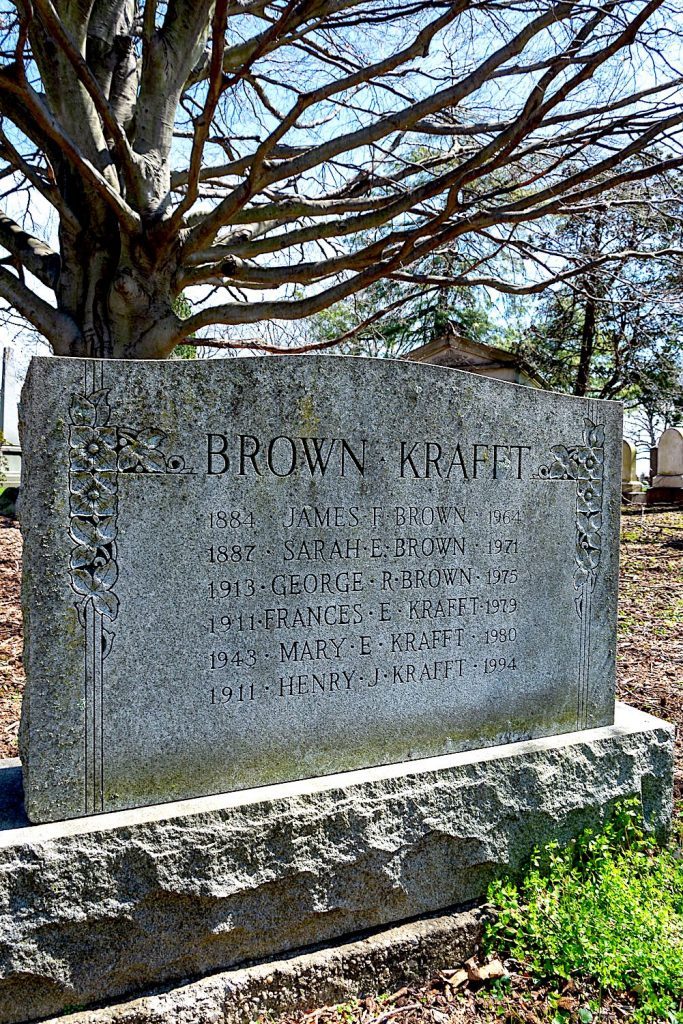
KRIETE, WALLACE (1927-1991). Wartime defense worker, New York Navy Yard (Brooklyn Navy Yard). Wallace Kriete was born in Brooklyn to Charles Kriete, born in Germany, and Agnes Kriete, born in New York. The family lived on 14th Street in Brooklyn, according to the 1930 federal census, and Wallace was the second-youngest of five sons. By the time of the 1940 federal census, a sixth son had joined the family, which was then living on Sixth Avenue in Brooklyn.
According to his son David, during the later years of World War II, Wallace, too young to enlist in the armed forces, worked building ships at the New York Navy Yard, which everyone called, then as now, the Brooklyn Navy Yard. The Navy Yard was nicknamed “The Can-do Shipyard” during the war, running three shifts around the clock, building new and replacement battleships and aircraft carriers as well as other equipment and uniforms for United States armed forces.
On June 4, 1945, his 18th birthday, Wallace registered for the draft, giving his address as the Ninth Street Y.M.C.A. in Brooklyn. For the person who would always know his address, he named his father, living nearby at 200 Seventh Avenue. He gave his place of work as Triangle Publications in Manhattan. (Owned by Walter Annenberg, Triangle in the 1940s published the Philadelphia Inquirer, the Daily Racing Form, and Seventeen magazine, among others.) Wallace is described on his draft card as 5′ 9″ tall, weighing 145 pounds, with blue eyes and brown hair, and wearing glasses.
On the day of Kriete’s draft registration, the war was about to end. The allied forces had declared victory in Europe one month earlier, and victory over Japan would be declared about three months later. The Army had begun to demobilize its forces. The draft would not be reinstated until 1948.
Later, when Wallace was old enough to enlist, he served in the Korean War (1950-1953).
In 1954, according to New York City records, Wallace and Marie Buehler obtained a marriage license in Brooklyn.
In the early 1980s Kriete worked for Chase Manhattan Bank as “second vice president in Customer Quality Assurance.” In that role, he was tapped by the New York Daily News as the go-to expert in banking and finance for their “Action Line” column, which attempted to solve problems sent in by readers. In 1982 and 1984, his solutions and explanations were praised in the column: “…Wally gives it that touch of class, where others might stonewall it…”; “…some fine detective work…”; and “…our final Man of the Week for 1982.”
Kriete was living in Bay Ridge, Brooklyn, at the time of his death. URN Garden, section 1655G.
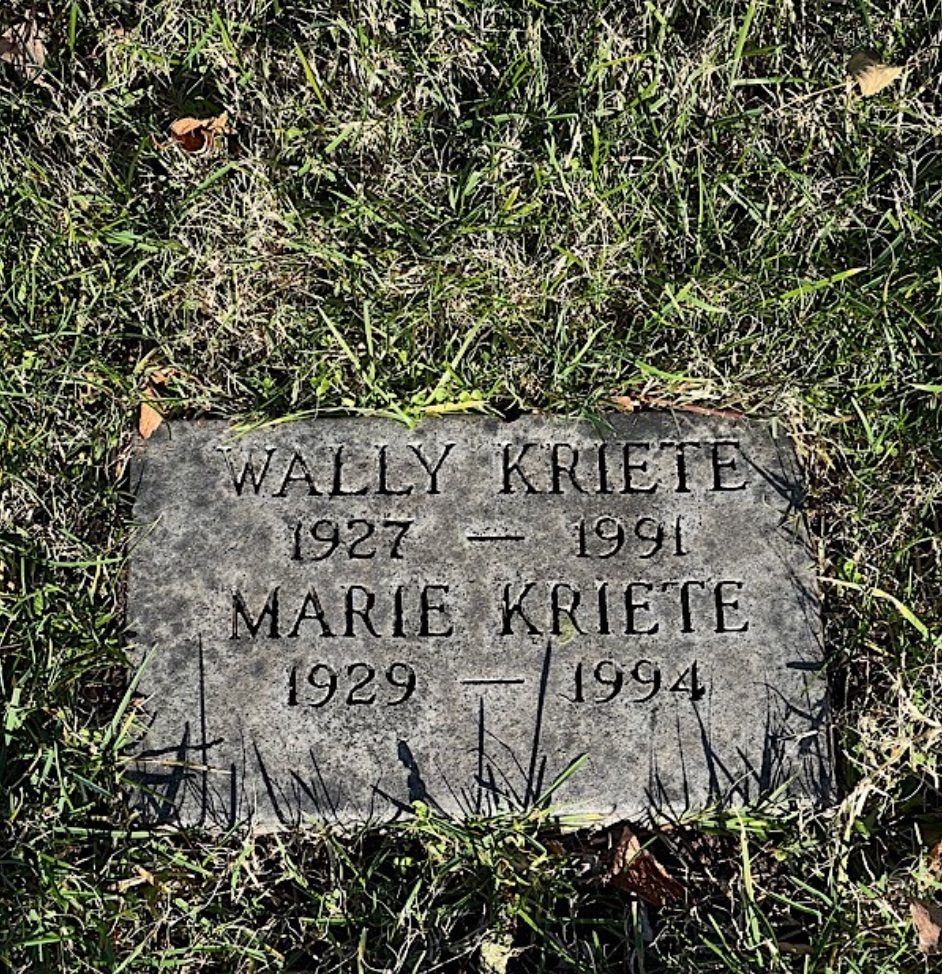
KRUTZ, WILLIAM K. (1925-1989). Rank unknown, United States Army. William was born in Amsterdam, New York. As per the 1701-1970 United States Presbyterian Records, his parents, William and Beatrice, were married at the Zion Evangelical and Reformed Church in Amsterdam, New York on April 21, 1924. The 1925 New York State Census for Montgomery County records that William lived in Amsterdam with his parents and his father was a laborer. No federal census records for the family have been located for the years 1930 and 1940.
William’s World War II draft registration card records he was eighteen years old. His home address was initially listed as 542 West 46th Street in Manhattan; it was subsequently changed on the form to 461 West 42nd Street. His mother was designated next of kin. William was employed by Leotone Radio, located at 63 Dey Street, Manhattan. According to the gothamist website, “Leotone Records was part of an enclave of “retailers who specialized in radios and electronics. The famed hub spanned several blocks of electronic stores along Liberty, West, Church, Barclay and Cortlandt Streets.” This section was known by locals as Radio Row and later became the World Trade Center. As per his registrar’s report, dated April 7, 1943, he was 5′ 4″ and 135 pounds with blue eyes, brown hair, and light complexion.
According to the Department of Veteran Affairs BIRLS (Beneficiary Identification and Records Locator Subsystem) Death File, Krutz enlisted in the United States Army on August 7, 1945 and was discharged on November 30, 1946. His branch of service has been confirmed by Roseanne Hatigipetros, a family member.
After the war, according to the 1950 federal census, William lived with his mother and two siblings, Robert and Beatrice, on West 42nd Street in Manhattan. William was an auto mechanic. As per the Florida Marriage Indexes, Krutz married Mabel Coury in December 1968 in Charlotte, Florida. Roseanne Hatigipetros shares that William was Mabel Coury’s second husband and that she was related to James J. Coury (see).
Krutz died in Brooklyn. He is interred in the Coury family plot. Section 133, lot 39484.
